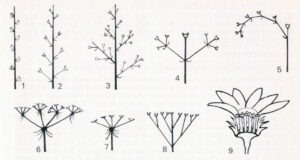Kaj Halberg - writer & photographer
Travels ‐ Landscapes ‐ Wildlife ‐ People
Himalayan flora 2
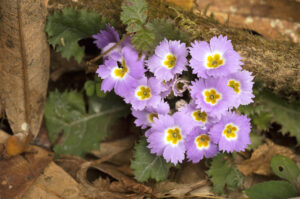
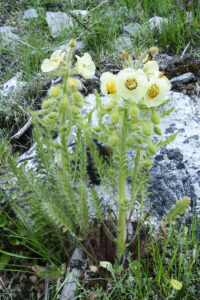
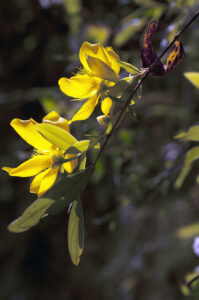
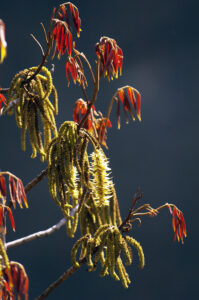
On this page, Tibet (in Chinese Xizang), Qinghai, and Xinjiang are treated as separate areas. The term ‘western China’ indicates Chinese territories just east of Tibet and Qinghai. The term ‘south-western China’ includes the provinces Yunnan, Guizhou, and Sichuan.
I would be grateful to receive information on any errors on this page, or if you are able to identify any of the species left unidentified. You may use this address: respectnature108@gmail.com.
Members of this family are able to obtain nitrogen from the air, and many are cultivated for this purpose. When the plant dies, the nitrogen is released into the soil, for other crops to utilize. In his delightful book All about Weeds, American botanist Edwin Spencer (1881-1964) writes about sweet clover (Melilotus): “It feeds some nitrogen-fixing bacteria that live in nodules (little knots) on its roots, and these bacteria give to the plant as fast as they die (and they die rapidly) all the nitrogen they have fixed. It is impossible to make living cells without nitrogen, and it is impossible for a plant, or any other living thing, to grow without the addition of cells. The size of the plant depends upon the number of its cells, and the number of its cells depends upon the nitrogen supply. Sweet clover is one of those legumes that has worked out the problem of getting its nitrogen indirectly from the air by feeding the dwarfs that know the secret of taking it from the air.”
According to the latest revision, this family now includes 6 subfamilies (3 are dealt with below):
Caesalpinioideae (including the former subfamily Mimosoideae) with 148 genera and about 4,400 species.
Cercidoideae with 12 genera and about 335 species.
Detarioideae with 84 genera and about 760 species.
Dialioideae with 17 genera and about 85 species.
Duparquetioideae with 1 genus and 1 species.
Faboideae (Papilionoideae) with 503 genera and about 14,000 species.
The genus was named by Italian physician and botanist Antonio Francesco Durazzini (1740-1810) in honour of an Italian nobleman, Filippo degli Albizzi, who introduced Albizia julibrissin to Europe in the mid-1700s. It was initially spelled Albizzia, but today the correct spelling of the genus is with a single z.
The flowers are arranged in globular heads, yellowish, to 6 mm long, with white filaments, to 2.5 cm long, sometimes tinged with purple. Flowering occurs May-June. The pod is brown, flat, to 18 cm long and 2 cm broad. It ripens between June and December.
It is distributed from the Indian Subcontinent eastwards to southern China, and thence southwards through Indochina and the Philippines to Indonesia and New Guinea. In the Himalaya, it grows in forests and open areas, and along rivers, up to elevations around 1,300 m.
This species is often planted as a shade tree in tea gardens. The wood is used as timber, and the foliage is lopped for fodder. The bark is strewn in rivers to stupefy fish.
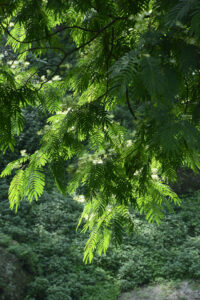
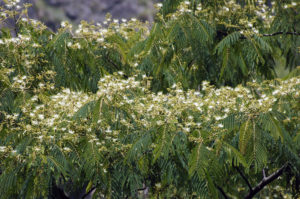
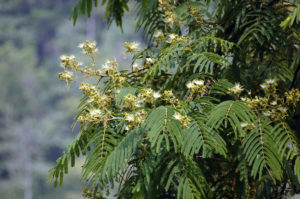
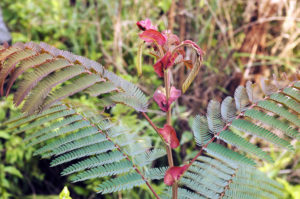
The generic name honours Italian physician, philosopher, and botanist Andrea Cesalpino (in Latin Andreas Caesalpinus) (1519-1603), who was the first botanist to classify plants according to flowers and seeds. In 1555, he became director of the botanical garden in Pisa. His most important botanical publication was De plantis libri XVI, from 1583.
The flowers are arranged in erect spike-like clusters from the leaf axils, to 40 cm long, flower-stalk to 3 cm long, hairy, flowers bright yellow, to 3 cm across, petals rounded, of unequal size, to 1.4 cm long. In the Himalaya, flowering takes place during winter and spring, from December to May. The pod is woody, oblong, chestnut-brown, shining, to 12.5 cm long and 3 cm broad, with 4-9 brown seeds, to 1 cm long and 6 mm broad, ripening April-October.
It is widely distributed, from Pakistan eastwards to Japan and Taiwan, southwards to Sri Lanka and Malaysia. In the Himalaya, it is found up to elevations around 2,200 m, growing in shrubberies and on open slopes.
It is commonly cultivated as an ornamental, and the bark is used for tanning. The prickly branches are utilized as a goat-proof fence. Medicinally, root, stems and pod are used to relieve pain, and the root is taken for constipation. A paste of the root is applied to sprains in cattle.
The specific name is Greek, meaning ‘with ten petals’.
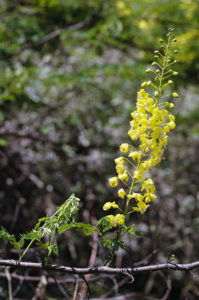
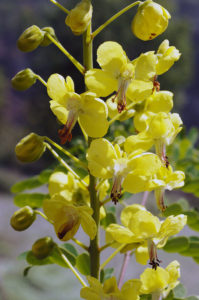
It may grow so large that the stems sometimes resemble tree trunks. The leaves are twice-pinnate, with 1-2 pairs of pinnae and 3-5 oblong leaflets in each pinna, to 9 cm long and 4 cm wide, the rachis ending in a forked tendril.
The tiny flowers, to 3 mm across, are borne in long, axillary spikes to 23 cm long, corolla cream-coloured or pale yellow. Flowering takes place in April. The pods are huge, woody, flat, sometimes up to 2 m long and 15 cm broad, breaking down into single-seeded segments. The seeds are very hard, almost globular, to 5 cm across.
The seeds are utilized in African traditional medicine to induce vivid dreams, enabling communication with the spirit world. The meat of the seed could be consumed directly, or would be chopped, dried, and mixed with other herbs like tobacco. This mixture was smoked just before sleep to induce the desired dreams. (Source: entheology.org)
The plant is also used medicinally for jaundice, toothache, ulcers, and to treat muscular-skeletal problems.
The specific name honours naturalist and colonial administrator of the Dutch East India Company, Hendrik Adriaan van Rheede tot Drakenstein (1636-1691). In the period 1669-1676, he served as governor of the Dutch Malabar coast. During his stay, he employed 25 people to work on his book Hortus Malabaricus, describing 740 plant species of the region.
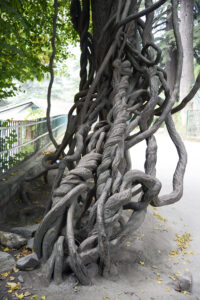
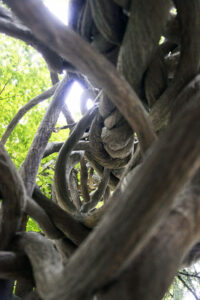
The generic name is derived from the Latin mimus (‘to mime’) and the suffix osus (‘full of’), given in allusion to the sensitiveness of the leaves of some species, which fold up when touched, seemingly mimicking the movement of an animal (see M. pudica below).
The flower-stalk is densely hairy, to 2.5 cm long, flowers tiny, pink or purplish, in axillary, globular heads to 1 cm across, solitary or in pairs. Stamens 4, much exserted. The flowering period is long, from March to October. The slightly recurved pods are arranged in a star-like cluster, each pod to 2.5 cm long and 5 mm broad, with 3-5 joints, covered with stiff yellow hairs. They ripen between May and November.
It is native to Tropical America, but is widely cultivated and has become naturalized worldwide in warm areas. In the Himalaya, it grows in open areas, including fallow fields, edges of rice terraces, and along trails, up to altitudes around 2,000 m.
In Nepal, it is utilized for a large number of ailments, including gout, asthma, cough, dysentery, haemorrhoids, and kidney problems. The seeds are chewed for sore throat. Elsewhere, leaves and root are used as a sedative and sleep aid.
This plant got the popular name sensitive plant due to its leaves, which fold up and bend downwards, when touched. The specific name, Latin for ‘modest’ or ‘ashamed’, also alludes to this reaction.
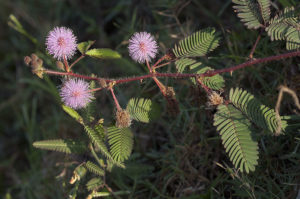
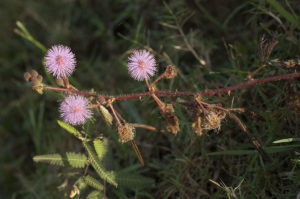
The flower-stalk is to 6 cm long, hairy, flowers tiny, pink at first, fading to white, in globular heads to 1.5 cm across, in terminal and axillary clusters. Stamens 8, much exserted. Flowering takes place from June to October. The pods are sickle-shaped, to 10 cm long and 1.3 cm broad, sometimes prickled, arranged in clusters of 4-10. The ripening period is August-November.
It is distributed from Afghanistan eastwards to Bhutan, and is also widespread on the Indian Peninsula. In the Himalaya, it grows in open areas, often along streams, up to elevations around 2,000 m.
In Nepal, it is utilized medicinally for a number of ailments, including peptic ulcer, haemorrhoids, and fever. A paste of the root is applied to sprains and dislocated bones. Tent pegs and charcoal are produced from the wood. The prickly stems are used as a goat-proof hedge.
The specific name is Latin, meaning ‘with a stem like bramble’, alluding to the prickly stem.
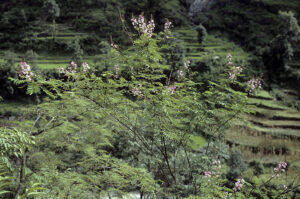
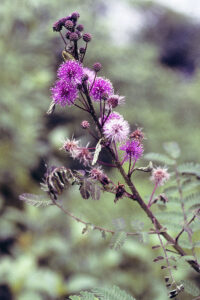
The generic name is derived from Arabic sana, a term covering plants with catharitic and laxative properties.
Initially, in 1753, these plants were included in the genus Cassia by Swedish naturalist Carl Linnaeus (1707-78), but already the following year, in his fourth edition of The Gardeners Dictionary, Scottish botanist Philip Miller (c. 1691-1771) placed a number of Cassia species in the genus Senna. For many years, most botanists did not recognize this genus, and only recently has it been re-established.
The obsolete generic name Cassia is derived from Ancient Greek kassia, the spice made from the bark of members of the genus Cinnamomum other than the true cinnamon (C. verum), especially Chinese cinnamon (C. cassia).
A number of pictures, depicting the wonderful Cassia fistula, is presented on the page In praise of the colour yellow.
The flowers are arranged in axillary or terminal clusters, bracts whitish or brownish, longer than the buds, soon falling. Corolla is yellow or orange-yellow, to 2 cm across, sepals yellowish, unequal, outer ones rounded, to 6 mm across. inner ones ovate, to 9 mm long. Fertile stamens 7, sterile ones 3. Blooming occurs May-August. The ripe pod is brown, with pale thick margins, sickle-shaped, flattened, to 13 cm long and 1 cm wide. It ripens between July and October.
It is native to Tropical America but has been widely introduced elsewhere in tropical and subtropical regions. In the Himalaya, it is found in shrubberies and open areas, growing up to elevations around 1,400 m.
The specific name is Latin, meaning ‘from the West’, alluding to the place of origin.
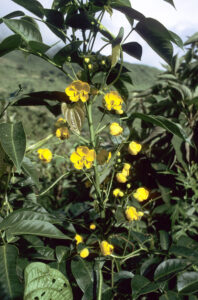
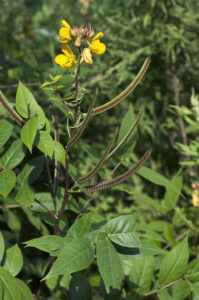
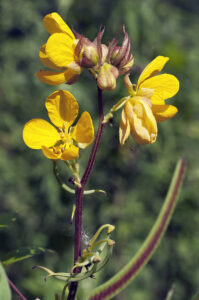
The leaves of this genus are characterized by the apex, which is split into 2 broad lobes, the outline thus resembling a camel’s footprint, giving rise to one of the popular names.
The generic name was applied by Swedish naturalist Carl Linnaeus (1707-78) in honour of Swiss botanist Gaspard Bauhin, in Latin Casparus Bauhinus (1560-1624), who described thousands of plant species in his monumental work Phytopinax (1596), in a form, which equals the binominal nomenclature, introduced in 1753 by Linnaeus.
Inflorescences are axillary or terminal clusters with up to 20 flowers, petals pink, pale pink, or sometimes whitish, oblanceolate, to 5 cm long, clawed. Fertile stamens 3, filaments about as long as the petals. It flowers in autumn, September-October. The pod is linear, flat, to 25 cm long and 2.5 cm wide, ripening January-March.
It is probably originally native from the Indian Subcontinent eastwards to Indochina, but is now very commonly cultivated elsewhere. In the Himalaya, it is found up to elevations around 1,600 m, growing in shrubberies and open areas.
The foliage is lopped for fodder, and fibres are obtained from the bark, which is also used for tanning. The plant is also utilized medicinally.

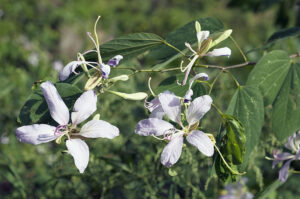
It is probably originally native from the Indian Subcontinent eastwards to Indochina and southern China, and is very commonly cultivated elsewhere. In the Himalaya, it is found up to elevations around 1,800 m, growing in forests and shrubberies.
The bark is used medicinally, and for dyeing and tanning. The wood is used for construction, and the foliage is lopped for fodder. The flowers are edible, cooked or pickled.
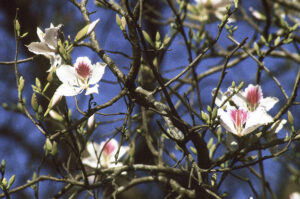
The generic name is derived from Arabic abruz or afruz (‘that gives flaming colours’), alluding to the bright red seeds.
The branches are slender, smooth or downy. Leaves alternate, short-stalked, to 13 cm long, pinnately divided into 10-20 pairs of oblong or ovate leaflets, to 2.2 cm long and 6 mm wide, apex rounded, margin entire.
Inflorescences are axillary clusters, usually shorter than the leaves. Calyx to 2.5 mm long, smooth or sparsely silky-hairy, teeth very short, corolla pinkish-white or pink, to 1 cm long. Flowering occurs July-October. The pod is oblong, to 4 cm long and 1.3 cm broad, containing 3-8 highly distinctive, ovoid seeds, to 8 mm long, usually bright scarlet with a black spot at the base, sometimes white with black base, or uniformly black or white. The ripening period is from September to November.
The seeds are used medicinally for a large number of ailments, but as they are extremely poisonous, they should never be eaten – ingestion of a few may be fatal. Their multiple usages, including murder, are described on the page Plants: Plants in folklore and poetry.
The specific name is Latin, meaning ‘prayer’, alluding to the usage of the seeds in rosaries, which is also reflected in one of the common names. The name crab’s eye refers to the likeness of the seeds to a crab’s eye.
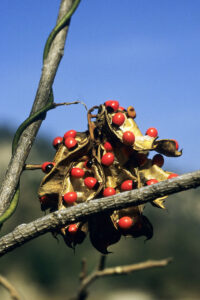
The leaves of the vast majority of species are pinnate, with numerous leaflets. The calyx is tubular, with 5 short teeth or lobes, often of unequal length. The keel of the flower is blunt-tipped, as opposed to members of the genus Oxytropis (below), which are very similar, but whose keel has a beaked tip. The pod is often longitudinally divided into 2 chambers.
In Ancient Greece, astragalos was the term applied to one of the bones in the ankle joint, called the ball bone. Dice were made from the ball bones of certain animals. However, astragalos was also the name for a member of the pea family, Lathyrus niger. A possible explanation is that to the Greeks, the seeds of this plant resembled the dice made from the ball bones.
The name vetch stems from Anglo-Norman French veche, a corruption of the Latin vicia. Milk-vetches are quite similar to true vetches of the genus Vicia. The prefix milk refers to an old belief that cows fed with milk-vetch would yield more milk.
The yellow flowers are in dense, almost stalkless clusters, calyx reddish or green, densely silky-hairy, to 1.3 cm long, teeth to 6 mm long. The standard is hairless, to 2.5 cm long, wings to 2.3 cm long, keel very short. Flowering takes place May-August. Pod downy, to 2.6 cm long, ripening July-October.
This plant is found in open areas in drier valleys, from northern Pakistan eastwards to central Nepal, at altitudes between 2,700 and 4,500 m. It is quite common in Chamba, Himachal Pradesh, and in the Upper Langtang Valley, central Nepal.
The specific name honours Swiss botanist Augustin Pyrame de Candolle (1778-1841), who created a new natural plant classification system.
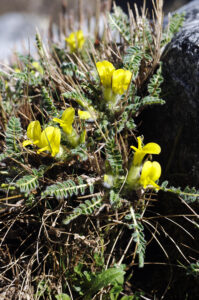
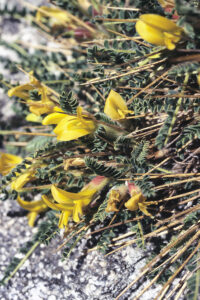
Inflorescences are axillary, very long-stalked clusters, stalk to 10 cm long, flowers yellow, standard, wings, and keel of almost equal length, to 1.5 cm. Calyx hairless or downy, to 9 mm long, teeth of uneaual length, to 3 mm. The blooming period is from June to August. Pod ellipsoid, straight or curved, hairless, to 4 cm long, with a beak to 1 cm long, ripening July-September.
This plant is distributed from Pakistan eastwards to Bhutan and south-eastern Tibet, growing in open areas at elevations between 2,500 and 4,000 m.
What the specific name refers to is not clear.
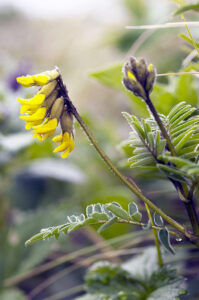
Inflorescences are dense terminal clusters with up to 20 flowers, pink, or violet with a white base, to 2 cm long. After flowering, which takes place June-August, the pink calyx, to 1.3 cm long, is greatly inflated, resembling a tiny balloon. The pod, to 9 mm long and 3.5 mm wide, is enclosed in the calyx. It is covered in white and black hairs. It ripens between July and September.
It grows in deserts and semi-deserts at high altitudes, up to 4,600 m, from Kazakhstan, Kyrgyzstan, Tajikistan, and Afghanistan eastwards across Ladakh, Himachal Pradesh, and Tibet to Gansu.
The specific name is composed of the Latin niv, an obsolete form of nix (‘snow’), and the suffix alis, thus ‘living in snow’, referring to the fact that this plant grows at high elevations.
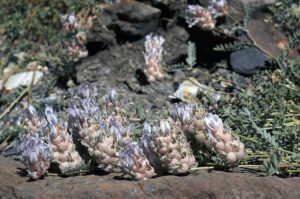
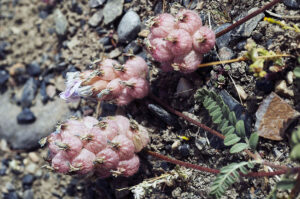
The calyx, to 1.5 cm long, is covered in black and white hairs, teeth to 5 mm long. The yellow flowers, blooming June-September, are in clusters of 2-5, standard hairless, to 2.8 cm long, wings to 2.3 cm long, keel to 2.1 cm long. Pod hairy, to 2 cm long and 4 mm wide, with a straight beak to 5 mm long, ripening July-October.
This species is found in dry stony areas at altitudes between 3,000 and 4,500 m, distributed from Xinjiang southwards across western Tibet to Kashmir, and thence eastwards to central Nepal.
The specific name is derived from Ancient Greek hoplites (‘heavily armed foot-soldier’), ultimately from hoplon (‘arms’ or ‘weapon’), naturally alluding to the numerous spines.
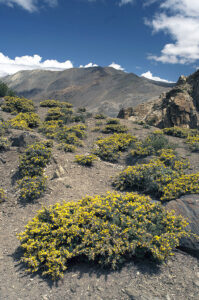
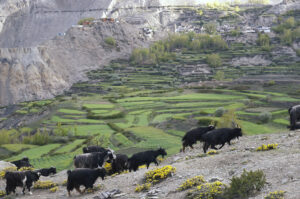
The yellow flowers, which occur from June to August, are often in dense, stalkless clusters at the centre of the rosette, calyx hairy, to 1.6 cm long, teeth to 8 mm long, standard to 2.5 cm long, wings and keel slightly shorter. Pod to 2 cm long and 7 mm wide, hairy, ripening July-September.
It is distributed from Xinjiang southwards through western Tibet to Afghanistan, Pakistan, Ladakh, and Himachal Pradesh, found on open stony slopes, and in grasslands, at elevations between 1,800 and 5,000 m.
The specific name is Ancient Greek, meaning ‘producing flowers from a rootstock’.
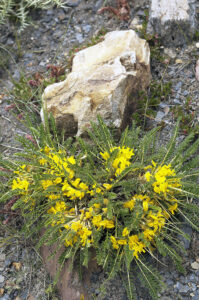
The genus was named in honour of John Stuart, 3rd Earl of Bute (1713-1792), who was a patron of botany.
Inflorescences are very large, terminal or axillary, spike-like clusters, to 50 cm long. Petals and cup-shaped calyx brownish are silky-hairy. Corolla orange-red, to 2.5 cm long, standard broadly elliptic, pointed, recurved, wings sickle-shaped, keel blunt. Flowering takes place April-May. The pod is to 10 cm long and 3 cm broad, covered in brownish hairs. It ripens between June and August.
It is distributed from western Nepal eastwards to Myanmar, northern Thailand, and south-eastern Tibet, found in open areas, among rocks, and along streams, at elevations between 300 and 2,000 m.
In Nepal, the seeds are used to expel intestinal worms. Rope is produced from the bark fibres, and plates are made from the leaves.
A close relative, B. monosperma, is described on the page Plants: Plants in folklore and poetry.

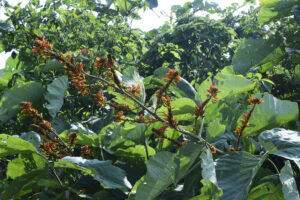
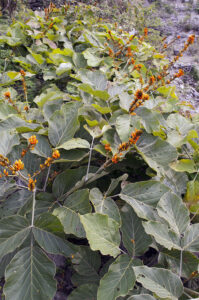
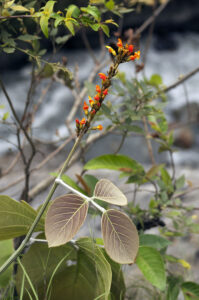
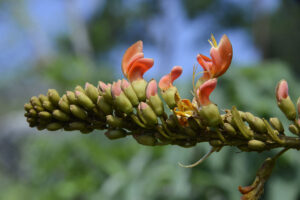
The generic name is the Mongolian name for C. arborescens.
Flowers are axillary, solitary or sometimes 2 together, to 1.6 cm long, yellow with red streaks, calyx hairless, yellow or reddish, to 9 mm long, with short triangular lobes. Blooming occurs June-August. The pod is cylindric, smooth, pointed, dark brown when mature, to 4 cm long, ripening August-September.
This species is found from Pakistan eastwards to Uttarakhand, and across Tibet to the western parts of Yunnan and Sichuan, northwards to Qinghai, Gansu, and Ningxia, growing in open areas at elevations between 1,800 and 4,500 m. It is common in Ladakh.
The specific name is Latin, meaning ‘short-leaved’.

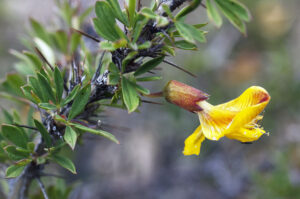

Calyx densely hairy, with triangular teeth. Flowers yellow, very short-stalked, to 2.5 cm long, solitary or sometimes 2 together, arranged along the stem. Flowering period is from May to July. The pod is densely hairy, grey, to 2.5 cm long, ripening July-September.
This plant grows in dry steppe country and semi-deserts at altitudes between 2,600 and 4,200 m, from Afghanistan eastwards to central Nepal, and thence northwards across western Tibet to Qinghai.
It is often collected as firewood.
The specific name was given in honour of English herbalist John Gerard (c. 1545-1612), who published a large work on herbal medicine, Herball or Generall Historie of Plantes.
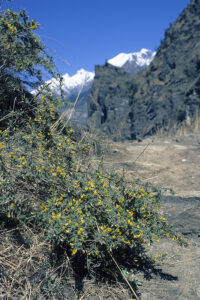
Flowers yellow or orange-yellow, solitary or 2 together in upper leaf axils, very short-stalked, to 2.5 cm long. Calyx tubular, greenish-yellow or reddish, densely hairy, to 7 mm long, with tiny awl-shaped lobes. Flowers occur June-July. The pod is initially hairy, later hairless, to 4 cm long, ripening period August-September.
This species is found from Uttarakhand eastwards to Bhutan, growing in shrubberies and open areas at altitudes between 2,400 and 3,700 m. It is common in the Upper Langtang Valley, central Nepal.
In Nepal, a paste of the root is applied to dislocated bones.
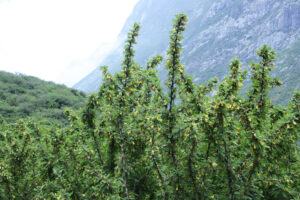
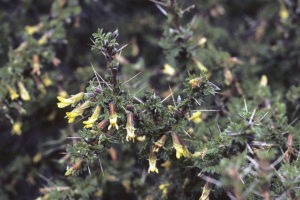
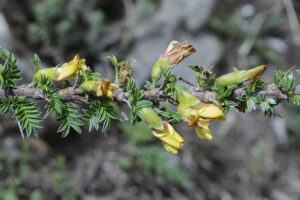
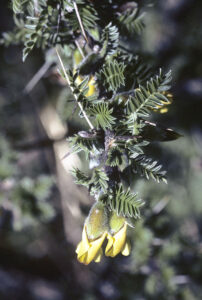
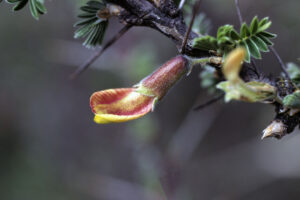
The genus was named in honour of British general and explorer Francis Rawdon Chesney (1789-1872). In 1836, he led an expedition to test the proposition that large iron vessels could successfully navigate the river Euphrates from southern Turkey to the Persian Gulf. Among his companions was Bohemian physician, explorer and naturalist Johann Wilhelm Helfer, also known as Jan Vilém Helfer (1810-1840), who made collections of plants and animals from along the river. Helfer later participated in an expedition to the Andaman Islands in the Bay of Bengal, where a native shot him with a poisoned arrow, which ultimately killed him.
Flowers long-stalked, solitary or up to 4 together in the leaf axils, stalk to 1 cm long, hairy. Calyx cylindric, to 1.7 cm long, hairy, with unequal teeth to 7 mm long, with black glands at tip. Corolla purple or pinkish-purple, standard to 3.2 cm long, hairy outside, wings to 2.9 cm long, keel slightly shorter. Blooming takes place from May to September. Pod linear, to 6 cm long and 1 cm broad, initially hairy, later smooth, ripening July-October.
This plant grows on dry stony slopes and in dry riverbeds, distributed from Xinjiang southwards across western Tibet to Pakistan and Ladakh, found at elevations between 2,400 and 4,300 m.
The specific name is Latin, meaning ‘wedge-shaped’. What it refers to is not clear.
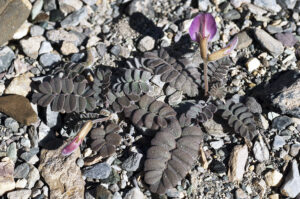
A prostrate herb, forming mats, stems branched, to 16 cm high, woody, persistent. Leaves mostly short, to about 4 cm long, sometimes to 15 cm, pinnate, densely silvery-hairy, with 15-21 oblong leaflets, to 8 mm long and 4 mm wide, tip pointed. Stipules linear, to 1 cm long, hairy.
Flowers are solitary, stalked, yellow or orange, standard to 2.5 cm long, wings and keel slightly shorter. Calyx densely hairy, to 1 cm long, toothed. Flowering period is from June to August. Pod ellipsoid, downy, to 3 cm long and 8 mm broad, stuffed with white hairs inside, ripening August-September.
The specific name is derived from the Latin nubes (‘cloud’) and genus (‘born of’), alluding to the high altitudes this plant is growing at.
At some point, this plant was called Spongiocarpella nubigena.
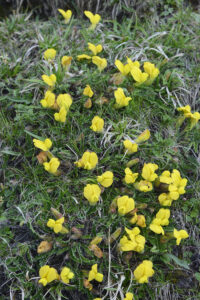
This plant is distributed from Uttarakhand eastwards to Bhutan and south-eastern Tibet, growing in stony areas and grasslands at elevations between 4,700 and 5,200 m. It is common in the Khumbu area, eastern Nepal.
The seeds are eaten in Nepal.
Previously, it was also known as Spongiocarpella purpurea.

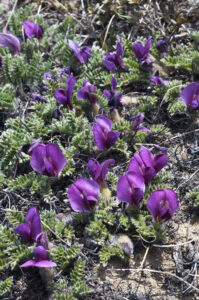
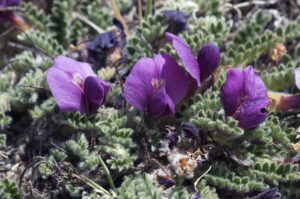
The generic name is derived from Ancient Greek kokhlias (‘spiral’) and anthos (‘flower’), alluding to the style and filaments, which are spiralled inward in the upper part.
Calyx bell-shaped, yellowish-green, densely hairy, teeth triangular, to 7 mm long, upper 2 fused, shorter. Flowers pink, mauve, or pale purple, in short drooping clusters, standard and wings broad, to 2 cm long and 1.7 cm wide, keel longer, narrow, curved, with rounded tip. They appear July-September. Pod linear, covered in dense brownish-black hairs, tip curved, ripening August-October.
It is distributed from central Nepal eastwards to Bhutan, south-eastern Tibet, and south-western China, found in forest margins and shrubberies at altitudes between 1,400 and 2,000 m.
In Nepal, a paste of the stem is applied to boils, pimples, and muscular swellings.
The specific name is Latin, meaning ‘slender’, referring to the stems.
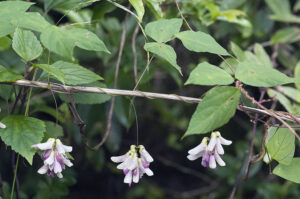
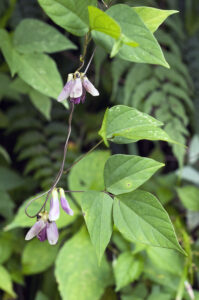
The flowers are much visited by birds, in the Himalaya among others Asian black bulbul (Hypsipetes leucocephalus), red-whiskered bulbul (Pycnonotus jocosus), and crimson sunbird (Aethopyga siparaja), which feed on the nectar, and ring-necked parakeet (Psittacula krameri), which may eat the entire flower.
The generic name is derived from Ancient Greek erythros (‘red’), like the common name referring to the wonderful scarlet or coral-red flowers of the genus.
Inflorescences are axillary, dense, erect clusters, to 38 cm long, appearing in July-October with the leaves. Flowers scarlet, drooping, standard ovate, pointed, to 5 cm long, wings and keel much shorter. The pod is lanceolate, curved, initially rusty-hairy, later smooth, to 23 cm long and 3 cm broad. It ripens from September to December.
This species grows in shrubberies and villages, and on open slopes, distributed from Uttarakhand eastwards to Myanmar, Bangladesh, northern Thailand, and western China. In the Himalaya, it is found at elevations between 1,500 and 3,000 m.
It is widely cultivated as an ornamental, and also planted to retain landslides. The wood is utilized for construction, and juice of the bark is used medicinally for boils and to expel intestinal worms.
The specific name is Latin, meaning ‘becoming a tree’, referring to its small size.
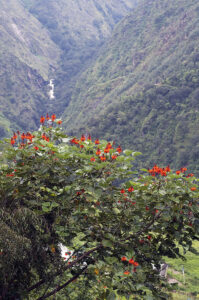
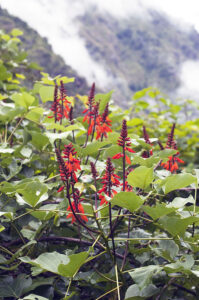
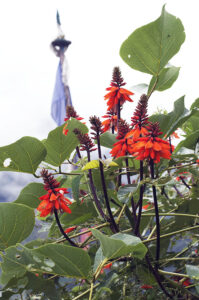
It is distributed from the Indian Peninsula across Indochina to south-western China. It is very common in the lower parts of the Himalaya, growing in forests and open areas up to elevations around 1,600 m.
The specific name is Latin, meaning ‘tightened’ or ‘compressed’. What it alludes to is not clear.
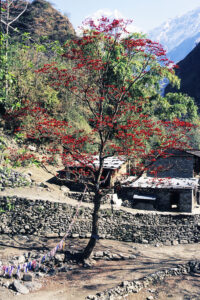
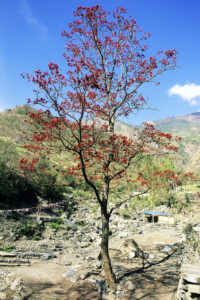
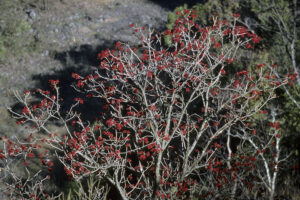
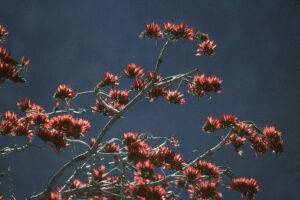
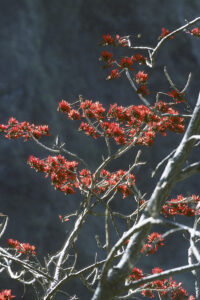
The generic name is derived from Ancient Greek hedysaron (‘axe-weed’), the name of a plant described by Greek physician, pharmacologist, and botanist Pedanius Dioscorides (died 90 A.D.), author of De Materia Medica, five volumes dealing with herbal medicine. The connection with this genus is obscure.
An erect herb to 1 m tall, stem grooved, smooth. Leaves pinnate, to 20 cm long, upper ones in whorls, leaflets 11-13, oblong-lanceolate, smooth, to 4 cm long, tip blunt. Stipules large, elliptic, to 4 cm, encircling young shoots.
Flowers are arranged in long, drooping, axillary clusters, to 10 cm long. As reflected by the specific name, the calyx is small, to 3.5 mm long, hairless, toothed. Flowers are purple or crimson-purple, to 2 cm long. The keel is longer than standard and wings. Flowering period is June-August. Pods 2- or 3-jointed, each joint to 1.6 cm long and 7 mm broad, winged. They ripen July-September.
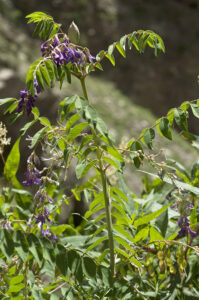
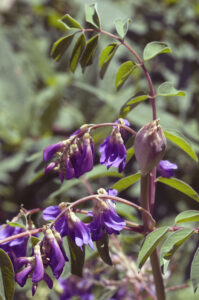
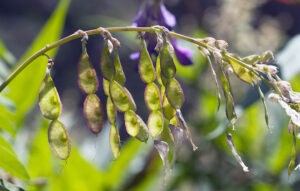
Inflorescences are dense, long-stalked, terminal clusters, calyx bell-shaped, to 8 mm long, densely hairy, teeth narrowly triangular, of unequal length. Corolla purple, violet, or mauve, to 1.8 cm long, keel longer than standard and wings. Flowering occurs June-August. Pod 1- or 2-jointed, each joint to 9 mm long and 7 mm broad, margin irregularly toothed, ripening August-September.
This plant grows in gravelly areas, stony riversides, grasslands, and shrubberies, found from eastern Nepal eastwards to Bhutan, and thence northwards to Gansu, at elevations between 3,100 and 4,700 m.
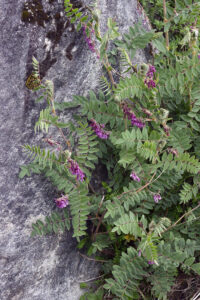
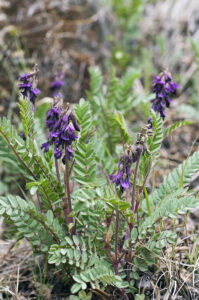
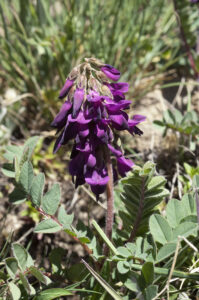
Formerly, a blue dye, indigo, was extracted from a lowland species, I. tinctoria, but nowadays the dye is produced synthetically. This dye cannot be extracted from any of the Himalayan species.
The generic name is composed of indicum, the classical Latin term for the dye, alluding to the fact that it was produced in India, and fero (‘I bear’).
Inflorescences are axillary, short-stalked, to 17 cm long, covered with brownish scales at base. Calyx cup-shaped, to 3 mm long, densely white-hairy. Bracts boat-shaped, to 1 cm long. Corolla pink, turning violet when aged, to 1.8 cm long. Pod straight, hairless, to 4 cm long and 4 mm broad. It ripens between April and June.
It is distributed from Kashmir eastwards to Indochina and southern China, and is also found in Peninsular India and Sri Lanka. In the Himalaya, it grows in shrubberies and forests, often mixed Pinus roxburghii-Shorea robusta, from the lower valleys up to altitudes around 1,900 m. It is common in Helambu, central Nepal.
In Nepal, the flowers are eaten as a vegetable, or pickled. In India, a decoction of the root is used for cough. The root is also dried and ground into powder, which is applied externally in case of chest pain.
The specific name is Latin, meaning ‘resembling Cassia’ (see Senna above). The obsolete specific name means ‘beautiful’.
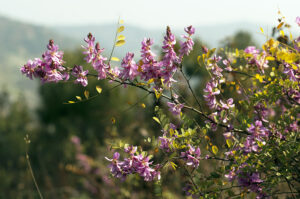
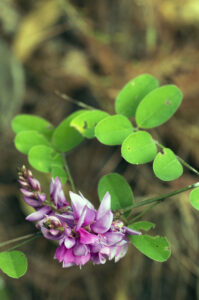
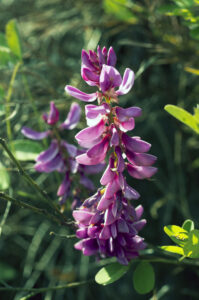
The flowers are arranged in ascending, spike-like clusters from the leaf axils, to 10 cm long, calyx tiny, to 1.8 mm long, brownish-hairy outside, teeth triangular, to 0.8 mm long. Corolla pink or reddish, to 1.3 cm long, standard and wings to 9 mm long, wings shorter. Flowering takes place May-August. The pod is cylindric, smooth, to 5 cm long and 4 mm broad, ripening June-September.
It is distributed from Uttarakhand eastwards to Bhutan and south-eastern Tibet, found in forests, shrubberies, and open areas at altitudes between 2,100 and 2,700 m.
The specific name alludes to the shape of the pod.
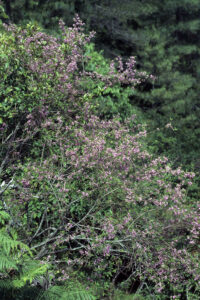
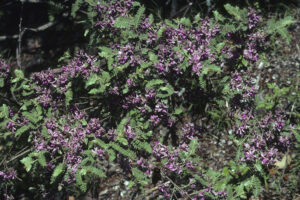
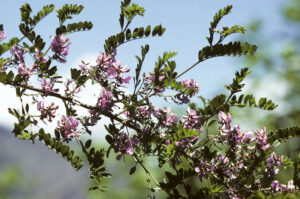
An erect shrub to 2.5 m tall, stems and branches with short white hairs. Stipules tiny, linear, to 3 mm long, persistent, with adpressed brownish hairs. Leaves stalked, very variable, to 7 cm long, stalk and rachis with short hairs, leaflets 11-31, opposite, elliptic, obovate, or oblanceolate, thick, with white adpressed hairs above and below, to 2.5 cm long and 1.5 cm broad, blunt, tip with a tiny spine.
Flowers are arranged in erect clusters, to 8 cm long, short-stalked. Calyx bell-shaped, downy, to 4 mm long, including triangular teeth to 2.5 mm long. Corolla pale pink, reddish, or purple, to 1.3 cm long, hairy outside. Flowering period is from May to July. Pod brown, linear, sparsely hairy, to 2.5 cm long, ripening July-October.
In Nepal, the flowers are pickled, and the foliage is used for fodder.
The specific name is a term used for plants having different types of stamens in the same flower, from Ancient Greek hetera (‘different’) and anthos (‘flower’, in this connection ‘anther’).
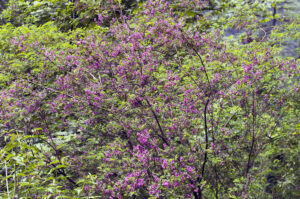
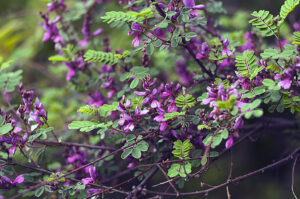
The generic name is of Semitic origin, in Ancient Greek lotos, denoting a type of clover or trefoil, described by Homer as food for horses. The trefoil part of the popular name was given in allusion to the seemingly tripartite leaves (in reality 5 leaflets, see below), whereas bird’s-foot refers to the often triple pods, which spread out from a common point, thus resembling a bird’s foot.
Other species of this genus are dealt with on the page In praise of the colour yellow.
Inflorescences are axillary umbels, very long-stalked, with 3-7 flowers, stalk to 12 cm long. Corolla golden-yellow, often turning orange or red when ageing, to 1.8 cm long. Calyx to 6 mm long, often with unequal teeth. Flowering occurs April-September. The pod is cylindric, to 3 cm long and 4 mm broad, ripening between June and October.
This plant is widely distributed in Temperate Eurasia, growing in drier habitats with low vegetation. In the Himalaya, it is distributed from Pakistan eastwards to central Nepal, growing on open slopes, and in grasslands and fallow fields, at elevations between 1,500 and 4,000 m.
It is much utilized as fodder.
The specific name is derived from the Latin corniculum, a diminutive of cornu (‘horn’), and atus (‘having’), thus ‘having little horns’, alluding to the pods.
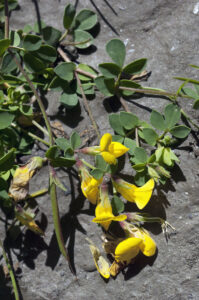
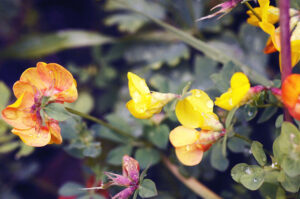

The generic name (and with that one of the common names) is derived from the Latin medica, meaning ‘a kind of clover introduced from Media’, referring to lucern (M. sativa). The common name bur-clover alludes to the spiny pods of some species of the genus. The term bur is from Middle English burre, from the Norse burre (‘burdock’). It is used for several plants with hooked or spiny fruits, which easily spread by attaching themselves to animals’ pelts, people’s clothes, etc.
The stem is erect or spreading, to 1 m tall, much-branched, hairless or sparsely hairy. The leaves are trifoliate, leaflets obovate or linear-lanceolate, toothed above, to 2 cm long and 6 mm broad.
Flowers are in axillary, rounded, stalked clusters, to 4 cm long, corolla yellow, to 1.1 cm long. Calyx to 5 mm long, teeth often longer than tube. Flowering period is May-August. The pod is usually sickle-shaped, sometimes nearly straight, to 2 cm long and 3.5 mm broad. It ripens July-September.
It is widely cultivated for fodder.
The specific name is Latin, meaning ‘sickle-shaped’, alluding to the shape of the pod.
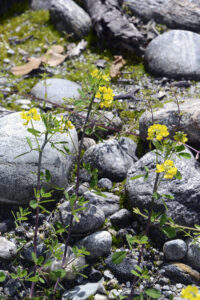
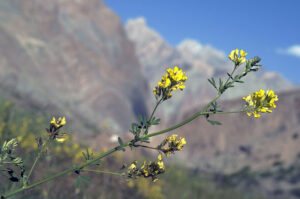
The generic name is derived from Ancient Greek meli (‘honey’) and lotus (see Lotus above). These plants are much visited by bees. The common name sweet clover refers to the fragrance of the flowers. They are also widely cultivated as nitrogen-producers.
Flowers are arranged in spikes, to 15 cm long, with 30-70 yellow flowers, to 7 mm long, standard, wings, and keel of almost equal size. Flowering occurs May-September. The pod is ovoid, dark brown, to 5 mm long and 2 mm broad, transversely ridged, ripening June-October.
This plant is widely distributed in Temperate Eurasia. In the Himalaya, it is restricted to Pakistan and Ladakh, at elevations between 2,700 and 4,000 m. Habitats include dry grasslands, sandy areas, riversides, and forest margins. It is common in Ladakh, where it is also cultivated as a fodder plant and nitrogen-producer.
Originally, officinalis was derived from officina (‘workshop’, or ‘office’), and the suffix alis, which, together with a noun, forms an adjective, thus ‘made in a workshop’. However, in a botanical context, the word denotes plants species that were sold in pharmacies due to their medicinal properties.
A close relative with white flowers, M. alba, is also cultivated in the north-western part of the Himalaya.
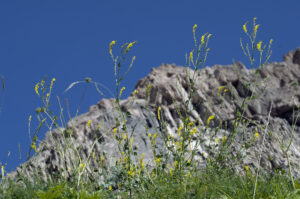
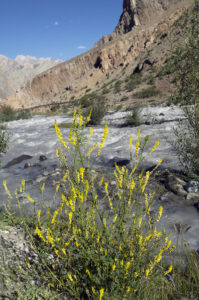
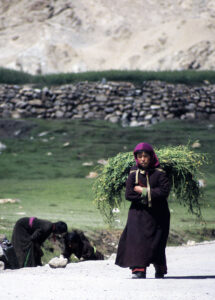
The generic name is derived from Ancient Greek oxys (‘sharp’) and tropis (‘keel’), referring to the beaked keel, as opposed to the blunt keel in the very similar flowers of the genus Astragalus (above).
The American term for these plants is locoweed, derived from Spanish loco (‘mad’ or ‘crazy’). Early settlers noticed that cattle and horses, which had eaten these plants, would stagger around, acting strangely.
Stem absent, all leaves and flower stalks spreading out star-like from the rootstock. Leaves pinnate, to 7 cm long, leaflets oblong-elliptic, pointed, with white hairs below and along the margin. Flowers are arranged in compact terminal clusters on silky-hairy stalks to about 9 cm long, calyx bell-shaped, teeth pointed, to 3 mm long, corolla bluish-mauve or violet, to 8 mm long. Flowering takes place June-July.
The specific name is derived from the Latin harena (‘sand’) and ripa (‘river bank’), thus ‘growing along sandy rivers’.
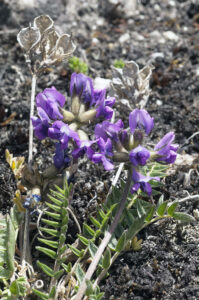
Flowers are in compact to rather lax clusters, to 5 cm long, at the end of long stalks, which are densely silky-hairy. The calyx is cylindric, to 1 cm long, covered in black and white hairs, lobes to 2.7 mm long. Corolla mostly pinkish-violet, but may also be pink, bluish-purple, yellow, or white, standard to 2 cm long, apex rounded, wings and keel slightly shorter, keel with a beak to 1.6 mm long. Flowering occurs May-September. The pod is stalkless, sickle-shaped or oblong, to 3 cm long and 7 mm wide, covered in white and black hairs. It ripens between July and October.
This species is found in dry stony areas and shrubberies, from Kyrgyzstan eastwards to Inner Mongolia, southwards across the Tibetan Plateau to Pakistan, Ladakh, and central Nepal, at elevations between 2,700 and 5,200 m. It is common in Ladakh.
The specific name is Ancient Greek, meaning ‘with small leaves’.

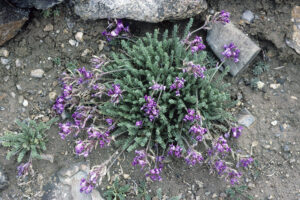
The flowers are arranged in a compact cluster at the end of a stalk to 10 cm long, densely hairy. The calyx is covered in black and white hairs, lobes pointed, to 2 mm long. Corolla blue, rarely purple or yellow, standard to 9 mm long and 3.5 mm wide, wings and keel slightly shorter. Flowering occurs June-September. The pod is inflated, almost globular, to 1 cm long and 8 mm broad, covered in long white hairs, ripening July-October.
This plant is found in dry stony areas on the Tibetan Plateau, southwards to Pakistan, Ladakh, Himachal Pradesh, and northern Nepal, at altitudes between 4,000 and 5,000 m.
The specific name refers to an area in Asia, formerly inhabited by Tatar-speaking Turkic peoples, from the Volga River and Crimea eastwards to western Siberia and Kazakhstan.
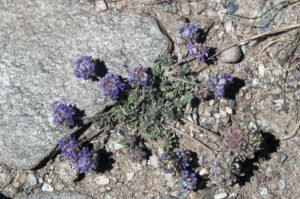
A densely tufted plant, to 10 cm high, covered in silvery-grey hairs on stems, leaves, and flower stalks. Leaves pinnate, to 8 cm long, leaflets numerous, elliptic, to 1 cm long.
Flowers are in dense globular heads, to 2 cm across, very long-stalked, stalk longer than the leaves. Flowers violet, to 8 mm long. Calyx with bristle-like teeth, to 5 mm long. The flowering period is long, from May to October. The pod is inflated, globular, to 1 cm across, densely woolly-hairy, ripening July-November.
The specific name commemorates British botanist John Williams (1915-1991), who made many contributions to the great work An Enumeration of the Flowering Plants of Nepal, edited by H. Hara, W.T. Stearn and L.H.J. Williams (London 1978).
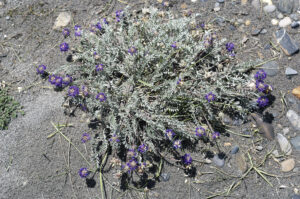
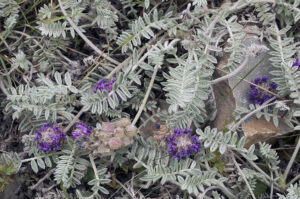
Flowers solitary or in pairs, long-stalked. Calyx bell-shaped, brown-hairy, with 5 lobes. Corolla bright blue or violet-blue, to 2.5 cm long, standard erect, stalked, with white streaks near the throat. The flowering period is long, from March to November. Pod straight, hairless, to 2.5 cm long, ripening between November and July.
It is distributed from the Indian Subcontinent eastwards to south-western China, and it also occures in Indochina, and on Java. In the Himalaya, it is quite common at altitudes between 900 and 4,300 m, distributed from Himachal Pradesh eastwards to Myanmar.
In Nepal, juice of the leaves is applied to wounds and boils. It is also utilized as fodder.
The generic name is derived from Ancient Greek para (‘near’) and okhetos (‘stream’), alluding to one of the habitats of the plant. The specific name is Latin, meaning ‘common’.

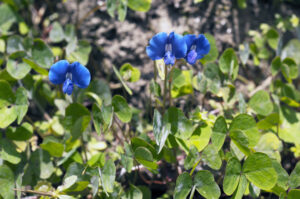
The generic name is derived from Ancient Greek pipto (‘to fall’) and anthos (‘flower’), referring to the early falling of the flowers.
Flowers are arranged in short terminal clusters, hairy, to 8 cm long. Bracts elliptic, densely woolly-haired. Calyx bell-shaped, to 1.6 cm long, grey-woolly, with blunt lobes. Corolla long-stalked, to 3 cm long, bright yellow with brown dots on the rounded, reflexed standard. It flowers from March to June. Pod long-stalked, linear-lanceolate, flat, to 15 cm long and 1.5 cm wide, not splitting. It ripens June-September.
This species is distributed from Himachal Pradesh eastwards to Myanmar and south-western China, nortwards to Gansu, at elevations between 1,600 and 4,000 m, growing in forests, shrubberies, and open areas. It is widely cultivated elsewhere as an ornamental.
In Nepal, the foliage is collected for fodder, and the stems are used for light construction and to make walking sticks. Bark and leaves are strewn in rivers to stupefy fish.
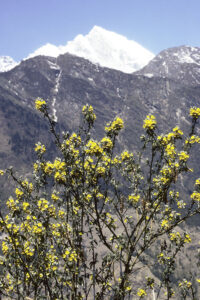
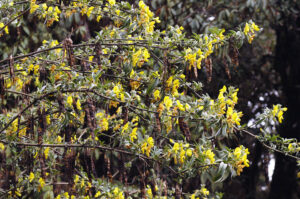
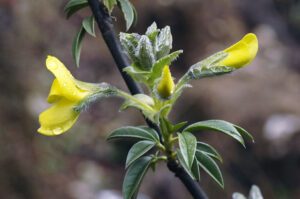
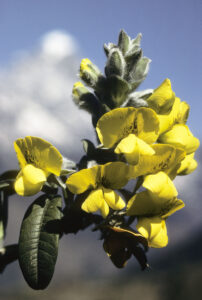
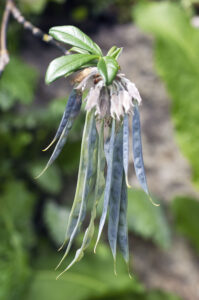
The generic name commemorates Swiss botanist and physician Marc Nicolas Puerari (1766-1845), a pupil of Danish botanist Martin Hendriksen Vahl (1749-1805). Although he spent the major part of his life as a professor in Copenhagen, he left his herbarium to a Swiss colleague, Alphonse Louis Pierre Pyrame de Candolle (1806-1893).
A twining vine up to 8 m long, woody at the base, all parts covered in yellowish hairs. Leaves trifoliate, terminal leaflet broadly ovate, to 15 cm long and 12 cm wide, pointed, lateral ones smaller.
Flowers are arranged in racemes to 30 cm long, 2 or 3 together at the nodes. Calyx to 2 cm long, covered in yellowish-brown hairs, with pointed lobes, slightly longer than the tube. Corolla to 4 cm long, purple or violet, with a large yellow spot on the broad standard, wings sickle-shaped, narrower than the keel. In the Himalaya, the flowering period is July-October. The pod is elliptic, to 14 cm long and 1.3 cm broad, flattened, covered in brown hairs. It ripens October-December.
It is regarded as an invasive plant in many places around the world, described on the page Nature: Invasive species.
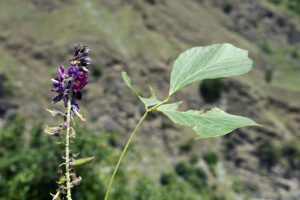
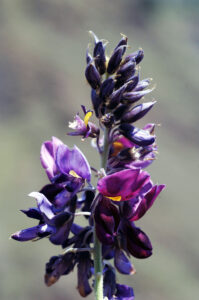
The generic name is derived from sophera, an Arabic name for a tree in the pea family.
Inflorescences are stalked, axillary or terminal racemes, to 5 cm long. Calyx bluish-white, densely hairy, to 7 mm long, with 5 teeth. Corolla to 1.5 cm long, usually blue, often with a white base, but yellow flowers are occasionally seen. Standard longer than wings and keel. Flowers occur May-July. The large pod is densely downy, to 10 cm long and 7 mm wide, constricted between the seeds. It ripens July-October.
This plant is found in shrubberies and dry stony areas at elevations between 2,800 and 4,500 m, distributed from Tibet southwards to Pakistan and Ladakh, and thence eastwards to Bhutan.
In Tibet, it is heavily exploited as a source of fuel and is now endangered here. The seeds are used for stomach trouble, and as an antidote to domestic animals which have eaten poisonous plants. It is also planted as a soil stabilizer in Tibet.
The specific name was given in honour of British veterinary surgeon and botanist William Moorcroft (1765-1825), who explored several areas in the Himalaya and Central Asia. He was the first European to make botanical collections in western Tibet and Kashmir.
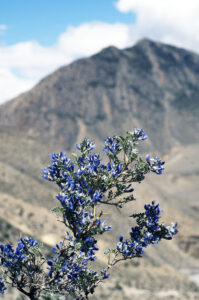
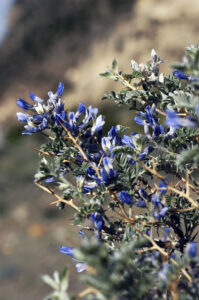
The leaves are trifoliate, and the pods are flattened, conspicuously jointed between the seeds.
The generic name honours Chinese botanist Hang Sun (born 1963), professor and director of the Kunming Institute of Botany, Yunnan Province.
The trefoil part of the popular name means ‘three-leaved’, alluding to the 3 leaflets, whereas the tick part refers to the pods, which easily break apart into segments, each one containing a single seed with small hooked hairs that stick to people’s clothes or the fur of an animal, similar to the way a tick clings on with its legs.
Inflorescences are terminal clusters, to 30 cm long, flowers stalked, to 1.7 cm long, corolla whitish, pink, lilac, or dark purple, or a combination. Calyx brownish, to 4 mm long, 4-lobed, shaggy-hairy. Flowering takes place June-September. The pod is linear, to 6 cm long and 6 mm broad, smooth or hairy, lower part of the margin indented between the seeds. It ripens August-October.
It is widely distributed, from Afghanistan eastwards along the Himalaya to south-western China, and thence northwards to Gansu and Shanxi, growing in forests, shrubberies, and open places, at altitudes between 1,000 and 4,000 m.
It is often cultivated as an ornamental. In Nepal, the root is used for cholera, and as a tonic, carminative, and diuretic, and the foliage is cut for fodder.
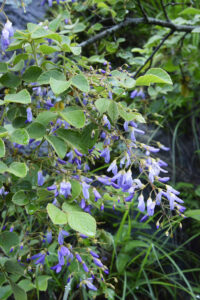
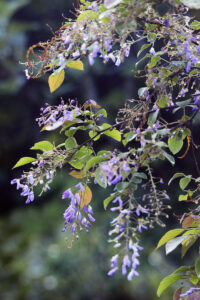
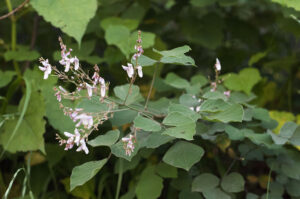
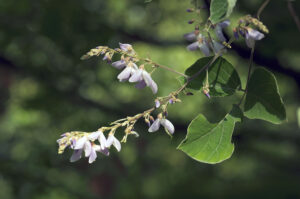
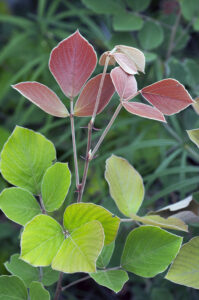
The generic name is derived from Ancient Greek thermos (‘heat’) and opsis (‘appearance’), thus ‘appearing to be burned’, referring to the blackish-purple flowers of T. barbata (below).
The flowers are in terminal racemes, calyx to 1.7 cm long, densely hairy, lobes to 1 cm long. Corolla deep chocolate-purple, rarely yellow, to 3 cm long, standard broadly ovate, often with a yellow centre and yellowish streaks, spreading star-like. Flowering occurs May-July. The pod is brown when ripe, oblong or elliptic, hairy, to 4.5 cm long and 1.8 cm broad, ripening period July-September.
It is very common on disturbed ground, including abandoned fields and heavily grazed slopes, at altitudes between 2,700 and 4,600 m, distributed from Xinjiang and Qinghai southwards across the Tibetan Plateau to Pakistan, and thence eastwards to Bhutan and south-western China.
The specific name is Latin, meaning ‘bearded’, referring to the densely hairy stems and leaves.
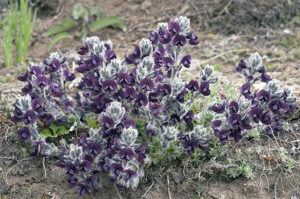

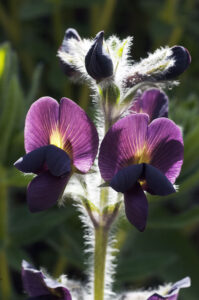
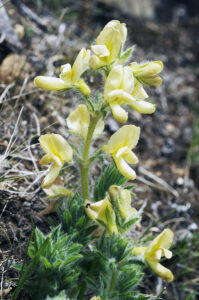
Flowers are in lax racemes, to 10 cm long, calyx to 1.7 cm long, hairy, teeth to 7 mm long. Corolla yellow, to 2.5 cm long. Flowering occurs June-July. Pod pale brown, broadly ovate, inflated, white-haired, to 5 cm long and 3 cm broad, curved downward, ripening July-August.
It grows in dry stony areas and along streams at altitudes between 4,000 and 5,000 m, from southern Xinjiang southwards across the Tibetan Plateau to Pakistan, Ladakh, and Himachal Pradesh, and also in northern Bhutan.
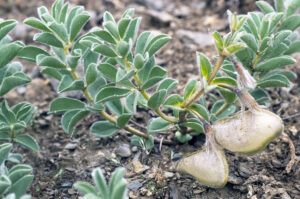
Flowers are in terminal racemes, to 17 cm long, calyx densely hairy, to 2.2 cm long, teeth lanceolate, as long as tube. Corolla yellow, to 2.8 cm long, standard rounded, deeply notched, wings linear-oblong. It flowers May-July. The pods are brown when ripe, linear, flattened, hairy, to 9 cm long and 1.2 cm broad, with a beak. They ripen June-October.
It is distributed from Kazakhstan, Kyrgyzstan, Xinjiang, Mongolia, and southern central Siberia southwards across the Tibetan Plateau to extreme northern Nepal, growing in dry open areas at elevations between 3,600 and 4,300 m. It is often a weed in fields.
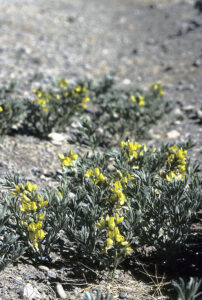
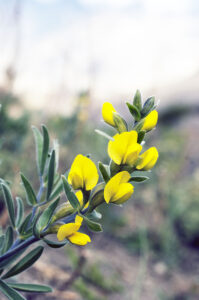
The flowers are in groups of 1-3, sometimes 4, on thread-like stalks, calyx hairy, to 5 mm long, with tiny, unequal lobes. Corolla violet, blue, or deep mauve, sometimes red, to 9 mm long, standard to 8 mm long and wide, sometimes broader than long, wings obovate, to 7 mm long, keel very short. Flowering takes place between May and August. The pods, which are linear, inflated, hairless or hairy, to 1.3 cm long, ripen July-September.
It grows in open drier areas at elevations between 3,000 and 5,000 m, distributed from Gansu and Qinghai southwards across Tibet to Pakistan, and thence eastwards to south-western China.
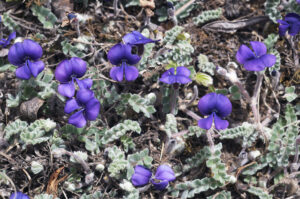
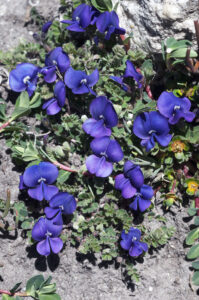
The leaves are trifoliate, and the pod is small, containing a single seed.
The generic name was the classical Latin word for clover, meaning ‘with 3 leaves’, referring to the leaflets.
The flowers are arranged in globular heads, to 3.5 cm across, calyx downy, lowest tooth longer than cup. Corolla reddish-purple to pink, rarely white, to 1.5 cm long, standard spatulate, tip rounded. Flowering period long, from April to September. Pod 1-seeded, opening by a lid, ripening June-October.
This plant is native to Temperate Eurasia and North Africa, growing in open areas. In the Himalaya, it occurs from Pakistan eastwards to Himachal Pradesh.
It is widely cultivated around the globe as fodder, bee-plant, or nitrogen-fixer. In Nepal, it is utilized medicinally for various ailments, including cough and skin problems.
The specific name is Latin, meaning ‘growing in meadows’.
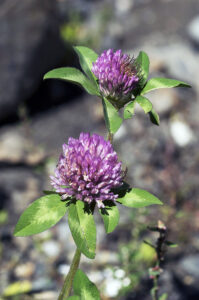
It grows in open areas and fallow fields, occurring in Temperate Eurasia and North Africa. In the Himalaya, it is found from Pakistan eastwards to Myanmar, growing at altitudes between 1,300 and 2,500 m.
It is widely cultivated as fodder, bee-plant, or nitrogen-fixer.
The specific name is Latin, meaning ‘creeping’.
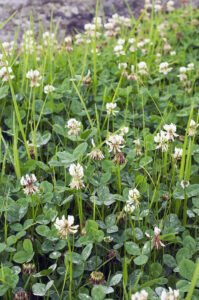
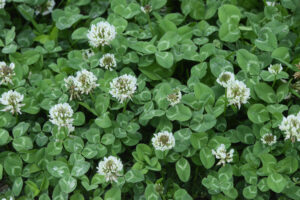
The generic name is the classical Latin word for vetch.
The inflorescence is a raceme with up to 30 flowers, usually 10-15 cm long, but sometimes to 30 cm, densely hairy. Corolla to 1.8 cm long, blue or purple, rarely white, but keel often white, standard to 1.5 cm long, keel a bit shorter. Flowering occurs June-September.
A widely distributed species, found in the major part of Europe and northern Asia, eastwards to central Siberia, southwards to Morocco, Jordan, the Himalaya, northern China, and Japan, growing at forest edges and in open areas. In the Himalaya, it is usually found at elevations between 1,600 and 2,200 m.
The specific name is Latin, meaning ‘with thin leaves’.
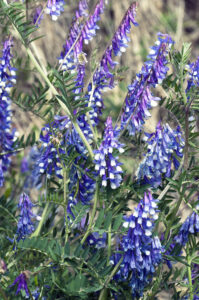
The generic name is derived from Ancient Greek kastana, the classical name of the chestnut tree (Castanea sativa), and opsis (‘appearance’), thus ‘looking like a chestnut tree’.
The name chinkapin is a corruption of an Algonquian word, chechinquamin or chincomen, possibly from xinkw (‘great’) and mini (‘fruit’).
The spiny fruits may constitute a health hazard. Once, as I was walking in a forest near Pokhara, Nepal, a bunch of fruits of Castanopsis indica fell from a tall tree, landing on my bare arm, where they got stuck in the skin. Even though the spines do not possess barbs, it took some effort to loosen the fruits from the skin.
Flowering spikes are erect, dense, cream-coloured, 25-40 cm long. Fruit cluster often branched, to 15 cm long. Flowering time is October-November. Fruit globular, hairy, to 4 cm across, covered with straight spines. It ripens the following year from September to November.
This species is found from central Nepal and southern Tibet eastwards to Taiwan, and thence southwards to Bangladesh and Indochina. In the Himalaya, it grows in open forests and shrubberies, and on open slopes, at elevations between 1,000 and 2,900 m.
The wood is used for roof-shingles, and as fuel. The foliage is lopped for fodder, and leaves are also wrapped around tobacco to smoke as a cigar. In Nepal, juice of the bark is used for indigestion, juice of the leaves for stomach troubles. Embryo and fruits are edible.
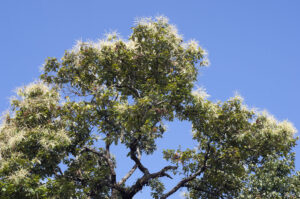
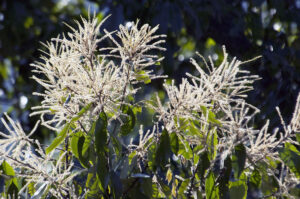
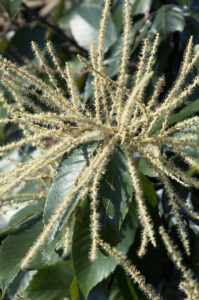
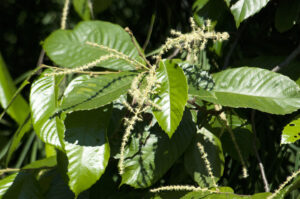
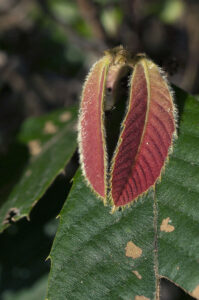
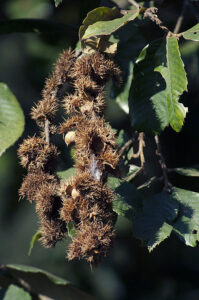
Flowering spikes erect or pendent, cream-coloured or white, male spikes densely clustered, to 20 cm long, female spikes solitary. Flowering takes place March-May, less commonly August-September. The fruit cluster is often branched, to 25 cm long, fruit globular or ellipsoid, to 2.2 cm across, only partly covered with spines. Fruits ripen the following year from September to November.
It grows in forests, distributed from Uttarakhand eastwards to northern Thailand and the Yunnan Province, at altitudes between 500 and 2,300 m.
The wood is utilized as timber. Leaves are lopped for fodder. The nut is edible, raw or roasted.
The specific name means ‘resembling Tribulus’, a plant of the family Zygophyllaceae (below). This word is derived from Ancient Greek tribolos, meaning ’caltrop’, a small metal object with several spikes, of which one is always pointing upwards. In the old days, these weapons were spread on roads and footpaths to prevent traffic of the enemy’s soldiers, horse riders, and horse-drawn vehicles. The name probably refers to the spiny fruits.
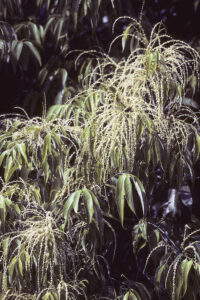
Male flowers are in pendent catkins, females mostly in erect spikes. The fruit is a nut, called an acorn, which is partly enclosed in a cupule (see family above), consisting of overlapping bracts, mostly with free tips.
The generic name is the classical Latin term for oaks. It probably stems from the name of the Lithuanian god of thunder, Perkunas. The word oak is from the Anglo-Saxon ek, in ancient Germanic aik, of uncertain origin and meaning.
Selections of pictures, depicting oaks, may be seen on the pages Autumn, and Plants: Plants in folklore and poetry.
It is distributed from Afghanistan eastwards to central Nepal, growing in forests at elevations between 1,800 and 2,900 m.
The wood is used for many items, and also as fuel and for charcoal. The foliage is lopped for fodder.
The specific name is Latin, meaning ‘with an abundance of flowers’.
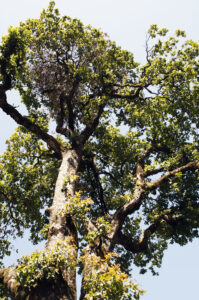
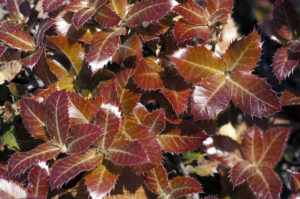
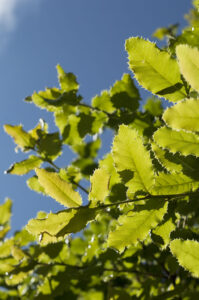

An evergreen tree to 20 m tall, bark rough and fissured on older trees. Leaves short-stalked, obovate to oblong-elliptic, leathery, to 13 cm long and 5.5 cm broad, long-pointed, often wider and toothed towards the tip, with 9-13 pairs of veins.
Male catkins solitary or in a lax cluster, to 8 cm long. Female spikes to 3 cm, long with 2-3 fruits. They occur April-May. The cupule is bowl-shaped, to 8 mm long and 1.4 cm across, enclosing less than half of the acorn, outside sometimes with white hairs, bracts in 5-8 velvety rings, crowded. The acorn is ovoid or ellipsoid, to 1.6 cm long and 1.4 cm broad, glabrous or rarely hairy. Ripening takes place between October and March.
The wood is used as fuel, and the foliage is lopped for fodder.
The specific name is derived from Ancient Greek glaukos (‘blue-green’ or ‘blue-grey’), presumably alluding to the foliage.
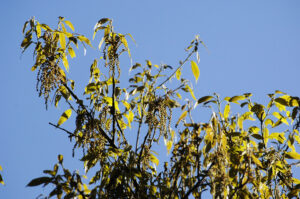
Male catkins are woolly-hairy, female inflorescences axillary on young shoots, 4-14 cm long. Flowering occurs June-July. Cupules are solitary or in pairs, to 1 cm long and 1.5 cm wide, with downy bracts, enclosing about half of the ovoid-conical acorn, to 2 cm long and 1.2 cm broad, hairless, ripening June-July the following year.
It is distributed from Uttarakhand eastwards to northern Indochina and south-western China, found in forests at altitudes between 1,400 and 3,000 m.
The wood is used for construction and tool handles, and as fuel, and the foliage is lopped for fodder. In Nepal, juice of the bark is applied to sprains, and a paste of the cotyledon to scorpion bites. Powdered resin is used for dysentery, and it is also boiled and drunk as tea. The bark can also be boiled to make tea.
The specific name is Latin, meaning ‘woolly’, referring to the underside of the leaves.
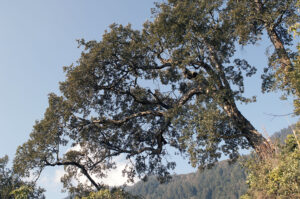
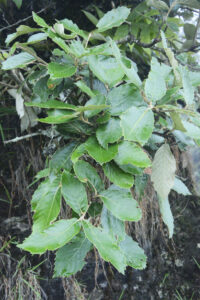
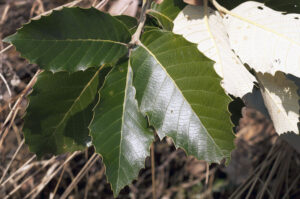
An evergreen tree to 18 m tall, gregarious. The twigs are white-woolly. Leaves are stalked, leathery, dull-green above, white-woolly beneath, elliptic-lanceolate, long-pointed, to 15 cm long and 5 cm broad, with 11-20 pairs of veins, margin strongly saw-toothed. Male catkins to 14 cm long, appearing in April-May. Cupules are solitary, to 1.5 cm across, covering half of the ovoid acorn, to 2 cm long. Fruits ripen August-December.
The wood makes excellent fuel. It is hard and strong, mostly used for agricultural tools. The foliage is lopped for fodder, and it also makes excellent compost. The acorns are utilized in traditional medicine.
The specific name is Ancient Greek, meaning ‘bearing white hairs’, referring to the underside of the leaves.
An obsolete name for this tree is Quercus incana. However, this name is today used for an American species.
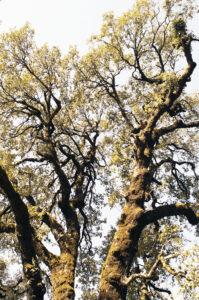
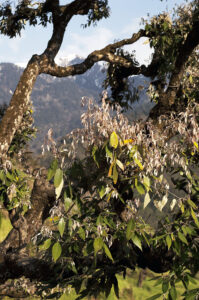
Male catkins are dense and downy, to 8 cm long, female inflorescences to 7 cm long. Flowering takes place May-June. The cupule is very short, to 8 mm long, acorn almost globular, sometimes purplish-brown or black, to 3 cm across. Fruits ripen August-October the following year.
This species is very common in forests, found at altitudes between 1,700 and 4,000 m, from Afghanistan eastwards to Nepal and extreme southern Tibet.
The wood is used for construction, and as fuel. The bark yields tannin, and juice of it is applied to aching muscles. The foliage is cut for fodder, and tea is made from the sap.
The specific name means ‘with leaves like Semecarpus’, a genus of trees in the family Anacardiaceae. A popular name of the species is spiny-leaved oak, which is somewhat misleading, as the leaves of older trees usually have entire margins.
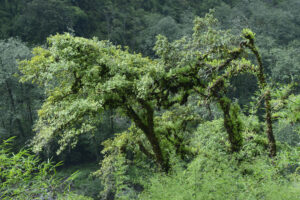
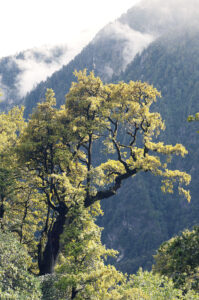
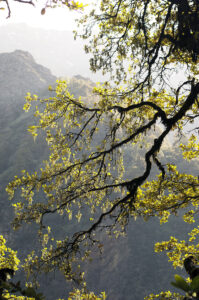
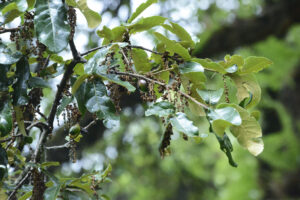
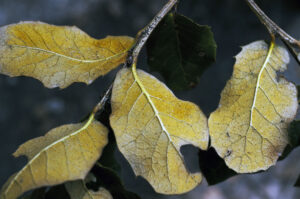
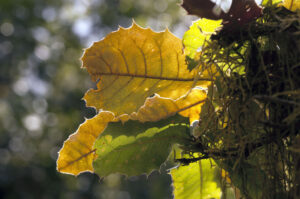
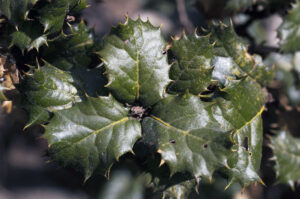


Members of this genus were previously placed in the genus Gentiana, but differ in the flowers, which often have tufts of narrow lobes or hairs in the throat, and no lobules between the corolla-lobes. In many species, the tuft in the throat is surrounded by a dark band.
The generic name is derived from Ancient Greek kome (‘hair of the head’) and stoma (‘mouth’), alluding to the flowers of some members having hairs in the throat.
Flowers are terminal, solitary, mostly with 5 spreading lobes, but sometimes only 4 on lateral branches. Calyx to 4 mm long, lobes slightly unequal, lanceolate or broadly lanceolate, margin sometimes blackish, tip pointed. Corolla tube yellowish with purplish longitudinal veins, to 1 cm long and 4 mm wide, elongating in fruit, lobes ovate-oblong, to 1 cm long, spreading, pale blue or purplish-blue, with a dark band surrounding numerous narrow, white lobes in the throat. Anthers yellow. Flowering occurs July-October.
This plant is found on open slopes, along river banks, and in grasslands at elevations between 3,000 and 5,000 m, from Pakistan eastwards to Bhutan and south-western China.
The specific name stems from the Latin pedunculus, from pedis, genitive of pes (‘foot’), in a botanical context referring to the flower stalk, thus ‘with long flower stalks’.
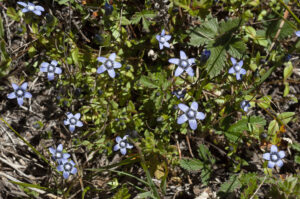
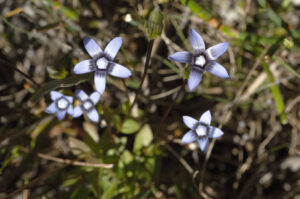
Formerly, this genus contained about 650 species, but about 250 have been moved to the genus Gentianella, c. 24 to Gentianopsis, and c. 15 to Comastoma.
The name of these plants was derived from King Gentius, who ruled in Ancient Illyria 181-168 B.C., and who allegedly discovered the medicinal value of the great yellow gentian (G. lutea). This species is described on the page Plants: Flora of the Alps and the Pyrenees.
It grows in shrubberies and grasslands, and along forest edges, at elevations between 1,500 and 4,500 m, distributed from Pakistan eastwards to Myanmar and south-estern Tibet.
In Nepal, juice of the plant is taken for fever, and a paste of the plant for headache.
The specific name is Latin, meaning ‘having a head’, referring to the dense inflorescence.
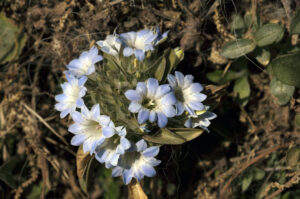
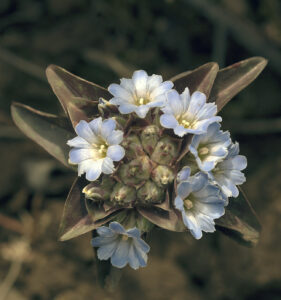
Corolla tube bell-shaped, to 3 cm long, greenish-white or yellowish with purple longitudinal streaks outside, and numerous dark green or purplish dots inside, lobes bright blue, to 7 mm long, pointed or rounded, alternating with pale blue or purplish, slightly smaller lobules. It blooms between August and November.
It grows on open slopes and among rocks at altitudes between 3,000 and 4,500 m, from central Nepal eastwards to Sikkim and south-eastern Tibet.
The specific name presumably alludes to the dense cluster of leaves near the ground.
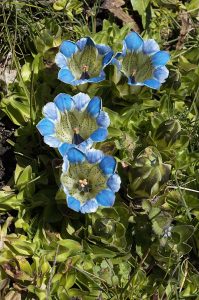
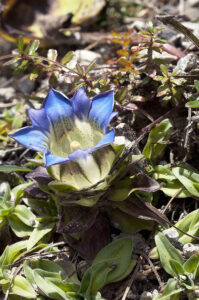
This plant is found from Nepal eastwards to Arunachal Pradesh and south-eastern Tibet, growing on open slopes at altitudes between 4,000 and 4,200 m.
It was named for British naturalist and explorer Henry John Elwes (1846-1922), who collected many plants, especially lilies, during trips to the Himalaya and Korea. He was among the first persons to receive the Victoria Medal of the Royal Horticultural Society, in 1897.
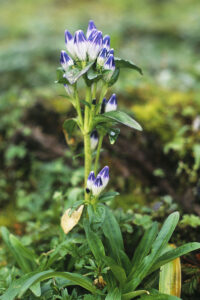
This species is found in grasslands and along streams at elevations between 1,900 and 5,000 m, distributed from Kazakhstan, Xinjiang, southern Russia, and Mongolia southwards to Pakistan, Ladakh, Nepal, and Sikkim. It is quite common in Ladakh.
The specific name is derived from Ancient Greek leukos (‘white’) and melaina (‘black’), presumably alluding to the dotted white petals. However, the dots are not black, but dark blue.
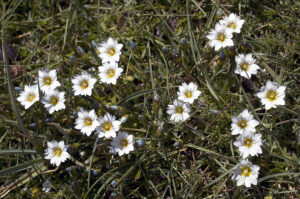
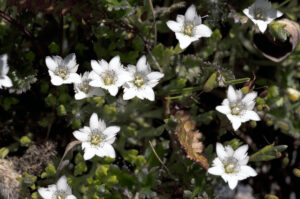
Stem ascending, to 7 cm tall. Basal leaves in a rosette, blade linear, to 3.5 cm long and 4 mm wide. Stem leaves elliptic to ovate, upper linear, to 1.5 cm long and 2.5 mm broad, uppermost surrounding the calyx. Flowers solitary, terminal, stalkless, to 4 cm long, sky-blue or pale blue, lower two-thirds of tube white or yellowish with 3 dark purple, longitudinal streaks outside, with purple dots between them, and numerous purple dots inside, lobes broadly triangular, to 3.5 mm long, tip pointed or blunt, lobules slightly smaller, often ragged at the tip.
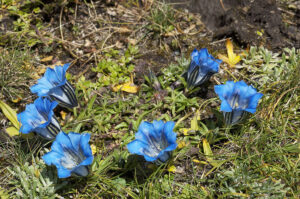
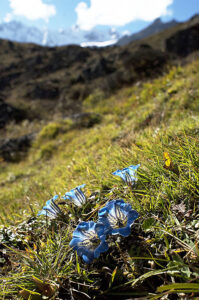
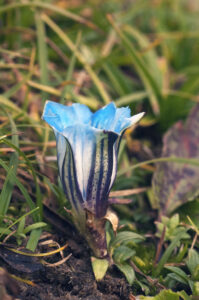
This plant is very common on grazing grounds and in forest clearings in the entire Himalaya, at altitudes from 750 to 3,800 m, and is also distributed in south-western China, and in montane areas of South India and Sri Lanka.
In Nepal, tender parts are cooked as a vegetable, and juice of the plant is taken to expel intestinal worms.
The specific name stems from the Latin pedis, genitive of pes (‘foot’), in a botanical context referring to the flower stalk, and atus (‘having’), thus ‘with flower stalks’, here presumably meaning ‘with long flower stalks’.
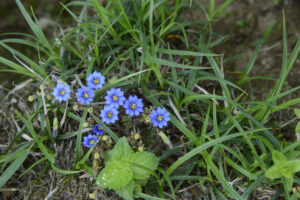
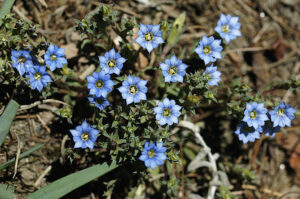
Members of this genus were previously placed in the genus Gentiana, but differ in the flowers, which often have tufts of narrow lobes or hairs in the throat, and no lobules between the corolla-lobes.
The generic name is a combination of the genus name Gentiana, and the diminutive suffix ella, thus ‘small gentian’.
This species is found in open areas and grasslands, and along streams, distributed from Pakistan eastwards to central Nepal, at altitudes between 2,700 and 4,800 m. It is very common in Lahaul and Ladakh.
In Nepal, an infusion is applied to the forehead to relieve fever. It is also used for bile and liver problems.
The specific name was given in honour of British veterinary surgeon and botanist William Moorcroft (1765-1825), who explored several areas in the Himalaya and Central Asia. He was the first European to make botanical collections in western Tibet and Kashmir.
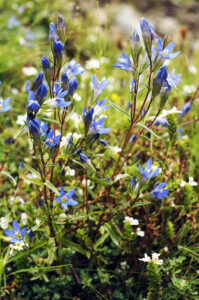
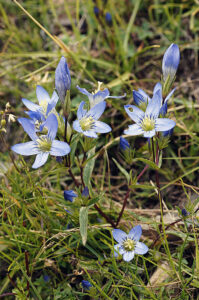
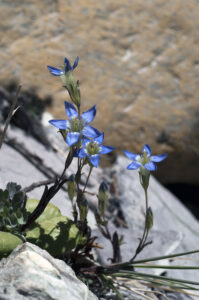
Members of this genus were previously placed in the genus Gentiana, but differ in the flowers, whose petals are more or less fringed with hairs or pointed lobes.
The generic name is composed of the genus name Gentiana, and Ancient Greek opsis (’resembles’).
Flowers solitary, terminal, calyx funnel-shaped, to 3.5 cm long, lobes variable, pointed, outer narrowly triangular, to 1.2 cm long, inner ovate, to 1 cm long, margin membranous, midvein keeled. Corolla broadly tubular, to 6.5 cm long, sky-blue or pale blue with pale yellow base, entire corolla sometimes yellowish-white or yellow, lobes broadly oblong, to 1.7 cm long, tip rounded, abruptly narrowed to a sharp point, margin weekly fringed towards the base. It blooms from July to September.
It is distributed in drier regions, from northern Tibet and Inner Mongolia southwards through Tibet and western China to Ladakh, Nepal, Sikkim, Bhutan, and the Yunnan Province. In the Himalaya, it grows in grasslands and shrubberies at elevations between 3,000 and 4,900 m. It is common in Ladakh.
A paste of the root is applied to wounds, and to the forehead to relieve headache. Other parts are used for bile and liver disorders, and fever.
The specific name is derived from the Latin palus (‘swamp’ or ‘marsh’) and osus (‘full of’), thus ‘fond of marshes’.
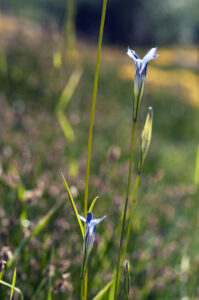
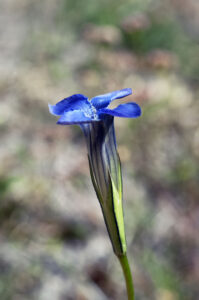
The generic name honours Swedish physician Jonas Petri Halenius (1727-1810), who was a pupil of the famous Carl Linnaeus (1707-1778).
Flowers are few together, axillary or terminal, corolla bell-shaped, pale blue to purple, to 2.5 cm long and 8 mm across, lobes elliptic or ovate, spurs about 1 cm long. Flowering occurs July-October.
This plant is widely distributed, found in central and western Asia, eastwards to China and Myanmar. It is quite common in the entire Himalaya at elevations between 1,800 and 4,500 m. Habitats include forest edges, open slopes, and grasslands.
In Nepal, juice of the plant is taken for fever.
The specific name may refer to the leaves or to the corolla lobes.
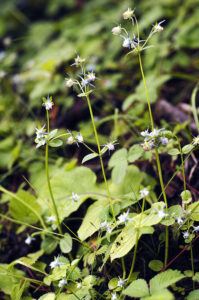
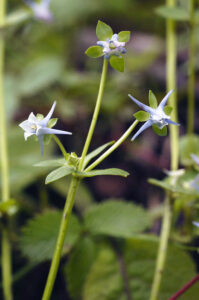
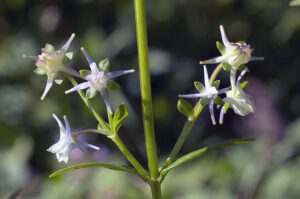
The generic name is Greek, referring to the fringed margin of the ovary, formed by the stigma.
Inflorescences are long-stalked, lax, terminal or axillary clusters, sepals elliptic, ovate, or rarely lanceolate, to 8 mm long and 2.5 mm wide, tip pointed or obtuse. Corolla about 2 cm across, with a very short tube and 5 spreading, elliptic or ovate, pointed lobes, to 1.5 cm long, pale blue with darker blue or green veins, and fringed nectaries at the base. It flowers August-October.
This species is very widely distributed, from Europe eastwards across western, northern, and central Asia to Japan. In the Himalaya, it is found in shrubberies and grasslands, and on open slopes, at altitudes between 3,000 and 5,400 m.
The specific name refers to the Austrian state Carinthia. Presumably, the type specimen was collected there.
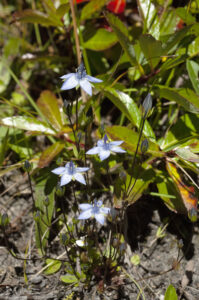
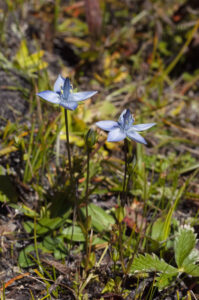
The generic name was applied in 1737 by Swedish naturalist Carl Linnaeus (1707-1778) in honour of Dutch painter and horticulturist Emanuel Sweerts, or Swert (1552-1612), who published Florilegium Amplissimum et Selectissimum (1612), a work depicting about 560 bulbs and flowers.
Inflorescences are spreading, branched, many-flowered clusters, flowers to 9 mm across, tube 1-2 mm, lobes to 6.5 mm long, tip pointed. Flowering takes place August-October.
It grows in shrubberies and on grazing grounds, from subtropical valleys up to altitudes around 3,300 m, distributed from Pakistan eastwards to China and northern Vietnam. It is very common in the Himalaya.
In Nepal, juice of the root is taken for fever.
The specific name is Latin, meaning ‘having narrow leaves’.
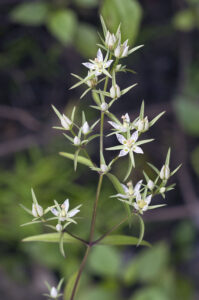
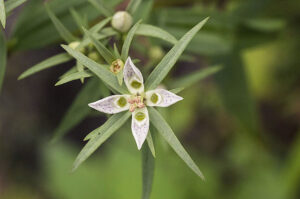
The stem is erect, to 50 cm tall, branched, 4-angled. Leaves are sessile or short-stalked, lanceolate or narrowly ovate, to 4.5 cm long and 2 cm wide, with 3-5 veins, tip pointed, margin slightly wavy.
Inflorescences are spreading, branched, many-flowered clusters, flowers stalked, to 1.2 cm across. They are very spectacular, having 5 ovate, bluish-white or purplish corolla lobes, abruptly tapering to a long point, with a purple band surrounding the green nectaries at the base, and densely clustered filaments, which are purple near the base, yellowish on the outer half. Flowering occurs June-September.
The Latin name means ‘hairy’. What it alludes to is not clear.
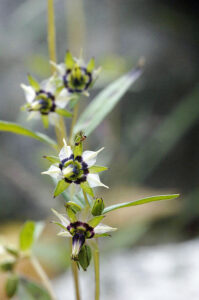
Inflorescences are dense, many-flowered clusters, to 40 cm long. Corolla is yellowish-white, to 1.5 cm across, the 5 narrowly elliptic lobes pointed, to 1 cm long, with many purple markings along the margin, and yellow nectaries at the base. It blooms September-October.
It is widely distributed, from Pakistan eastwards to Myanmar and the Yunnan Province, growing in grasslands and on open slopes at altitudes between 1,700 and 4,000 m.
The specific name is Latin, meaning ‘heart-shaped’, referring to the leaves.
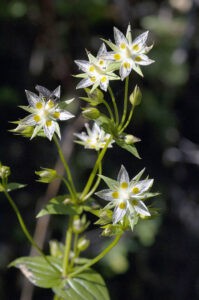
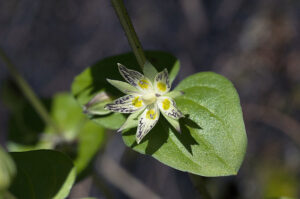
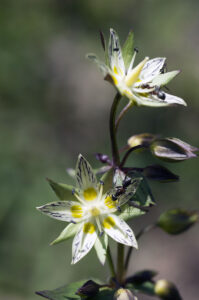
Inflorescences are raceme-like, lax clusters with 5-7 flowers, corolla to 3 cm across, tube very short, to 2 mm, lobes pale blue with dark-blue veins. There are 2 linear nectaries per corolla lobe, very small, often surrounded by numerous fuzzy, purplish-blue hairs. Flowering occurs August-October.
This plant is found in grasslands and on open slopes at elevations between 3,600 and 5,000 m, distributed from Uttarakhand eastwards to Bhutan.
The specific name is Latin, meaning ‘wedge-shaped’, perhaps referring to the petals.
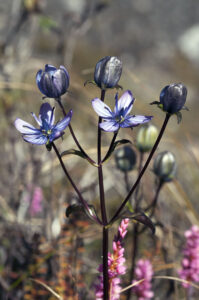
It has a very restricted range, from north-eastern Bhutan eastwards to north-western Arunachal Pradesh, growing at high altitudes.
The specific name is Latin, meaning ‘with large flowers’.
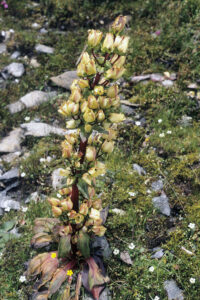
The many-flowered inflorescences are stalked clusters above each whorl of leaves. Corolla bell-shaped, to 2.5 cm across, with 4 oblong lobes, variously coloured, yellow, purplish, or pale blue, with maroon or dark-blue veins, to 1.8 cm long and 1.1 cm wide, tip rounded. There is one round, naked nectary per corolla lobe. Flowering takes place July-September.
This species has a rather limited distribution, from eastern Nepal eastwards to Arunachal Pradesh and south-eastern Tibet, growing in grasslands and shrubberies, and on open slopes, at elevations between 3,600 and 4,300 m.
The specific name honours British botanist Joseph Dalton Hooker (1817-1911), who described numerous new plant species in the eastern Himalaya (see Rhododendron dalhousiae, Himalayan flora 1).
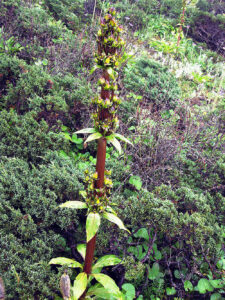
Inflorescences are many-flowered, spreading clusters, flower-stalks erect, to 1.5 cm long. Corolla tube very small, to 1.5 mm long, with 5 gorgeous, spreading, broadly ovate, pointed lobes, to 8 mm long, which are white, yellowish-white, yellowish-green, or purplish-white, with 2 bright green spots and a narrow purple band above each nectary. Flowers occur August-October.
This species grows at elevations between 2,800 and 3,300 m, from Pakistan eastwards to Myanmar and the Yunnan Province. Habitats include forests, shrubberies, and open slopes.
Parts of the plant are used for treatment of malaria and other types of fever, and a decoction is drunk as a tonic.
The specific name alludes to the inflorescences, which are arranged in panicles.
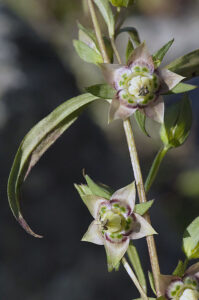
The stem is erect, sometimes to 60 cm tall, but usually lower. Basal leaves long-stalked, obovate, oblong, or broadly spatulate, to 15 cm long and 3 cm broad, stem leaves smaller.
Flowers are borne in a lax, terminal, spike-like cluster. Corolla to 2 cm across, tube short, to 2 mm, with 5 spreading lobes, elliptic or oblong, yellowish-white or bluish-white, with dark-green veins, to 1.2 cm long and 3 mm wide, tip rounded, margin somewhat in-rolled. 2 greenish nectaries per lobe, encircled by a narrow green band and with numerous fuzzy hairs. Blooming occurs July-August.
Medicinally, it is utilized for bile and liver disorders, and for fever. In Pakistan, the root is used for eye diseases.
The specific name is Latin, meaning ‘having a leaf-stalk’.
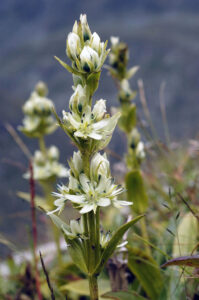
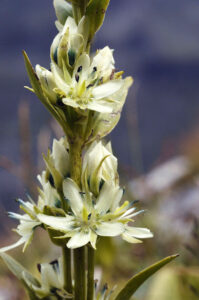
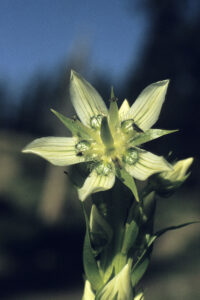
The generic name is derived from Ancient Greek tri (‘three’), pteron (‘wing’), and sperma (‘seed’), thus ‘the one whose seeds have three wings’.
It is distributed from central Nepal eastwards to Myanmar and south-eastern Tibet, growing in forests and shrubberies at elevations between 2,000 and 3,200 m.
The specific name is derived from the Latin volvo (‘I turn around’), alluding to its twining stems.
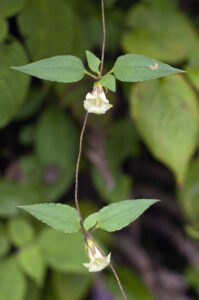
Stipules are often distinct on these plants. After flowering, the style forms a long, straight or up-curved beak, which separates into 5 elastic spring-like coils, each containing a single seed that is expelled, usually when the style is touched.
The generic name is derived from Ancient Greek geranos (‘crane’), alluding to the fruit, whose shape resembles a crane’s bill.
In German, these plants are called Storchschnabel (‘stork’s-bill’). In 1542, German physician and botanist Leonhart Fuchs (1501-1566) writes in his great herbal De Historia Stirpium Commentarii Insignes (‘Notable Commentaries on the History of Plants’): “Storckenschnäbel seind von den Griechen unnd Lateinischen genemt worden Gerania, darumb das sie am obersten teyl des stengels bringen ein köpfflin mit langen schnäbelin, nit anderst dann die Krench oder Storcken. Unnd daher kompt es, das zu unsern zeiten würdt Rostrum ciconiae geheyssen, das ist Storckenschnabel.” (‘By the Greeks and the Latinos, stork’s-bill is called Gerania, because at the top of the stem they bring a small head with long bills, no different from the bill of cranes or storks. And therefore, in our time, they are called Rostrum ciconiae, i.e. stork’s-bill.’)
The stem is ascending, sometimes erect, downy, to 30 cm tall. The opposite leaves are to 5 cm long, with a stalk to 23 cm long on lower leaves, upper leaves smaller and stalkless. Stipules are distinct, lanceolate, to 9 mm long. Stem leaves to 5 cm across, deeply cut into 5 rhombic-ovate lobes, which are again deeply cut.
Flowers are solitary or in pairs, 4-5 cm across, petals usually deep blue, sometimes purplish-blue or white, to 3 cm long, tip rounded. Flower-stalk to 14 cm long, glandular-hairy. Stigma pink to purplish. Flowering occurs May-August. The ripe fruit is to 4.7 cm long, reflexed when young, ripening June-September.
This species is quite similar to meadow crane’s-bill (G. pratense, below), which grows in drier areas of the Himalaya. As a rule, Himalayan crane’s-bill is a larger plant, with petals up to 3 cm long, versus 2 cm in meadow crane’s-bill. Its fruits are also larger, to almost 5 cm long, versus c. 3.5 cm in meadow crane’s-bill. The leaves of Himalayan crane’s-bill have 5, sometimes overlapping segments, versus 5-7 in meadow crane’s-bill, and the leaf-stalks are relatively shorter.
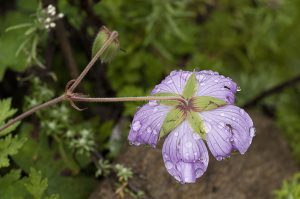
Flower-stalk to 8 cm long, flowers single or in pairs, to 1 cm across, petals 5, white or pinkish with violet longitudinal streaks, spreading, hairy, to 6 mm long, tip rounded or slightly notched. Filaments are whitish, anthers violet, stigma reddish. The flowering period is long, from March to September. The fruit is to 1.8 cm long, erect when young, ripening between May and November.
This plant is very widely distributed, from Afghanistan eastwards to southern China and northern Vietnam, and also in montane areas of southern India, Sri Lanka, and northern Sumatra. In the Himalaya, it is quite common, found at elevations between 1,000 and 4,000 m. Habitats include forest margins, shrubberies, and streamsides.
The fruit is edible. The root contains tannin. In Nepal, the plant is utilized medicinally for kidney trouble.
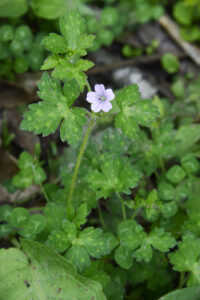
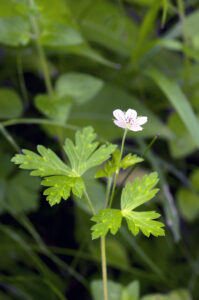
The stems are slender, erect or ascending, to 35 cm long, downy or glandular-hairy. Stipules distinct, lanceolate, hairy. Leaves are opposite, very variable, sometimes rounded in outline, to 6 cm across, palmately cleft, 5-7-lobed, the 2 outer smaller, lobes again divided into 3-19 segments.
It is very widely distributed, from northern Africa and the Middle East eastwards to Afghanistan, the Himalaya, and western China. In the Himalaya, it is found in shrubberies and grasslands at elevations between 900 and 3,000 m.
The plant is astringent and diuretic. In Nepal, the juice is used to treat amoebic dysentery.
The specific name is Latin, meaning ‘having small eyes’, alluding to the black centre of the flower.
The flowers are quite similar to those of G. procurrens (below), but smaller, to 2 cm across, and the dark centre is sharply defined, versus a diffuse black centre in G. procurrens. Also, it blooms in spring, versus during the monsoon in G. procurrens.

Inflorescences are dense umbel-like clusters, 2-3-flowered, flowers to 4 cm across, sepals to 8 mm long, covered in soft, spreading, glandular hairs. Petals are red, reddish-purple, or pinkish, to 1.4 cm long, margin hairy at the base, tip rounded. Filaments are white, anthers yellow, stigma pinkish. Flowering takes place June-September. The fruit is to 2.1 cm long, erect when young, ripening August-November.
This plant is found in forests and shrubberies, and on open slopes, at elevations between 2,400 and 4,500 m, from Uttarakhand eastwards to Bhutan and south-western China.
The specific name is derived from Ancient Greek polys (‘many’) and anthos (‘flower’).
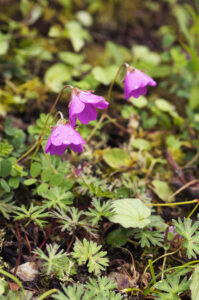

It is widely distributed, found from Europe across Siberia to Mongolia, and thence southwards to Afghanistan, Ladakh, and central Nepal. In the Himalaya, it grows in drier areas at altitudes between 1,400 and 4,500 m. It is common in northern Himachal Pradesh. Habitats include shrubberies and grasslands, often along irrigation channels.
In Nepal, an extract of the leaves is used for fever, pneumonia, swelling of limbs, dysentery, and diarrhoea.
The specific name is Latin, meaning ‘growing in meadows’.
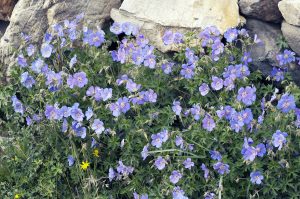
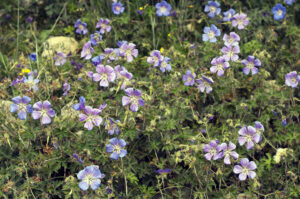
Stem to 2 m long, branched, ascending, scrambling, or pendent from banks. Leaf-blade to 6 cm across, cut three-quarters into 5 rhombic lobes, which are again cut into blunt or pointed segments. Stipules free, to 9 mm long.
Inflorescences are umbel-like clusters, flower-stalk densely glandular-hairy, flowers to 4 cm across, reddish-purple with a diffuse black centre, sepals to 8 mm long, covered in soft, spreading, glandular hairs. Flowering takes place July-September, fruits ripening August-November.
The specific name is Latin, meaning ‘running’, referring to the long, scrambling stems.
The flowers are quite similar to those of G. ocellatum (above), but are larger, to 4 cm across, and the dark centre is diffuse, versus a sharply defined black centre, forming a pentagon, in G. ocellatum. Also, it blooms during the monsoon, versus in spring in G. ocellatum.
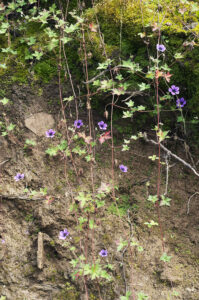

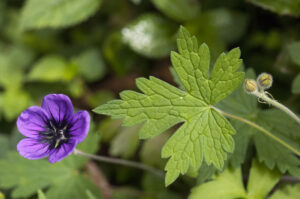
Flower-stalk long, glandular-hairy, flowers in pairs, nodding, to 4 cm across, sepals reflexed, to 1.1 cm long, downy, petals reflexed, white or pinkish with purple veins, to 2 cm long, stamens and style protruding, filaments reddish-purple to pink, anthers blackish, stigma pale pink to purplish. It blooms between June and September. The fruit is to 3 cm long, nodding when young, ripening July-October.
It grows in shrubberies and grasslands, and on open slopes, found at elevations between 1,800 and 4,800 m, from central Nepal eastwards to Myanmar and south-western China.
In Nepal, juice of the root is applied to wounds, a paste of the plant to boils.
The Latin specific name may mean ‘open’, perhaps referring to the wide space between the petals.
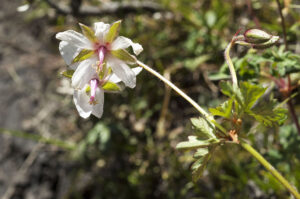
Flower-stalk to 9 cm long, glandular-hairy. Flowers are in pairs, to 4 cm across, petals to 2 cm long, deep pink, purplish, or blue, with a whitish centre, or sometimes the entire flower is white. Flowering occurs June-September. The ripe fruit is to 4 cm long, erect when young, ripening August-November.
It is distributed from Afghanistan eastwards to Bhutan and south-eastern Tibet, found in shady forests and shrubberies at altitudes between 1,600 and 4,200 m.
In Nepal, the plant is cut for fodder. The root is taken for peptic ulcer. Juice of the plant is utilized to stop bleeding, and a paste of it is applied to aching joints.
The specific name was given in honour of Danish physician and botanist Nathaniel Wallich (1786-1854), who made a career as botanist in India. From 1808, he was employed as surgeon in the Danish settlement Frederiksnagore (today Serampore), near Calcutta (today Kolkata). However, due to the Danish alliance with Napoleon, many Danish colonies were seized by the British, who were enemies of Napoleon. When the British East India Company took over Frederiksnagore, Wallich was imprisoned, but was released in 1809 due to his scholarship. From 1814, he became an assistant surgeon in the East India Company.
Wallich was involved in the early development of the Royal Botanic Garden, Calcutta, serving there until 1846, when he retired from the service. He went on numerous expeditions, and also offered his assistance to many plant collectors, who made a stop in Calcutta on their way to the Himalaya. Wallich prepared a catalogue of more than 20,000 plant specimens, and he published two books, Tentamen Florae Nepalensis Illustratae and Plantae Asiaticae Rariores.
After his retirement he stayed in London, where he became vice-president of the Linnean Society.
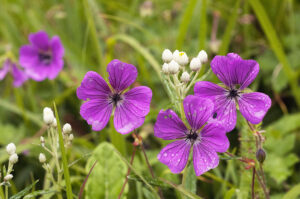
The family name commemorates Swiss physician, naturalist, and philologist Conrad Gessner (1516-1565).
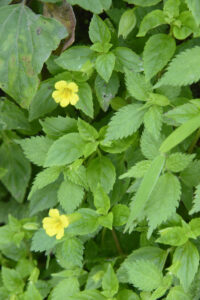
The generic name is derived from Ancient Greek aischyne (‘shame’) and anthos (‘flower’), possibly alluding to the usually red corolla.
Flowers are borne in dense clusters at the end of branches, corolla tubular, curved, to 3 cm long, crimson with short, black, longitudinal streaks towards the tip. Style and stamens are protruding from the flower, style white with a reddish-purple stigma, filaments and anthers usually reddish-purple, filaments sometimes white. Flowering takes place May-June. The capsule is linear, to 50 cm long, containing seeds with very long hairs.
It has a rather limited distribution, from eastern Nepal eastwards to Bhutan, growing in forests and shrubberies, and on rocks, at altitudes between 1,200 and 2,100 m.
The specific name is Latin, meaning ‘small-flowered’.
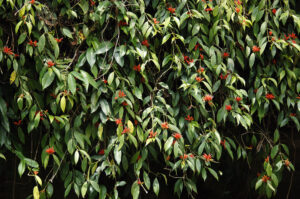
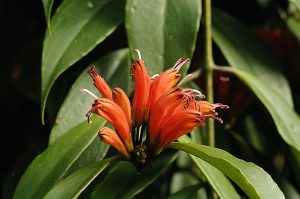
The generic name is derived from Ancient Greek korallion (‘coral’) and diskos (‘disc’), alluding to the coral-red nectary in several of the species.
It is distributed from Sikkim and Bhutan northwards through southern Tibet, Yunnan, and Sichuan to southern Qinghai, growing on rocks at elevations between 2,800 and 4,800 m.
The specific name was given in honour of Scottish botanist George King (1840-1909), superintendent of the Royal Botanic Garden in Calcutta from 1871. He also became the first director of the Botanical Survey of India, from 1890.
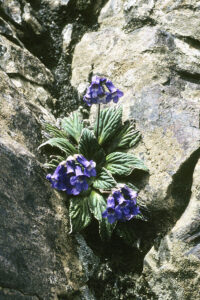
A lax cluster of flowers rise directly from the rootstock, amidst a very dense rosette of wrinkled, elliptic, rhombic, ovate, or oblong leaves, hairy or hairless above, white- or brownish-woolly below, to 5 cm long and 3 cm wide, veins prominent, margin entire or toothed, tip pointed or rounded.
Inflorescences have few or many flowers, flower-stalks to 17 cm long, rusty-hairy when young, later smooth. The corolla is tubular, to 1.5 cm long and 5.5 mm wide, blue, purple, white, or yellow, or a combination, lower lip, to 5 mm long, often with brownish spots inside. Blooming occurs July-October.
This plant is common in Nepal, where its juice is used for treatment of measles.
The specific name is Latin, meaning ‘woolly’, alluding to the underside of the leaves.
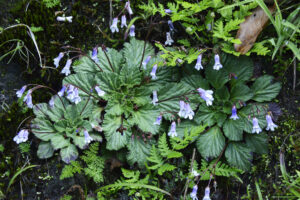
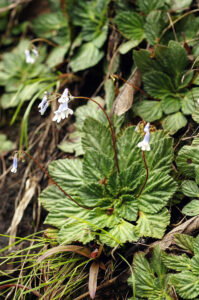
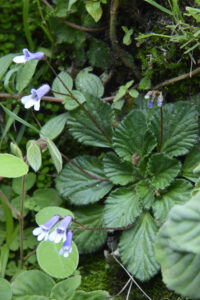
The generic name is derived from Ancient Greek didymos (‘twin’) and karpos (‘fruit’), referring to the two valves of the capsule.
Some members of the genus are known for their medicinal properties, especially the ability to cure kidney problems.
Inflorescences are terminal clusters of 2-5 stalked flowers, with short glandular hairs, calyx dark purple, with 5 pointed, triangular lobes, to 3 mm long, margin entire. Corolla tubular, dark chocolate-coloured, purplish-red, or pink, to 1.6 cm long, lower lip to 5.5 mm long, upper lip to 2.2 mm. Flowering takes place in August.
This plant grows on grassy slopes and rocks at elevations between 1,600 and 3,000 m, from Uttarakhand eastwards to Myanmar and south-eastern Tibet.
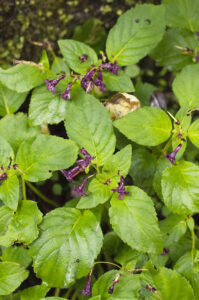
The inflorescences are also distinctive, consisting of terminal or axillary, branched clusters of few to several flowers, corolla pinkish-purple, tube cylindric, to 1 cm long, with 4-5 spreading, rounded lobes, 3 larger lower ones, upper 1-2 smaller, and by the bell-shaped, hairless, pinkish-white calyx, to 5 mm long, with rounded lobes. Flower-stalks grow to 15 cm tall. Blooming occurs June-July.
This plant grows on shady rocks in forests at altitudes between 1,000 and 3,000 m, from Himachal Pradesh eastwards to Arunachal Pradesh.
The specific name is Latin, meaning ‘inverted longish’, alluding to the leaves, which are often broadest above the middle.
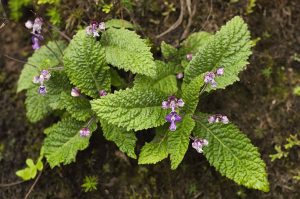
The broadly ovate, toothed, wrinkled leaves, to 8 cm long and 6.5 cm wide, are crowded at the tip of the sparsely hairy stem. They are sparsely covered above in yellow glandular hairs, and often also below.
It is found at elevations between 1,900 and 3,200 m, from Uttarakhand eastwards to Sikkim and south-eastern Tibet. It usually grows on rocks in forests, but is sometimes epiphytic.
The specific name is Latin, meaning ‘with leaves like Primula’ (primroses). Some species in this genus have strongly wrinkled leaves.
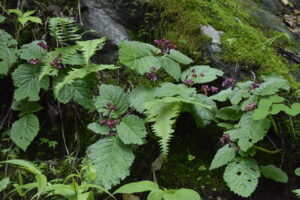
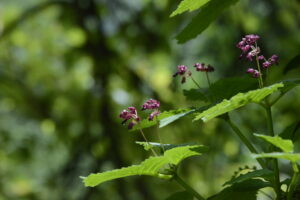
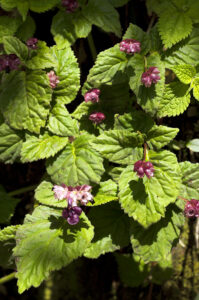
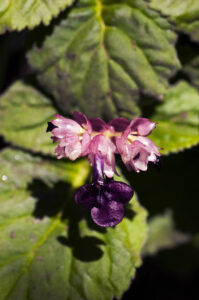
The generic name was applied in honour of a German administrator, Count Leo Henckel von Donnersmark (1785-1861), who was a keen botanist.
Flowers may be single or up to 7 together, stalked, calyx tubular, to 1.8 cm long, with 5 recurved, pointed lobes, densely covered in yellow or white hairs, corolla drooping, funnel-shaped, to 4.5 cm long, white or purple with yellow streaks in the throat, densely hairy on the outside, with 5 spreading lobes, lower 3 to 1.5 cm long, upper 2 to 1 cm. Flowering occurs July-September. The capsule is large, to 12 cm long.
It is distributed from Himachal Pradesh eastwards to northern Indochina and south-western China, growing on rocks and shady banks, and along streams, at elevations between 800 and 2,800 m.
The specific name is derived from the Latin pumilio (‘dwarf’).
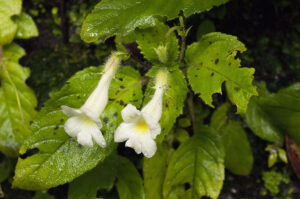
The stem is erect, unbranched, to 80 cm tall, but usually much lower, sparsely downy-hairy. The leaves are widely spaced, stalked, elliptic, rarely ovate or obovate, to 15 cm long and 8 cm broad, margin toothed, tip pointed, veins 5-10 pairs, conspicuous.
Flowers are single or in pairs, stalked, calyx to 3.5 cm long, with 5 lanceolate lobes, to 2 cm long, bristly-hairy, corolla funnel-shaped, to 6 cm long, pink or reddish-purple, with yellow markings in the throat, with 5 lobes, upper one very broad and to 1.5 cm long, lower 2 to 2.2 cm. Flowering takes place July-September. The capsule is large, to 15 cm long.
In Nepal, the plant is cut for fodder.
The specific name is Latin, meaning ‘with leaves like Urtica’ (nettles).
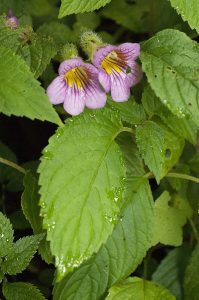
It is easily identified by the solitary, broadly ovate, toothed leaf, to 8 cm across, which encircles the long and slender flower-stalk, to 15 cm tall, with a single or few terminal, funnel-shaped, bluish-violet or purplish-red flowers, green-and-white spotted in the throat, with golden-yellow anthers and a white, curved, protruding style. The corolla is distinctly 2-lipped, the lower lip spreading, with 3 ovate lobes, to 5.5 mm long and 3.5 mm wide, the upper lip with 2 smaller ovate lobes, to 2.5 mm long and 3 mm wide. It blooms July-September.
The generic name is derived from Ancient Greek platys (‘flat’) and stemma (‘crown’, ‘corona’, or ‘flower garland’), alluding to the corolla, whose 3 lower lobes are spreading and flat. The specific name is Latin, meaning ‘violet-like’, alluding to the flowers, which somewhat resemble violets (Viola).
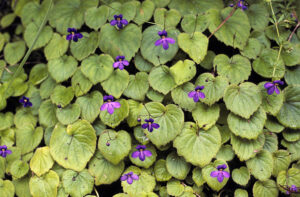
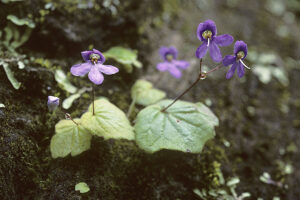
One characteristic of the genus is the asymmetric, long-pointed leaves.
The generic name is derived from Ancient Greek rhynchos (‘beak’) and glossa (‘tongue’), the latter part alluding to the broad, tongue-like lower lip of the corolla, the former perhaps to the narrow corolla tube, or to the pointed petal tips.
The small flowers are arranged in axillary, spike-like, many-flowered clusters, sometimes to 25 cm long, but usually shorter. Calyx bluish-green, to 8 mm long, with 5 lobes to 3 mm long, corolla cylindric, constricted at the mouth, pale blue, dark blue, or purple, to 1.1 cm long, 2-lipped, upper lip with 2 erect lobes to 2.5 mm long, lower lip entire or with 3 spreading lobes, to 5 mm long, 2 outer ones curved.
This plant differs from most other species in the family by flowering late in the autumn, from July to November. It is very widely distributed, found from Uttarakhand, southern Tibet, and Bangladesh eastwards to southern China and Taiwan, southwards to montane areas of southern India, Sri Lanka, Indochina, the Philippines, Indonesia, and New Guinea. In the Himalaya, it grows at altitudes between 600 and 2,800 m. Habitats include forests, shaded rocks, and humid banks.
The specific name is Latin, meaning ‘slanting’ or ‘awry’, referring to the asymmetric leaves.
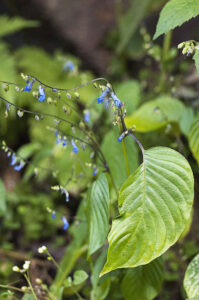
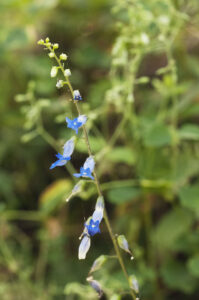
The fruit is highly distinctive, mostly globular, soft, juicy, sometimes brightly coloured or hairy.
The family name stems from an older Latin name of currant, grossulus, which, with the suffix aria, meant ‘resembling a small, unripe fig’. The generic name Ribes is a newer name of currant, derived from Arabic ribas, which could also mean ‘rhubarb’.
Some authorities include the genus in the family Saxifragaceae.
The branches may be smooth or with gland-tipped hairs. The long-stalked leaves are rounded in outline, 3-5-lobed, to 3 cm long and 4 cm broad, downy, especially along veins, base heart-shaped, margin with blunt or sharp teeth. Flowers are axillary, solitary or 2-3 together, to 1 cm long, calyx bell-shaped, greenish or reddish-brown, downy and glandular-hairy, or sometimes hairless, lobes to 7 mm long, petals white, greenish, or pinkish, elliptic or oblong, to 3.5 mm long. Flowering occurs April-June, and the fruits ripen June-September.
It grows in forests and shrubberies in drier areas, distributed from Afghanistan eastwards to Bhutan, and also in Central Asia and western China. In the Himalaya, it is found at elevations between 1,000 and 3,900 m.
The fruit is edible, and also used for jam, sauces, and wine.
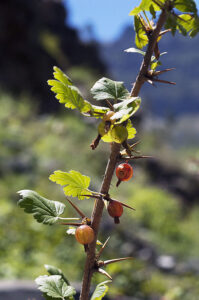
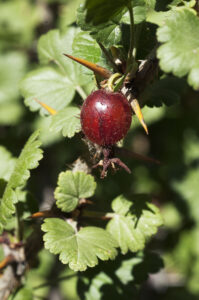
Inflorescences are ascending or upright racemes, to 5 cm long, male and female flowers in separate clusters, sometimes on separate plants, male racemes to 5 cm long, with 7-30 flowers, female racemes to 3 cm long, 4-10-flowered. Bracts ovate or lanceolate, to 5 mm long, margin glandular-hairy. Calyx tubular, brownish, sometimes green, smooth, tube to 2 mm long, lobes ovate, erect, to 2.5 mm long. Petals minute, reddish-brown, blackish-purple, or greenish, much shorter than the calyx-lobes. Blooming takes place April-August. Berries are red or scarlet, globular, smooth, to 7 mm across, ripening July-October.
This plant is distributed from Afghanistan eastwards to Myanmar and western China, growing in forests and shrubberies, and on open slopes and rocks, at elevations between 1,900 and 4,400 m.
The berries are edible, but sour-tasting.
The specific name is derived from the Latin glacies (‘ice’), thus ‘living in ice’. Presumably, the type specimen was collected at a high altitude.
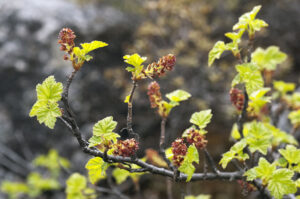
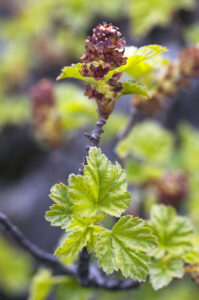
An erect shrub, 2-3 m tall, not spiny. Young branches stout, smooth. Leaves long-stalked, stalk often red, leaves heart-shaped, to 7 cm long and 10 cm wide, with usually 5 triangular, long-pointed lobes, margin deeply and irregularly toothed, terminal lobe longer than lateral ones.
Inflorescences are lax, pendulous clusters, to 15 cm long, 10-20-flowered, bracts lanceolate or ovate, to 7 mm long, downy. Flowers bisexual, to 7 mm long and 6 mm across, yellowish-green or purplish-red, or a combination, calyx lobes reflexed, to 3 mm long. Petals tiny. Flowering occurs April-June. Fruit red, ovoid or globular, to 1.2 cm across, smooth, ripening July-September.
The specific name honours British physician and botanist William Griffith (1810-1845), who spent most of his adult life in India and Myanmar. After a brief stay in Madras, he was assigned as a surgeon to Tenasserim, Myanmar. During the following years, he explored various parts of Myanmar, Sikkim, and the region around Shimla, north-western Himalaya. Subsequently, he was appointed as surgeon in Malacca, where he died of a parasitic liver disease, only 35 years old.
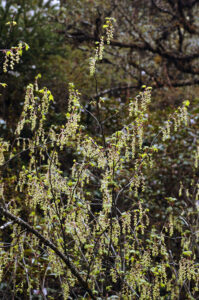
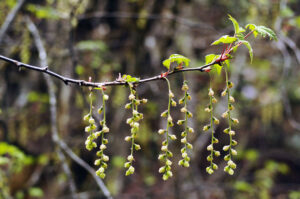
Male and female flowers are on separate plants, racemes erect, to 5 cm long, male ones 9–20-flowered, female ones with few flowers, entire inflorescence reddish-brown, sometimes with a green stalk. Bracts lanceolate or narrowly elliptic, to 6 mm long, margin with short hairs. Calyx tube to 2 mm long, with erect lobes, to 3.2 mm long. Petals tiny, to 0.6 mm long. Flowering takes place June-July. The fruit is red to dark purple, globular, to 7 mm across, ripening August-October.
This plant is found at altitudes between 2,700 and 4,300 m, growing in forests and shrubberies, and along streams, distributed from Nepal eastwards to Myanmar and the Yunnan Province.
The specific name is Latin, meaning ‘cut into deep, irregular, pointed lobes’, referring to the leaves.
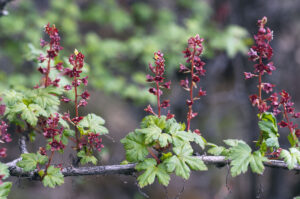

A much-branched shrub, to 2 m tall, not spiny, with glandular-hairy, sticky twigs. Leaf-stalk to 3 cm long, blade rounded or kidney-shaped, obscurely 3-5-lobed, to 3 cm long and 5.5 cm broad, with stiff glandular hairs, margin with blunt teeth.
Male and female flowers in separate racemes (rarely bisexual), erect or ascending, male ones to 5 cm long, 15-30-flowered, female ones to 3 cm long, 5-15-flowered. Calyx-tube very small, to 2 mm long, purple or purplish-brown, hairy. Petals greenish, yellowish, or reddish-purple, spatulate, to 3 mm long. The plant flowers between April and June. Fruit at first orange, later deep red, globular, to 9 mm across, glandular-hairy, ripening July-September.
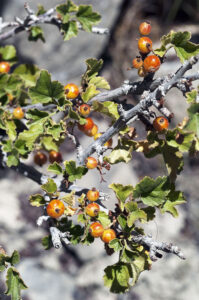
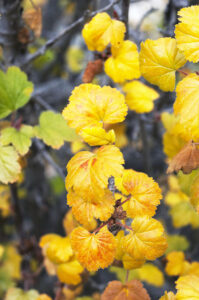
Male and female flowers in separate erect or ascending racemes, male ones to 10 cm long, female ones shorter, rachis and stalks densely glandular-hairy. Rachis from previous year often remaining on branches. Bracts lanceolate, to 7 mm long, margin glandular-hairy. Flowers purplish-red or reddish-brown, calyx tube to 2.5 mm long, lobes erect, spreading in fruit, to 3 mm long, petals smaller than calyx lobes. Flowering occurs April-May.
Initially, the fruit is yellowish-green, later turning reddish-brown, ovoid or globular, to 7 mm across, smooth or downy. The ripening period is July-August.
It is distributed from Uttarakhand eastwards to Myanmar and western China, growing on open slopes and among rocks, sometimes epiphytic. It may be found at elevations between 2,200 and 4,000 m.
The berries are edible.
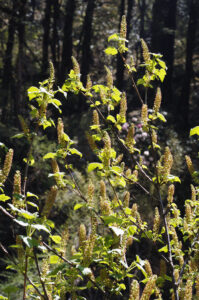
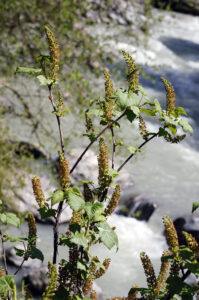
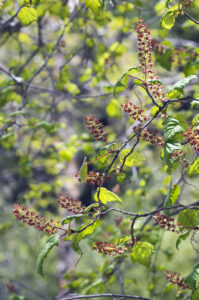

These plants are found in south-eastern Europe, Asia, and the Americas, and on some Pacific islands. 4 genera occur in the Himalaya.
The family name is derived from Ancient Greek hydria, from hydor (‘water’), in Ancient Greece a container used for collecting, carrying, and pouring water. The name refers to the cup-shaped capsule of members of the genus Hydrangea.
The generic name was applied by Swedish naturalist and physician Carl Peter Thunberg (1743-1828) in honour of Dutch jurist and banker Johann van der Deutz (1743-1784), a keen botanist, who financed the travels of Thunberg to South Africa, Java, and Japan.
A small shrub to 2 m tall, leaves broadly lanceolate, to 4 cm long, green on both surfaces, with scattered star-shaped hairs. The pinkish-purple flowers are in axillary clusters, often appearing on bare branches before the leaves, or with the young leaves, fragrant, petals 5, elliptic, to 1.2 cm long. Flowering occurs between April and June.
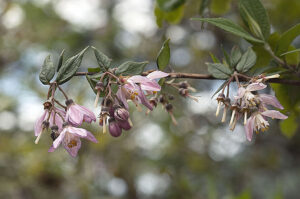
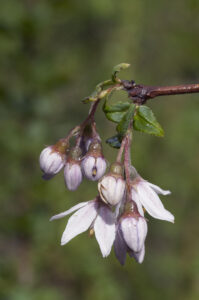
It grows in shrubberies and along forest edges, found at elevations between 2,000 and 3,500 m, from central Nepal eastwards to Myanmar and the Yunnan Province.
The specific name honours British botanist Joseph Dalton Hooker (1817-1911), who described numerous new plant species in the eastern Himalaya (see Rhododendron dalhousiae, Himalayan flora 1).
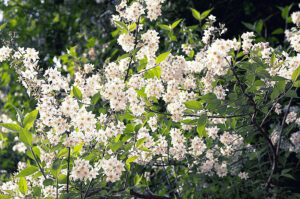
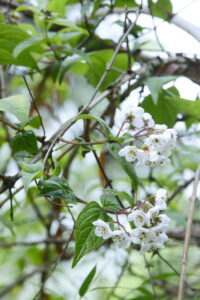
Inflorescences are axillary, to 4 cm across, 9-25-flowered, on short twigs to 5 cm long, twigs 2-8-leaved. Flowers white, to 1.2 cm across, fragrant. Calyx-tube short, covered in greyish-yellow, star-shaped hairs, lobes pointed. Petals oblong or elliptic, to 1.2 cm long and 4 mm broad. Calyx lobes persistent on the rounded capsule, to 4 mm across. The flowering period is between March and June.
It is widely distributed, found from Pakistan eastwards to Bhutan and south-western China, growing in shrubberies and on open slopes at altitudes between 1,100 and 3,200 m. It is commonest in the western part of the Himalaya.
In Nepal, juice of the root is used for fever, and the foliage is cut for fodder. The flowers are offered to gods by Tamang people.
The specific name is Latin, meaning ‘with many stamens’.
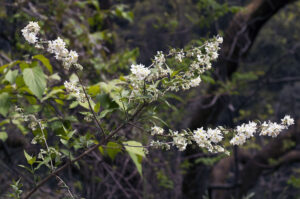
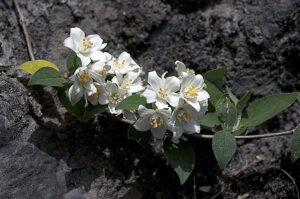
The generic name, derived from Ancient Greek dis (‘twice’) and chroa (‘colour’), probably refers to the flowers, which are white in bud, but blue when unfolded.
The inflorescence is a terminal, many-flowered, branched cluster, to 20 cm long and 25 cm across. Calyx tube bell-shaped, with 4-6 broad, triangular lobes. Flower buds white, obovoid, to 1 cm long, petals pale blue or violet when unfolded, oblong-elliptic, slightly fleshy, to 4 mm long, reflexed at maturity. The flowering period is long, from February to July. Berries globular, sky-blue to dark blue when ripe, to 7 mm across, topped by the persistent calyx. They are present most of the year.
It is widely distributed, from central Nepal eastwards to southern China and Taiwan, and thence southwards through Indochina to mountains of Malaysia, Indonesia, the Philippines, and New Guinea, growing in forests and shrubberies. In the Himalaya, it occurs at elevations between 900 and 2,500 m. It is very common in Nepal.
The specific name is derived from the Latin febris (‘fever’) and fugare (‘to expel’), indicating that the plant is widely utilized to treat fevers, including malaria. In Nepal, root, bark, and young shoots are also used for indigestion, and juice of the leaves for cough, colds, and bronchitis. The wood is cut for fuel.
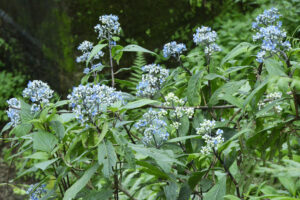
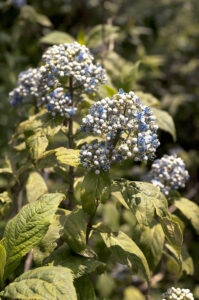
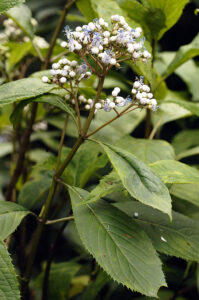
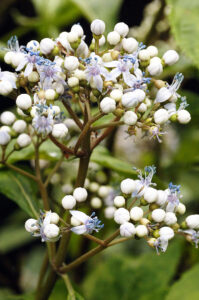
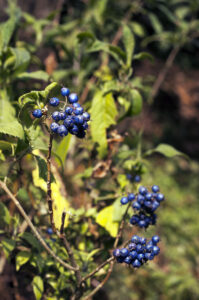
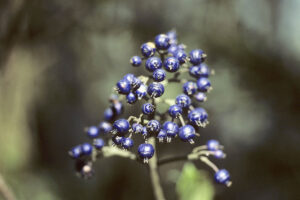
The generic name probably refers to an ancient Greek king, Ptolemaios II (c. 308-246 B.C.), called Ptolemaios Philadelphos (‘Ptolemaios, friend of his siblings’). He was the Pharaoh of Egypt 283-246 B.C.
The English name was given in allusion to the flowers, which somewhat resemble those of Citrus species, and also have a fragrance similar to orange flowers.
A deciduous shrub to 3 m tall, bark blackish-green on young branches, grey-brown on older branches, hairless or sparsely hairy. Leaves short-stalked, opposite, ovate or lanceolate, to 10 cm long and 5 cm broad, long-pointed, hairless above, densely yellowish-hairy beneath, with 5-7 prominent veins beneath, base rounded or wedge-shaped, margin irregularly toothed.
Inflorescences are axillary clusters at the end of branches, 3-7-flowered. Flowers white, to 2.5 cm across. Calyx tube with ovate pointed lobes to 5 mm long and 3.5 mm broad, petals usually 4, ovate or oblong, to 1 cm long and 8 mm wide. Flowering occurs May-July.
The specific name is Latin, meaning ‘having a mass of rough hairs’, alluding to the underside of the leaves.
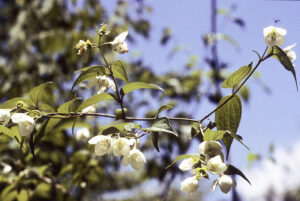
The major part of the species have yellow flowers. Leaves and flowers are often dotted with glands, though only in a few of the Himalayan species.
The generic name is derived from Ancient Greek hyper (‘above’) and eikon (‘picture’), alluding to an old belief, that if these plants were hung above pictures, they would ward off evil spirits.
The popular name refers to Saint John the Baptist. In the Middle Ages, the blood-red juice of some species was seen as a symbol of the blood from the Saint’s beheading. John the Baptist had reproached King Herod for marrying his brother’s wife Herodias, hereby incurring Herodias’ wrath. Cunningly, her daughter persuaded the king to promise her anything she wanted, and, on request from her mother, she asked for John the Baptist’s head on a tray. (Mark, 6:18-28)
A shrub to 2 m tall, stems red, erect or spreading, 4-lined. Leaves alternate, crowded up the stem, very short-stalked, ovate or lanceolate, pointed, to 9 cm long and 4 cm broad, pale beneath.
Inflorescences are 1-7-flowered terminal clusters, flowers short-stalked, to 7 cm across. Sepals variable, lanceolate to broadly ovate or elliptic, pointed, to 8 mm long and 1 cm wide, petals deep golden yellow, sometimes tinged red, obovate to rounded, to 3 cm long and 2.2 cm wide, more than twice as long as the 60-80 stamens. The flowering period is from April to September.
In Nepal, it is cut for fodder, and juice of the root is taken for fever.
The specific name commemorates Swiss clergyman and botanist Jacques Denys Choisy (1799-1859), who was an important contributor to Prodromus Systematis Naturalis Regni Vegetabilis, a major work by Swiss botanist Augustin Pyramus de Candolle (1778-1841). Choisy wrote the sections concerning the families Marcgraviaceae, Convolvulaceae, Hydroleaceae, Selaginaceae, Nyctaginaceae, Hypericineae (today Hypericaceae), and Guttiferae (today Clusiaceae).
H. hookerianum is very similar, but has rounded branches and blunt sepals. It is distributed from central Nepal eastwards to northern Indochina, at elevations between 1,500 and 3,400 m. It also occurs in montane areas of South India.
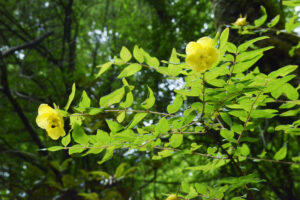
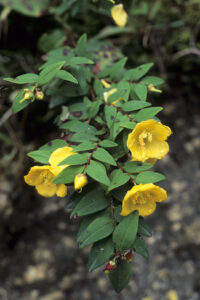
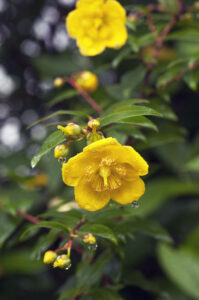
It is endemic to central Nepal, growing on open slopes and banks, and in shrubberies, at elevations between 900 and 1,900 m. It is common in Helambu.
Juice of the plant is used for menstrual problems, juice of the root for diarrhoea and dysentery. Juice of the bark is applied to dislocated bones. The flowers are often brought as offerings at Hindu and Buddhist shrines.
The specific name is Latin, meaning ‘with heart-shaped leaves’.
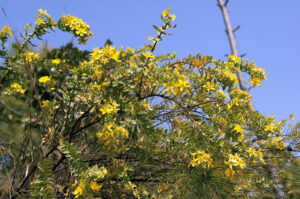
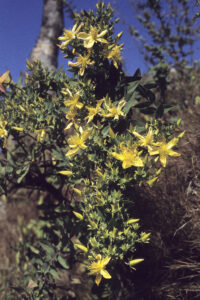
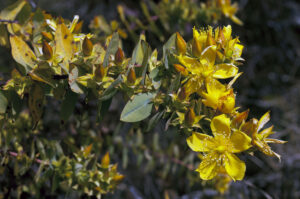
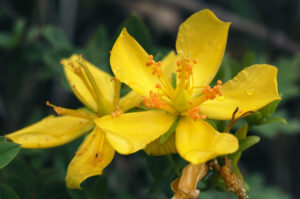
Inflorescences are branched clusters with 5-50 golden-yellow flowers, each to 2 cm across, petals oblanceolate, to 1.5 cm long and 4 mm broad, dotted and streaked with black glands. Stamens numerous, up to 60, to 1.1 cm long. Flowering takes place June-September.
It is distributed from Kashmir eastwards to Myanmar and southern China, growing in shrubberies and grasslands, and along forest and field margins, found at elevations between 1,200 and 3,500 m.
In Nepal, the plant is cut for fodder, and a paste of the root is used for fever.
The specific name might mean ‘resembling Elodea’, but as members of the genus Elodea are water plants with grass-like leaves, the connection is hard to see.
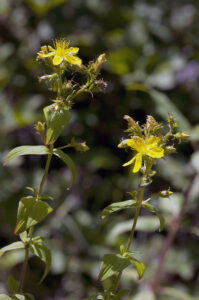
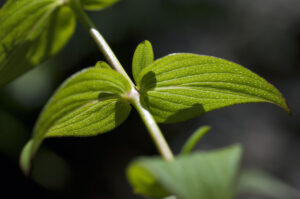
Inflorescences are few- to many-flowered, terminal clusters. The small flowers are pale to bright yellow, or orange, to 8 mm across, petals obovate, oblong, or elliptic, to 5 mm long and 3 mm wide, alternating with sepals about the same size. It has a very long flowering period, from February to October.
It is distributed from Himachal Pradesh eastwards to Korea and Japan, and thence southwards through Indochina to Indonesia, the Philippines, New Guinea, Australia, and New Zealand. It also occurs in southern India and Sri Lanka. It is quite common in the Himalaya, found in marshes, grasslands, fallow fields, and waste places, at altitudes between 1,500 and 3,000 m.
In Nepal, juice of the plant is used for asthma and dysentery, juice of the root for headache and fever.
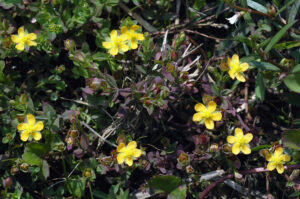
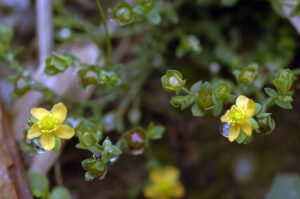
A much-branched shrub to 2 m tall, often pendent from banks. Initially, branches are 4-lined, later smooth. Leaves are stalkless, oblong or lanceolate, to 9 cm long and 3.2 cm broad, tip blunt, rarely pointed.
Inflorescences are terminal clusters with 2-6 large, bright yellow flowers, to 7.5 cm across. Sepals variable, ovate or elliptic, blunt or pointed, to 8 mm long, petals narrowly obovate, to 3 cm long, not much longer than the c. 30 stamens. It flowers in spring, between February and April.
In Nepal, juice of the leaves is used against snakebite, and the foliage is cut for fodder. The flowers are often brought as offerings at Hindu shrines.
The specific name is Latin, meaning ‘with leaves broadest above the middle’.
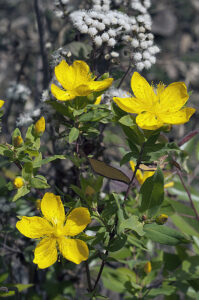
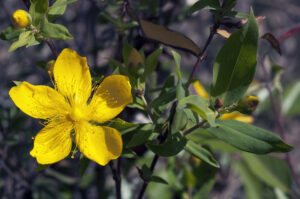
The generic name was applied in 1759 by Swedish naturalist Carl Linnaeus (1707-1778), taken from a name established in 1611 by French physician and botanist Paul Reneaulme (c. 1560-1624) for a superficially similar species of the genus Gagea, derived from Ancient Greek hypo (‘less’) and oxys (‘sharp’), thus ‘a little sharp’, alluding to the taste of the leaves of that plant.
The common names refer to the star-shaped flowers, star-grass also to the grass-like leaves.
One species, H. hemerocallidea, often called African potato, is an important ingredient in traditional African medicine.
It occurs in the entire Himalaya, growing in open areas, grasslands, grazing grounds, and fallow fields, at elevations between 1,500 and 2,900 m. It has a very wide distribution, from Pakistan eastwards to Korea and Japan, and thence southwards to the Philippines, Indonesia, and New Guinea.
The specific name is Latin, meaning ‘golden’, referring to the flower colour.
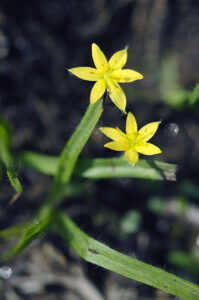
The flower structure of these plants is unique. The flowers are borne in axils of 2-3 bracts, the spathes. Petals 6, often strongly coloured, separated into 3 outer, spreading or curved falls, and 3 inner, usually erect standards, which are fused to form the corolla-tube. In the centre, falls may have a ridge, the crest, or a tuft of hairs, the beard. The fruit is a large capsule, splitting length-wise.
These plants are poisonous, and therefore avoided by grazing animals, often forming large growths in high-altitude meadows and grazing grounds.
The genus is named for Iris, the Greek goddess of the rainbow, undoubtedly because of the colourful flowers of many species.
Spathes 3, green, broadly lanceolate, to 10 cm long, with 1-2 bluish-violet flowers, to 8.5 cm across, stalk slender, to 3.5 cm long. Corolla-tube to 1.2 cm long, standards oblong or lanceolate, to 4.5 cm long and 1 cm wide, pale violet with dark violet streaks. Falls to 7 cm long and 2.8 cm wide, with a large rectangular white patch, mottled with black, throat yellowish. Flowers appear June-July. The capsule is oblong or ellipsoid, to 5 cm long and 2.5 cm broad, ripening August-September.
This plant is distributed from central Nepal eastwards to Myanmar and the Yunnan Province, growing in humid meadows and along streams at elevations between 2,300 and 4,300 m.
In Nepal, a paste of the root is applied to wounds.
The specific name honours British botanist Charles Baron Clarke (1832-1906), who was Inspector of Schools in Eastern Bengal and later of India, and superintendent of Calcutta Botanical Garden 1869-1871. He described many Himalayan plants new to science. After retiring from the Indian Civil Service in 1887, he worked at Kew Royal Botanic Gardens in London until his death in 1906.
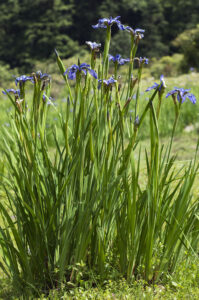
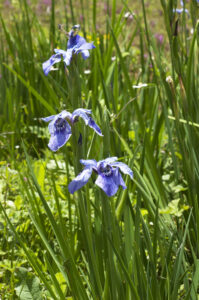
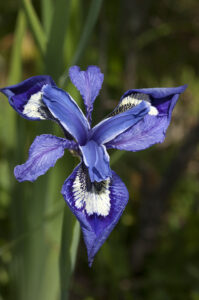
A densely tufted plant, stem sometimes branched, to 30 cm long, leaves linear, with 2-3 veins, to 45 cm long and 8 mm broad.
Spathes 3, lanceolate, pointed, to 9.5 cm long, with 2 pale blue to violet flowers, to 6 cm across. Corolla-tube to 3 cm long, standards narrowly elliptic, to 4 cm long and 1.2 cm broad. Falls obovate, to 4 cm long and 2 cm broad, white-streaked near the throat, with an orange or brownish-yellow, narrow crest. Flowering takes place May-July. The capsule is cylindric or ellipsoid, to 3.5 cm long and 1 cm broad, with a short beak, ripening July-August.
In Nepal, the root is used for skin problems.
The specific name is derived from the Latin decus, genitive decoris (‘having grace, splendor, ornament’).
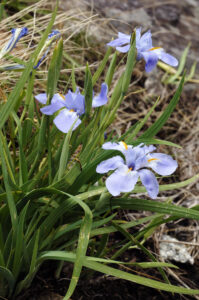
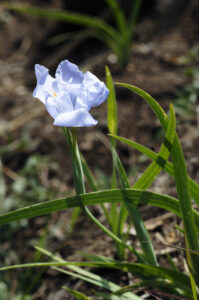

It is restricted to drier areas, growing on open slopes and in grasslands at elevations between 3,000 and 4,400 m, from western Nepal eastwards to Myanmar and western China. It is prominent in the Upper Langtang Valley, central Nepal.
The specific name is derived from Ancient Greek gonia (‘angle’) and carpos (‘fruit’), referring to the 3-angled fruit.
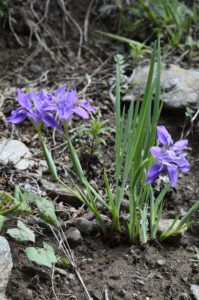
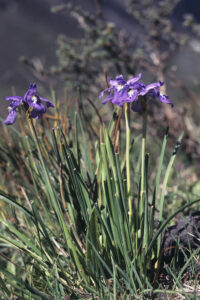
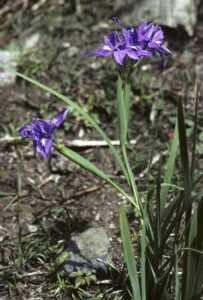
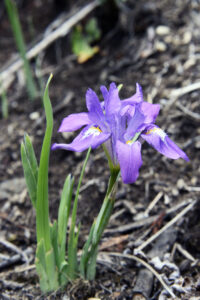
It is distributed from Pakistan eastwards to Arunachal Pradesh and south-eastern Tibet, found in grasslands and pastures, and on open slopes, at elevations between 2,500 and 4,300 m.
It is very common in Nepal, where leaves and root are used medicinally. The leaves are also cut for fodder. Presumably, its toxicity disappears when it is dried.
The specific name was applied by Danish physician and botanist Nathaniel Wallich (1786-1854), who studied the Indian and Himalayan flora in the early 1800s (see Geranium wallichianum above). In those days, the district of Kumaon, in present-day Uttarakhand, was a kingdom, known as Kemaon or Kamaon. Presumably, the type specimen was collected in this area.
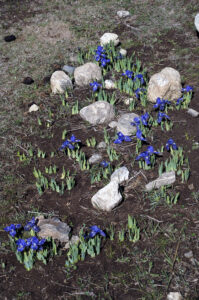
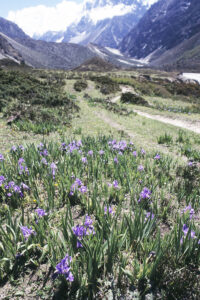
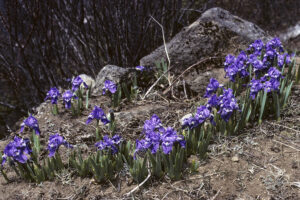
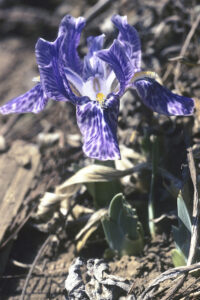
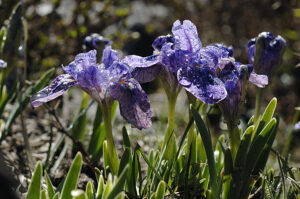
Stems 3, to 1 m tall, branched, one terminal stem with flowers and shorter leaves, the 2 lateral ones only with leaves, but bearing flowers the following year. Leaves many, pale green, slightly scimitar-shaped, to 60 cm long and 8 cm broad.
Spathes blunt, to 2.5 cm long, with numerous large flowers, to 10 cm across. Standards obovate, purplish-blue, streaked dark purple towards the base, falls obovate, to 8 cm long, reddish-purple, streaked white and dark purple towards the throat, with a whitish or yellow, narrow crest. Flowering occurs May-July. The capsule is ovoid-cylindric, to 3.3 cm long. It ripens July-August.
The specific name was given in honour of an Englishman, Frank Miles, who introduced this species into cultivation around 1880, grown from seeds collected by his cousin in the Kullu District, Himachal Pradesh. (Source: W. Dykes 2009. Handbook of Garden Irises)
According to eFlora of China, plants from the Sichuan and Yunnan Provinces in China, which have been ascribed to this species, are probably an undescribed species, as a disjunct distribution like that is unlikely.
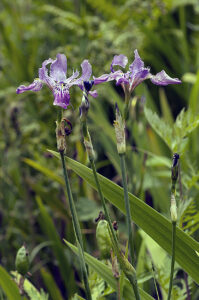
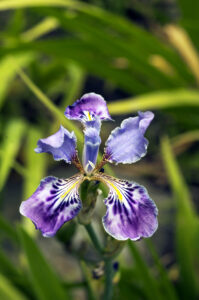
Inflorescences are in pendent spikes, and the fruit is a winged nutlet.
The generic name commemorates Nicolaus Engelhard (1761-1831), Dutch businessman and colonial governor of Java.
Inflorescences greenish, male spikes solitary or up to 5 together on leafless branches, hairy, to 8 cm long. Female spikes long, pendent. Flowering occurs between February and May. Fruits are in dense clusters, nutlet globular or ovoid, to 6 mm across, with a 3-lobed wing, middle wing to 3.5 cm long, lateral ones to 2 cm. Ripening takes place April-November.
It grows in forests, distributed from Pakistan eastwards to southern China, and thence southwards through Indochina to Indonesia and the Philippines, in the Himalaya found at elevations between 400 and 2,100 m.
In Nepal, the bark is used as fibers, and for tanning. The leaves are strewn in streams to stupefy fish, and they are also utilized as manure.
The specific name alludes to the inflorescences.
Previously, a variety of this species, var. colebrookiana, was regarded as a separate species, E. colebrookiana, named in honour of British orientalist and mathematician Henry Thomas Colebrooke (1765-1837), who has been described as “the first great Sanskrit scholar in Europe”.
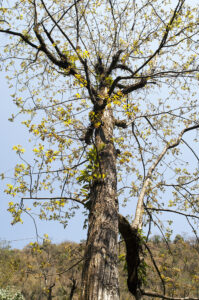
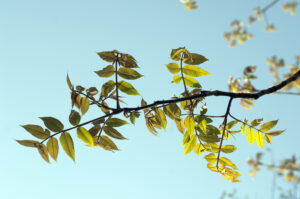
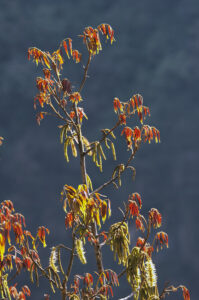
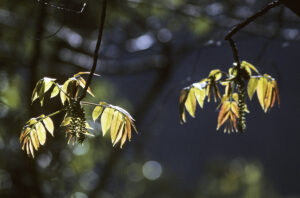
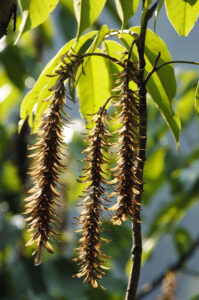
Male flowers are in pendent catkins, females in short spikes. The fruit is a drupe, with a hard inner shell, containing the nut.
The generic name is the classical Latin name of the walnut tree, derived from Iovis (the god Jupiter) and glans (‘acorn’), thus ‘Jupiter’s acorn’.
Inflorescences greenish, male catkins to 12 cm long, female spikes short, 1-3-flowered. Flowering occurs between February and May. The drupe is ovoid, to 6 cm long, husk green, glandular, nut-shell thick, strongly wrinkled, with 2 valves. It ripens from May to October.
In the wild, this tree is distributed from south-eastern Europe eastwards across the Middle East to the Himalaya and China. In the Himalaya, it grows at elevations between 1,500 and 3,300 m. Habitats include forests, shrubberies, and open slopes.
Elsewhere, it is widely cultivated for the edible nuts. Oil is also extracted from the nuts, used for cooking or illumination. The wood is utilized for construction, furniture, and utensils. In the Himalaya, the foliage is stored as winter fodder. In Nepal, juice of the bark is taken against intestinal worms, and the oil cake is applied to the forehead to treat headache. The leaves are astringent and tonic. The nuts are eaten to treat asthma. Bark and unripe fruits are used for tanning and dyeing, and also strewn in rivers to stupefy fish.
The specific name is Latin, meaning ‘royal’, naturally alluding to the splendour of this tree.
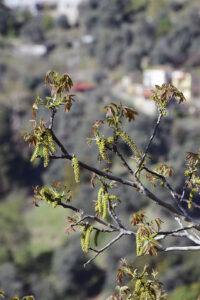
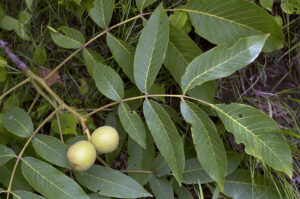
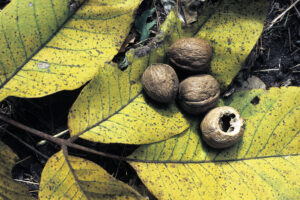
Flowers are in dense terminal heads, or in a branched cluster, and the leaves are grass-like.
The generic name is derived from iuncus, the classical Latin name of rushes.
Historically, these plants received little attention from botanists. In 1819, British botanist James Ebenezer Bicheno (1785-1851), who was colonial secretary of Tasmania from 1842 until his death in 1851, described the genus as “obscure and uninviting”. (Source: J.E. Bicheno 1819. Observations on the Linnean genus Juncus, with the characters of those species, which have been found growing wild in Great Britain. Transactions of the Linnean Society of London 12 (2): 291-337)

This species grows in humid grasslands and shrubberies at elevations between 3,000 and 4,200 m, from Uttarakhand eastwards across the Himalaya and Tibet to northern Myanmar and western China.
The specific name is derived from Ancient Greek leukos (‘white’) and anthos (‘flower’), alluding to the flowers often being white.
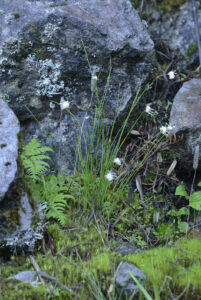
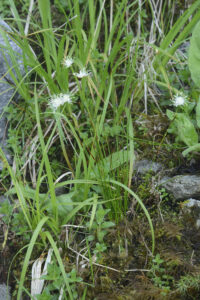
Members of this family are characterized by their flowers, which are bilaterally symmetrical, with the petals typically fused into an upper lip and a lower lip, hence the alternative family name Labiatae, from the Latin labia (lip).
The generic name in fact stems from a writing error. It should have been abiga, from abigo (‘to force birth’ or ‘to cause an abortion’), alluding to the yellow bugle (A. chamaepitys), which was used medicinally to induce an abortion. The common name was given in reference to the tubular flowers.
Flowers are solitary, with slightly swollen, strongly hairy, brown calyx, to 5 mm long, toothed. Corolla is blue, purple, or reddish-purple, tubular, straight, to 1.5 cm long, downy on the outside, upper lip erect, very short, lower lip 3-lobed, middle lobe largest and longest, with 2 short, wide, terminal lobes. Blooming occurs April-May.
It is distributed from central Nepal eastwards to Myanmar, south-eastern Tibet, and south-western China, growing in forests and shrubberies at elevations between 1,500 and 3,300 m.
The specific name presumably alludes to the lobes on the leaves, or perhaps on the flowers.
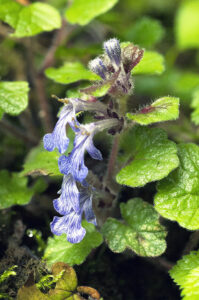
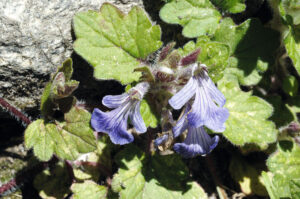
The generic name is derived from Ancient Greek kalos (‘beautiful’) and karpos (‘fruit’), like the common name alluding to the colourful berries of some species.
These plants were previously included in the family Verbenaceae.
Inflorescences are axillary, branched, many-flowered clusters, rounded in outline, calyx bell-shaped, to 1 mm long, with 4 tiny lobes, corolla cylindric, purple or violet, to 2.5 mm long, with 4 spreading lobes, stamens exserted. Flowering takes place June.October. The fruit is white, globular, succulent, to 3 mm across, ripening August-November.
It is found from Kashmir eastwards to China, southwards to Sri Lanka, Indochina, the Philippines, New Guinea, and north-eastern Australia. In the Himalaya, it grows in forests and shrubberies, from the lowland up to elevations around 2,000 m.
Fruits are edible and sweet. In Nepal, this species is used for a wide varity of ailments. Root and fruits are chewed to treat rashes and boils on the tongue. A paste of the root is taken for fever, juice of the root for indigestion. Inner bark is pounded and applied to cuts and wounds. A heated leaf is pressed on areas with rheumatism. A decoction of the leaves is taken for diarrhoea and dysentery, the juice for gastric trouble. Juice of ripe fruit is given for indigestion and fever. The wood is used as fuel, and the leaves are gathered for fodder.
The specific name is derived from Ancient Greek makros (‘long’) and phyllon (‘leaf’), thus ‘long-leaved’.
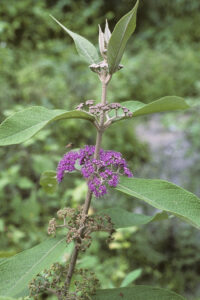
The generic name is explained in various ways. It is derived from Ancient Greek kleros, which is usually translated as ‘clergy’, alluding to the usage of these plants for religious purposes in Asia. However, it may also mean ‘chance’ or ‘fate’, referring to the considerable variation in reports of the usefulness of the genus in traditional medicine. The second part of the name is derived from Ancient Greek dendron (‘tree’).
A shrub, sometimes to 4 m tall, but mostly 1-2 m, stem erect, with large corky lenticels. Leaves are opposite, broadly elliptic or ovate, pointed, sparsely hairy on both surfaces, to 25 cm long and 20 cm wide, margin toothed.
Inflorescences are large terminal clusters, flowers white with purplish or pink throat, fragrant, corolla tube to 1.6 cm long, with broadly elliptic lobes to 1.5 cm long, stamens protruding, to 5 cm long. Flowering occurs March-April. The fruit is a berry-like drupe, globose, bluish-black or black when ripe, to 1 cm across, enclosed in the red enlarged calyx.
In traditional Ayurvedic medicine, root and bark are used for respiratory problems, fever, cough, and asthma. The root is also used as a laxative, and to kill fly larvae in wounds. A paste of root and leaves is used for skin diseases. Juice of the leaves is used for diarrhoea, liver disorders, wounds, fever, ulcers, and swellings, and also to expel intestinal worms, and rid livestock of lice. In India, it is used for snake bites and scorpion stings. In traditional Thai medicine, leaves and root are used as a diuretic, and to treat internal infections and kidney problems. In Nepal, the juice is dripped into the eyes of cattle to treat conjunctivitis.
In Nepal, the leaves are used as a potherb.
The specific name was applied by Swedish naturalist Carl Linnaeus (1707-1778), allegedly because he found its leaves rather ugly.
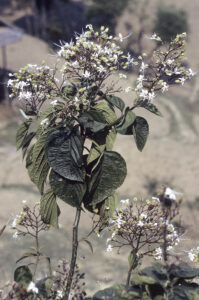
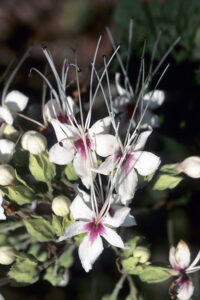
According to Kew Gardens, the genus has an almost cosmopolitan distribution, except for the polar regions and Australia. 3 species occur in the Himalaya.
The generic name is derived from Ancient Greek klinopodion, from kline (‘bed’) and podion (‘little foot’), thus ‘little foot of a bed’, maybe alluding to the square stem of wild basil (C. vulgare).
Stems spreading, soft-haired, woody at the base, slender, to 90 cm tall, leaves narrowly elliptic, to 3 cm long, margin with small teeth. Inflorescences are one-sided whorls, borne at the end of the leafy stems, corolla mostly violet, sometimes reddish-purple, tube slender, to 2 cm long, lower lip with broad lobes. Calyx dark purple, about 7 mm long, with long-pointed teeth. Flowering takes place between February and May.
The specific name is derived from the Latin piper (‘pepper’). The leaves are probably sharp-tasting.
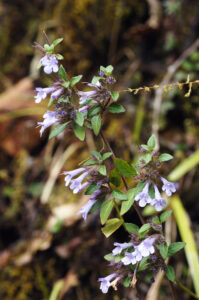
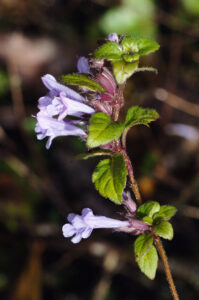
It is widely distributed in a variety of habitats, including forests, shrubberies, and farmland, from Turkey and the Caucasus eastwards across Iran, Afghanistan, and the Himalaya to northern Myanmar. In the Himalaya, it is found at altitudes between 1,000 and 3,400 m.
In Nepal, juice of the leaves is applied to wounds.
The specific name is derived from the Latin umbra (‘shadow’), thus ‘growing in shady places’.
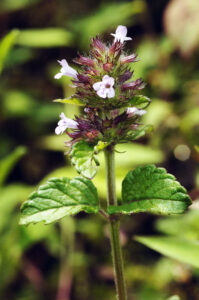
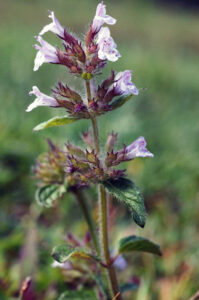
It has a vast distribution, found in the entire Europe, northern Africa, the Middle East, and in Siberia eastwards to Yakutia, and has also become naturalized in North America. In the Himalaya, it occurs from Pakistan eastwards to central Nepal, growing in shrubberies and on open slopes at elevations between 1,800 and 3,300 m. It is common in Kashmir.
In traditional medicine, this plant has been used as an astringent, a cardiac stimulant, an expectorant, to reduce flatulence, to increase perspiration, and to heal wounds. The leaves are used to make herbal tea, and in food dishes, and a brown and a yellow dye are obtained from them.
The specific name is Latin, meaning ‘common’.

It is a shrub to 5 m tall, much branched, densely silky-hairy on twigs, leaf-stalks, and inflorescences. Leaves large, to 20 cm long and 7 cm wide, long-pointed, almost entire with tiny rounded teeth, woolly-haired below. Inflorescences are dense, axillary and terminal panicles, to 15 cm long, corolla tiny, to 3 mm long, white. It flowers in winter, from December to April.
This plant is widely used in traditional medicine. In Nepal, juice of the root is given for epilepsy, bloody cough, and peptic ulcer. Boiled in water, the root is also drunk to expel intestinal worms. A paste of the root is applied for body pain and sprains. Juice of the bark is used for fever and indigestion. The hairy leaves are applied to wounds to stop bleeding. Juice of the leaves is applied to wounds as an antiseptic, taken for fever and headache, and also to expel worms. It is dripped into the eyes of cattle with conjunctivitis. A paste of the leaves is used for dysentery. Juice of the flower buds is used for gastric problems and sinusitis. Elsewhere, it is used for skin problems, such as ringworm. The foliage used for fodder, dried branches as fuel, and the flowers are brought as offerings in Hindu shrines.
The genus was named in honour of British orientalist and mathematician Henry Thomas Colebrooke (1765-1837), who has been described as “the first great Sanskrit scholar in Europe”. The specific name is Latin, meaning ‘with opposite leaves’. An alternative English name is squirrel’s tail, alluding to the fuzzy inflorescences.
Superficially, Elsholtzia fruticosa (below) is similar, but its leaves have sharp teeth along the margin, and the infloresences are only sparsely hairy.
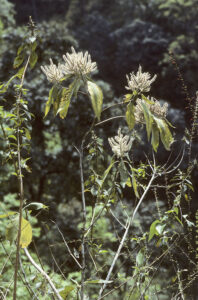
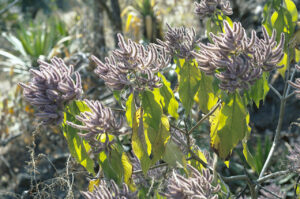
The generic name is derived from Ancient Greek koleos (‘a sheath’), referring to the manner in which the stamens are united.
It grows in forests and shrubberies, and on open slopes, distributed in eastern Africa, from Ethiopia southwards to Tanzania, in southern Arabia, the Indian Subcontinent, southern China, and Indochina. In the Himalaya, it is found at elevations between 1,200 and 2,400 m.
In Ayurvedic medicine, this species is utilized for heart disease, convulsions, and painful urination. In Nepal, the nutlets are used in pickles.
The specific name is Latin, meaning ‘bearded’, alluding to the bristly-hairy stem and calyx.
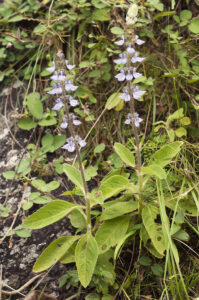
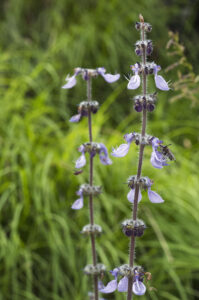
The genus was named for Robert David Colquhoun, 12th Baronet (1786-1838), who served in the British Indian Army. He was a keen plant collector and early patron of the Calcutta Botanical Gardens.
It is found from Kashmir eastwards to Indochina and south-western China, growing in shrubberies and on open slopes at elevations between 1,200 and 4,200 m. It is widely cultivated elsewhere as an ornamental.
Locally, the plant is used for fodder, and leaves and flowers are used as incense. Children sometimes suck the nectar out of the flowers.
The specific name is Latin, meaning ‘scarlet’, naturally alluding to the flower colour.
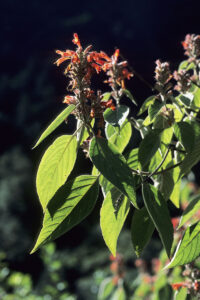


The generic name is derived from Ancient Greek drakon (‘dragon’ or ‘serpent’) and kephale (‘head’), alluding to the flower shape.
A plant of dry steppe and rocky areas in Central Asia, distributed from Kyrgyzstan and Afghanistan eastwards to south-eastern Siberia and north-western China, and thence southwards to the northern fringes of the Himalaya and the Yunnan Province, found at elevations between 3,000 and 5,500 m. It is quite common in Ladakh.
An essential oil is extracted from this species, used in cosmetics. It is threatened due to overgrazing.
The specific name is derived from Ancient Greek heteros (‘different’) and phyllon (‘leaf’), thus ‘with differently shaped leaves’.
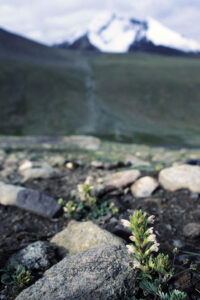
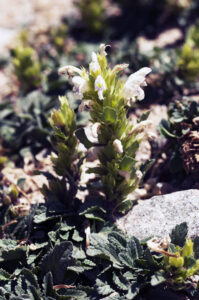
The generic name honours Prussian botanist and physician Johann Sigismund Elsholtz (1623-1688), who was a pioneer in the fields of hygiene and nutrition. The name was applied by German botanist and pharmacist Carl Ludwig Willdenow (1765-1812), who was one of the founders of the study of the geographic distribution of plants.
Several species are used medicinally in the Himalaya for various ailments, including cough, colds, wounds, and scabies.
Some pictures, depicting unidentified Elsholtzia species, are presented below. I would be happy to receive information on them. You can use the address at the bottom of the page.
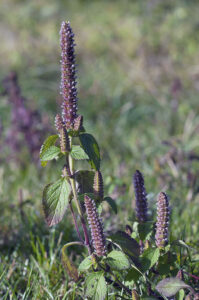
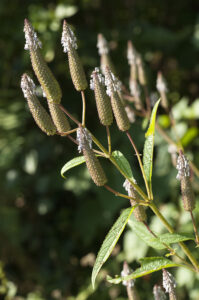
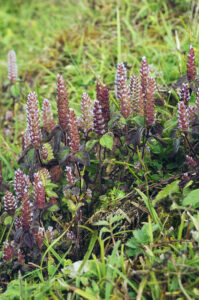
It grows on open slopes and river plains, from Pakistan and Tibet eastwards to Gansu, Sichuan, and Yunnan Provinces, at altitudes between 3,500 and 4,600 m. It is quite common in Ladakh.
Locally, the leaves are eaten as salad, and the seeds are chewed for cough and colds.
The specific name is derived from Ancient Greek, meaning ‘with woolly spikes’, which is odd, as they are not particularly hairy.

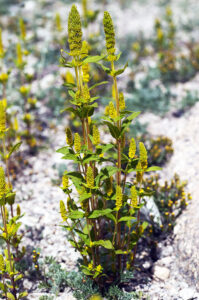
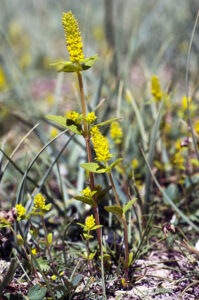
A shrub, to 2.5 m tall, branches 4-angled, downy, leaves stalked, broadly ovate, glandular, pointed, to 20 cm long and 8.5 cm wide, with conspicuously impressed veins above, margin with small teeth. Spikes slender, terminal or axillary, to 10 cm long, flowers numerous, tiny, yellow, corolla to 5 mm long, hairy inside. Flowering occurs July-October.
In Nepal, crushed leaves are applied to scabies. The seeds are edible, raw or pickled.
The specific name is Latin, meaning ‘yellow’, alluding to the flowers.
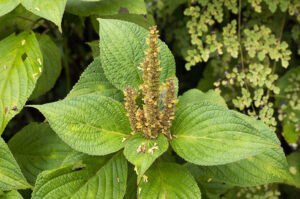
It occurs from Pakistan eastwards across the Himalaya to Myanmar and western China, growing in shrubberies and on open slopes at elevations between 1,200 and 3,800 m. It is common in Nepal.
Oil from the seeds is edible. In Nepal, powdered seeds are used as a flavouring agent in food, and a powder made from the plant is burned as incense. Juice of the root is taken to relieve headache.
The specific name is derived from the Latin frutex (‘bush’) and the suffix osus (‘resembling’), thus ‘shrubby’.
Superficially, Colebrookea oppositifolia (above) is similar, but has almost entire leaves and densely woolly spikes.
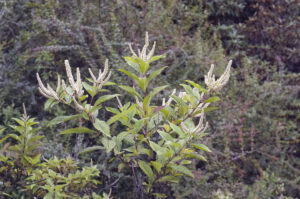
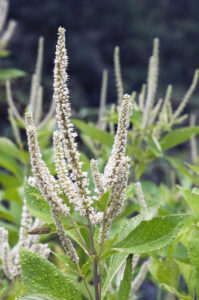
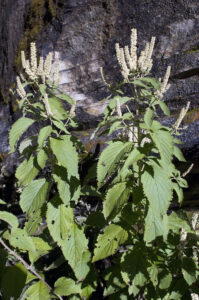

The generic name is derived from Ancient Greek erion (‘wool’) and phyton (‘plant’), referring to the dense layer of hairs in E. wallichii (below).
Flowers are in whorls, sessile, wine-red or purple, densely hairy, corolla to 3 cm long, the upper lip arching over the smaller lower lip. Flowering occurs July-September.
It grows among rocks and scree at elevations between 2,700 and 5,400 m, distributed from western Nepal eastwards to the Yunnan Province, northwards across Tibet to Qinghai.
A tonic is made from the root.
The specific name honours Danish physician and botanist Nathaniel Wallich (1786-1854), who studied the Indian and Himalayan flora in the early 1800s, describing many species new to science (see Geranium wallichianum above).
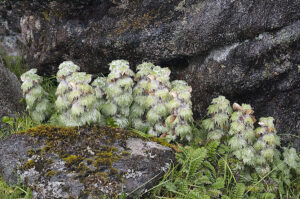
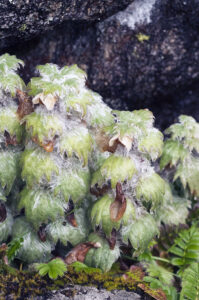
The generic name is derived from Ancient Greek isos (‘equal’) and odous (‘tooth’), alluding to the 5 equal lobes of the calyx of most species in the genus.
Flowers on slender branches, in small clusters from the leaf axils, corolla white, hairy, to 6 mm long, with tiny violet spots on the upper lip, tube hidden in the calyx. The flowering period is long, from March to October.
It is distributed from Afghanistan eastwards along the Himalaya to south-western China, with an isolated occurrence in Oman. In the Himalaya, it is quite common in drier areas, growing in shrubberies and on open slopes at altitudes between 1,000 and 2,700 m.
The specific name is Latin, meaning ‘wrinkled’, referring to the leaves.
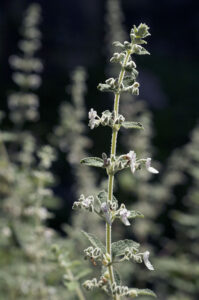
The generic name is derived from Ancient Greek lamia (‘gaping mouth’), alluding to the shape of the flowers. The common name refers to the nettle-like leaves, which do not sting.
This species is widespread in temperate areas of Eurasia, in the Himalaya restricted to the western part, eastwards to central Nepal, found at elevations between 1,500 and 3,700 m. It grows in a wide variety of habitats, including shrubberies, damp slopes, forest margins, and along trails.
Young leaves are edible, and the flowers are used medicinally.
The specific name is Latin, meaning ‘white’, alluding to the flowers.
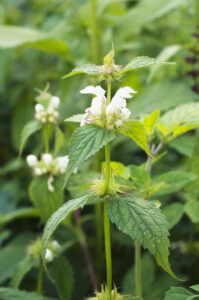
Stem to 40 cm tall, branched from the base, erect or ascending, angular, softly hairy, leaves opposite, lower ones short-stalked, kidney-shaped or rounded, to 3 cm across, margin with rounded teeth or sometimes lobed. Upper leaves smaller, sessile, stem-clasping.
Flowers are arranged in axillary whorls with 6-10 flowers, calyx tubular or bell-shaped, to 5 mm long, densely hairy, teeth lanceolate, to 2 mm long. Corolla pink, reddish or purplish, to 2 cm long, downy, tube to 1.5 cm long. Flowers appear from March to August.
All green parts and flowers can be eaten raw or cooked. It has a slightly peppery taste, similar to celery.
The specific name is derived from the Latin amplexus (‘clasped’) and caulis (‘stem’), referring to the upper leaves clasping the stem. The name henbit was first used by English herbalist John Gerard (c. 1545-1612), who published a large work on herbal medicine, Herball or Generall Historie of Plantes. The word is a corruption of the Dutch hoenderbeet (‘hen’s morsel’), alluding to hens eating the plant.
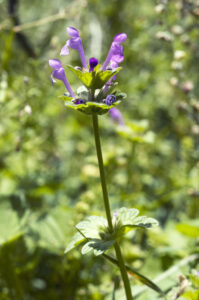
The generic name is a Latinized form of Ancient Greek leon (’lion’) and oura (’tail’), thus ‘lion’s tail’, which is also a popular English name. It is not clear, why Swedish naturalist Carl Linnaeus (1707-1778) applied this name to the common motherwort (below).
A tall plant, growing to a height of 1.5 m, stem angular, leaves very variable, ovate or lanceolate, usually with 3-7 deeply cut lobes, but sometimes undivided, nettle-like, to 8 cm long, gradually getting smaller up the stem. The inflorescense is a very long, leafy spike of interrupted axillary whorls, flowers pink, mauve, or pure white, corolla to 1.2 cm long, hairy, calyx with 5 spreading, spine-tipped teeth. Flowering occurs June-August.
Motherwort has a long history as a medical herb. Since the Middle Ages, it was used in Europe for heart palpitations and high blood pressure. In China, it was used to prevent pregnancy and to regulate menstruation, and in Europe, midwives used it for various female disorders, including uterine infection – hence the name motherwort. Same usage was found among American natives of the Delaware area.
In his delightful book All about Weeds, American botanist Edwin Spencer (1881-1964) writes: “Here’s sumpin’ you art to know,” said an old midwife to a young bride, as the two of them stood looking at a tall mint, growing by the garden fence. “This is motherwort.”
Today, motherwort is used to suppress spasms. As a tonic, it is taken for palpitations and irregular heartbeat, and for fever, nervousness, and delirium. It is also used to ease stomach gas.
In Nepal, the juice is utilized to induce sweating and to regulate digestion. Pounded leaves are applied to fungi between the toes, caused by walking barefoot in water during the rainy season.
The specific name is derived from Ancient Greek kardia (‘heart’), alluding to its usage for heart problems.
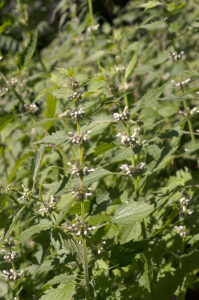
The generic name is derived from Ancient Greek leukos (‘white’). It refers to the flower colour, which is white in the majority of the species, rarely yellow, purple, brownish, or scarlet.
Inflorescences are numerous axillary whorls of snow-white flowers, to 1 cm long, tube surrounded by the very hairy, tubular calyx, to 8 mm long, pale green with dark green veins and 10 sharp teeth. Blooming takes place April-September.
It is distributed in the Himalaya, from Kashmir eastwards to Sikkim, growing in fields, along trails, and among rocks, at elevations between 700 and 3,000 m.

Inflorescences are erect, cylindric spikes, to 15 cm long and 2.5 cm wide, with numerous densely packed, tiny, whitish flowers, to 9 mm long, calyx densely hairy, with teeth to 1.5 mm long. It flowers in the winter period, from October to April. The flowers are much visited by bees.
It is found from Uttarakhand eastwards to western China, southwards to Bangladesh and northern Indochina, in the Himalaya growing in shrubberies and waste areas, and along forest margins, at altitudes between 1,500 and 2,600 m.
The generic name is derived from Ancient Greek leukos (‘white’) and skeptron (‘scepter’), alluding to the shape of the inflorescence. The specific name is derived from the Latin canis (‘dog’) – perhaps a derogatory term.
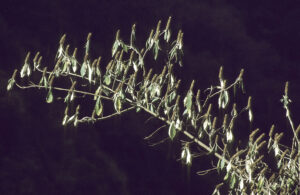
Most of these plants are found in wet environments. Identification is often difficult, as many species hybridize.
The generic name is a Latinized version of minthe, the Ancient Greek word for these plants.
It is native from the major part of Europe eastwards to central Siberia, southwards to the Arabian Peninsula, Iran, the Himalaya, and China. It also occurs in northern, eastern, and southern Africa, avoiding tropical areas. In the Himalaya, it is found at altitudes between 1,500 and 3,800 m, from Pakistan eastwards to central Nepal, restricted to wetlands in dry regions.
The plant has a peppermint-like fragrance and contains medicinal properties. In his Complete Herbal, from 1653, English herbalist Nicholas Culpeper (1616-1654) writes: “It is good for wind and colic in the stomach … The juice, laid on warm, helps the King’s evil [scrofula] or kernels in the throat [tonsil stones] … The decoction or distilled water helps a stinking breath, proceeding from corruption of the teeth, and snuffed up the nose, purges the head. It helps the scurf or dandruff of the head used with vinegar.”
The specific name is Latin, meaning ‘long-leaved’. The prefix horse is from Middle English, denoting a coarse variety of a plant, in this case presumably indicating its inferior quality to that of peppermint (M. x piperata).
M. royleana, which grows in the same areas, is very similar, but the inflorescences are in separated whorls towards the end of stems.
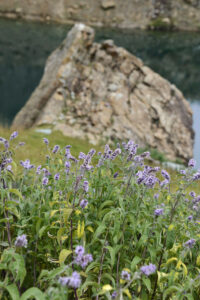
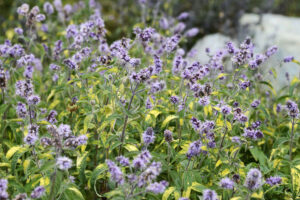
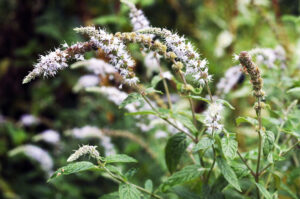
The generic name is derived from Ancient Greek mikros (‘small’) and meris (‘portion’), referring to the tiny leaves and flowers of several species.
It is distributed from Afghanistan eastwards along the Himalaya to south-western China, growing on grassy slopes and along trails at elevations between 1,000 and 4,000 m. Previously, it was considered to have a much wider distribution, including Africa, southern Arabia, the Middle East, and the Indian Subcontinent, but plants from these areas are now regarded as separate species.
A paste made from the plant is used for various ailments, including wounds, sinusitis, toothache, dysentery, colds, and cough. Fresh or dried leaves and flowers are used as a flavouring agent and as tea, and an oil extracted from the plant for flavouring liqueur. The dried plant is burned as incense.
The specific name is Latin, meaning ‘two-flowered’, alluding to the flowers often coming in pairs.
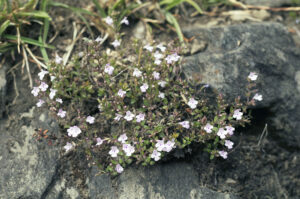
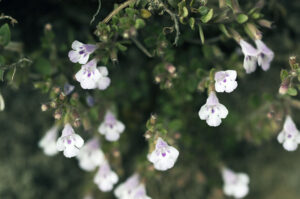
The generic name is the classical Latin name of these plants, maybe originally derived from Etruscan nepete, referring to an ancient city named Nepi.
The common names refer to the fact that cats, strangely enough, like to eat the leaves of the common catmint (N. cataria). They are attracted to this plant by the powerful fragrance emitted from its crushed or brushed leaves. In the old days, people who grew the plant for the market noted that if you planted it, the brushing of the leaves was enough to attract the cats, but if you sowed it and left it alone, it wouldn’t emit any fragrance, and the cats wouldn’t detect it. There is an old rhyme, saying:
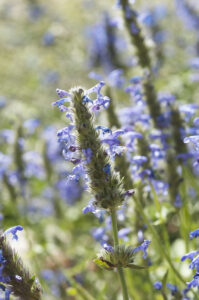
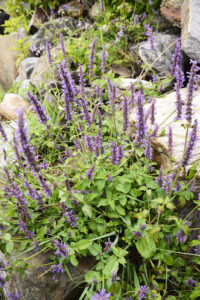
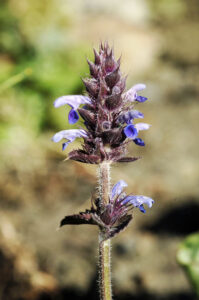
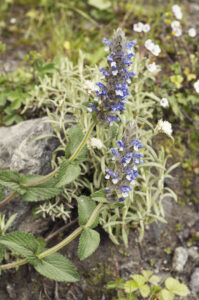
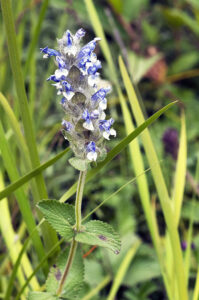
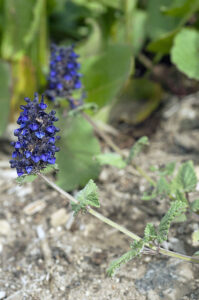
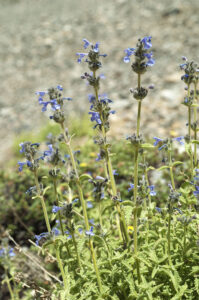
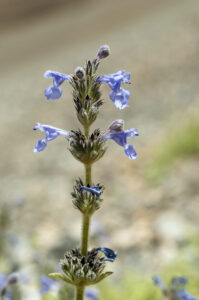
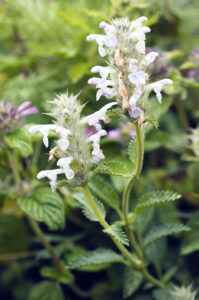
This species grows in forests and on open slopes, from Pakistan eastwards to Uttarakhand, at altitudes between 2,100 and 3,600 m.
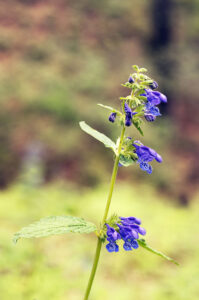
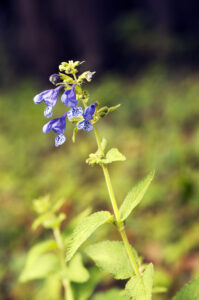
It is easily identified by its woolly leaves, which emit a lemon-like fragrance. Stems numerous, erect or ascending, pale green, to 35 cm long, covered in whitish hairs. Leaves heart-shaped or triangular, fleshy, woolly-hairy, to 3 cm long and across, margin with rounded teeth.
Inflorescences are dense whorls, widely spaced up the stem, 6-8-flowered, corolla blue, to 1.3 cm long, tube slender, incurved, lobes of upper lip very small, to 1.5 mm long, middle lobe of lower lip to 4 mm long. It flowers from June to September.
In former days, it was used medicinally for bone fractures, muscular pains, skin infections, and lymphatic disorders. The leaves can be used as a spice.
The specific name is derived from the Latin floccus (‘a tuft’ or ‘a wisp of wool’) and the suffix osus (‘full of’), presumably referring to the woolly leaves.
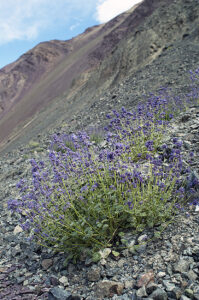
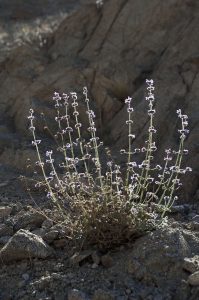
It grows on open slopes and in grasslands, restricted to drier areas at elevations between 2,300 and 4,500 m, from Afghanistan eastwards across southern Tibet and northern parts of the Himalaya to Sichuan and Yunnan Provinces.
In local medicine, it is used against excessive transpiration.
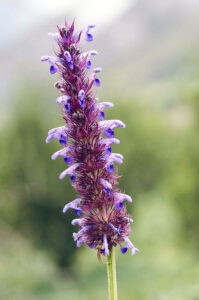
Inflorescences are terminal, mostly globular in outline, to about 3.5 cm long, bracts purplish, linear, hairy, longer than flowers. Corolla pale blue or pale violet, to 1.8 cm long, upper lip concave, lower lip often with white spots, tube curved, often whitish. Flowers appear June-August.
It grows on stony or gravelly slopes, from Tajikistan eastwards to Xinjiang, and thence southwards through Tibet to Pakistan, Ladakh, and Himachal Pradesh, found at elevations between 4,400 and 5,300 m.
The plant is used for stomach and liver trouble, and oedema. An aromatic oil is extracted from it.
The specific name is Latin, meaning ‘with long bracts’.
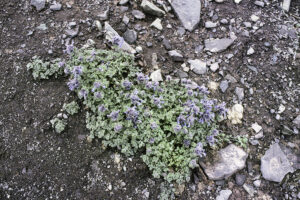
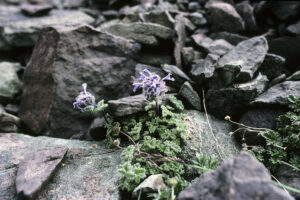
It is restricted to dry stony areas, found from Afghanistan eastwards through Kashmir and Ladakh to Himachal Pradesh, growing at altitudes between 2,700 and 4,300 m.
The specific name is derived from Ancient Greek pous (‘foot’) and stakhys (‘spike’, originally meaning ‘an ear of grain’). The inflorescence is a spike, but terminal, so it is hard to see what ‘foot’ refers to.
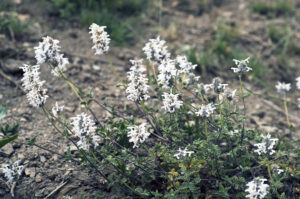
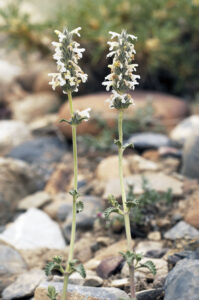
The generic name is derived from Ancient Greek origanon, from oros (‘mountain’) and ganos (‘brightness’), thus ‘brightness of the mountain’.
Inflorescences are dense globular or oblong spikes, terminal or from the upper leaf axils, corolla purplish-red to white, tubular, to 7 mm long, upper lip to 1.5 mm long, 2-lobed, lower lip to 2 mm long. It blooms June-September.
This plant was originally native to Central Asia and the Mediterranean region, but has become widely naturalized elsewhere in temperate areas. In the Himalaya, it is found from Pakistan eastwards to Bhutan, at elevations between 600 and 4,000 m. Habitats include open slopes and grasslands.
Leaves and flowers are used for tea, as a spice, and as incense. Leaves and seeds are pickled. In Nepal, the plant is utilized for treatment of diarrhoea, colic, rheumatism, and toothache, and ash from the bark is applied to wounds.
The specific name is Latin, meaning ‘common’.
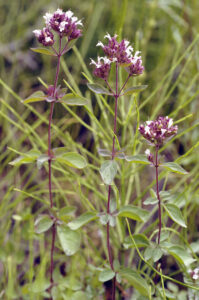
The generic name is derived from Ancient Greek siphon (‘tube’) and orthos (‘erect’), alluding to the long corolla tube.
It is distributed from central Nepal eastwards to Bhutan, growing in forests and shrubberies at altitudes between 400 and 2,000 m.
Juice of the plant is used for treatment of malaria.
The specific name is Latin, meaning ‘bent’, alluding to the often bent corolla tube.
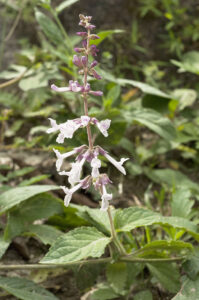
The generic name was given in honour of a Russian general, Count Vasily Alekseevich Perovsky (1794-1857).
Inflorescences are lax panicles with numerous small pale blue or lavender-blue flowers, to 1 cm long, tube slender, longer than the dark purple, very hairy calyx, upper lip 4-lobed, lower entire. They occur from June to September.
It occurs from eastern Iran and Turkmenistan eastwards to Tibet, Pakistan, and Ladakh, growing in stony areas at elevations between 2,700 and 3,600 m. It is very common in Ladakh.
The entire plant has a strong smell. It was formerly used in traditional medicine as a cooling agent.
The specific name refers to an aromatic shrub, Artemisia abrotanum, the latter name derived from abrotonon, the Ancient Greek name of a species of wormwood (Artemisia), and the Latin oides (‘resembling’). It is not clear what the likeness refers to.
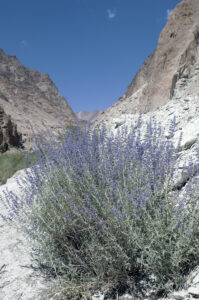
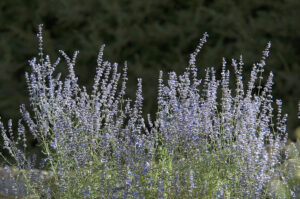
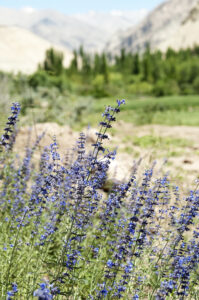
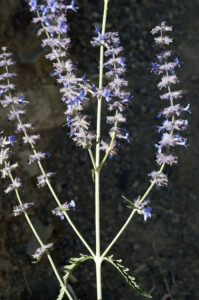
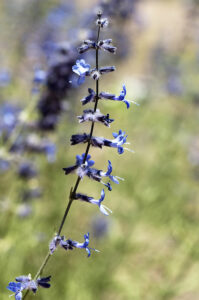
Inflorescences of these plants are very characteristic, being arranged in dense whorls at intervals up the angular stem.
The generic name is derived from Ancient Greek floga (‘flame’), probably referring to the former usage of the hairy leaves of members of the genus as lamp wicks.
This is the commonest member of the genus in the Himalaya, growing in open areas at altitudes between 1,200 and 4,100 m, from Afghanistan eastwards to south-western China.
The specific name is Latin, meaning ‘with many bracts’.
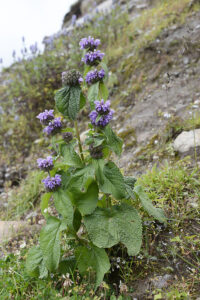
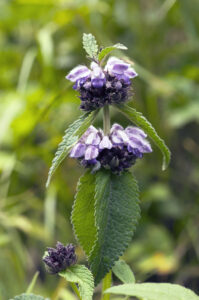
A stout plant, to 2 m tall, but often much lower, lower leaves long-stalked, heart-shaped, hairy, blade to 20 cm across, margin toothed, upper leaves much smaller, ovate or heart-shaped, almost sessile. Flowers in whorls, corolla pink or purple, to 2 cm long, upper lip hairy, forming a hood, lower lip 3-lobed, calyx purple, sometimes almost as long as the corolla tube, sometimes shorter, with sharp teeth, bracts awl-shaped, purple, hairy. It flowers from June to August.
The specific name is Latin, meaning ‘large-leaved’.
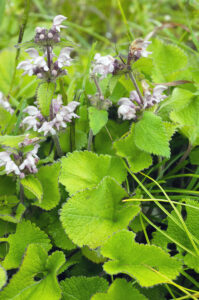
A prostrate herb, hugging the ground as a means of protection against the strong winds, which often blow on the Tibetan Plateau. One disadvantage of this adaptation is that if the plant grows on sandy soil, gusts of wind will blow sand onto the leaves (see pictures), thus diminishing its ability to obtain energy from sunlight through photosynthesis.
There are 4-6 rounded, rhombic, or kidney-shaped, wrinkled, hairy leaves, to 13 cm across, with deeply impressed veins, margin with rounded teeth. The inflorescence is a dense cluster at the centre of the leaves, to 7 cm long, usually stemless, but sometimes on a stem to 15 cm tall. Corolla purplish-blue, reddish-purple, or mauve, to 1.5 cm long, with long white hairs along the edge of the upper lip, and also a few on the lower lip. Calyx hairy, to 8 mm long, with sharp bristles. Flowering takes place June-August.
The plant is utilized in traditional medicine for traumatic problems.
The specific name is Latin, meaning ‘moving in a circle on a central axis’, naturally alluding to the outline of the leaves around the inflorescence.
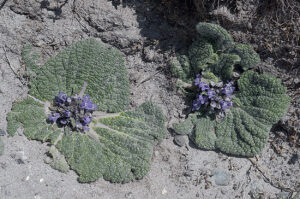
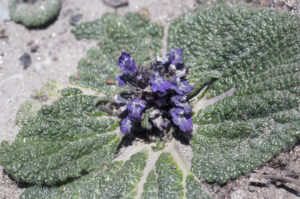
The generic name is derived from Ancient Greek pogon (‘beard’) and stemon (‘thread’), alluding to the hairy filaments.
It is widespread in the Indian Subcontinent and also occurs in Indochina. In the Himalaya, it may be found up to elevations around 1,300 m, growing in shrubberies and along forest margins.
It is cultivated in many places for its medicinal properties. In Nepal, juice of the plant is given for cough and colds, juice of the root for fever. In India, juice of the leaves is applied to repel leeches, dried shoots are used for flavoring country liquor, and leaves and flowers are made into garlands. It is also an important bee plant.
The specific name means ‘of Bengal’ – in the British colonial period indicating a much larger area of northern India than the present-day Bengal.
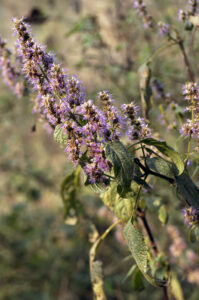
The generic name, formerly spelt Brunella, is from the German name of these plants, Braunelle, referring to the usage of common self-heal (below) against quinsy, in German Bräune. The common names also refer to the medicinal properties of the plant.
This species is probably a native of Temperate Eurasia and North Africa, but has become widely naturalized, especially in North America. In the Himalaya, it is found in grasslands and on open slopes at elevations between 1,200 and 3,800 m, distributed from Pakistan eastwards to Bhutan.
In his delightful book All about Weeds, American botanist Edwin Spencer (1881-1964) writes: “It is a strange plant in that one seldom finds it in abundance anywhere, and yet it is found everywhere. A man, who had spent seven years in Japan, and who had lived on nearly every island in the archipelago, said that he never failed to find this little plant wherever he went, and that although he had been in many nations of the world he had never entered one, where Prunella was not present to greet him – not many plants, but always enough to attract his attention.”
Previously, it was widely used in traditional medicine. Among American natives, persons with fever were bathed in a decoction of the plant, and the decoction was also drunk to sharpen your vision. Today, self-heal is widely used for wounds and quinsy, and also for swollen eyes and glands. In Nepal, a paste of the plant is applied to an aching back.
The specific name is Latin, meaning ‘common’.
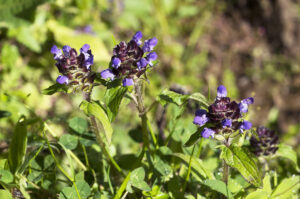
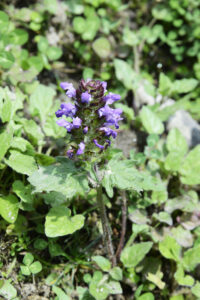
The generic name is derived from Ancient Greek karyon (‘nut’ or ‘kernel’), and pteron (‘wing’), alluding to the winged seeds, and pseudes (‘false’), referring to the fact that these plants have been removed from the genus Caryopteris.
A handsome plant, growing to 3 m tall, with large clusters of flowers at the end of spreading, 4-angled branches. The leaves are elliptic, pointed, entire or toothed, to 15 cm long and 4 cm broad.
The fragrant flowers are in dense terminal or axillary clusters, corolla mainly bluish-purple, upper lip usually paler, sometimes whitish, tube to 8 mm, hairy, glandular, lobes to 8 mm long. Stamens and style are much exserted. Calyx is densely hairy. Flowering takes place from February to May. The fruit is a capsule, more or less globular, to 4 mm across, hairy, dark blue when ripe.
The plant is lopped for fodder.
The specific name is Latin, meaning ‘with two colours’, presumably alluding to the corolla.
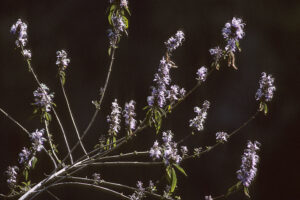

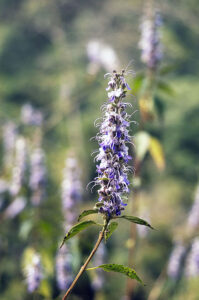
The generic name is derived from the Latin salvere (‘to make well or healthy’), referring to the healing properties of the common sage (S. officinalis).
This plant is found from Uttarakhand eastwards to Myanmar and south-western China, growing at elevations between 1,500 and 4,000 m. Habitats include forest margins, open slopes, and shrubberies.
The specific name is Latin, meaning ‘bell-shaped’, derived from campanula (‘little bell’).
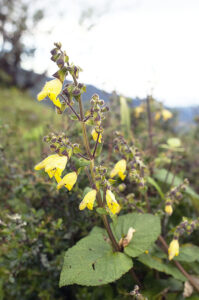
It is an erect herb, to 70 cm tall, hairy, leaves short-stalked, ovate, heart-shaped, or triangular, to 5 cm long and 4 cm broad, margin toothed, tip pointed. Inflorescences are widely spaced, terminal racemes. Calyx green, bell-shaped, to 9 mm long, downy and glandular-hairy, 2-lipped. Corolla scarlet or deep red, to 2.3 cm long, lower lip broad, to 8.5 mm wide, upper lip smaller. Flowers appear April-July.
The specific name is Latin, meaning ‘scarlet’.
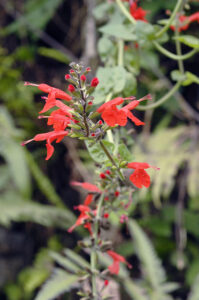
It is distributed from Pakistan eastwards to Bhutan, growing at altitudes between 2,400 and 4,000 m. Habitats include forests, shrubberies, and open slopes.
In Nepal, the sweet-tasting flowers are eaten, and also the seeds when roasted. Young stems are pickled.
The specific name is Latin, meaning ‘gaping’, alluding to the flower shape.

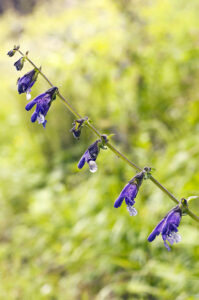
It grows on dry open slopes in the western Himalaya, from Pakistan eastwards to western Nepal, at elevations between 1,500 and 3,000 m.
Locally, this plant is cooked as a vegetable, and also used in salads.
The specific name, derived from the Latin lana (‘wool’) and atus (a suffix), refers to the woolly leaves.
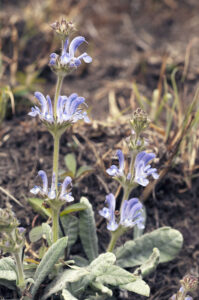
It is distributed in drier areas, from eastern Afghanistan eastwards to Bhutan, growing in open places and along trails at elevations between 2,100 and 4,300 m.
In Nepal, the seeds are roasted and pickled. Juice of the root is given for fever.
The specific name is derived from the Latin nubes (‘cloud’) and colo (‘to inhabit’), alluding to the high altitudes this plant is growing at.
Previously, it was considered a subspecies of the sticky sage (S. glutinosa), which is today regarded as being restricted to western Asia and southern Europe.
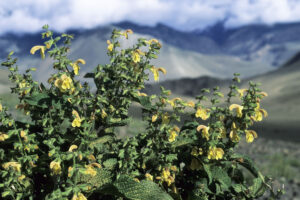
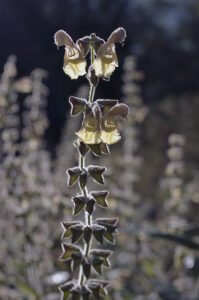
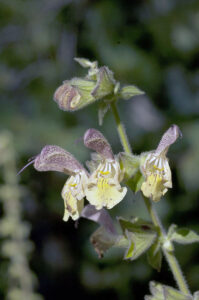
The generic name was previously regarded as a derivation of scutellum, diminutive of scutum (’shield’). It was thought that it referred to the hump on the upper lip of the calyx, which may resemble a small shield. However, it seems more probable that the name is derived from scutella, a diminutive of scutra (’bowl’). Scutella was the classical term for a small offering cup. The name refers to the rounded lower lip of the calyx, where the nut-like seeds lie in a small ‘bowl’, after the upper lip of the calyx has fallen off.
Flowers are arranged in lax, terminal spikes, to 25 cm long, corolla 2-lipped, to 1.8 cm long, blue or purple with a white lower lip, tube slender, curved, to 1 cm long. The calyx is very small, but enlarging in fruit. Flowering occurs from July to December.
It is widely distributed, found from India eastwards to central China, and thence southwards through Indochina to Indonesia and New Guinea. In the Himalaya, it occurs from Uttarakhand eastwards, at elevations between 800 and 2,400 m. Habitats include forest margins, grassy areas, and along trails.
In Nepal, juice of the plant is applied to wounds between toes, and also used for fever. Juice of the root is used for indigestion, gastric problems, and fever.
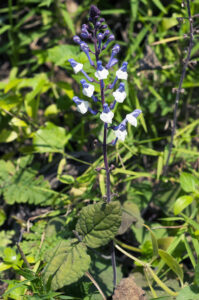
It grows in shrubberies and open areas at elevations between 1,200 and 2,400 m, distributed from Kashmir eastwards to eastern Nepal and southern Tibet.
In Nepal, juice of the plant is given for fever and stomach ache, applied to wounds, and dripped into the ear to relieve earache. Juice of the root is applied to an aching back.
The specific name is Latin, meaning ‘climbing’, alluding to its rambling habit.
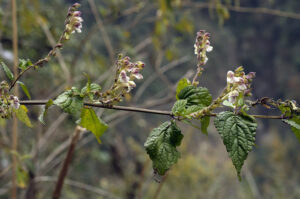
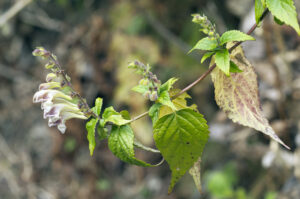
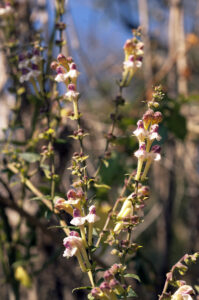
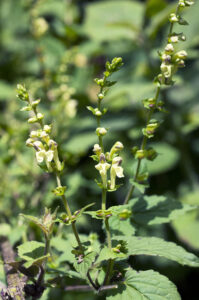
The generic name is the Ancient Greek name of the downy woundwort (S. germanica). The popular name woundwort refers to the former usage of several species in this genus for healing wounds, hedge-nettle to the nettle-like leaves of many of the species.
This plant is distributed from Afghanistan eastwards to Bhutan, growing in open areas and grasslands at altitudes between 2,100 and 4,000 m.
The specific name is derived from Ancient Greek serikos (‘seric’ or ‘silken’), alluding to the woolly-hairy stem and leaf stalks.
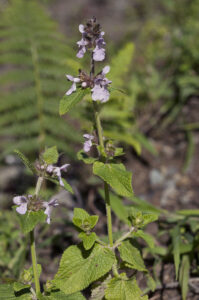
A rather woody, many-branched plant, often forming clumps. Stems slender, 4-angled, slightly hairy, to 60 cm tall, leaves stalkless or short-stalked, lanceolate or elliptic, to 2.5 cm long and 1 cm wide, entire or lobed, pointed. Inflorescences have 2-6 flowers, arranged in widely spaced whorls up the stem, corolla pink or purplish-white, to 2.5 cm long, tube slender, straight or slightly curved, to 1 cm long, upper lip large, forming a hood over the exserted stamens, lower lip 3-lobed, with a large mid-lobe. Flowering occurs June-September.
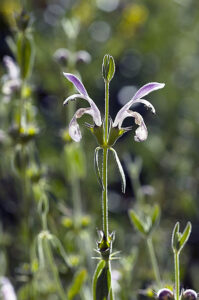
Members of this genus are characterized by the absent or very short upper lip of the corolla, whereas the lower lip is 5-lobed.
The generic name was used by Greek physician, pharmacologist, and botanist Pedanius Dioscorides (died 90 A.D.) for several species in this genus. It is believed to refer to King Teukros of Troy who used the plant medicinally.
The popular name is Middle English, from the Latin germandra, derived from Ancient Greek khamaidrus (‘ground oak’), from khamai (‘on the ground’) and drus (‘oak’), alluding to the leaves of some species, which were thought to resemble oak leaves.
Inflorescences are spike-like, branched clusters, to 15 cm long. Bracts are conspicuous, purple or green, broadly ovate, long-pointed, to 1 cm long, often concealing the flowers. Corolla pink or purplish, to 1.3 cm long, tube not much longer than the calyx, upper lip absent or very short, lower lip 5-lobed. It flowers July-October.
This plant is widely distributed, from India eastwards to central and southern China, and thence southwards through Indochina to Sumatra. In the Himalaya, it is mainly found at altitudes between 900 and 2,400 m, growing in shrubberies, on open slopes, and along forest edges.
In Nepal, juice of the plant is applied to wounds between toes.
The specific name is Latin, meaning ‘fourfold’. It may refer to the angular stem.
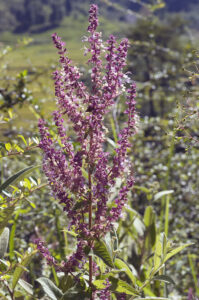
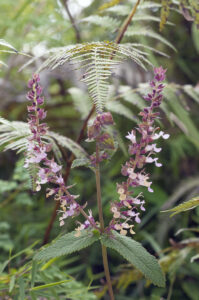
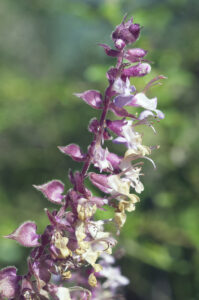
These plants are fragrant, mostly creeping dwarf shrubs. Leaves and flowers of some species are used as a spice.
The generic name is the classical Greek name of these plants.
It is distributed in drier stony areas, from Afghanistan across Tibet and the Himalaya to northern China and Japan, in the Himalaya found at elevations between 1,500 and 4,300 m.
In Nepal, leaves and flowers are used as a spice, and made into pickles. They are also burned as incense. Juice of the plant is used for stomach and liver trouble and body ache, water from the boiled plant to expel intestinal worms.
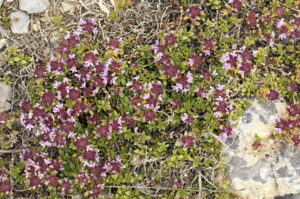
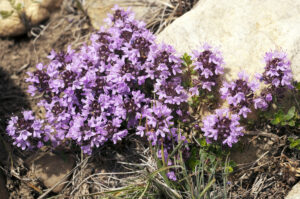
The generic name was given in honour of English traveller and orientalist George Thomas Staunton (1781-1859), 2nd Baronet, who was the first person to bring S. latifolia (below) to Britain from China.
Initially, the genus was named Holboellia by Danish physician and botanist Nathaniel Wallich (1786-1854), who studied the Indian and Himalayan flora in the early 1800s (see Geranium wallichianum above). The name honours Frederik Ludvig Holbøll (1765-1829), superintendent of the Royal Botanical Garden in Copenhagen.
Inflorescences several, clustered in the leaf-axils, flowers drooping, bell-shaped, fragrant, sepals 6, oblong or elliptic, pink or greenish-white, to 2.2 cm long and 9 mm broad, petals very small. Flowering takes place March-June. The fruit is elliptic or oblong, to 10 cm long and 4 cm broad, rounded at both ends, pinkish or reddish-purple when ripe. The ripening period is long, from May to October.
It is distributed from Pakistan eastwards across the Himalaya, southern Tibet, and Bangladesh to south-central China, in the Himalaya found in forests and shrubberies at altitudes between 1,500 and 4,000 m.
It was cultivated as an ornamental at an early stage. In the Himalaya, ripe fruits are eaten raw.
The specific name is Latin, meaning ‘broad-leaved’. The popular name was given in reference to the shape of the fruit.
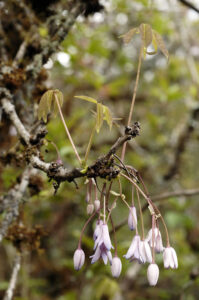
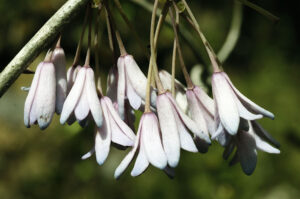
The position and number of veins on the leaves is a helpful means of identifying the genus.
About 6 species occur in the Himalaya, besides others which are cultivated, including the camphor tree (C. camphora), presented on the page Plants: Ancient and huge trees.
The generic name is derived from the Ancient Greek name of cinnamon, kinnamomon, derived from a Semitic language, and perhaps ultimately based on the Malay name of these plants.
Inflorescences are axillary or terminal, branched, many-flowered clusters, to 15 cm long, flowers to 7 mm long, corolla yellowish or greenish-white, with oblong lobes, to 4 mm long, tube silky-haired. Flowering occurs April-May. The fruit is obovoid or ellipsoid, black, fleshy, to 1.4 cm long, calyx lobes sometimes persistent.
It is distributed from Kashmir eastwards along the Himalaya to Myanmar and the Yunnan Province, growing in forests at elevations between 500 and 2,100 m.
In Nepal, bark and leaves are added to curries and pickles, and dried bark and leaves are used medicinally to treat diarrhoea and colic.
The specific name is the ancient Sanskrit name of this tree. According to the Devi-Bhagavata-Purana, it is the name of a tree, growing in the abode of the shaktis (the female consorts of the superior gods). It always bears flowers, fruits, and new leaves, and their sweet fragrance is spread to all corners of the abode.
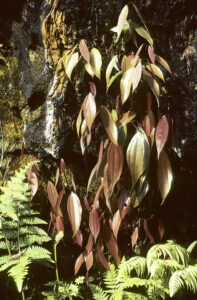
The generic name is derived from Ancient Greek dodeka (‘twelve’) and aden (‘gland’), thus ‘having 12 glands’, alluding to the many glands at the base of the filaments of male flowers.
Flowers are to 1.5 cm across, single or 2-3 together in leaf axils, flower-stalk very short, covered by yellowish-brown bracts, corolla lobes 6-9, rounded, outer ones pale yellow, inner ones darker yellow, stamens 10-18. Flowering occurs early in spring, from February to April. The fruit is berry-like, ellipsoid, purplish-black, to 1.3 cm long.
This species is quite common, found in forests from Uttarakhand eastwards to Myanmar, south-eastern Tibet, and south-western China, growing at elevations between 1,500 and 2,900 m.
The foliage is often lopped for fodder.
The specific name is Latin, meaning ‘large-flowered’.
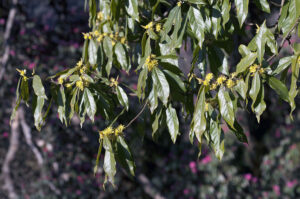
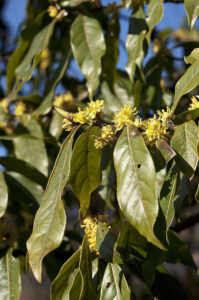
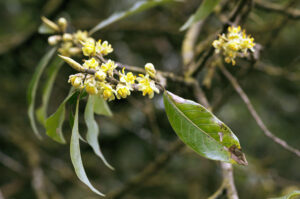
The generic name was applied in 1783 by Swedish naturalist and physician Carl Peter Thunberg (1743-1828) to commemorate Swedish botanist and physician Johan Linder (1676-1724), also known as Johan Lindestolpe, whose best-known botanical work was Flora Wiksbergensis (1716), the fourth printed account of a local Swedish flora.
The flowers, to 5 mm across, are arranged in clusters in the leaf-axils, encircled by 4-6 large, pale, overlapping bracts, petals elliptic, yellowish-green, flower-stalks hairy. Flowering takes place March-April. The fruit is ellipsoid, black, to 8 mm long and 6 mm wide, ripening June-August.
It is widespread, found from Uttarakhand eastwards along the Himalaya to northern Thailand and central China. In the Himalaya, it grows in forests and on open slopes at altitudes between 1,200 and 2,800 m. It is common in Nepal.
The wood is used for fuel, the foliage for fodder.
The specific name is Latin, meaning ‘most beautiful’.
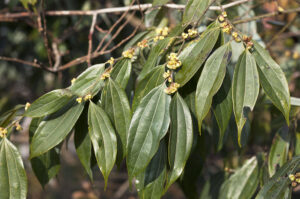
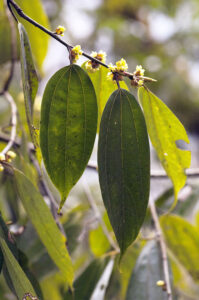
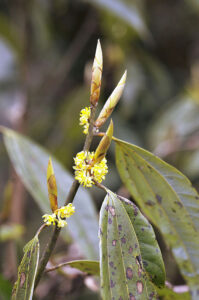
The etymology of the generic name is not known, but may refer to a Moluccan name of one of the members.
These plants were previously included in the genus Persea, which is now considered to be exclusively American.
It may grow to 16 m tall, but is usually smaller. The bark is dark-grey. The leaves are stalked, smooth, with an orange-like fragrance, green and shining above, blue-grey beneath, blade lanceolate to elliptic-oblong, to 18 cm long and 7.5 cm broad, often long-pointed.
Flowers are yellowish-green, to 1 cm across, in lax, branched clusters, stems hairless, corolla lobes 6, oblong, pointed, filaments hairy near the base. Flowers appear in March-April. The fruit is ellipsoid, purple, to 1.6 cm long.
In Nepal, a red dye is extracted from the bark, the foliage is used as fodder for silkworms and domestic animals, the wood for construction and firewood.
The specific name is Latin, meaning ‘most sweet-smelling’.
M. duthiei is very similar, but the inflorescences are downy-hairy, and the fruit is globular. It occurs from Pakistan to eastern Nepal.
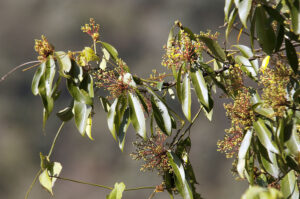
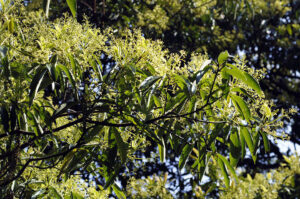
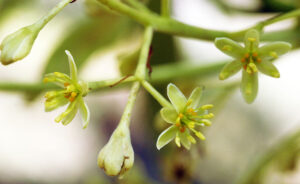
These plants capture small animals by means of bladder-like traps. There are aquatic as well as terrestrial species, the former catching larger prey like water fleas and nematodes, the latter tiny organisms like protozoa and rotifers. The pressure inside the bladder is negative, compared to its surroundings. When trigger hairs on the trapdoor is touched by a tiny animal, the prey, along with the water around it, is sucked into the bladder, whereupon the door closes again, the whole procedure lasting only 1/10,000th of a second.
The generic name is Latin, meaning something like ‘the master of a raft, floating on bladders’, from utriculus (‘a small leather container’), from uter (‘a leather container, sometimes used as a float’).
Other members of the genus are presented on the page Plants: Carnivorous plants.
The flowering stems are to 8 cm tall, with single or paired flowers, to 8 mm long, corolla white, often with violet streaks on the upper lip, and a yellow spot at the the base of the lower lip, which is rounded, 3- or 5-lobed, spur cylindric, to 4 mm long. Calyx lobes to 4 mm long, purple or violet. Flowering occurs July-September.
It is distributed at altitudes between 1,500 and 4,200 m, found from central Nepal eastwards to the Chinese provinces Sichuan and Yunnan.
The specific name is derived from the Latin bracchium (‘arm’ or ‘limb’) and the suffix atus, thus ‘having branches resembling arms’, presumably alluding to the occasional twin branches on the flowering stem.
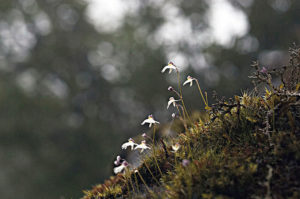
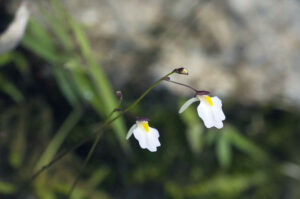
The generic name is derived from Ancient Greek kardia (‘heart’) and Crinum, a genus of spectacular plants, formerly in the lily family, but today in Amaryllidaceae. Thus, the name may be translated as ‘the Crinum-like (plant) with heart-shaped (leaves)’.
The large flowers, to 18 cm long, are clustered in a terminal raceme, up to 16 together, funnel-shaped, drooping, white tinged with green, very fragrant. They occur June-July. The fruit is a globular capsule, to 7.5 cm across.
This marvellous plant is distributed from Kashmir eastwards to Myanmar, south-eastern Tibet, and south-western China, growing in forests and shrubberies, and on open slopes, at elevations between 1,200 and 3,600 m.
In Nepal, a paste of the root is applied to dislocated bones. Flutes are made from the hollow stem.
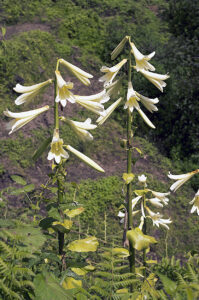
The genus was named for DeWitt Clinton (1769-1828), governor of New York State and a keen naturalist.
Flowers are funnel-shaped, drooping, in a terminal raceme or umbel with up to 12 flowers, white or very pale blue, petals to 1.2 cm long and 4 mm broad, tip blunt or pointed. Flowering takes place May-June. The berry is black or bluish, globular or ellipsoid, to 1.2 cm long, ripening July-October.
It is distributed from Uttarakhand eastwards to central China, and thence northwards to Japan, Korea, and south-eastern Siberia, in the Himalaya found in forests and shrubberies at elevations between 2,500 and 4,000 m.
In Nepal, tender shoots and leaves are cooked as a vegetable.
The specific name refers to the Uda River or the Uden District of Siberia. Presumably, the type specimen was collected there.
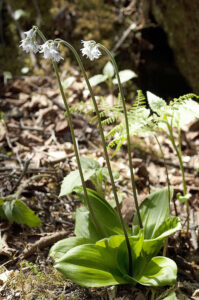
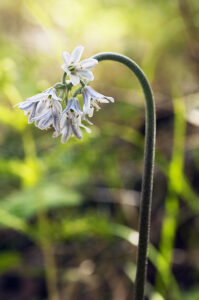
The generic name is derived from the Latin fritillus, the term for a cylindrical box holding dice, alluding to the bell-shaped flowers. The common name refers to the somewhat snake-like appearance of the nodding flowers.
This beautiful plant is the commonest of the two Himalayan species, distributed from western Nepal eastwards to Myanmar and south-western China. It grows in open grasslands and shrubberies at elevations between 3,000 and 4,600 m.
In Nepal, the roots are boiled or roasted. The bulb is used medicinally for treatment of lung problems, and a paste of the bulb is applied to bleeding wounds and pimples.
The specific name is derived from the Latin cirrus (‘a curl’), alluding to the tips of the upper leaves.
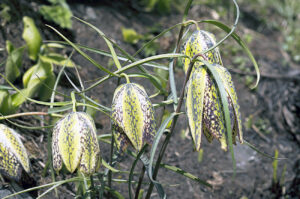
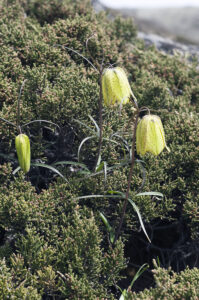
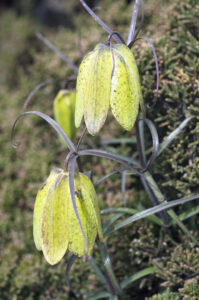
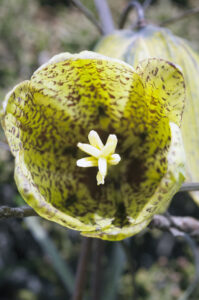
Following genetic studies, Lloydia species have now been moved to the genus Gagea, which contains more than 200 species, widely distributed in Eurasia, with a few species in North Africa and North America. The major part of the species have yellow, star-shaped flowers. For this reason, the common English species, G. lutea, is popularly known as the yellow Star-of-Bethlehem.
Today, about 42 species occur in the Himalaya, the vast majority in northern Pakistan.
The generic name honours English botanist Sir Thomas Gage, 7th Baronet of Hengrave (1781-1820).
Flowers are usually solitary, but sometimes up to 4 together, nodding, to 2 cm long and across, yellow with purplish-green veins and an orange throat, anthers and stigma pale yellow. Flowering occurs May-July.
It has a rather restricted distribution, found from central Nepal and extreme southern Tibet eastwards to Bhutan, growing on open slopes and in shrubberies at elevations between 3,800 and 5,000 m.
The specific name is Latin, meaning ‘the yellow one that is nodding’.
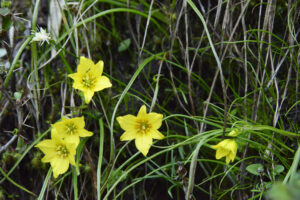

Leaves mostly basal, thread-like, to 15 cm long, stem usually with 2 much smaller leaves. Flowering stem to 15 cm tall, flowers solitary or few together, petals elliptic, to 1.7 cm long, white, with many purple streaks near the base, and orange or brownish throat. Filaments are hairy below. Flowers appear June-July.
The specific name is derived from the Latin longus (‘long’) and Ancient Greek skapos (‘staff’ or ‘stick’), in a botanical context referring to a leafless stalk, growing directly out of a root.

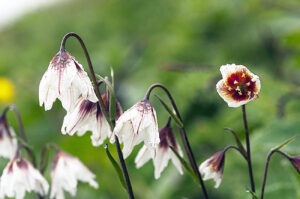
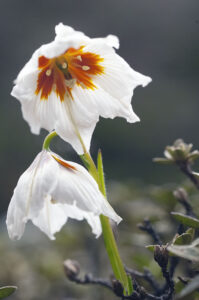
It is widely distributed in temperate areas of the Northern Hemisphere, in the Himalaya found in grasslands and rocky areas at altitudes between 3,500 and 4,800 m.
The specific name is derived from the Latin serus (‘late’). What it refers to is not clear. The popular name is explained above under genus name. In Welsh, its name is brwynddail y mynydd, meaning ‘the rush-leaved one of the mountain’.
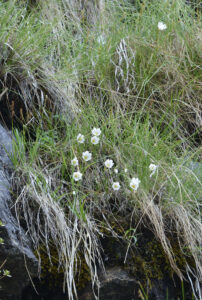
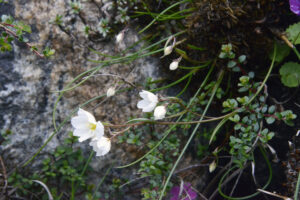
The generic name is the classical Latin name of these plants.
Stem to 30 cm tall, leaves many, linear, to 11 cm long and 8 mm wide, often reaching higher than the solitary flower, which is bell-shaped, nodding, pale purple, pale blue, purplish-red, yellow, or sometimes white, usually with deep purple dots, petals elliptic, to 3 cm long. Flowers appear June-July.
The specific name is derived from Ancient Greek nanos (‘dwarf’).
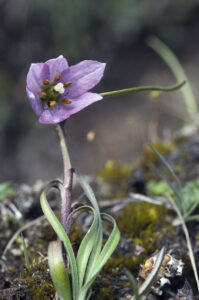
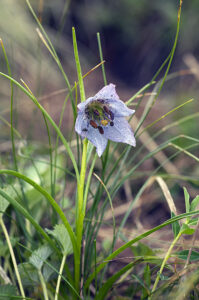
It is distributed from Uttarakhand to Myanmar, south-eastern Tibet, and the Yunnan Province, growing on open slopes, in shrubberies, and along forest margins, at elevations between 2,100 and 3,500 m.
In Nepal, bulbs are boiled and eaten, and also taken as a tonic.
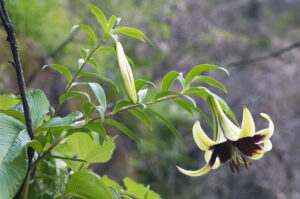


The generic name is derived from Ancient Greek nothos (‘bastard’) and leirion (‘lily’), thus a derogatory term.
Stem to 60 cm tall, smooth, basal leaves to 40 cm long and 2 cm wide, stem leaves linear, to 15 cm long and 1.7 cm wide. The inflorescence is a lax raceme with 2-6 funnel-shaped flowers, purple or blue, petals to 5 cm long, oblanceolate, tip rounded or slightly pointed. Flowering occurs June-August.
The specific name is derived from Ancient Greek makros (‘long’) and phyllon (‘leaf’), thus ‘long-leaved’.
N. thomsonianum is similar, but a larger plant with a many-flowered terminal inflorescence, distributed from Afghanistan to Uttarakhand, growing at elevations between 800 and 1,800 m.
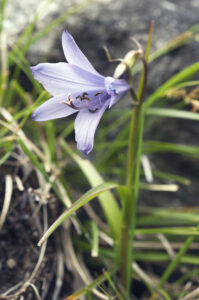
The generic name is derived from Ancient Greek streptos (‘twisted’) and pous (‘foot’), alluding to the twisted base of the stem.
Flowers are axillary, solitary, and nodding, with a stalk to 4.5 cm long, petals to 1 cm long and 4 mm wide, white or pinkish, inside with purple dots or blotches. Flowering takes place June-August. The fruit is an orange berry, to 6 mm across.
This plant is distributed from Uttarakhand and extreme southern Tibet eastwards to the Yunnan Province, growing in forests and shrubberies.
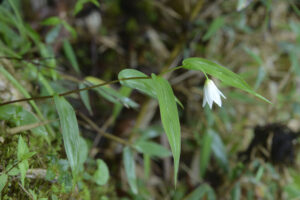
It is widespread, distributed from Pakistan eastwards to China, and thence southwards to Indochina. In the Himalaya, it is found up to elevations around 2,300 m. Habitats include forests, shrubberies, edges of terraced fields, and along trails, and it is sometimes hanging down from banks.
It is often cultivated as an ornamental, and it is much praised in Uttarakhand folklore. In Nepal, a paste of the root is applied to boils, and to the forehead in case of headache. Juice of the root is used for fever and indigestion, and juice of the root is applied to wounds and scabies. The crushed plant is applied to insect bites and thorn stabs. A yellow dye is made from the flowers.
The generic name was given in honour of Prussian-born Dutch chemist, pharmacist, and botanist Caspar Georg Carl Reinwardt (1773-1854). In the period 1816-1822, he was the head of agriculture, arts, and science in the Dutch East Indies, and during his stay he collected plants on several islands, including Java, Timor, Sulawesi, and the Moluccas. He was the founder and first director of the botanical garden at Bogor (then called Buitenzorg) on Java. He also studied amphibians and reptiles, describing two new species of snakes.
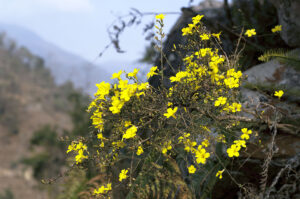
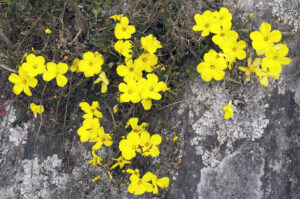
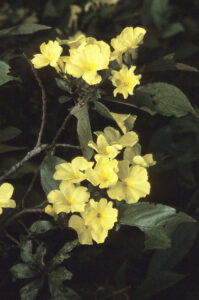
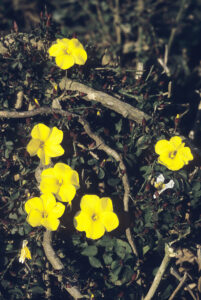
As the family name implies, many species have beautiful, often brightly coloured flowers. The fruit is a berry, rarely a drupe or capsule. The seeds are surrounded by a sticky substance, being spread by birds or in some cases by small mammals.
Many members of the family are described on the page Plants: Parasitic plants.
The generic name may be derived from the Latin scurra (‘dandy’ or ‘jester’), perhaps alluding to the brightly coloured flowers.
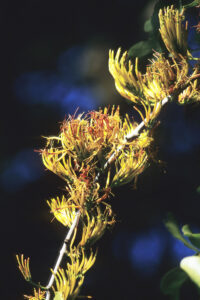
Inflorescences are axillary clusters with 6-10 flowers, corolla curved, red or orange at the base, greenish or yellowish on the upper half, to 3.5 cm long, with 4 reflexed lobes. Flowering occurs April-July. The berry is yellowish, tapering, to 8 mm long and 5 mm broad.
It is found in forests at elevations between 1,500 and 3,000 m, from Himachal Pradesh eastwards to south-eastern Tibet. It is common in Nepal.
Ripe fruits are edible and sweet, and seeds can be chewed. A gluey substance was formerly extracted from the fruits and used as birdlime.
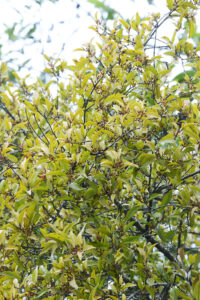
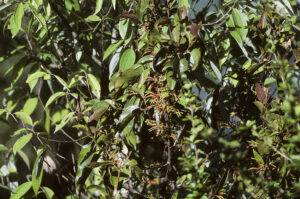
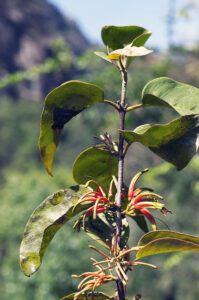
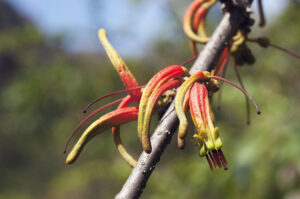
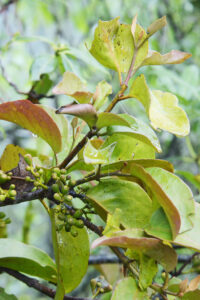
The generic name is derived from the Latin rotalis (‘wheel-like’), referring to the whorled leaves of some species.
It is distributed from Uttarakhand eastwards to Japan, China, and Taiwan, and thence southwards to Indochina. In the Himalaya, it grows up to elevations around 3,000 m.
In Nepal, young shoots are cooked as a vegetable.
The specific name is Latin, meaning ‘with round leaves’.
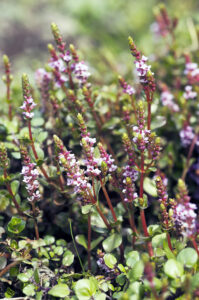
The generic name commemorates English lawyer John Alexander Woodford (lived around the 1790s), who maintained a large greenhouse in Vauxhall.
Inflorescences are short, axillary clusters with up to 15 flowers, calyx tubular, to 1.5 cm long, bright red or orange with a green base, with 6 triangular lobes, to 3 mm long, petals 6, brick-red, linear-lanceolate, to 5 mm long, with only the stamens protuding from the calyx. It flowers in spring, from February to May.
It is widely distributed, found in eastern Africa, Madagascar, and southern and eastern Asia, from Pakistan eastwards to southern China, and thence southwards to Indonesia. In the Himalaya, it may be observed up to altitudes around 2,000 m, growing in shrubberies and on open slopes.
This plant has numerous uses in Nepal. Branches are utilized as fuel. Leaves and twigs yield a yellow dye, petals a red dye. The bark is chewed to heal boils on the tongue. Juice of the bark is used for gastric problems, sprains, and swellings, boiled flowers for fever, and to curb profuse menstruation. Leaves are mixed with tobacco and smoked. The flowers are edible, and children often suck the sweet nectar out of them.
The specific name is Latin, meaning ‘shrubby’.
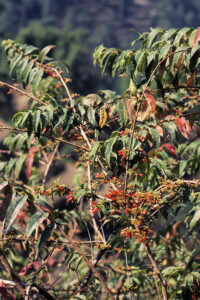
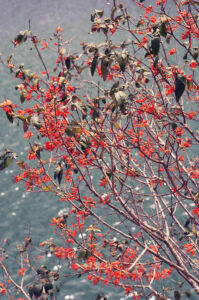
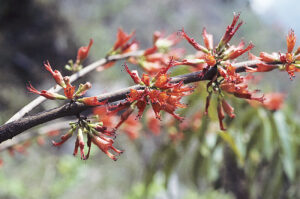
The genus was named in honour of French botanist Pierre Magnol (1638-1715), professor of botany and director of the Royal Botanical Garden of Montpellier.
In the wild, it is distributed from central Nepal eastwards to Myanmar, south-eastern Tibet, and south-western China, growing in forests and on open slopes at altitudes between 2,200 and 3,000 m. It is common in eastern Nepal and Sikkim.
It is widely cultivated as an ornamental, and the timber is used for construction.
The specific name honours British physician Archibald Campbell (1805-1874) of the Bengal Medical Service, the first superintendent of the sanatorium in Darjiling. He had a great interest in ethnology and botany, and corresponded with several British naturalists, including Joseph Dalton Hooker (see Rhododendron dalhousiae, Himalayan flora 1) and Brian Houghton Hodgson (1801-1894), who described numerous new species of birds and mammals in the Himalaya. Hooker and Campbell travelled together around Sikkim, where they were held prisoners by Tsugphud Namgyal, the local ruler. This incident led to the British annexation of the Sikkim lowlands.
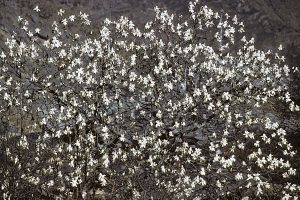
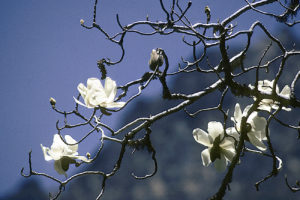
Numerous members of the subfamily Malvoideae are described on the page Plants: Mallows and allies.
The generic name is derived from Arabic ḥabb al-misk (‘pills of musk’), referring to the scented seeds.
Flowers are yellow with a purple centre, stalked, axillary, solitary, to 13 cm across. Filament tube to 2.5 cm long. Flowering takes place August-October. The capsule is ovoid-ellipsoid, to 5 cm long and 3 cm broad, densely hairy.
This species is indigenous from the Indian Subcontinent eastwards to south-eastern China, and thence southwards through Indochina, the Philippines, Indonesia, and New Guinea to Queensland. In the Himalaya, it occurs from Uttarakhand eastwards to Myanmar, growing in shrubberies and fallow fields at elevations between 600 and 2,400 m.
Elsewhere, it is cultivated as an ornamental under a variety of names, including sunset muskmallow, sunset hibiscus, and sweet hibiscus. It often escapes cultivation and is regarded as an invasive in several countries. In some places, it is grown as a source of food, and the leaves are eaten in several Pacific Islands. In Japan and Korea, paper is made from the plant.
In Nepal, juice from the root is applied to sprains, and a paste of the bark is applied to wounds. Juice of the flowers is used as a remedy for bronchitis and tooth ache. In traditional Chinese medicine, it is widely used to treat kidney problems.
The specific name is the generic name of the cassava plant (Manihot esculenta), originally from Guarani, a South American language. Presumably, the name refers to the similarity between the leaves of aibika to those of the cassava plant.

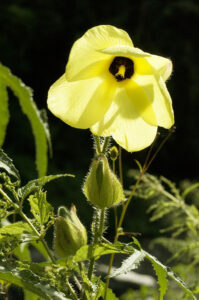
The generic name is the classical Latin word for mallow, adapted from the Ancient Greek word for the same plants, malakhe, originally from Hebrew malluah, a plant used as salad. The common name is a corruption of Old English mealwe, an adaptation of the Latin name. The word for the colour mauve was adapted from the French name of these plants.
This plant grows in open areas on disturbed ground. It is indigenous to the major part of Europe eastwards to the Ural Mountains, and from North Africa across the Arabian Peninsula to Kazakhstan and the western Himalaya. In the Himalaya, it occurs from Afghanistan eastwards to Uttarakhand, found at elevations between 1,500 and 3,600 m, growing in disturbed areas, including fallow fields.
Leaves and stalks can be cooked as a vegetable, young seeds may be eaten raw, and mature seeds can be cooked together with grains. The leaves are chewed for sore throat.
The specific name means ‘being ignored’, presumably indicating its inferiority to other, more spectacular members of the genus.
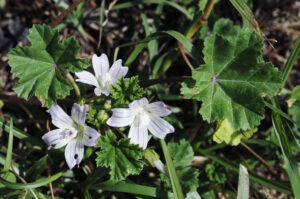
It grows in open, disturbed areas, such as fallow fields, villages, and along trails. It is native to central and southern Asia, the Arabian Peninsula, and north-eastern Africa, but is widely cultivated and has become naturalized in most other temperate and subtropical parts of the globe. In the Himalaya, it is found at elevations between 2,100 and 3,500 m, from Pakistan eastwards to Myanmar.
The plant is used for fodder, and in folk medicine, and the leaves are eaten as salad or cooked as a vegetable.
The specific name is derived from the Latin verticillus (‘in a whorl’), alluding to the flower clusters.
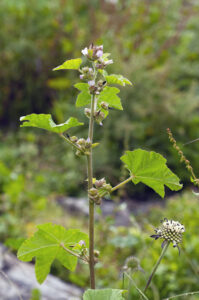
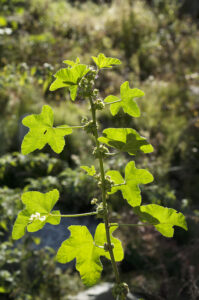
The generic name is derived from uren or uram, the local Malayalam name of U. lobata (below) in the South Indian state of Kerala.
The native area of this plant is unknown, and today it is found worldwide in tropical and subtropical areas, growing in shrubberies, open areas, and along trails. In the Himalaya, it is distributed from Pakistan eastwards to Myanmar, occurring up to elevations around 2,200 m.
In Nepal, stem fibres are used for rope and sacks. Tannin is obtained from stem and leaves. Juice of the root is used for dysentery and diarrhoea. A paste of the plant is applied to skin problems and rheumatism, a paste of the leaves to sprains and snakebites. A decoction of the seeds is used to kill intestinal worms.
The specific name refers to the lobed leaves.
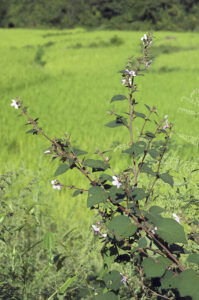

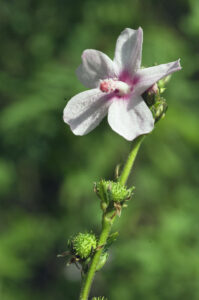
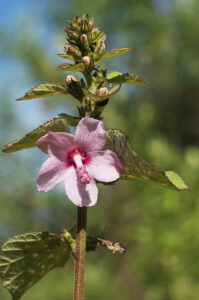
The generic name honours English apothecary and botanist John Martyn (1699-1768). During the 1720s, he introduced valerian, black currant, and peppermint into pharmaceutical practice. He was professor of botany at Cambridge University 1732-1762. He also translated works of Virgil.
A native of Mexico, Central America, and the Caribbean, widely naturalized elsewhere. In the Himalaya, it may be observed up to elevations around 1,500 m, growing in shrubberies and wastelands, and along trails.
In Nepal, juice of the plant is mixed with hot water and used to gargle in case of sore throat. Juice of the fruit is taken to curb inflammation in the stomach. It is widely used in ayurvedic medicine. In Mexico, ornaments are made from the seeds.
Both common names allude to two curved ‘horns’ on the fruit.
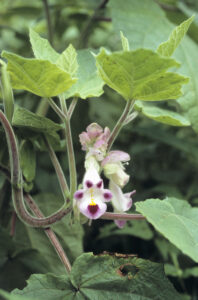
The generic name is Latin, meaning ‘lance’, thus ‘lance-shaped’. As the leaves of these plants are not lanceolate, it is not clear what the name refers to.
It is restricted to drier areas, distributed from Mongolia southwards across Tibet and western China to northern Pakistan, Ladakh, and extreme northern Nepal. In the Himalaya, it grows in grasslands and fallow fields, and along streams, at elevations between 2,000 and 4,800 m.
An extract of the plant is used as a tonic.
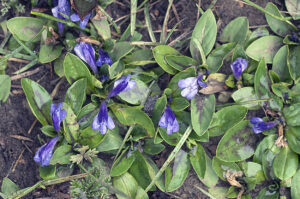
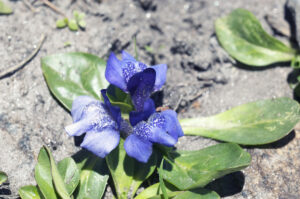
The generic name is derived from Ancient Greek mazos (‘breast’), alluding to the ridges on the lower lip of the flower.
It is found from Pakistan eastwards to Bhutan and south-western China, growing in grasslands and fallow fields at elevations between 900 and 3,300 m.
In Nepal, juice of the plant is used for acidic stomach, and also applied to wounds.
In a botanical context, the specific name means ‘rooting by runners’.
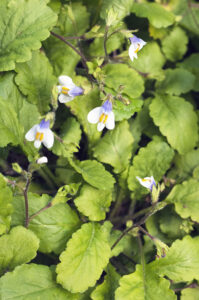
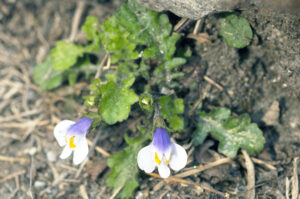
The generic name stems from herba paris, the classical Latin name of Paris quadrifolia, derived from par (‘equal’), referring to the regular leaves and petals of that species. Thus, the name has nothing to do with the person Paris from the Greek mythology.
Flower single, terminal on a short or long stalk from the centre, greenish or yellowish, surrounded by 2 whorls of segments, outer ones 4-6, leaf-like, lanceolate, to 10 cm long and 4 cm wide, inner thread-like, yellowish-greenish or purple, as long as the outer ones, straight or curled. Stamens yellow. It flowers in April-May. The fruit is berry-like, globular, to 2.5 cm across, seeds scarlet. Ripening takes place June-September.
It is distributed from Pakistan eastwards through the Himalaya and northern Indochina to central China and Taiwan. It is quite common in the Himalaya, growing in forests at elevetions between 1,800 and 3,500 m.
In Nepal, a paste of the root is applied to wounds and mosquito bites. Juice of the root is taken to expel intestinal worms. The species is threatened by excessive collecting.
The specific name is derived from Ancient Greek polys (‘many’) and phyllon (‘leaf’).
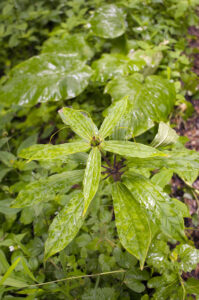
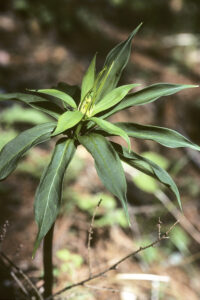
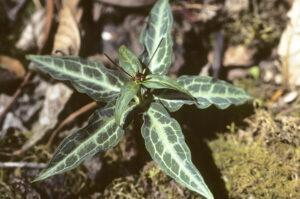
The generic name is derived from the Latin trilix (‘triple’), alluding to the number of leaves.
It is distributed from Pakistan eastwards to Bhutan and a small adjacent area in south-eastern Tibet, growing in forests at altitudes between 2,700 and 4,000 m.
The specific name was given in honour of British surgeon and botanist George Govan (1787-1865), superintendent of the Botanical Garden of Saharanpur, northern India. He often corresponded with the famous Danish botanist and physician Nathaniel Wallich (1786-1854), the foremost authority on Indian and Himalayan flora in the early 1800s (see Geranium wallichianum above).
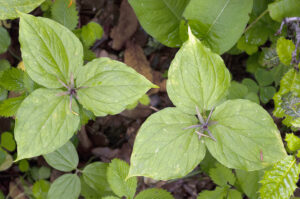
The generic name is derived from Ancient Greek melas (‘black’) and stoma (‘mouth’), referring to the fact that the seeds of some members of the genus can stain your mouth black.
Inflorescences are terminal clusters with up to 7 flowers and 2 leaf-like bracts at the base, calyx cup-shaped, to 1 cm long, striated, feathery-haired, with ovate or lanceolate lobes, hairs and lobes often falling off. Petals 5, pink or reddish-purple, obovate, to 4 cm long, margin hairy. There are two kinds of stamens, 5-7 longer, purple, bent, sometimes with 2 yellow swellings, and 5 shorter, yellow, straight. Flowering takes place between March and August. The fruit is berry-like, globular, to 1.5 cm across, ripening July-December.
It has a very wide distribution, found from India, Sri Lanka, and central Nepal eastwards to Taiwan, and thence southwards through Indochina and the Philippines to Indonesia and eastern Australia. It also occurs on some Pacific islands. In the Himalaya, it grows in shrubberies, grasslands, and open areas at elevations between 900 and 2,800 m.
The fruit is edible. In Nepal, juice of the plant is taken for cough and colds. A purple dye is obtained from the fruit.
The specific name refers to the Malabar coast of western India. Presumably, the type specimen was collected there.

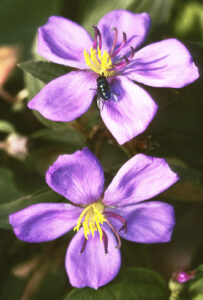
The generic name honours Swedish explorer and naturalist Pehr Osbeck (1723-1805) who was an apostle of the famous Carl Linnaeus (1707-1778). In 1750-1752, he travelled on board the Prins Carl to Asia, where he spent four months studying flora, fauna, and culture of the Canton region of southern China. Returning home, he contributed more than 600 plant species to Linnaeus’ Species Plantarum, published in 1753. In 1757, he published an account of his work in China, called Dagbok öfwer en ostindisk Resa åren 1750, 1751, 1752. Med anmärkningar uti naturkunnigheten, främmande folkslags språk, seder, hushållning, m.m. (‘Diary of a Journey to the East Indies 1750, 1751, 1752. With notes about lore on nature, languages of foreign peoples, habits, household etc.’).
Inflorescences are terminal clusters, to 10 cm long, flowers to 5 cm across, calyx-tube covered with scales, margin fringed, with 5 ovate, pointed lobes, petals 5, pink or white (rarely purple), obovate, to 2.5 cm long, margin hairy. Anthers large, bright yellow, filaments whitish, style reddish. It flowers most of the year, chiefly July-November.
As opposed to O. stellata (below), its calyx is not densely covered in hairs.
This plant is common in shrubberies, grasslands, and wastelands, and along trails, found from central Nepal, southern Tibet, and Bangladesh eastwards to eastern China, and thence southwards to the Malayan Peninsula. In the Himalaya, it grows at altitudes between 500 and 2,300 m.
In Nepal, juice of the plant is used for indigestion and typhoid, and juice of the leaves is applied to wounds. The fruit is edible.
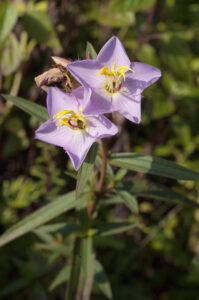
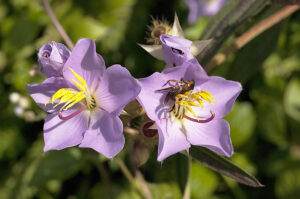
An erect or pendent shrub, to 2.5 m high, branched, hairy, stem 4-6-angled, leaves opposite or 3-whorled, oblong-lanceolate or elliptic, hairy, to 13 cm long and 5 cm broad, with 5 prominent parallel veins, margin entire, tip long-pointed.
Inflorescences are terminal clusters, to 22 cm long, flowers to 7 cm across, calyx-tube covered with stiff, matted, star-shaped hairs, with 4 erect lobes, petals 4, pinkish-purple, obovate, twisted to the right in bud, to 2 cm long, margin hairy. It flowers from July to October.
In Nepal, juice of the root is used for treatment of diarrhoea and dysentery, and juice of the plant is applied to scabies. The fruit is edible.
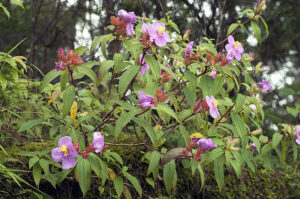
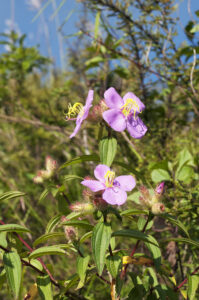
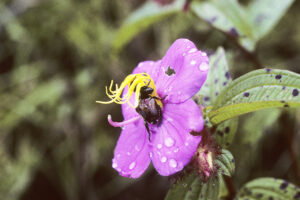
The generic name is derived from Ancient Greek sarkos (‘flesh’) and pyramis (‘pyramid’), referring to the shape of the fruit.
Inflorescences are few-flowered terminal clusters, with 2 leaf-like, ovate bracts at the base, calyx to 5 mm long, margin with numerous white, fuzzy hairs, petals 4, pink, obovate, to 7 mm long, anthers pale yellow, filaments whitish. Flowering takes place August-October.
It is distributed from central Nepal eastwards to southern China, and thence southwards through Indochina and the Philippines to Indonesia, in the Himalaya growing in forests, shrubberies, and damp places, at elevations between 1,000 and 3,200 m.
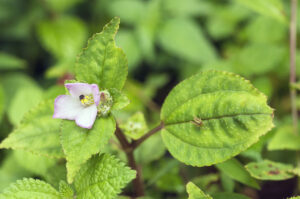
One group of fig trees are the so-called strangler figs. Most seeds of these species begin their life as an epiphyte in a tree, the seed sprouting in a crack, or often in a pile of bird dung, delivered by the bird that ate the fig fruit. (The seed is not harmed by passing through the gut of the bird.)
Over the years, aerial roots of the young strangler fig grow down to the ground, where they take root, while other roots wrap themselves around and over time completely enveloping the host tree, which is eventually strangled to death. As its trunk decays, the fig tree is left as a hollow cylinder of aerial roots.
Many of the strangler figs not only grow on trees, they also very often sprouts in cracks on buildings. If they are left in peace, their roots will destroy the building.
Fig flowers are unique, hidden inside a syconium, a globular or pear-shaped receptacle with a very small opening, during which tiny fig wasps enter, belonging to various families in the superfamily Chalcidoidea. Each of these fig wasps only enter one species of fig.
Inside the syconium, the females lay eggs in sterile female flowers, which serve as food for the larvae. At the same time, they fertilize other female flowers with pollen, which was deposited on them just inside the opening, where the male flowers are situated. Later, the receptacle swells up, forming the fig, which contains many seeds.
The generic name is the classical Latin word for fig.
Many species are described on the page Plants: Fig trees.
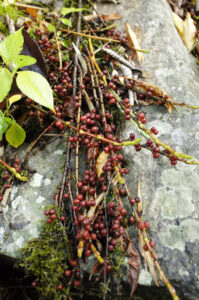
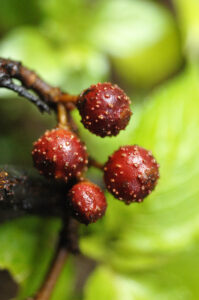
Fruits are in stalked clusters on short branchlets from the trunk or thick branches, globular or sometimes pear-shaped, 2.5-9 cm across, initially green with white dots, dark red when ripe, with 4-6 weak longitudinal ridges. Ripening occurs from March to June.
It is distributed from north-eastern Pakistan and northern India eastwards to southern China, and thence southwards through Indochina to the Malacca Peninsula, but is often cultivated elsewhere. In the Himalaya, it occurs at lower elevations, growing in forests and shrubberies, often along streams.
The fruit is edible and sweet, and is used medicinally as a diuretic and a laxative, and to regulate digestion. The foliage is cut for fodder.
Strictly speaking the specific name, derived from the Latin auricula, means ‘external ear’, but in a botanical context it mostly means ‘with two eared lobes near the base’, in this case alluding to the broadly heart-shaped leaf base. The alternative specific name is derived from Ancient Greek oligos (‘few’) and odous (‘tooth’), referring to the wide space between the teeth along the leaf margin.
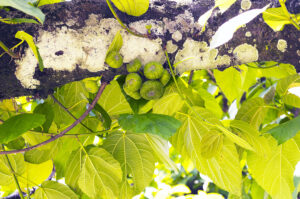
The fruit is solitary, sometimes in pairs, pear-shaped or globular, hairy, to 2.5 cm long, yellow or purple when ripe, often with 6-7 longitudinal ridges. The ripening period is long, from June to November.
It is widely distributed, found in north-eastern Africa, southern Arabia, and from Iran and Afghanistan eastwards to western Nepal. In the Himalaya, it has been observed up to elevations around 2,700 m, growing in forests, on rocky slopes, and along streams.
This species is often cultivated. Young shoots are eaten as a vegetable. The ripe fruit is edible, and also used to ease constipation. The unripe fruit is poisonous, but edible after being boiled thoroughly. The latex is used for curdling milk, and medicinally to treat warts. The foliage is lopped for fodder.
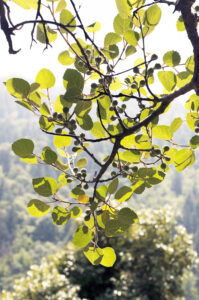
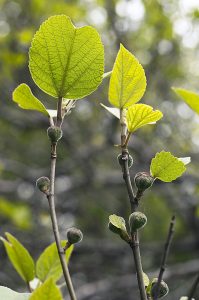
The generic name is the classical Latin word for mulberry.
Male and female flowers are on separate trees, tiny, greenish, male flowers in stalked spikes to 7 cm long, female spikes stalked, cylindric, to 1.5 cm long, style hairy. Flowering occurs from March to May. Fruits are clustered on a pendent, cylindric spike, to 2.5 cm long, the nutlets covered by the fleshy, swollen sepals, purple or reddish-purple when ripe, which is between May and August.
It is distributed from Pakistan eastwards to central Nepal and south-western Tibet, growing in forests, shrubberies, and open areas at elevations between 1,200 and 2,700 m.
Often cultivated for the edible, sweet fruit. Juice of the root is used to expel intestinal worms. The wood is utilized for furniture and farming tools, and the foliage is cut for fodder, and to feed silkworms.
The specific name is Latin, meaning ‘sawn’, alluding to the leaf margin.
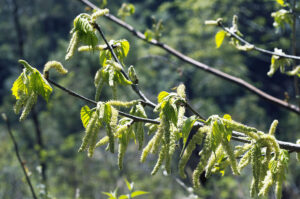
The generic name is derived from Ancient Greek myrike (‘fragrance’).
Some authorities regard a number of species as belonging to the genus Morella.
Male inflorescences are branched, erect or pendent, to 9 cm across, individual spikelets to 1 cm, glandular, stamens with red anthers. Female inflorescences erect, to 3.5 cm long, many-flowered, stalk and bracts with golden glandular hairs. Flowering occurs September-December. The fruit is an elliptic or oval drupe, reddish, succulent, somewhat resembling mulberries (Morus). Fruits ripen between March and August.
This plant grows in open forests and shrubberies, distributed from the Himalaya eastwards to China, and thence southwards through Indochina and the Philippines to Indonesia. In the Himalaya, it may be found up to altitudes around 2,500 m.
It is often cultivated due to the ripe fruits, which are delicious. They are also much valued by birds. In Nepal, the bark is used medicinally for a wide variety of ailments, as a stimulant and astringent, the juice of it applied to cuts and wounds, and to treat rheumatism, and also taken for catarrh, headache, and body pain. A decoction of the bark is applied to sprains, and taken for fever, asthma, and diarrhoea. The stem bark is chewed and kept between the teeth to treat toothache. It is also spread in streams to stupefy fish. The wood is used for poles and as fuel. The bark contains tannin and is used for dyeing, yielding a yellow dye.
It is the state fruit of Uttarakhand.
The specific name is Latin, meaning ‘edible’.
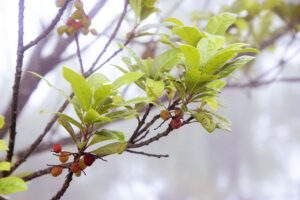
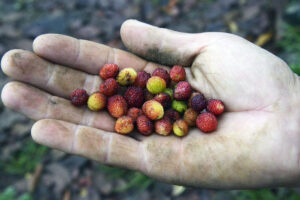
This genus has been moved around quite a lot, formerly placed in the families Liliaceae, Haemodoraceae, and Melanthiaceae.
The generic name is Ancient Greek, meaning ‘a female slave grinding corn’, alluding to the mealy texture of the sepals and petals of some species. The name colic-root refers to two American species, whose root was utilized to treat colic, whereas the name stargrass alludes to the grass-like leaves and star-shaped lobes of the corolla.
This species is found from Pakistan eastwards to south-eastern Tibet and south-western China, growing in grasslands and on open slopes at altitudes between 1,500 and 4,900 m.
In Nepal, the tuber is used for cough and colds.
The specific name is Latin, meaning ‘few-flowered’.
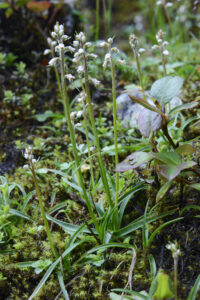
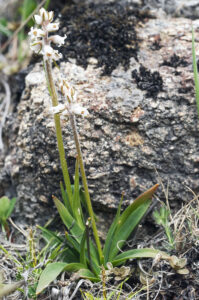
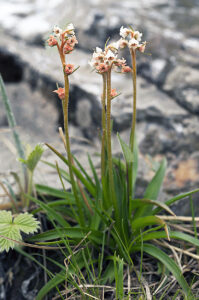
The generic name is derived from Ancient Greek peganon, the name of a kind of rue (Ruta), alluding to the rue-like foliage of these plants.
This species occurs from southern Europe eastwards to Mongolia and northern China, southwards to North Africa, Arabia, and Ladakh. In Ladakh, it grows up to elevations around 3,600 m, growing in dry sandy areas and on saline flats.
In 1928, it was introduced to the United States, when a farmer in New Mexico wanted to produce a dye named ‘Turkish red’ from its seeds, which is utilized in the Middle East to dye textiles and carpets. It soon escaped and has become an invasive plant in many areas of south-western United States.
In Tibet, the seeds are used for fever, stomach trouble, eye disorders, measles, asthma, menstrual disorders, Parkinson’s disease, and rheumatism, and also as a disinfectant, as a narcotic, called harmal, and as incense. Burning leaves can be used as an insecticide. A dye is obtained from the plant.
The specific name refers to a narcotic, harmal, extracted from the plant. The names Syrian rue and African rue refer to the similarity of its leaves to those of the common rue (Ruta graveolens).
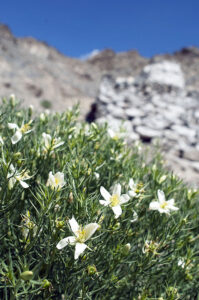
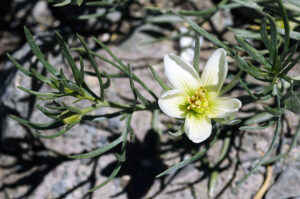
The generic name is derived from Ancient Greek nymphe (’nymph’). In Greek mythology, a water-living nymph was madly in love with the strong hero Herakles (in Latin Hercules) who, however, did not have the same feelings for her. She languished and died, and from her the beautiful waterlily arose.
Leaves are floating, dark green, often purplish below, smooth, ovate, elliptic, or rounded, to 18 cm across, margin often bent up, entire or wavy, with 11-22 veins. Flowers to 11 cm across, sepals pointed, greenish-yellow, petals 12-30, pale yellow, stamens about 50. The flowers close at night. It blooms in the summer.
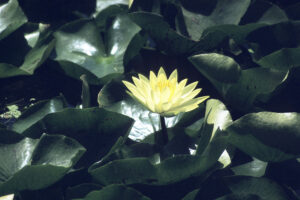
The generic name, as well as the common name in most languages, is derived from the ancient Persian name of these plants, yasmin.
Inflorescences are terminal clusters of up to 10 long-stalked flowers, calyx cup-shaped, very short, corolla yellow, funnel-shaped, often curved, to 2 cm long, with 5 rounded, spreading lobes. It blooms from April to June. The fruit is an ellipsoid or globular berry, purplish-black, to 1.1 cm long, juice crimson.
It is distributed from Iran and Afghanistan eastwards along the Himalaya to central China and northern Indochina, in the Himalaya growing in forests and shrubberies at elevations between 1,100 and 3,800 m.
In Nepal, juice of the root is applied to ringworms, and a paste of the flowers is taken for intestinal problems.
The specific name is derived from the Latin humus (‘ground’) and the suffix ilis, thus ‘close to the ground’ (= low). Some authorities place this species in the genus Chrysojasminum.
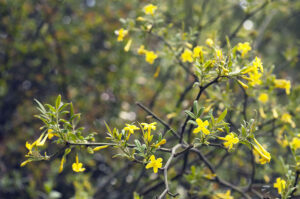
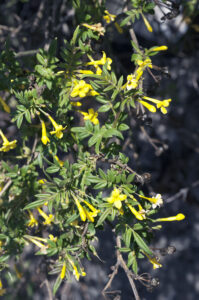

Flowers are in axillary, umbel-like clusters, calyx cup-shaped with narrow teeth, to 1 cm long, corolla white with a reddish tube, to 2 cm long, and 5 spreading lobes, to 1.2 cm long, overlapping. Flowering takes place May-July. Initially, the berry is dark red, later purple or black, globular or ellipsoid, to 1 cm long, juice crimson.
This species is probably indigenous from the Caucasus eastwards across the Himalaya to south-western China, and it has also become naturalized in southern Europe, North Africa, Florida, the West Indies, and elsewhere. In the Himalaya, it grows in forests and shrubberies at altitudes between 1,200 and 4,000 m.
From time immemorial, an essential oil from white jasmine has been used in the perfume industry, and as a medicinal plant, it has been utilized as an aphrodisiac, a sedative, an antiseptic, antidepressant, antispasmodic, and analgesic. In Ayurvedic medicine, it is utilized for fever and conjunctivitis, and to improve immunity. In traditional Chinese medicine, tea made from the flowers is used for various ailments, including wounds, heat stroke, fever, and urinary infection. This tea can also relieve stress and anxiety. A poultice of the flowers is used for headache and stroke.
Due to its wonderful fragrance, this species has been widely cultivated as an ornamental for thousands of years, giving rise to popular names like summer jasmine, poet’s jasmine, true jasmine, star jasmine, and night-blooming jasmine. In his Names of Herbes (1548), naturalist and physician William Turner (1509-1568) mentions this species as a garden plant in London.
It is the national flower of Pakistan.
Originally, the specific name was derived from officina (‘workshop’, or ‘office’), and the suffix alis, which, together with a noun, forms an adjective, thus ‘made in a workshop’. However, in a botanical context, the word denotes plants species that were sold in pharmacies due to their medicinal properties.
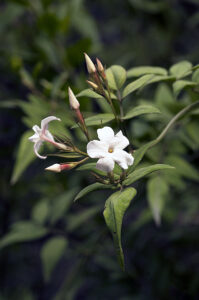
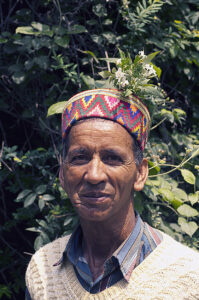
The generic name is derived from Ancient Greek elaia, the classical name of the olive tree (O. europaea). This species is presented in depth on the page Plants: Plants in folklore and poetry.
Flowers are tiny, whitish, in axillary clusters, corolla tube very short, with 4 lobes, to 2 mm long. They appear between March and September. The fruit is an ovoid drupe, to 8 mm long, black when ripe, which is between August and November.
This species is distributed from Afghanistan eastwards to western Nepal. It is very common in the lower hills of the Himalaya, found in dry open areas at elevations between 500 and 2,600 m.
The wood is very hard and heavy, used for turning and farming tools, and also as firewood. The fruit is edible, and oil is extracted from it.
The specific name is Latin, meaning ‘rust-coloured’, alluding to the underside of the leaves.
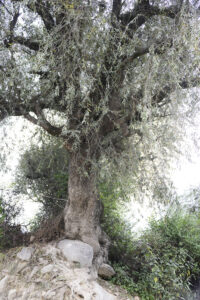
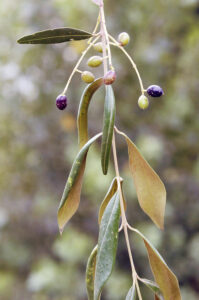
The family name is derived from Onagra, the original name of evening-primroses (today called Oenothera). The term Onagra was first used in botany in 1587, meaning ‘(food) of onager’, an Asiatic species of wild ass (Equus hemionus). It is most odd that this name was applied to evening-primroses, which were originally purely American plants.
The fruit is a long capsule, splitting longitudinally, and the seeds have long hairs, an adaptation for wind-spreading.
There is much controversy as to the name of this genus. Initially, Chamaenerion may have originated as early as 1561. It is derived from Ancient Greek khamai (‘near the ground’) and nerion, the classical Greek name of the oleander (Nerium oleander), alluding to the oleander-like leaves of rosebay willow-herb (below). In 1753, Swedish botanist Carl Linnaeus (1707-1778) placed these plants in the genus Epilobium (below). However, many botanists disregarded his decision, preferring Chamaenerion.
In 1818, French naturalist Constantine Samuel Rafinesque-Schmaltz (1783-1840) proposed the name Chamerion, suggesting it as either a subgenus or genus. Rafinesque had his own peculiar rules of botanical nomenclature, regarding it as appropriate to shorten existing generic names. His new name, however, was not widely accepted until published in 1972 by Czech botanist Josef Ludwig Holub (1930-1999), who designated a different type species, Epilobium amenum. However, as this species is now included in C. angustifolium, Chamaenerion has precedence over Chamerion. Some authorities still include these plants in Epilobium. (Source: A.N. Sennikov 2011. Chamerion or Chamaenerion (Onagraceae)? The old story in new words, Taxon 60 (5): 1485-1488)
The inflorescence is a lax, terminal, leafless raceme, to 50 cm long, flowers horizontal, sepals 4, linear, reddish-purple, to 2 cm long, petals 4, obovate, spreading, pink or magenta (rarely white), to 2.5 cm long and 1.5 cm broad. Style to 2 cm long, curved downwards, stigma deeply 4-lobed, stamens to 2 cm long, out-curved. It flowers from July to September.
This gregarious herb is very widely distributed in northern temperate and subarctic areas, southwards to Morocco, the Himalaya, northern Indochina, Korea, and northern United States. In the Himalaya, it occurs from Pakistan eastwards to Myanmar, at elevations between 3,000 and 4,700 m.
It often forms large growths, especially in open disturbed habitats, such as forest clearings and abandoned fields. An example of the latter is described on the page Nature Reserve Vorsø: Expanding wilderness.
The specific name is Latin, meaning ‘narrow-leaved’.
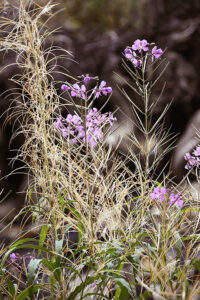
It grows on stony slopes and in sandy riverbeds, distributed from Tibet and central Nepal eastwards to central and northern China, in the Himalaya found at elevations between 3,600 and 4,800 m.
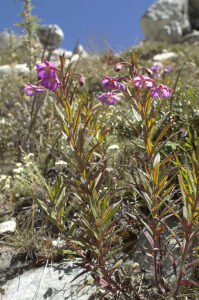
Inflorescences are leafy, flowers large, axillary, sepals 4, dark purple, to 3.5 cm long and 1.8 cm broad, petals 4, pink or rosy-purple, rarely white, to 3.2 cm long and 2.3 cm broad. It blooms June-August.
It is widely distributed in subarctic and temperate areas of the Northern Hemisphere, growing in humid open habitats, such as streamsides and marshes. In the Himalaya, it occurs from Pakistan eastwards to Bhutan, growing at altitudes between 3,600 and 5,200 m.
The specific name is Latin, meaning ‘having broad leaves’.
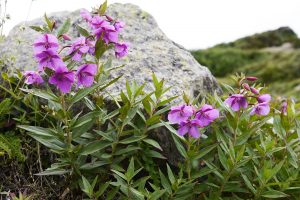

The generic name refers to Circe, in Ancient Greek Kirke, a mythical sorceress, living on the island of Aiaia. When Odysseus came to her island, she transformed his men into beasts, but, with the help of the god Hermes, he forced her to end the spell. The name of the sorceress is derived from the verb kirkoô (‘to secure with rings’), alluding to the binding power of magic. Supposedly, she used plants of this genus in her spells, reflected in the English name.
This species, in its widest sense, has a huge distribution in the Northern Hemisphere, with the exception of Africa and Arabia. Subspecies imaicola is found from Afghanistan eastwards to northern China and Taiwan, southwards to the Himalaya and northern Indochina. In the Himalaya, it grows in humid shrubberies and forests, and along streams, at elevations between 2,000 and 4,000 m.
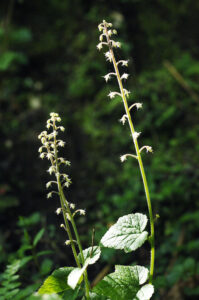
Many species are glandular-hairy. The fruit is a long capsule, splitting longitudinally, and the seeds have long hairs, an adaptation for wind-spreading.
The generic name was used as early as 1561 for E. angustifolium (today Chamaenerion angustifolium, above) by Swiss physician and naturalist Conrad Gessner (1516-1565) in his unfinished work Historia plantarum. He composed the name from Ancient Greek ion epi lobion (‘violet on a pod’), lobion literally meaning ‘fruit of the cowpea (Vigna unguiculata), alluding to the similarity of the flower colour to that of certain violets (Viola), and to its pod-like fruit.
The common name refers to the similarity of the leaves of some species to those of certain species of willow (Salix).
Members of this genus are difficult to distinguish, and they often hybridize, which further complicates the matter. Below are pictures of 3 unidentified species. I would be happy to receive information on them. You can use the address at the bottom of the page.
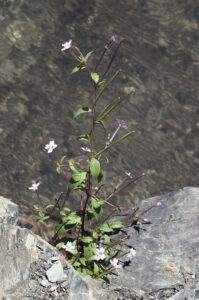

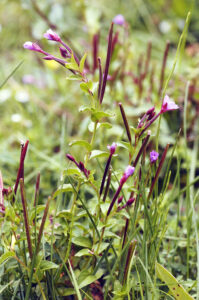
Orchids are divided into terrestrial species, growing in soil, and epiphytic species, growing on trees (sometimes on rocks or fallen tree trunks). The latter develop aerial roots that absorb nutrients and moisture from the air, and many species from both groups have pseudobulbs, swollen, fibrous, bulb-like stems that store water and nutrients.
The flower structure of this family is unique. There are 3 sepals, often coloured and shaped like 2 of the 3 petals. The third petal forms the lower lip, usually differering very much from the other petals in size and shape, and sometimes in colour, often with a spur. Stamens and ovary are fused, forming the so-called column. Anthers and stigma are separated by a beak-like structure, the rostellum. The anthers produce so-called pollinia, small ‘bags’ which contain pollen. These pollinia easily stick to visiting insects by a sticky secrete, and the insects then transport them to the next flower where they get attached to the stigma. Other species are self-pollinating. The fruit is a capsule, containing countless tiny seeds, spread by the wind.
Most of these plants live in symbiosis with the mycelium of underground fungi, which is attached to the rhizome or root of the orchid. When a seed is about to germinate, it is completely dependent on this mycelium, as it has virtually no energy reserve, obtaining the necessary carbon from the fungus. Some orchids are dependent on the mycelium their entire life, but their relationship is symbiotic, as the orchid delivers crucial water and salts to the fungus. However, some species do not contain chlorophyll, being parasites on the fungus.
The family name is derived from Ancient Greek orkhis (‘testicle’), alluding to the underground tubers of some species, which resemble testicles.
The inflorescence is a branched terminal cluster, to 20 cm long, with up to 10 flowers, opening in succession, petals and sepals white, pink, or reddish, elliptic, to 4 cm long and 1.5 cm wide, lip darker, purplish-red, to 4 cm long and 2.5 cm wide, lateral lobes incurved, embracing the column, mid-lobe about 1.6 cm across, margin wavy. Flowering takes place most of the year, chiefly June-September.
It is distributed from India eastwards to China and Taiwan, southwards to Sri Lanka and Indonesia. In the Himalaya, it is found from central Nepal eastwards to Myanmar, mainly in the lower valleys, occasionally up to elevations around 2,800 m. Habitats include forests, shrubberies, and open slopes.
All names refer to the leaves. The generic name is derived from the Latin arundo (‘reed’) and the suffix ina (‘pertaining to’), thus ‘reed-like’. The specific name is Latin, meaning ‘with grass-like leaves’.
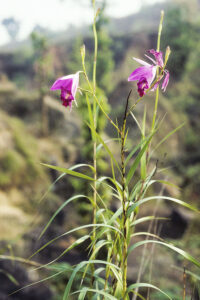
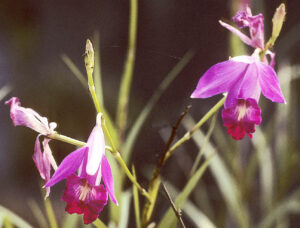
The generic name is derived from Ancient Greek kallos (‘beauty’) and anthos (‘flower’).
It is distributed from Uttarakhand eastwards to Myanmar and central China, growing in forests at elevations between 1,600 and 3,100 m.
The specific name is Latin, meaning ‘short-horned’. What it refers to is not clear.
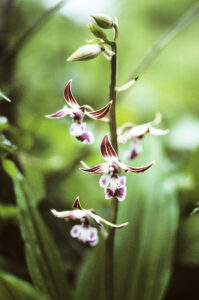
It grows in broad-leaved forests, found from Pakistan eastwards to Myanmar and south-western China, occurring at altitudes between 1,500 and 2,500 m.
The specific name is Latin, meaning ‘like Plantago’, alluding to the plantain-like leaves.
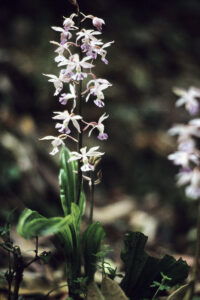
Stem to 60 cm tall, pseudobulbs globular, to 2 cm across, leaves 2-4, basal, elliptic, oblong, or lanceolate, pointed, to 35 cm long and 11 cm broad. The inflorescence is to 20 cm long, with flowers widely spaced up the stem, 2-3 cm across, sepals and petals oblong or lanceolate, to 1.8 cm long and 8 mm wide, yellow or green, lip brown or reddish, with 3 lobes, outer 2 small and short, mid-lobe to 1 cm long and 1.5 cm wide, base white or yellow with brown or reddish blotches, outer part brown or purplish-red with 3 fleshy ridges, often yellow, margin strongly wavy. Spur absent. It blooms from April to July.
The specific name is derived from the Latin tri (‘three’) and carina (‘keel’), referring to the 3 ridges on the lip.
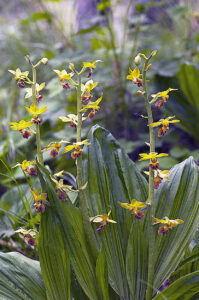
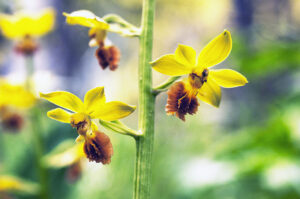
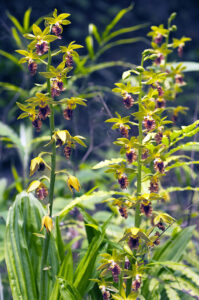
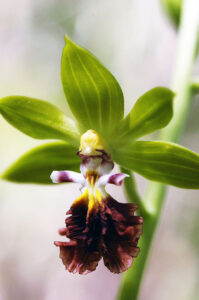
The generic name is derived from Ancient Greek kephale (‘head’) and antheros (‘anther’), alluding to the anther that sits on the column like a head. The common name is Old English, denoting various plants supposed to cure madness, derived from Ancient Greek helleboros, of unknown meaning.
Stem to 60 cm high, leafy throughout, leaves elliptic or lanceolate, often sword-shaped, in 2 distinct ranks, spreading, lower ones to 16 cm long and 3 cm wide, upper ones very short.
Flowers white, 2-3 cm across, 10-20 in a terminal cluster to 6 cm long. Sepals elliptic or lanceolate, pointed, to 1.8 cm long and 4.5 mm wide, petals rounded, to 8 mm long and 4 mm wide. Lip small, to 7 mm long and 9 mm wide, almost hidden among the sepals, with an orange patch in the centre. The flowering period is long, from May to August.
The specific name is Latin, meaning ‘long-leaved’.
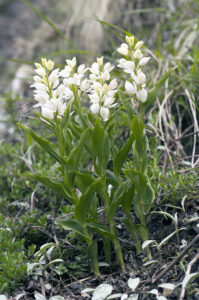
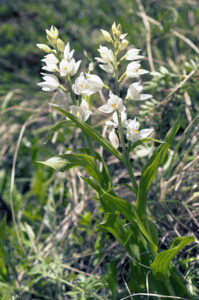
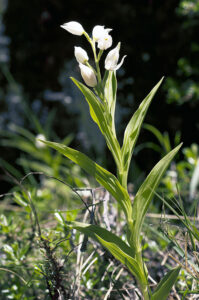
Members of this genus, comprising about 12 species, are very common in subtropical and lower temperate regions of the Himalaya, the majority flowering between March and May. Most species have white flowers with yellow blotches on the mid-lobe of the lip.
The generic name is derived from Ancient Greek koilos (‘hollow’) and gyne (‘woman’), referring to the hollow pistil.
It is distributed from central Nepal eastwards to Myanmar and south-western China, growing on trees and rocks at altitudes between 1,300 and 3,500 m.
In Nepal, a paste of the pseudobulb is applied to the forehead to relieve headache.
The specific name is derived from the Latin corymbus, meaning a cluster of fruit or flowers.
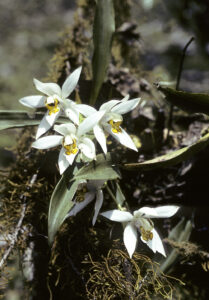
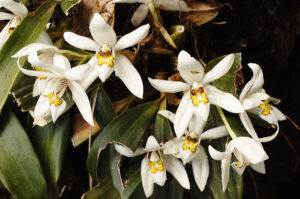
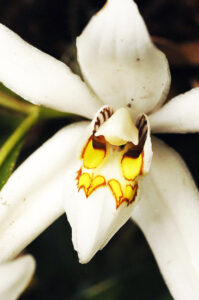
Pseudobulbs are 5-8 cm long, yellowish, ovoid, smooth. Leaves stalkless, lanceolate, pointed, to 30 cm long and 3 cm broad. Flowers white, fragrant, to 10 cm across, 3-10 in pendent clusters, to 30 cm long. Sepals and petals blunt, to 4 cm long and 1.5 cm wide, margin wavy, mid-lobe of lip with 3-5 yellow, hairy ridges, stretching to the base. It flowers in spring, from February to April.
It is cultivated as an ornamental. In Nepal, juice of the pseudobulb is applied to boils.
The specific name is Latin, meaning ‘crested’, alluding to the ridges on the lip.

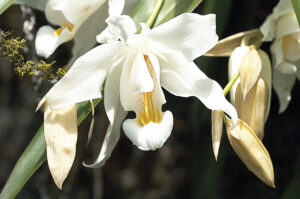
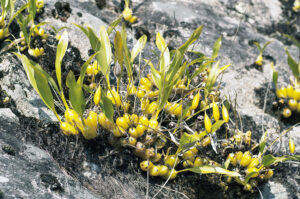
Pseudobulbs are 7-10 cm long, yellowish, cylindric, furrowed with age. Leaves 2-3, stalkless, elliptic to oblanceolate, to 25 cm long and 3 cm broad. Flowers white, c. 4 cm across, 6-8 in erect clusters, to 20 cm tall. Sepals and petals to 2 cm long and 5 mm wide, pointed, margin not wavy, mid-lobe of lip with 2 large yellow spots and 2 yellow ridges (not hairy), stretching to the base. Flowering occurs between March and June.
It is cultivated as an ornamental. In Nepal, juice of the pseudobulb is used for stomach ache.
The specific name is derived from the Latin niteo (‘to shine’) and the suffix idus, thus ‘shining’. However, the word has many other meanings, including ‘handsome’ and ‘beautiful’.
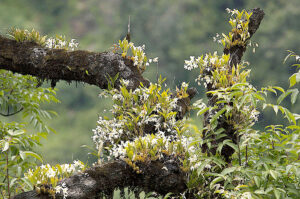
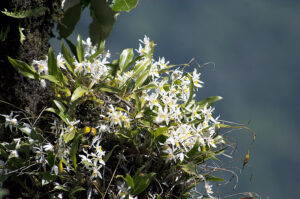
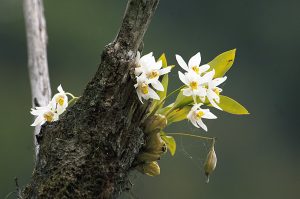
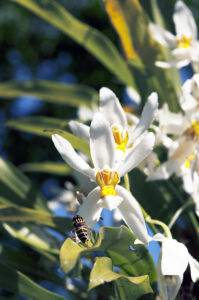
The lip is large, bag-shaped, slipper-like, hence the English name. These flowers are pollinated by insects, which are lured to the flower by fragrance. An insect enters the flower through a narrow gap on the upper side of the lip, but cannot escape out the same way, as the sides of the opening are very slippery. However, at the base of the lip are two small openings, and when the insect escapes out this way, it passes close to the stigma, where pollen from the insect’s visit to another flower is scraped off, after which the insect passes the anthers, where pollen is stuck on its back, and in this way brought to the next flower.
The generic name is derived from Ancient Greek Κypris, another name of the goddess Aphrodite, and pedilon (‘sandal’), naturally alluding to the flower shape.
It is distributed from Pakistan eastwards to Bhutan and south-eastern Tibet, growing in forests and shrubberies, and on open slopes, at elevations between 2,100 and 4,000 m.
It is cultivated as an ornamental. In Nepal, young leaves are cooked as a vegetable.
The plant is threatened by excessive collecting.
The specific name is Latin, meaning ‘carrying a heart’. It is not clear what it refers to.
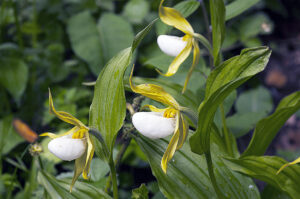
This plant is distributed from Himachal Pradesh eastwards to Arunachal Pradesh and south-eastern Tibet, found at elevations between 3,000 and 4,300 m. Habitats include forests, shrubberies, and open areas.
It is cultivated as an ornamental and is threatened by excessive collecting.
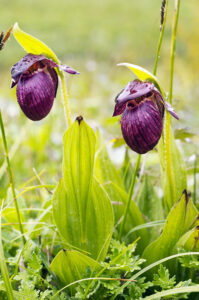
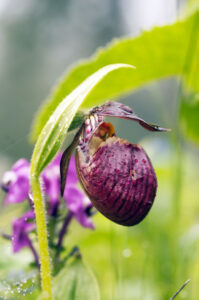
The genus is widely distributed in subarctic and temperate areas of the Northern Hemisphere. 2 species occur in the Himalaya.
The generic name is derived from Ancient Greek daktylos (‘finger’) and rhiza (‘root’), alluding to the divided, finger-like tubers of the genus.
A stout plant, to 90 cm tall, leaves 3-6 up the stem, lanceolate or elliptic, pointed, to 30 cm long and 5 cm broad. Flowers are arranged in a dense, cylindric, terminal spike, lower bracts much longer than flowers, upper ones shorter. Flowers reddish-purple (rarely white), to 2 cm long, with a curved spur. Sepals and petals almost equal, 3 forming a hood, 2 outer ones spreading, to 1 cm long. Lip broad, rounded, 3-lobed, to 1.3 cm across, centre pale with dark spots and stripes. It blooms June-July.
The root is highly nutritious, and tender parts are eaten as a vegetable.
In Nepal, the root is used for soothing the mucous membranes, reducing mucus in lungs, stopping bleeding of wounds, and as a remedy for stomach disorders. In Ayurvedic medicine, juice from the root is used as a tonic, and for treating inflammation of gum and teeth. It is also highly valued as an aphrodisiac. Traditionally, it has been used for treating bone fractures.
The species is protected by law, but is nevertheless severely threatened due to overcollecting. In 2015, the price of the dried root was about 100 US$ per kg in Nepal.
The specific name is Sanskrit, meaning ‘looking like a hand’, referring to the tubers.
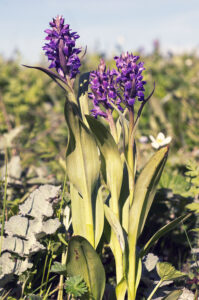
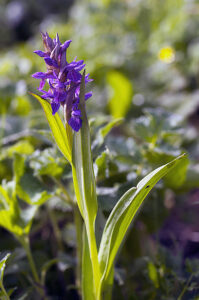
The generic name is derived from Ancient Greek dendron (‘tree’) and bios (‘life’), alluding to the members being epiphytes.
It is distributed from Uttarakhand eastwards to Myanmar, and also in the hills of Assam and Bangladesh. In the Himalaya, it grows on trees in forests, found at elevations between 1,000 and 2,000 m.
The specific name is Latin, meaning ‘charming’, ‘lovely’, or ‘delightful’.
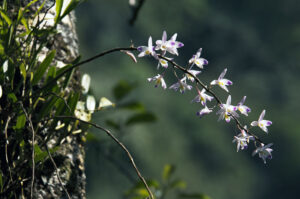
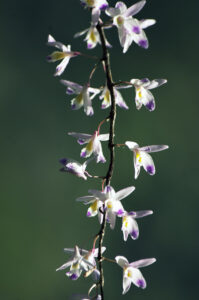
Stems pendent, cylindric, to 2 m long, with many oblong or lanceolate, pointed leaves, sprouting from the nodes, to 20 cm long and 4.5 cm broad. Inflorescences sprout from nodes, each with 2-6 golden-yellow flowers, the funnel-shaped lip with 2 large, chestnut blotches. Sepals elliptic, to 2 cm long and 1 cm wide, petals broadly obovate, to 2.2 cm long and 1.5 cm wide. It blooms from April to November.
The specific name is Latin, meaning ‘having golden flowers’.
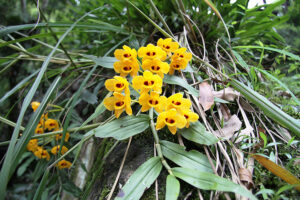
This pretty plant is distributed from central Nepal eastwards to northern Indochina and southern China, in the Himalaya found on trees, rocks, and banks at altitudes between 600 and 2,000 m.
It is cultivated as an ornamental. In Nepal, the pseudobulbs are used for boils and pimples. Girls of the Rai people make garlands of the flowers to decorate their hair.
It is threatened by excessive collecting.
The specific name is Latin, meaning ‘dense-flowered’.
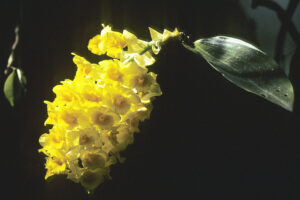
Stems stout, erect or pendent, cylindric, to 60 cm long. Leaves oblong, to 11 cm long and 3 cm wide, leathery, tip blunt. Inflorescences sprout from the nodes, with 1-4 flowers, to 7.5 cm across, fragrant, petals and sepals white or purplish at the base and purple at the tip, sepals oblong, petals broadly ovate, to 3.5 cm long and 1.5 cm wide, lip broadly ovate, to 3.5 cm across, white with violet tip and dark purple mouth, side-lobes inrolled, forming a funnel. Flowering occurs April-May.
It is cultivated as an ornamental. Medicinally, it is used for stomach ache and thirst disorder.
The specific name is Latin, meaning ‘noble’.
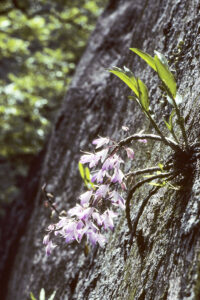
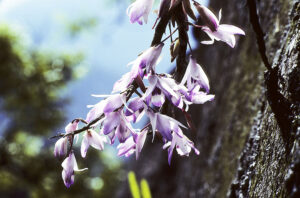
It occurs from Nepal eastwards to northern Indochina and the Yunnan Province, growing on trees in forests, in the Himalaya found up to altitudes around 1,800 m.
The specific name is derived from Ancient Greek polys (‘many’) and anthos (‘flower’).
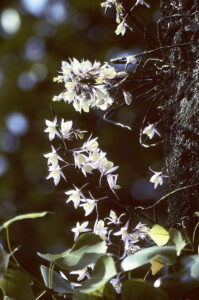
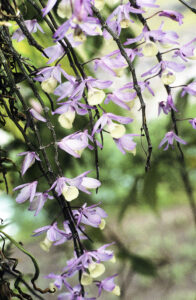
The generic name is derived from epipaktos, the classical Greek name of these plants, from epipaktóo (‘to shut close’, i.e. ‘to end’), and the suffix is, alluding to their healing properties. The common name is Old English, denoting various plants supposed to cure madness, derived from Ancient Greek helleboros, of unknown origin.
This species is widely distributed, found in Somalia and Ethiopia, the Middle East, the Caucasus, and from Afghanistan eastwards along the Himalaya to south-western China. In the Himalaya, it grows in humid forests and along streams, at elevations between 500 and 3,400 m.
The specific name is Latin, meaning ‘with leaves like Veratrum’ (false hellebore).
The widespread broad-leaved helleborine (E. helleborine) has larger, elliptic leaves, flowers are mostly dull-greenish. In the Himalaya, it grows in drier areas, from Pakistan eastwards to Myanmar, at altitudes between 2,000 and 4,000 m.
The specific name is Latin, meaning ‘with leaves like Veratrum’ (false hellebore).
Broad-leaved helleborine (E. helleborine) has larger, elliptic leaves, flowers are mostly dull-greenish. It grows in drier areas, from Pakistan eastwards to Myanmar, at altitudes between 2,000 and 4,000 m.
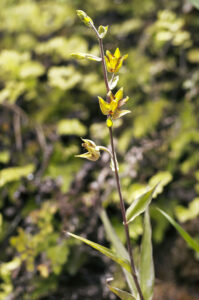

John Goodyer (1592-1664) was a keen English botanist who gathered a large collection of botanical texts, which were later given to Magdalen College, Oxford. He also translated a number of classical texts into English.
The exact meaning of the name lady’s tresses has been lost, but it may refer to the spiralled inflorescence resembling a maiden’s braided hair. The name rattlesnake-plantain alludes to the broad, rounded leaves of some members of the genus, which resemble those of some species of plantain (Plantago), others having chequered leaves resembling a rattlesnake’s markings.
It has a creeping rhizome with many nodes and a few hairy roots. The flowering stem is ascending, slender, to 20 cm tall, glandular-hairy, basal leaves 4-6, elliptic or ovate, short-stalked, dark green with conspicuous pale veins, to 3 cm long and 1.5 cm broad, tip pointed. Leaves get gradually smaller and bract-like up the stem.
The inflorescence is a dense, spiralled spike with up to 20 small flowers, to 6 mm across, only partly opening, white, greenish-white, or brownish-white, sepals and petals to 4 mm long and 2 mm wide, sepals glandular-hairy, the upper one forming a hood with the petals. Lip ovate, to 3.5 mm long and 2.5 mm wide. Flowering occurs July-October.
The specific name is Latin, meaning ‘creeping’.
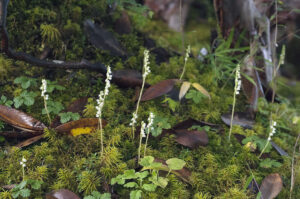

The generic name is derived from Ancient Greek gymnos (‘naked’) and aden (‘gland’), referring to the nectar-secreting spur.
It is distributed from Pakistan eastwards to Myanmar and central China, in the Himalaya found at altitudes between 2,400 and 4,800 m. Habitats include grasslands, forests, and rocky areas.
In Nepal, the powdered pseudobulb is applied to wounds, and a decoction of it is taken for stomach trouble.
The specific name is derived from Ancient Greek orkhis (‘testicle’), usually alluding to members of the genus Orchis, which have testicle-shaped tubers. The connection to this species is not clear.

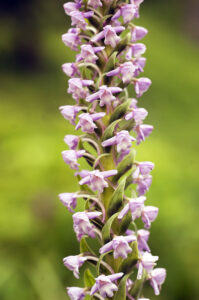
The generic name is derived from the Latin habena (‘strap’ or ‘rein’), alluding to the strap-shaped mid-lobe of the lip.
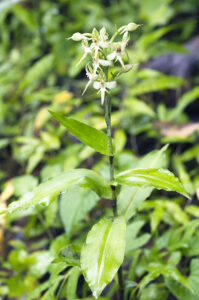
This species is distributed from Himachal Pradesh eastwards to south-eastern Tibet and the Khasi Hills in Meghalaya, growing in grasslands at altitudes between 1,500 and 3,000 m.
The specific name is derived from the Latin aries (‘ram’) and the suffix inus, thus ‘ram-like’, perhaps alluding to the upright sepal and petals, which, with a bit of imagination, resemble the tip of a ram’s horn.
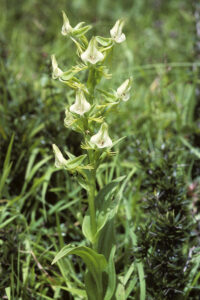
The etymology of the generic name is obscure. The common name refers to the musk-scented flowers of H. monorchis, which is widespread in Eurasia.
Stem slender, usually below 50 cm tall, but occasionally to 80 cm, with 2-4 widely spaced leaves, linear, pointed, to 20 cm long and 1.5 cm broad. The inflorescence is a narrow, terminal spike, to 45 cm long, flowers very small, green or yellowish-green, to 6 mm across, with linear-lanceolate, pointed bracts, longer than the ovary. Upper sepal elliptic to oblong, with the linear petals forming a hood, to 4 mm long, lateral sepals spreading. Lip to 1 cm long, with 2 narrow, curved lobes and an incurved tooth-like lobe between them. Spur absent. It blooms June-September.
The specific name refers to the lance-shaped leaves.
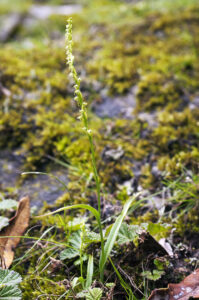
Flowers of this genus are inverted, the lip pointing upwards.
The generic name is derived from Ancient Greek malassein (‘to soften’), referring to the tender texture of the leaves.
It occurs from Pakistan eastwards to Bhutan, growing in forests, shrubberies, and grasslands at elevations between 2,100 and 4,100 m.
The specific name is derived from the Latin musca (‘a fly’) and fera (‘to bear’), thus ‘bearing flies’, alluding to the flowers.
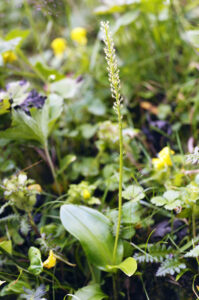
The generic name is derived from Ancient Greek oros (‘mountain’) and orchis (‘orchid’).
This species is found from Himachal Pradesh eastwards to China, Taiwan, and Japan. In the Himalaya, it grows at elevations between 2,500 and 4,500 m. Habitats include forests, shrubberies, and grasslands.
The specific name is Latin, meaning ‘with many leaves’, which is most odd, considering that the plant has only one leaf.
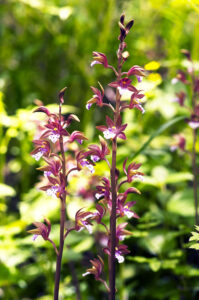
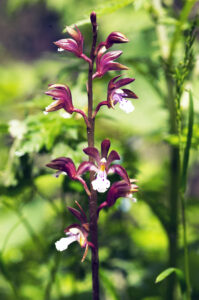
This plant is distributed from Nepal eastwards to Myanmar and south-eastern Tibet, growing in forests at elevations between 1,500 and 3,000 m. It is also reported from Taiwan. However, I find it strange that plants so far apart should be the same species.
The generic name is Ancient Greek, meaning ‘small-flowered’.
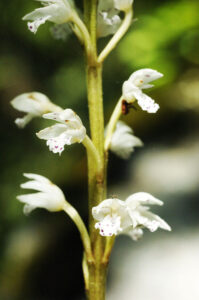
The spur of these plants is usually very long and slender.
The generic name is derived from Ancient Greek platys (‘flat’) and antheros (‘anther’). The English name alludes to the flowers.
It occurs from Uttarakhand eastwards to Arunachal Pradesh and south-eastern Tibet, growing in grasslands and on open slopes at elevations between 2,200 and 3,100 m.
The specific name is Latin, meaning ‘curved’, alluding to the spur.
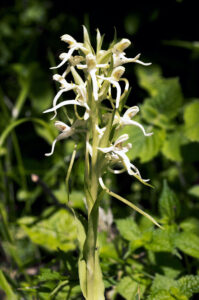
These plants often grow on moss-covered tree trunks, including toppled ones.
The generic name refers to Pleione, in Greek mythology a nymph living in the ocean, mother of the Pleiades.
This pretty plant is distributed from central Nepal eastwards to Myanmar and south-western China, growing on trees, fallen trunks, and moss-covered rocks, at elevations between 1,600 and 4,000 m. It is common in Langtang National Park, central Nepal.
The specific name was given in honour of British botanist Joseph Dalton Hooker (1817-1911), who described numerous new plant species in the eastern Himalaya (see Rhododendron dalhousiae, Himalayan flora 1).
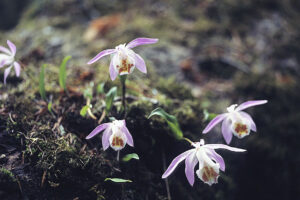
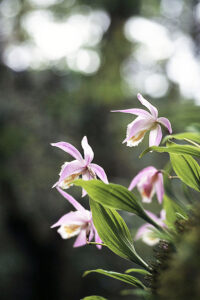
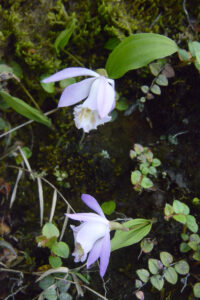
It grows on trees and fallen trunks at altitudes between 1,800 and 3,200 m, distributed from central Nepal eastwards to Myanmar and south-eastern Tibet.
In Nepal, a paste of the pseudobulb is applied to wounds.
The specific name is Latin, meaning ‘low’ or ‘small’.
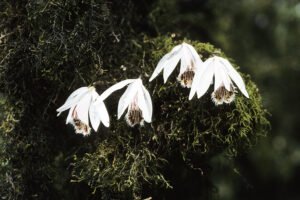
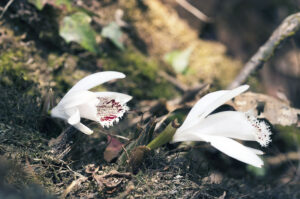
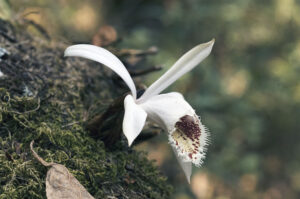
There are 2 spurs on each flower.
The generic name refers to the satyrs of Greek mythology, half-human, half-animal, with the upper parts resembling a human, the lower parts a horse or a goat. They also had goat-like horns, and the name alludes to the horn-like appendages that arise from the lip of these plants.
Stem robust, to 80 cm tall, leaves 2-4, lower ones lanceolate to elliptic, pointed, to 25 cm long and 8 cm broad, upper ones much smaller and narrower. The inflorescence is a dense spike, to 15 cm long, flowers pink, whitish, or pale purple, fragrant, to 1.3 cm across, bract much longer than flower, purplish. Sepals and petals oblong or elliptic, to 6 mm long. The lip is inverted, pointing upwards, forming a hood to 9 mm long and 1 cm broad, with 2 tiny, horn-shaped appendages and 2 slender, down-pointing spurs, to 1.5 cm long. Flowering occurs July-November.
In Nepal, the pseudobulbs are cooked and eaten, and certain tribes cook tender parts as a vegetable.
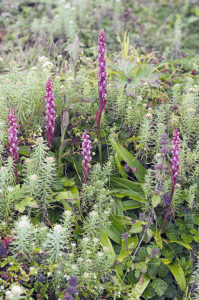
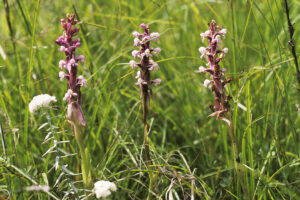
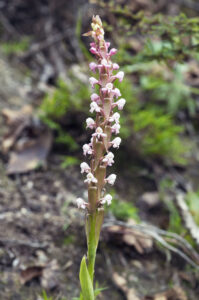
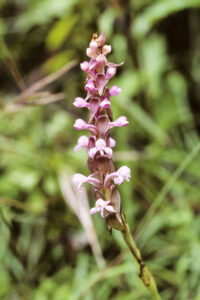
The generic name is derived from Ancient Greek spathe (‘blade’) and glotta (‘tongue’), alluding to the large lip of these plants.
It grows on rocks and forest banks at elevations between 1,500 and 3,500 m, distributed from central Nepal eastwards to Arunachal Pradesh and south-eastern Tibet.
The specific name means ‘Ixia-like’, referring to the resemblance of this species to members of the genus Ixia, of the Iris family (Iridaceae).
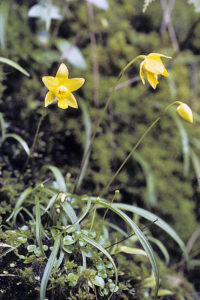
The generic name is derived from Ancient Greek speira (‘spiral’) and anthos (‘flower’), alluding to the inflorescence. The exact meaning of the name ladies’ tresses has been lost, but it may allude to the spiralled inflorescence resembling a maiden’s braided hair.
This species is widely distributed, from Siberia and Mongolia southwards to Afghanistan, the Himalaya, Indochina, Malaysia, the Philippines, Indonesia, New Guinea, Australia, and New Zealand. In the Himalaya, it grows in open areas, shrubberies, and grasslands up to elevations around 4,600 m.
The specific name is Latin, meaning ‘found in China’.
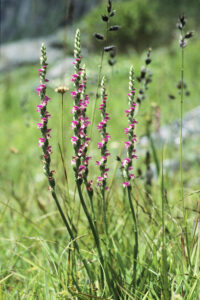
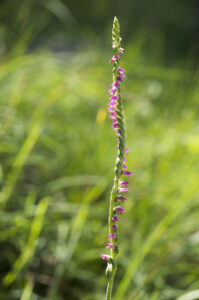
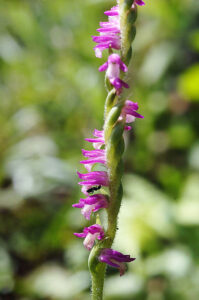
Many genera in the family are hemiparasites, i.e. they contain chlorophyll, making them able to partly sustain themselves. These hemiparasites were formerly included in the figwort family (Scrophulariaceae), but, following extensive DNA research, they have been moved to the broomrape family.
The family name is derived from Ancient Greek orobos (‘bean’) and ankhein (‘to strangle’), alluding to the bean broomrape (Orobanche crenata), which is a common parasite on the fava bean (Vicia faba). It is described on the page Plants: Parasitic plants, together with many other parasites.
The generic name honours Paulus Aegineta (c. 625-690), in English Paul of Aegina, a Byzantine, Greek-born physician, who wrote a medical encyclopedia in 7 volumes.
Flowers are usually solitary, stalked, calyx to 4 cm long, pointed, yellowish or reddish with brown streaks, encircling the base of the corolla, which is purplish-red or violet, faintly dotted or streaked, tubular or bell-shaped, to 5 cm long and 2 cm wide, slightly curved. Anthers and stigma are yellow. Flowering takes place July-October.
It is widely distributed, found from the Indian state of Uttarakhand eastwards to Korea and Japan, southwards to Sri Lanka, Indonesia, and New Guinea. In the Himalaya, it may be found up to elevations around 1,800 m, growing in forests and shrubberies, and on open slopes.
In Nepal, root and flowers are used for treating infections and skin problems, in China for clearing away heat and toxins.
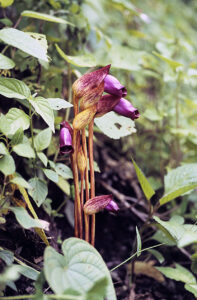
These plants are often parasites on grasses, but also contain chlorophyll. The leaves are opposite, increasing in size upward, inflorescence a terminal spike or raceme, bracts larger than leaves, opposite, palmately veined, margin toothed. Calyx tubular or bell-shaped, 4-lobed, corolla tubular, often white with a yellow centre, 2-lipped, upper lip short, 2 reflexed, lower lip 3-lobed, lobes spreading.
In Nepal, juice of the root of E. himalayica is applied to boils, and a paste of the plant is given to curb profuse menstruation.
A notoriously difficult genus with about 15 species in the Himalaya, all very similar. Below are pictures of 3 unidentified species. If you are able to identify any of them, I should be happy to hear about it. You can use the address at the bottom of the page.
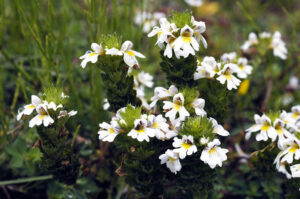
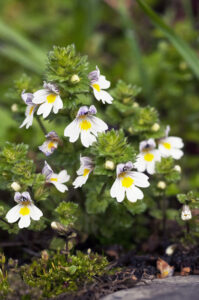
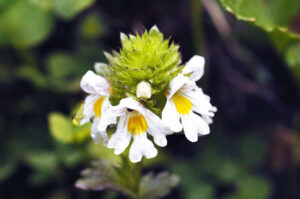
The genus was named in honour of German lawyer Johann Bernhard Wilhelm Lindenberg (1781-1851), a renowned bryologist.
Inflorescences are axillary, lax, to 25 cm long, corolla golden-yellow, to 3 cm long, tubular, 2-lipped, upper lip 2-lobed, erect, lower lip with 3 broadly ovate, overlapping lobes, to 2.5 cm across, and 2 large, red-dotted swellings near the hairy throat. It flowers in winter and spring, between December and April.
This plant is found from Uttarakhand eastwards to Myanmar and south-eastern Tibet, growing in shrubberies and on banks at altitudes between 700 and 2,400 m.
In Nepal, juice of the leaves is applied to wounds and boils.
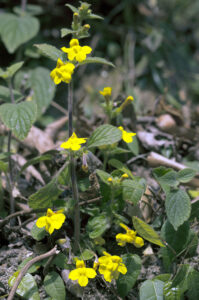
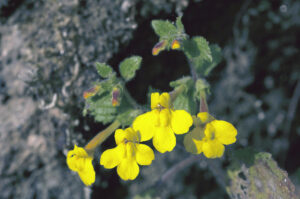
The corolla of these plants is 2-lipped, the upper lip compressed sideways, forming a helmet-like structure, or elongated into teeth or a beak, whereas the lower lip is usually broad, lobed, flat or curved.
The generic name is derived from the Latin pediculus (‘louse’). According to an old superstition, louseworts could transfer lice to people and cattle, or, according to another belief, the exact opposite was the case, namely that they were able to rid people and cattle of lice! In Denmark, a decoction of these plants was used to expel lice from clothes.
If you shake a lousewort capsule that contains ripe seeds, you may hear a rattling sound from the seeds, which has given rise to the popular name rattle of these plants.
Usually, animals do not graze on louseworts, as they contain poisonous glycosides. Nevertheless, in former times, children at various places in Great Britain would suck out the nectar of the flowers. In Donegal, the plant was known as honey-cap or honey-cup, and in Shetland as bee-sookies or hinney-flo’er.
A couple of pictures, depicting unidentified louseworts, are presented below. I would be happy to receive information on them. You can use the address at the bottom of the page.
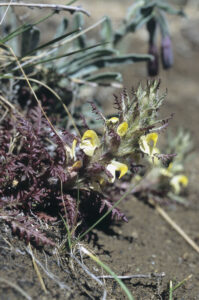
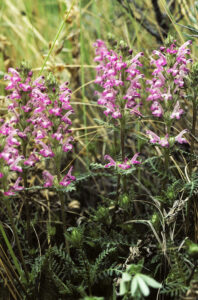
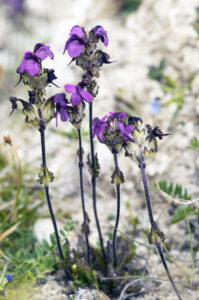
The inflorescence is terminal, to 10 cm long, flowers pale or warm yellow, to 2 cm across, tube to 3 cm long, petals rolled up like a ball, calyx inflated, green or reddish, hairy. Flowering occurs July-August.
The beak, which is usually hidden under the rounded petals, is bifid, which gave rise to the specific name, derived from the Latin bi (‘having two parts’) and cornu (‘horn’).
This plant is restricted to humid areas in dry country, distributed from Afghanistan eastwards to Uttarakhand, found at altitudes between 2,700 and 4,400 m. It is common in Kashmir, Ladakh, and Himachal Pradesh.
In Tibetan folk medicine, it is used as a cooling agent, and for liver disorders and alcohol problems, the flowers for treatment of vaginal and seminal discharges. Tender leaves are cooked as a potherb.
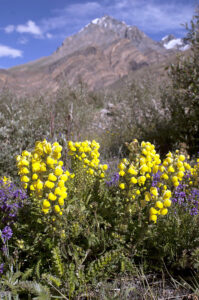
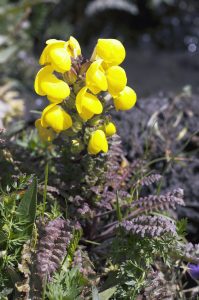
Inflorescences are terminal on upper branches, bracts leaf-like, calyx to 7 mm long, slightly inflated, hairy, with 5 lobes, corolla to 1.5 cm long, tube slightly longer than calyx, petals pink, beak of the upper lip very distinct, purple and white, straight, to 6 mm long, lower lip very variable in shape, rounded or lobed. It blooms August-September.
This plant grows in grassy areas and shrubberies, and on open slopes at elevations between 2,000 and 4,300 m, from Afghanistan and Pakistan eastwards to south-western China.
The specific name is Latin, meaning ‘slender’, perhaps alluding to the rather slender stems.
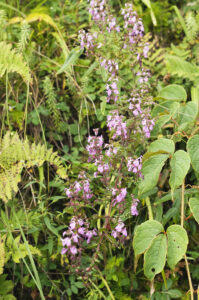
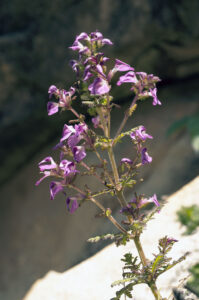
Stem to 60 cm tall, but often much less. Lower leaves stalked, to 15 cm long, upper sessile, much smaller, narrow-elliptic, deeply lobed and toothed. Flowers are arranged in a terminal cluster, corolla yellow, pale yellow, or occasionally cream-coloured, with a distinctive slender tube, to 5 cm long, much longer than the calyx, which is to 2 cm long, inflated, papery, with toothed lobes. The petals form a bell-shaped, nodding hood, upper and lower lip similar, rounded, encircling the long, slender beak, which is curved in a circle, lateral lobes small, triangular. Flowering occurs June-August.
It somewhat resembles P. bicornuta (above), but the flowers are not ball-shaped, and it grows in much wetter places.
The specific name was given in honour of German physician and botanist Werner Friedrich Hoffmeister (1819-1845), who accompanied his friend, Prince Friedrich Wilhelm Waldemar of Prussia (1817-1849), as a personal physician on an expedition to India 1845-46. He was killed in Punjab in a skirmish with Sikhs. Hoffmeister collected numerous plants during the expedition, many of which were new to science. His material was published in 1853, titled Die Botanischen Ergebnisse der Reise seiner königl. Hoheit des Prinzen Waldemar von Preussen in den Jahren 1845 und 1846 (‘Botanical results of the travels of His Royal Highness Prince Waldemar von Preussen in the years 1845 and 1846’).
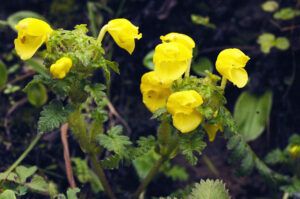
It is usually below 10 cm high, but may sometimes grow to 18 cm. Basal leaves form a rosette, leaf-stalk to 2 cm long, blade to 3 cm long, lanceolate to narrowly oblong, pinnately divided, lobes toothed, to 5 mm long. Stem leaves smaller.
Flowers are in terminal clusters, golden-yellow, often with maroon streaks on the lower lip, tube very long and slender, to 5 cm, hairy, upper lip ending in a curled beak, to 6 mm long. The flowering period is from June to September.
A decoction of this plant is used as a diuretic, flowers for heat disorders, oedema, and inflammation of the liver and gall bladder.
The specific name is Latin, meaning ‘with long flowers’.
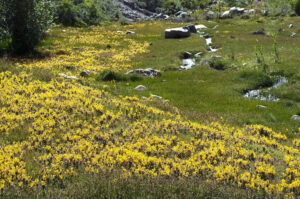

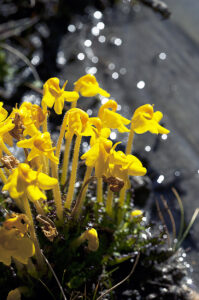

The inflorescence is a dense terminal head or spike, sometimes to 30 cm long, calyx inflated, usually hairy, veined, lobes 5, crested. Corolla pink, dark red, or purplish-red, tube to 7 cm long, beak slender, curved, to 1.4 cm long, lower lip 3-lobed, to 2.5 cm broad. Flowering takes place June-September.
It is distributed from Uttarakhand eastwards to Bhutan and south-eastern Tibet, growing at elevations between 2,300 and 4,300 m. Habitats include humid grasslands, shrubberies, and open slopes. It is very common in the Upper Rolwaling Valley, central Nepal.
The specific name is derived from Ancient Greek mega (‘large’) and anthos (‘flower’) – an apt name for this species.
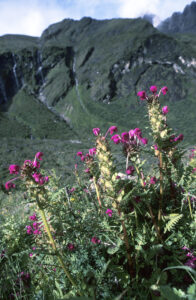
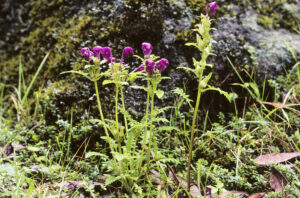
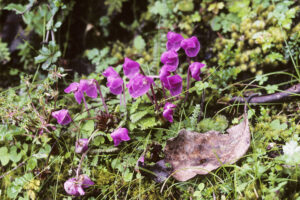
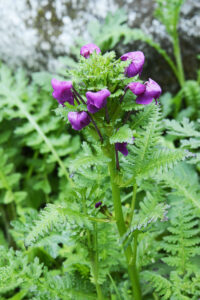
A low plant, to 20 cm tall, but usually lower, stem reddish, hairy, leaves mostly basal, stalk to 5 cm long, blade linear, to 10 cm long and 7 mm wide, deeply cut, segments 10-30 pairs, toothed, very close together. Stem leaves few, smaller.
The inflorescence is terminal, to 10 cm long, bracts densely hairy, calyx to 1.2 cm long. Corolla bright yellow on upper lip, often with a red or purple tip, lower lip very pale yellow, sometimes purple-spotted, 3-lobed, to 2 cm broad. No beak on the upper lip. It blooms June-September.
The specific name honours German botanist, physician, and economist Georg Christian Edler von Oldenburg Oeder (1728-1791), who was employed as Professor botanices regius (royal botanical professor) in Copenhagen, where he was in charge of establishing a new botanical garden. From 1753, he led the publication of a huge botanical work, Flora Danica, which was planned to cover all plants in Danish areas, including Schleswig-Holstein, Oldenburg-Delmenhorst, Norway, the Faroe Islands, Iceland, and Greenland. Oeder travelled extensively in Norway 1758-60.
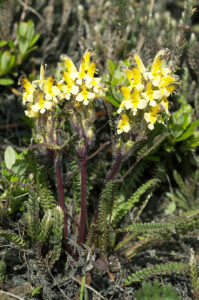
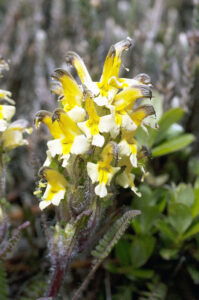
This plant is found from Pakistan eastwards to western Nepal, growing in shrubberies and on open slopes at elevations between 2,400 and 4,000 m. It is common in Kashmir.
The specific name is Latin, meaning ‘combed’, referring to the leaves, whose segments are arranged like the teeth of a comb.
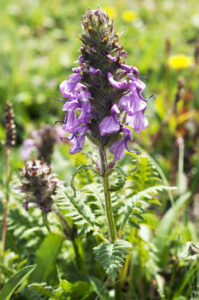
Stems several, to 40 cm tall. Leaves oblong or elliptic in outline, pinnately divided, lobes finely toothed.
It is easily identified by its flowers, which are pink or red with a large white spot in the throat, and a long, twisted beak, which is abruptly getting thicker near the base. The lateral lobes of the lower lip are standing out ear-like, the entire flower not unlike the head of an elephant, waving its ears. The inflorescence is in a dense, short spike, corolla tube to 2 cm long, lower lip to 1.5 cm across. Flowering takes place July-September.
The specific name alludes to the white spot in the flower.
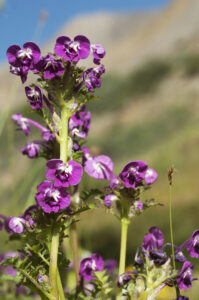
Stems often several, to 30 cm tall, usually erect, unbranched, dark, shining. Basal leaves stalked, oblong in outline, pinnately cut into 9-12 ovate, toothed segments, stem leaves few, smaller.
It has a very wide distribution, found from Kazakhstan, Kyrgyzstan, and Tajikistan eastwards to Mongolia, southern Siberia, and north-western China, southwards across Tibet to Pakistan, Himachal Pradesh, and the Yunnan Province, in the Himalaya growing in damp meadows and along streams in drier country, at elevations between 3,300 and 4,800 m.
The specific name is derived from Ancient Greek rhinos (‘nose’), anthos (‘flower’), and oid (‘resembling’), referring to the trunk-like beak of the flower.
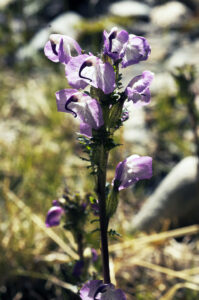
This plant grows in shrubberies and on open slopes at elevations between 3,300 and 4,800 m, from western Nepal eastwards to Sikkim.
The specific name commemorates a botanist named J. Scully, who collected plants in the Himalaya in the 1870s. I have not been able to find any other information about him.
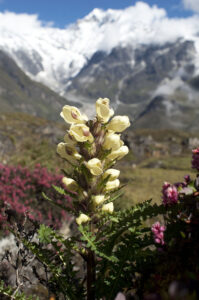
Stem to 60 cm tall, striated, very hairy, the major part of the hairs in 2 lines down the stem, leaves stalkless, clasping the stem, blade hairy, linear-lanceolate, to 7 cm long and 1.5 cm wide, pinnately divided, with 20-25 pairs of lobes, margin double-toothed.
It grows in stony grasslands at elevations between 3,000 and 5,000 m, from Qinghai and Sichuan southwards to Yunnan, south-eastern Tibet, and northern Myanmar, and thence westwards to Uttarakhand.
The specific name is derived from Ancient Greek thrix (‘hair’) and glossa (‘tongue’), alluding to the hairy upper lip of the flower.
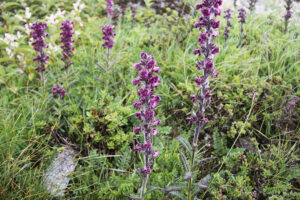
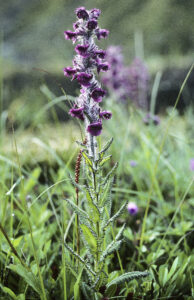
The generic name is derived from Ancient Greek oxus (‘sharp’, i.e. with a sharp taste), ultimately from oxos (‘vinegar’), alluding to the sour taste of the leaves of several species, especially common woodsorrel (O. acetosella).
The native area of this plant is possibly from the Indian Subcontinent eastwards to Japan, but this is not certain. Today, it is found across the planet, except in colder regions. In many places, it is regarded as a noxious weed in gardens, fields, and lawns. It is very common in the Himalaya, growing in open areas, including wastelands and fields, and along trails, up to altitudes around 3,400 m.
It may have been introduced to Italy before 1500. It was described scientifically in 1753 by Swedish naturalist Carl Linnaeus (1707-1778), who received specimens from Italy. (Source: Q.J. Groom, J. van der Straeten & I. Hoste 2019. The origin of Oxalis corniculata L. PubMed 30783568)
It is utilized for a variety of diseases, including peptic ulcer, diarrhoea, dysentery, fever, and haemorrhoids. The leaves are edible, with a taste reminiscent of lemons, and they are a good source of vitamin C. They can also be pickled.
The specific name is Latin, meaning ‘having small horns’. Presumably, it refers to the seeds, which have several ridges across, some slightly curved like horns.
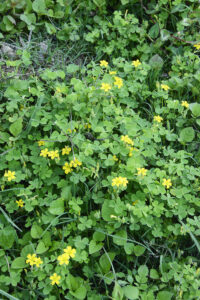
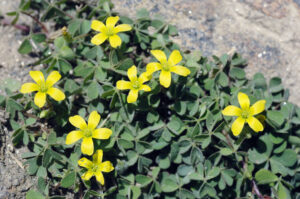

This species is native to Central and South America, but has become widely naturalized elsewhere in warmer countries. In the Himalaya, it is a common weed in fields, and is also found in other open areas, for instance in ditches and along trails, occurring at elevations between 1,200 and 1,600 m.
The specific name is Latin, meaning ‘with broad leaves’.

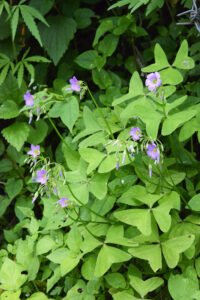
These gorgeous plants are native to temperate and subtropical areas of southern Europe, North Africa, Asia, and western North America. Due to their showy flowers, many species are cultivated elsewhere as ornamentals. A single species is found in the Himalaya.
The generic name is the Ancient Greek word for peony. According to Greek mythology, the gods bestowed the plant on the god Apollo due to his quality as healing god, under the name Paieon. For this reason, it was named Paeonia. However, Apollo passed it on to his son Asklepios, who was also a healing god. Peony was said to be an effective remedy against all ailments of the body.
Flowers are solitary, axillary, to 12 cm across, petals white or pinkish, elliptic, to 4.5 cm long and 2.5 cm broad, stamens numerous, orange or yellow, sepals persistent. It flowers between March and June. Initially, the seeds are bright scarlet, later brownish-black.
It grows in forests and shrubberies at altitudes between 1,800 and 3,200 m, from Afghanistan eastwards to western Nepal and extreme south-western Tibet.
It is threatened by excessive collecting, as it is widely used in traditional medicine, the seeds as a purgative and emetic, a paste of the root for nervousness and uterine diseases.
The specific name is derived from Emodos, the Ancient Greek name for a part of the Himalaya.
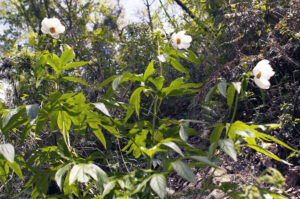
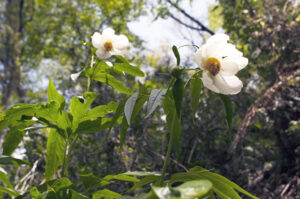
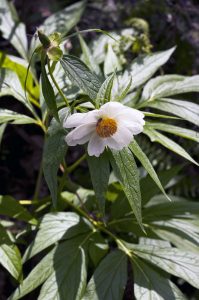
Most members of the family are herbs, a few shrubs or small trees. Many genera have gorgeous flowers, including true poppies (Papaver, below), Himalayan poppies (Meconopsis, below), and horned poppies (Glaucium), of which some are described on the page Plants: Flora of Turkey.
Two groups of plants, which were formerly regarded as separate families, are now included in the poppy family, namely Fumariaceae, which includes Corydalis (below), fumitories, and bleeding hearts, and Pteridophyllaceae, with only one genus and one species, Pteridophyllum racemosum, found in Japan.
The generic name is derived from Ancient Greek korydos, the ancient name of the crested lark (Galerida cristata), perhaps from korys (‘helmet’), referring to the crest of this bird. The upper petal of these plants forms a helmet-like hood and is spurred, and the lower petal forms a boat-shaped, keeled lip, whereas the two lateral petals are narrow. The fruit is a capsule.
It is a low plant, usually below 10 cm high, occasionally growing to 20 cm. Stems erect, slender, smooth, simple, basal leaves long-stalked, bluish-green, to 1 cm across, deeply divided, lobes elliptic, to 1 cm long. Stem leaves 1-2, short-stalked, blade to 3 cm long, lobes narrow, only about 2 mm wide.
It is found from Kashmir eastwards to Bhutan and south-eastern Tibet, growing in grasslands, shrubberies, and stony areas at elevations between 2,700 and 5,400 m.
The specific name means ‘found in Kashmir’.
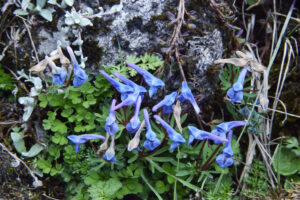
Inflorescences are terminal or axillary, to 10 cm long, flowers up to 40 packed closely together, corolla golden or pale yellow, upper petal to 1.3 cm long, spur straight, slender, to 9 mm long. Flowering takes place between May and October.
It is distributed from Himachal Pradesh eastwards to Arunachal Pradesh, Manipur, and Nagaland, growing in forests and shrubberies, and along streams, at elevations between, 2,100 and 4,200 m.
In Nepal, juice of the root is used for indigestion and fever, and also applied to boils. Juice of the plant is taken for peptic ulcer.
The specific name means ‘with leaves like Chaerophyllum‘ (chervils). Botanists familiar with the hairy chervil (C. hirsutum) of Europe will notice the similarity of the leaves. Pictures of that species may be seen on the page Plants: Flora of the Alps and the Pyrenees.
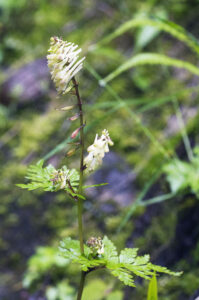
Inflorescences are branched, spike-like, terminal clusters, to 20 cm long, each with 10-30 bright yellow flowers, to 1.8 cm long, including spur to 6 mm long, often down-curved, swollen at the tip. Sepals to 2 mm long, margin hairy or lacerated. It flowers June-August.
This plant grows in dry stony areas at altitudes between 2,700 and 4,500 m, distributed from Pakistan and south-western Tibet across Ladakh to northern central Nepal. It is very common in Ladakh.
The specific name is Latin, meaning ‘fan-shaped’, alluding to the leaves.
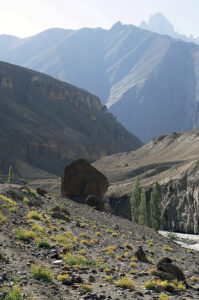
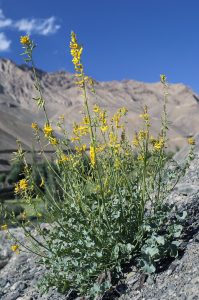
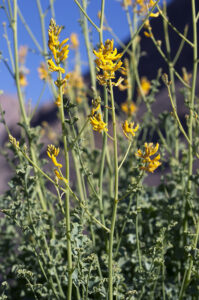
Flowers are arranged in a dense, terminal, spike-like cluster, to 15 cm long, with 10-30 bright yellow flowers, to 2.5 cm long, including straight or down-curved spur, to 1 cm long. Outer petals have prominent wings. Sepals to 2 mm long, whitish-green, deeply cut. The blooming period is from May to August.
It is distributed from Pakistan eastwards to eastern Nepal and south-eastern Tibet, growing in forests and shrubberies, and on open slopes, at elevations between 2,400 and 4,800 m.
In Ladakh, the root is used as antipyretic and diuretic, and to relieve pain, the leaves for fever, eye diseases, infections, swellings, and burns.
The specific name was given in honour of British surgeon and botanist George Govan (1787-1865), superintendent of the Botanical Garden of Saharanpur, northern India. He often corresponded with the famous Danish botanist and physician Nathaniel Wallich (1786-1854), the foremost authority on Indian and Himalayan flora in the early 1800s (see Geranium wallichianum above).
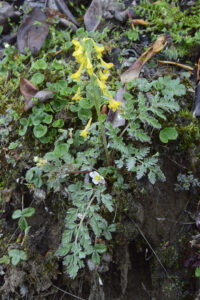
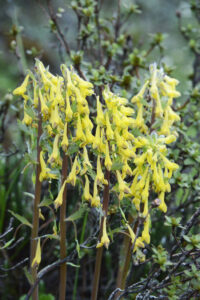
Stem to 45 cm high, smooth, unbranched, lower leaves few, very long-stalked (to 25 cm), blade to 10 cm long and across, deeply cut 2-3 times, with distant leaflets broadly lanceolate, pointed. Stem leaves (if present) small, stalkless, linear-lanceolate, to 5 cm long and 4 mm wide.
Inflorescences are dense clusters to 20 cm long, with 10-30 bright yellow flowers, to 2 cm long including blunt spur to 1 cm long, inner petals with blackish-purple tip, upper petal ovate, to 1.5 cm long, with a prominent wing. Flowering occurs June-September.
The specific name is Latin, meaning ‘rush-like’, probably alluding to the shape of the leaflets.
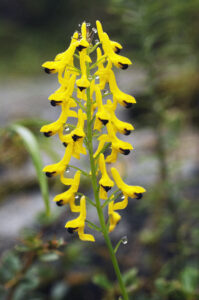
Inflorescences are terminal or axillary, to 5 cm long, with up to 30 flowers densely packed together, corolla to 1.8 cm long, yellow or orange, usually brownish at base and tip, spur short, pointed. Flowering occurs June-September.
It is distributed from Himachal Pradesh eastwards to Bhutan and south-eastern Tibet, growing in sandy and stony areas at elevations between 3,900 and 5,700 m.
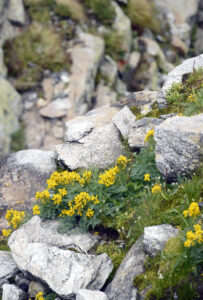
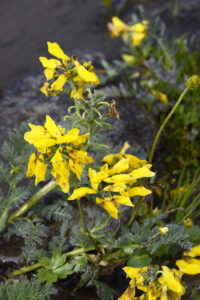
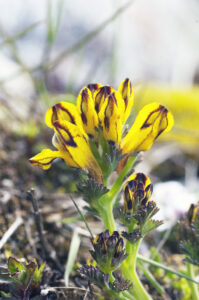
The generic name needs some explanation. It derives from Ancient Greek daktylos (‘finger’) and kapnos (‘smoke’). The first part presumably refers to the branched rootstock of these plants. The second part alludes to the fact that they are relatively closely related to the common fumitory (Fumaria officinalis), which in classical Latin was named fumus terrae, meaning ‘smoke of the earth’. The acrid taste of the plant would cause watery eyes, just like smoke. Alternatively, the name might allude to the fine foliage of the plant, which has been likened to ‘smoke over the ground’.
The inflorescence is long-stalked, nodding, with 6-14 bright or pale yellow flowers, often with a pinkish tip, narrowly triangular, to 2.1 cm long and 1 cm wide, outer petals sac-like, often with a narrow wing at the base. Flowering takes place from April to November.
It is widely distributed, from Nepal eastwards to western and southern China, southwards to Bangladesh, Myanmar, northern Thailand, and northern Vietnam. It also occurs in Sri Lanka, but may be introduced there. In the Himalaya, it is found at elevations between 900 and 3,000 m. Habitats include forests, grasslands, and open areas.
In Nepal, juice of the plant is used for fever and eye trouble, and juice of the root is applied to wounds between toes.
The specific name is Latin, meaning ‘climbing’.
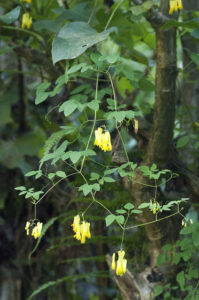
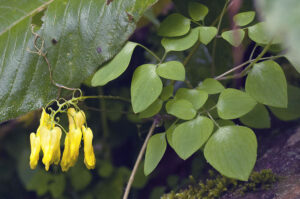
The generic name is derived from Ancient Greek dis (‘twice’ or ‘double’) and kranio (‘skull’ or ‘head’), thus ‘the stigma with two heads’, i.e. the plant has 2 stigmas (in fact, there may be up to 4).
Flowers are solitary or few together, stalked, to 5 cm across, sepals broadly ovate, to 2 cm long, petals yellow or orange-yellow, broadly obovate, to 2.5 cm long and 2 cm wide, filaments to 7 mm long, anthers yellow. It blooms June-July.
This plant is found in southern Tibet, north-western Sichuan, and in Tibetan border areas of Uttarakhand and Nepal, growing on stony slopes and on rocks along rivers, found at altitudes between 2,400 and 4,300 m.
In Nepal, the root is squeezed and boiled in water, which is given to women, who have difficulty in expelling the placenta after giving birth.
The specific name is Latin, meaning ‘lettuce-like’. It probably refers to the stem having orange juice.
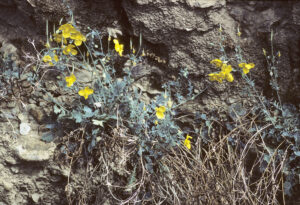
Hybridization in the genus is common, and many intermediate forms occur. Some species are cultivated as ornamentals in the West.
The generic name is derived from Ancient Greek mekon (’moon’), and opsis (’resembling’), referring to the round, yellowish petals of the Welsh poppy, which French botanist Louis Viguier (1790-1867) separated from the genus Papaver in 1814, renaming it Meconopsis cambrica, mainly due to the structure of its style. However, a phylogenetic study from 2011 concluded that the Welsh poppy belongs to the genus Papaver. It is illustrated on the page Plants: Flora of the Alps and the Pyrenees.

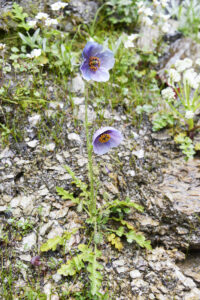
The inflorescence is a raceme with up to 20 flowers, each to 3 cm long and 7 cm across, petals usually 4, sky-blue, sometimes purplish-blue or red, filaments purple, anthers golden-yellow. It blooms June-August.
It is found in rocky areas in the western part of the Himalaya, from Pakistan eastwards to Uttarakhand, growing at altitudes between 3,000 and 4,200 m. It is common in the Great Himalayan National Park, Himachal Pradesh.
This plant is utilized for ulcers, disorders of the lungs, liver inflammation, pharyngitis, backache, and disorders of the spinal cord. In Ladakh, it is endangered due to excessive collecting.
The specific name is Latin, meaning ‘prickly’, ultimately from aculeus (‘stinger’).
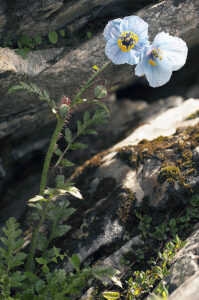
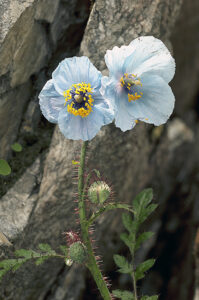
It is known from northern central Nepal and adjacent areas of Tibet, growing on open slopes, beneath rocks, and on grazing grounds, found at elevations between 3,500 and 5,600 m. It is very common in the Upper Langtang Valley, central Nepal.
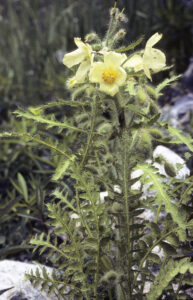
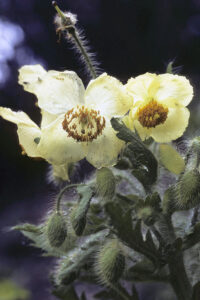
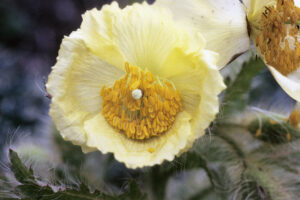
The inflorescence is a very large terminal cluster, lower flowers on branched stalks from leaf-axils, upper ones single, stalked. Petals usually 4, rounded, to 5 cm long, yellow, or occasionally white, anthers orange or yellow. The flowering period is from June to August.
This species is very common on cattle grazing grounds, and in other grasslands, found throughout the higher parts of the Himalaya, at elevations between 3,000 and 4,400 m. It is distributed from Uttarakhand eastwards to Bhutan and south-eastern Tibet.
The specific name indicates that the inflorescence is a panicle.
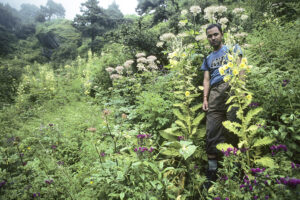
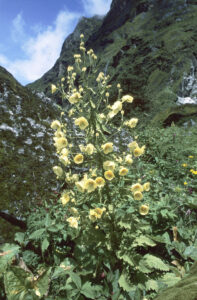
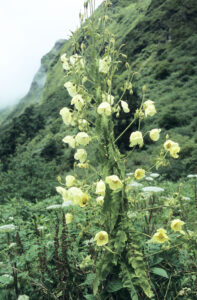
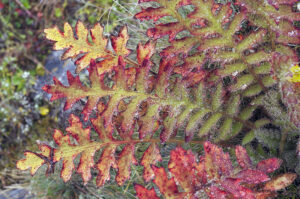
Flowers are solitary on a very long stalk, to 60 cm long, 5 or more rising simultaneously from the rootstock, often nodding, petals 5-8, obovate, to 4.8 cm long and 4.4 cm broad, sky-blue, purple, or pale blue, filaments purple, anthers orange, golden, or yellow. It flowers May-August.
It grows on open slopes, in shrubberies, and along streams, found at altitudes between 3,300 and 5,300 m, from Nepal eastwards to Bhutan and south-eastern Tibet.
The specific name is Latin, meaning ‘with undivided leaves’.
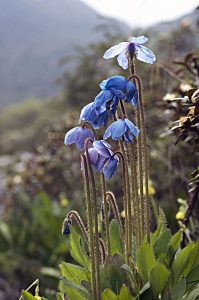
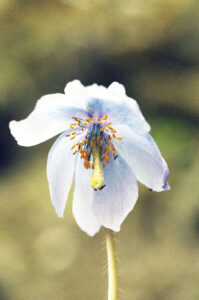
The fruit is a cylindric capsule with a cap-like top, seeds spreading through openings beneath the disk.
The generic name is the classical Latin name of the corn poppy (Papaver rhoeas), described on the page In praise of the colour red.
Leaves are all in a rosette, bristly-hairy, blade bluish-green on both surfaces, ovate to lanceolate, to 10 cm long and 4 cm broad, 3-lobed, lobes again divided. Flowering stem to 60 cm tall, but often much lower, erect, leafless, with bristly hairs, flowers solitary, terminal, to 6 cm across, petals yellow, orange, or reddish-orange, rarely red or white, to 3 cm long. Flowering takes place from May to September.
The specific name was the classical Latin term for the saffron crocus (Crocus sativa), described on the page Plants: Plants in folklore and poetry. In this case, the name refers to one of the flower colours.
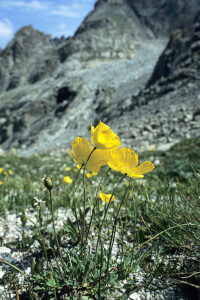
The generic name is derived from Ancient Greek eurys (‘broad’), presumably alluding to the leaves of the type species.
Flowers are axillary or arranged along the branches, to 4 mm across, sepals 5, brown, broadly ovate or rounded, to 3.5 mm long, petals 5, obovate or elliptic, white or pale yellow, to 5 mm long and 3 mm wide. Flowering occurs April-May. The fruit is a fleshy, globular berry, to 5 mm across, bluish-black when ripe.
This plant is distributed from central Nepal eastwards to Arunachal Pradesh, found in forests at elevations between 900 and 2,300 m.
In Nepal, the wood is used as fuel, and the foliage makes low-quality fodder.
The specific name is Latin, meaning ‘with leaves like Cerasus‘ (cherries).
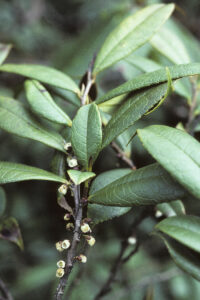
Stem to 2 m high, stout, erect, branched, longitudinally grooved, green or reddish-purple, almost smooth. Leaves alternate, stalked, lanceolate to ovate, pointed, to 30 cm long and 10 cm broad.
The inflorescence is a dense, erect, cylindric cluster, to 15 cm long, always opposite a leaf, flowers greenish-white, to 8 mm across, petals 5, to 4 mm long and 2 mm broad. Flowering occurs May-September. The fruits are small, dark purple berries, arranged in circular groups of 5-7 all the way up the flower stalk, bottom fruits ripening first. Ripening takes place from July to October.
In Nepal, the plant is cultivated, and tender parts are cooked as a vegetable. The root is used for constipation and wounds.
The specific name is Latin, meaning ‘resembling grapes’. With a bit of imagination, a single group of fruits may resemble a bunch of grapes.
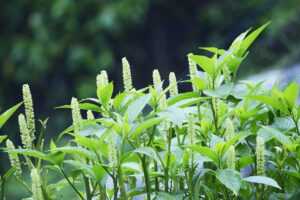
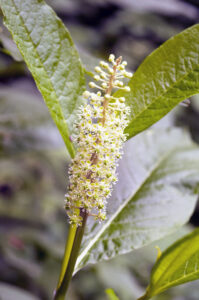
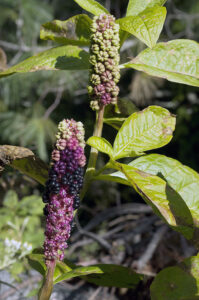
The leaves are linear, needle-like, and when falling they leave a scar. Mature female cones are woody, between 1.5 and 60 cm long, with numerous scales arranged in spirals, with 2 winged seeds on each scale. The male cones are small, 0.5-6 cm long, falling soon after pollination. Many species exude a sticky, fragrant resin.
The generic name is the classical Latin name of the silver fir (A. alba), probably derived from the Ancient Greek name of the plant, abin. The English name is probably derived from Old Norse fyri, which, however, was the word for pine trees (Pinus).
The specific name is the Nepali name of the tree.
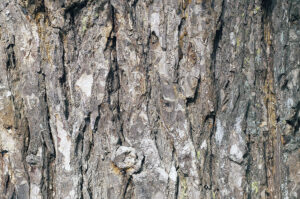
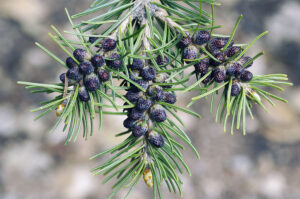
This species is very common in the Himalaya, growing in forests at elevations between 2,400 and 4,400 m, from Afghanistan eastwards to Myanmar.
It is widely used locally, the wood for construction, carpentry, furniture, paper-making, and firewood. The foliage is utilized medicinally for asthma, bronchitis, colds, and rheumatism, and is also burned as incense.
The specific name is Latin, meaning ‘remarkable’ or ‘admirable’.
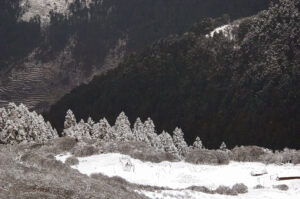
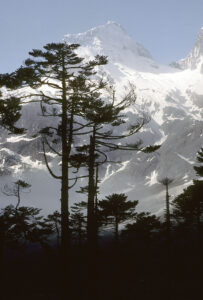
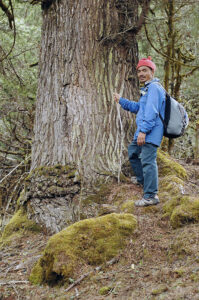


The generic name is derived from Ancient Greek kedros, which stems from an ancient Indo-European word, meaning ‘incense’. For millenia, needles and wood of cedar species have been used as incense.
It can grow to enormous dimensions, up to 80 m tall, its huge bole growing to 2 m across, with a circumference of up to 12 m. The bark is rather smooth, with vertical fissures. The twigs are drooping, needles dark green or bluish-green, to 5 cm long and 1 mm broad, borne singly on long shoots, 20-30 together on short shoots. Flowering occurs in October. Mature cones are large, erect, ovoid, to 13 cm long and 9 cm broad, fragmenting at maturity. They ripen between August and October the following year.
Needles and wood are used as incense, and traditional medicine is made from an essential oil in its wood. The wood is also used for constructing buildings, furniture, carts, and boats.
In Hindi, this tree is known as deodar, reflected in the specific name.

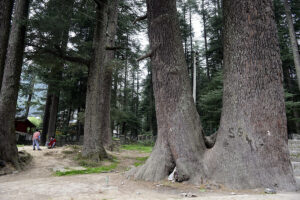
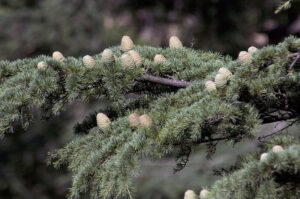
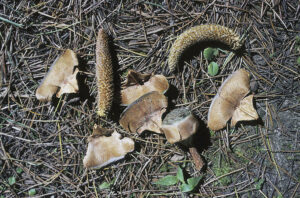
The generic name is the classical Greek and Latin names of larches.
It is common in forests and open areas at altitudes between 1,400 and 4,100 m, distributed from eastern Nepal eastwards to Myanmar and south-eastern Tibet. It is common in the Ghunsa Valley, eastern Nepal.
The wood is used for construction, furniture, and as fuel. The bark yields tannin.
The specific name honours British physician and botanist William Griffith (1810-1845), who spent most of his adult life in India and Myanmar. After a brief stay in Madras, he was assigned as a surgeon to Tenasserim, Myanmar. During the following years, he explored various parts of Myanmar, Sikkim, and the region around Shimla, north-western Himalaya. Subsequently, he was appointed as surgeon in Malacca, where he died of a parasitic liver disease, only 35 years old.
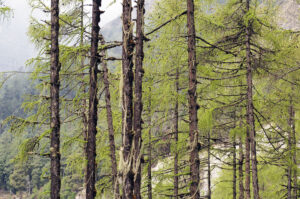
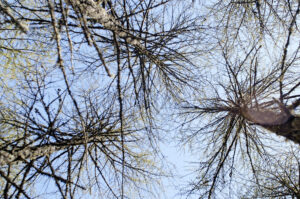
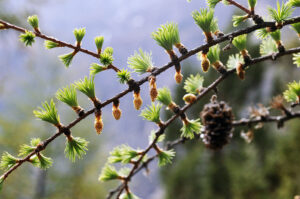
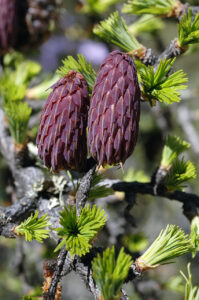
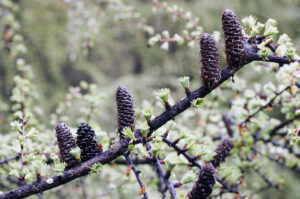
It is endemic to northern central Nepal and adjacent areas of southern Tibet, found in forests and open areas at elevations between 2,400 and 4,000 m. It is prominent in the Upper Langtang Valley, central Nepal.
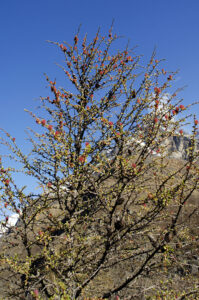
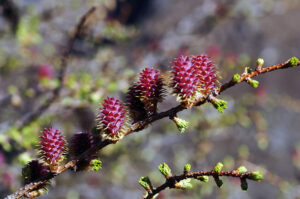
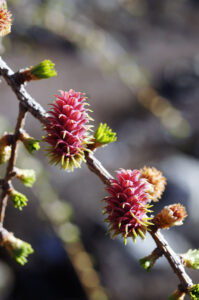
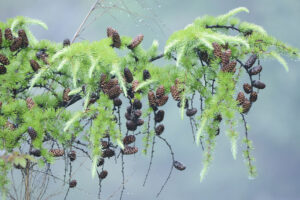
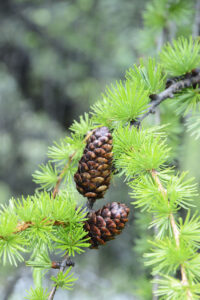
The generic name is the classical Latin word for spruces. It is derived from pix (‘pitch’), referring to the sticky sap produced by members of the genus.
It is distributed from Afghanistan eastwards to central Nepal, growing in forests at altitudes between 2,100 and 3,600 m.
The wood is used for furniture, boxes, charcoal, and paper.
The specific name honours English botanist James Edward Smith (1759-1828), founder of the Linnean Society.
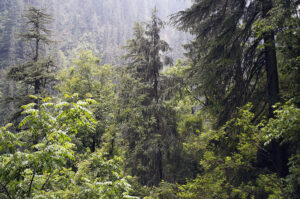
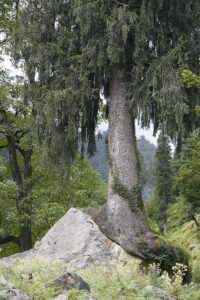
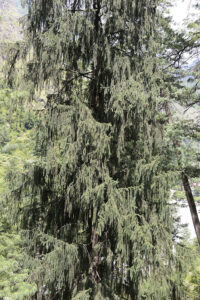
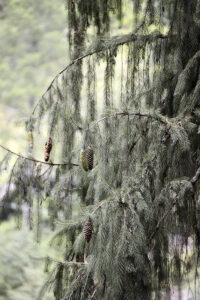
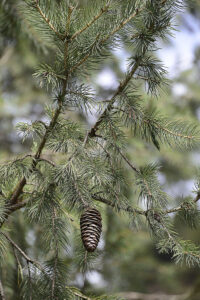
The generic name is the classical Latin word for pines, maybe originally stemming from Sanskrit pitu (‘sap’ or ‘resin’), alluding to the ample production of resin in this genus.
A common species in forests at elevations between 500 and 2,000 m, found from Afghanistan eastwards to Bhutan and south-eastern Tibet.
It is extensively cultivated. The wood is used as timber and to make furniture and charcoal. It also yields turpentine. The resin is used in a number of products, including paper, soap, cosmetics, paint, varnish, rubber, polish, and bangles. Tannin from the bark is used in dyeing. Seeds are edible when roasted.
In Ayurvedic medicine, the leaves are used as a diuretic, the oil for rheumatic ailments, the resin for inflammations and various skin problems. In Nepal, the resin is used for gastric problems, and also applied to cuts and wounds. The Tamang people of Nepal make tea from the resin and drink it for cough and chest problems.
The specific name honours Scottish surgeon and botanist William Roxburgh (1751-1815), known as the founding father of Indian botany. He published numerous works on Indian plants, illustrated by drawings made by Indian artists. The word chir has many meanings in Sanskrit and Hindi, one being ‘long-lived’.
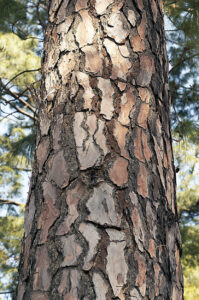
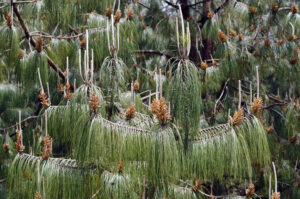
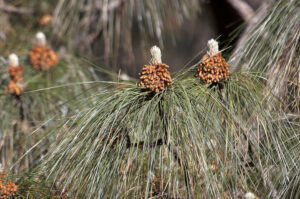
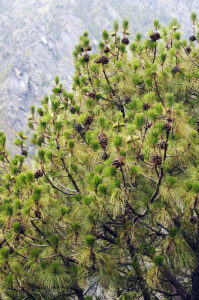
It is widely distributed, from Afghanistan eastwards to south-western China, growing in forests at altitudes between 1,800 and 4,300 m.
The wood is used for construction, carpentry, and firewood. It yields turpentine, used in traditional medicine, and also tar. In Nepal, the resin is used for wounds, and honey dew from aphids, living on the needles, is eaten as candy. Among the Tamang people of Nepal, the foliage is used for worship in temples.
The specific name was given in honour of Danish physician and botanist Nathaniel Wallich (1786-1854), who studied the Indian and Himalayan flora in the early 1800s, describing many species new to science (see Geranium wallichianum above). The popular name stems from its needles, which have a bluish tinge.
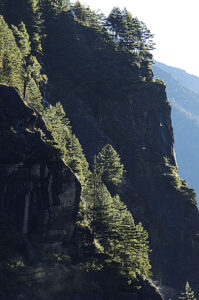
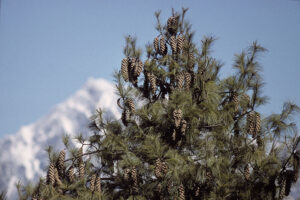
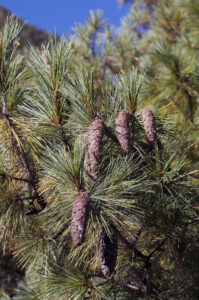

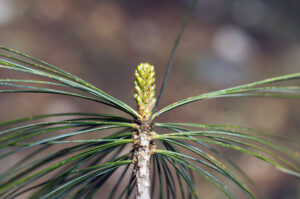
The generic name is the Japanese name of Tsuga sieboldii, whereas the common name alludes to the similarity in the smell of the crushed foliage to that of the poison hemlock (Conium maculatum). The foliage, however, is not poisonous.
An evergreen tree, to 40 m tall, trunk to 2.7 m across, bark grey-brown, thick, vertically fissured. Twigs are pendent, at first yellowish or reddish brown, later light brown or dark grey, hairy. The needles, which are arranged in 2 ranks, are to 3 cm long and 3 mm broad, whitish beneath. Leaf-scars are on raised ridges. Flowering takes place April-June. The cones are very small, egg-shaped, pendent, to 2.5 cm long, with thin scales, not fragmenting at maturity. The ripening period is between October and April.
The timber is used for construction, furniture, and foot-bridges, and the needles are burned as incense in Hindu and Buddhist shrines.
The literal meaning in Latin of the specific name is ‘overgrown with thorns’, in this connection undoubtedly alluding to the needles.
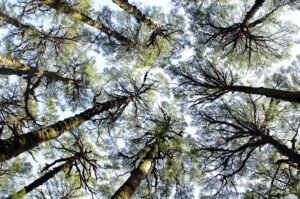
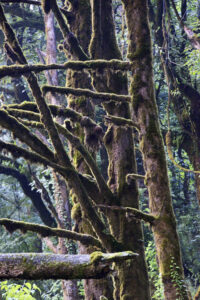
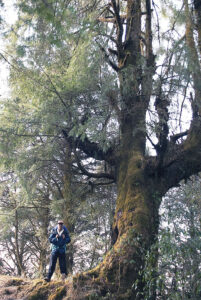
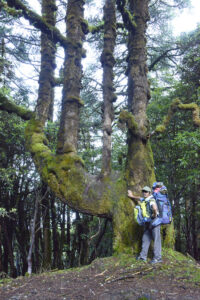
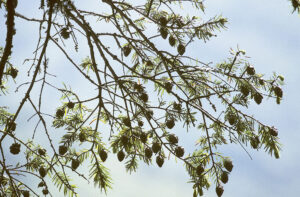
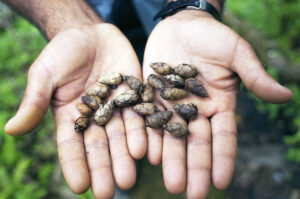
The generic name is derived from Ancient Greek peperi (‘pepper’) and homoios (‘resembling’).
It has a very wide distribution, found in South and East Asia, eastern Australia, Africa south of the Sahara, and Central and South America. In the Himalaya, it grows on humid rocks and mossy trees, often along streams, at altitudes between 1,000 and 2,500 m.
In China, this plant is utilized for medicinal purposes. In Nepal, leaves and shoots of a close relative, P. pellucida, are cooked as a vegetable.
The specific name is derived from Ancient Greek tetra (‘four’) and phyllon (‘leaf’), thus ‘with 4 leaves’.
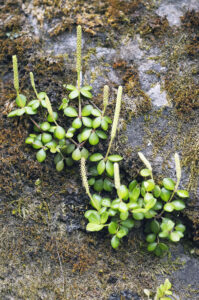
Numerous genera, which were formerly placed in the family Scrophulariaceae, have been moved to this family.
The generic name is the classical Latin name of these plants, originally digitalis herba derived from digitus (‘finger’), thus ‘a plant relating to the finger’, alluding to the shape of the flower resembling a thimble.
In England, in the old days, the common foxglove (D. purpurea) was regarded as a magical herb. The original name of the plant was folk’s glove, the glove of the ‘good folk’, or fairies, and it was believed that fairies lived in the flowers, the dark markings on the inside being their fingerprints. It was also said that fairies taught the fox how to muffle his footprints with foxglove flowers, in this way being able to surprise chickens.
All other common names of the plant, including fairies’ glove, fairy caps, fairy thimbles, gloves of Our Lady, Virgin’s glove, witches’ gloves, bloody fingers, and dead men’s bells, also refer to the flower shape.
An impressive herb, growing to about 1.2 m tall, stem stout, dark brown, very leafy, leaves with a winged stalk, blade ovate or elliptic, to 15 cm long, margin wavy, with small rounded teeth, tip usually pointed. Leaves gradually smaller and sessile up the stem.
The calyx is bell-shaped, to 1 cm long, lobes spreading, pointed, corolla to 4.5 cm long, thimble-shaped, purple with dark spots inside, sometimes whitish around the dark spots, rarely completely white. In the Himalaya, flowering takes place May-June.
An important heart stimulant is extracted from the plant. The medical usage of it, and its role in folklore, are described on the page Plants: Plants in folklore and poetry.
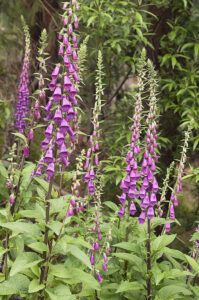
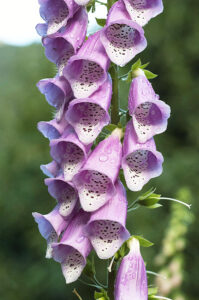
A creeping herb, all parts hairy, stems slender, to 1 m long, rooting at the nodes. Leaves long-stalked, pinnately lobed, with up to 7 wedge-shaped lobes, which are again lobed or toothed, blade oblong in outline, to 5 cm long. Flowers axillary, long-stalked, corolla white, sometimes with a yellow centre, petals 4-8, usually 5, spreading, spathulate, to 1.5 cm long. Flowering occurs April-June.
The generic name commemorates British botanist Robert Ellis, who collected plants in the north-western Himalaya 1879-1883. To me, it seems quite strange that the name is composed of a person’s name, and then Ancient Greek phyllon (‘leaf’).
The specific name refers to the pinnately divided leaves.
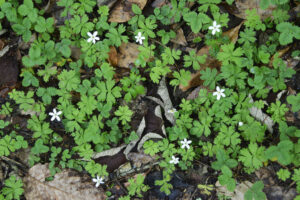
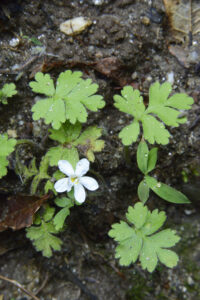
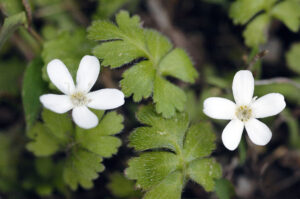
Corolla pink, sometimes white, to 8 mm across, tube bell-shaped, with 5 oblong, spreading lobes. It flowers Between March and June. The berry-like fruit, in reality a capsule, is ovoid or globular, fleshy, bright red, shining, to 8 mm across, ripening June-September.
It is distributed from Uttarakhand eastwards to eastern China, and from Taiwan southwards through the Philippines to Sulawesi. It is common in the Himalaya, growing in forests, shrubberies, and grasslands at elevations between 1,800 and 4,100 m.
The fruit is edible. In Nepal, juice of the plant is applied to wounds.
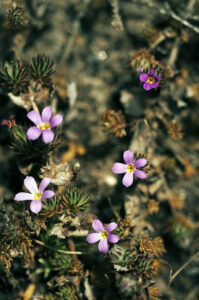
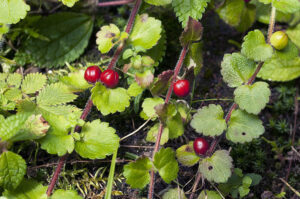
The genus is widespread in the Northern Hemisphere, and is also found in southern South America. A single species occurs in the Himalaya.
The generic name is derived from Ancient Greek hippos (‘horse’) and oura (‘tail’), thus horsetail, alluding to the general appearance of the plant. In English, it is also sometimes called horsetail, although this name is usually reserved for species of the genus Equisetum.
Stem of variable length, between 10 cm and more than 1.5 m, depending on water level. Leaves in whorls up the stem, blade linear or lanceolate, sometimes to 6 cm long, but usually much shorter, and only 1-2 mm wide. Flowers tiny, purplish, stamens to 1.5 mm long. Flowering takes place from April to September.
The plant is utilized in herbal medicine for treatment of wounds, stomach ulcers, and internal and external bleeding.
The specific name is Latin, meaning ‘common’.
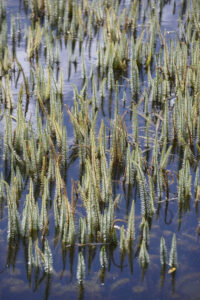
The generic name is derived from Ancient Greek lagos (‘rabbit’) and ous or otos (‘ear’), alluding to the leaves.
The inflorescence is a dense spike, to 10 cm long, flowers numerous, white, pale mauve, or blue, often only slightly longer than the elliptic, densely overlapping bracts, corolla tube slender, to 8 mm long, 2-lipped, petals out-curved or short, strap-shaped or rounded. It blooms May-August.
It is distributed from Pakistan eastwards to Bhutan and south-eastern Tibet, growing in gravelly areas, including, dry riverbeds, at altitudes between 3,900 and 5,600 m.
In Nepal, the root is used for fever, and to reduce blood pressure.
The specific name is a Latinized version of Kinnaur, a district in Himachal Pradesh. Presumably, the type specimen was collected there.
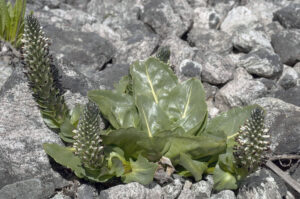
The generic name is derived from Ancient Greek pikros (‘bitter’) and rhiza (‘root’), alluding to the medical properties of these plants.
It is distributed from Pakistan eastwards to Uttarakhand, found in stony areas at elevations between 3,300 and 4,300 m.
Juice of the rhizome is used for fever, stomach ache, dropsy, and dysentery, and as a purgative.
The plant is highly endangered due to excessive collecting.
The specific name is probably a local name of the plant.
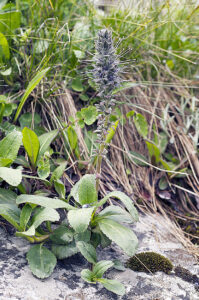
The generic name is the classical Latin name of the greater plantain (below), originally from planta (‘a sprout’ or ‘a shoot’).
This species is native to temperate and subtropical areas of Europe, Asia, Arabia, northern Africa and South Africa, but has been introduced to many other parts of the world, often becoming naturalized. In the Himalaya, it is native, growing up to elevations around 2,800 m. Habitats include waste places, fallow fields, villages, and along trails.
When the Europeans emigrated to North America, they somehow brought the seeds along, and the plant soon spread wherever the immigrants went, the seeds probably embedded in mud sticking to the horses’ hooves. This spreading was noticed by the indigenous peoples, who called the plant ‘white man’s footprint’.
The plant has many medicinal properties. In Nepal, it is utilized for a variety of ailments, including malaria, inflammation of gums, fever, diarrhoea, dysentery, and whooping cough. A paste of the plant is applied to boils. Tender parts are also eaten as a vegetable.
The specific name is Latin, meaning ‘larger’, presumably compared to other members of the genus.
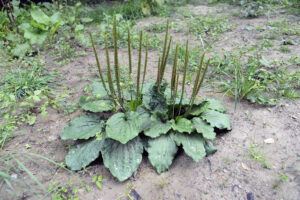
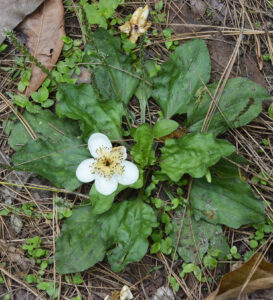
The generic name probably refers to the Biblical Veronica, who, according to legend, wiped the face of Jesus on his way to Golgotha. The flowers supposedly resemble the markings left on the cloth which was used. The common name is from Old English, meaning ‘to thrive’, referring to the vigorous growth of many Veronica species.
This plant grows in running or stagnant freshwater. It has a huge distribution, found in virtually all temperate and subtropical areas of Eurasia, and in northern, eastern, and southern Africa. It has also become naturalized in New Zealand and the Americas. In the Himalaya, it is found at elevations between 1,500 and 4,000 m. It is common in Ladakh.
The specific name is Latin, meaning ‘water-pimpernel’. Presumably, Swedish naturalist Carl Linnaeus (1707-78), who named this plant in 1753, found that the flowers were somewhat similar to those of the scarlet pimpernel, then known as Anagallis arvensis, today called Lysimachia arvensis.
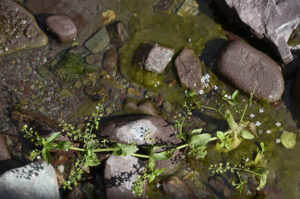
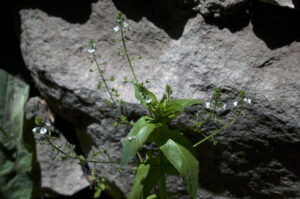
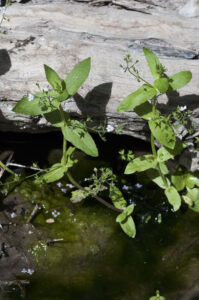
Stem erect or ascending, to 25 cm tall, unbranched, with a dense cover of greyish hairs. As opposed to most other plants, leaves get larger up the stem. There are 4-5 pairs, lower ones short-stalked, blade narrowly heart-shaped, upper ones almost sessile, blade elliptic or ovate, to 4 cm long and 3 cm wide. All leaves sparsely hairy, margin coarsely toothed, tip pointed or blunt.
Inflorescences are racemes, to 7 cm long, axillary from the uppermost leaves, stalks to 2 cm long, hairy. Calyx tubular, with 4 lanceolate lobes, to 3 mm long, hairy. Corolla to 1.2 cm across, white or pale blue, with darker streaks inside. It flowers May-August.
The specific name is Latin, meaning ‘hoary’ or ‘grey’. It probably refers to the greyish hairs on the stem.
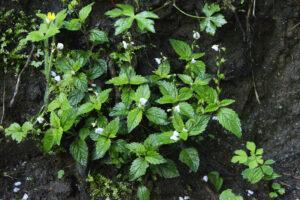
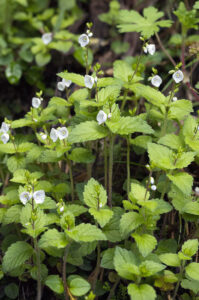
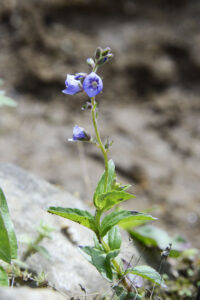
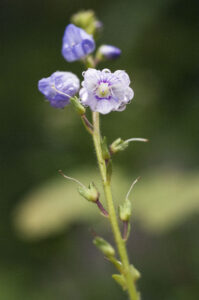
Flowers are long-stalked, solitary in leaf axils, calyx with 4 ovate-lanceolate lobes, to 8 mm long and 3.5 mm wide, corolla to 1.4 cm across, petals ovate or rounded, pale blue on upper half, white on lower half, filaments white, anthers blue. In the Himalaya, it flowers between March and May.
This species is probably indigenous in the Caucasus and northern Iran, but has become naturalized in most other areas of the globe. In the Himalaya, it grows at altitudes between 1,500 and 2,800 m.
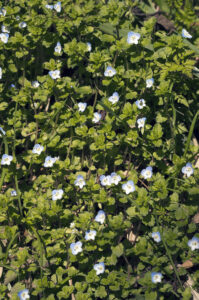
The generic name means ‘resembling Wulfenia’, a genus, in which these plants were formerly placed. Franz Xaver Freiherr von Wulfen (1728-1805) was an Austrian Jesuit priest, botanist, zoologist, and mineralogist, who was the first person to find a rare plant, Wulfenia carinthiaca, which is endemic to the eastern Alps.
It grows on shady rocks in forests at elevations between 1,500 and 3,000 m, from eastern Afghanistan eastwards to western Nepal.
In Nepal, juice of the root is used for stomach ache.
This plant was named in honour of Countess Sarah Amherst (1762-1838), a British naturalist, who lived in India. She found several plants and animals new to science, including the gorgeous Lady Amherst’s pheasant (Chrysolophus amherstiae).

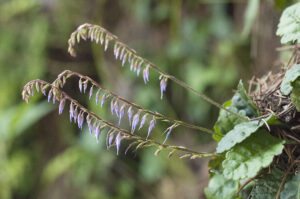
The fruits are very distinctive, ball-shaped, to 4 cm across, consisting of numerous small nut-like achenes, each ending in a spike. They are arranged in pendent clusters, up to 12 together.
The generic name is a Latinized version of Ancient Greek platanos, which was the classical name of maple trees (Acer). It refers to the maple-like leaves of the oriental plane tree. Some North American species are called sycamores, likewise referring to the leaves, which resemble those of the European sycamore maple (Acer pseudoplatanus).
The flowers are small, greenish, in long, pendent clusters, male and female flowers in separate clusters. In the Himalaya, they appear from March to May. The fruits are in globular heads, to 3 cm across, ripening June-October.
It is distributed from the Balkans and Turkey southwards to Jordan, but may be a native as far west as Italy, and as far east as Kashmir, where it is very commonly planted up to elevations around 2,400 m.
The bark is used medicinally.
A number of pictures, depicting this species, and other plane trees, are shown on the page Plants: Ancient and huge trees.
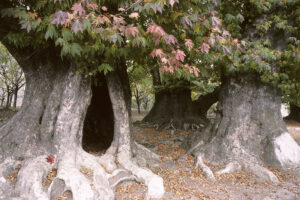
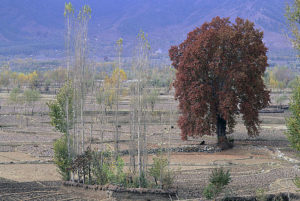
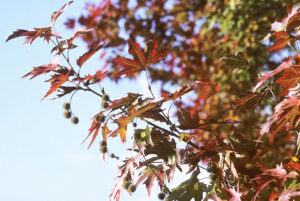
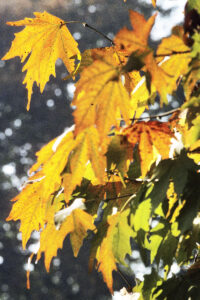
The generic name is derived from Ancient Greek akantha (‘thorn’) and Latin Limonium (sea lavender), alluding to these plants being closely related to members of that genus. The common name refers to the sea thrift (Armeria maritima), which also belongs to this family.
It is distributed from Kazakhstan and Xinjiang southwards to Afghanistan, Pakistan, and Ladakh, growing on dry open slopes and in rocky areas at altitudes between 2,500 and 4,500 m.
Ash of the burned plant is taken with milk for cardiac disorders. Dried plants are used as fuel. In Ladakh, it is threatened due to overcollecting.
The specific name means ‘resembling Lycopodium‘ (clubmosses), referring to the leaves being somewhat similar to clubmoss leaves. A species of clubmoss is shown on the page Himalayan flora 3.
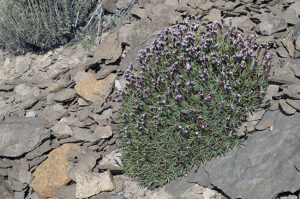
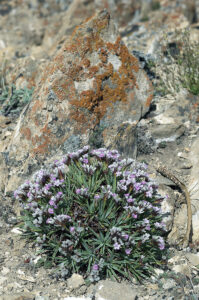
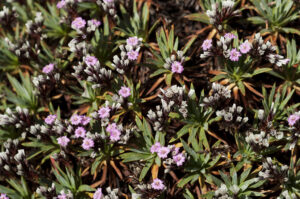
The following pictures show unidentified species of dwarf bamboo, and examples of their utilization.
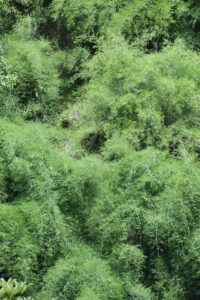
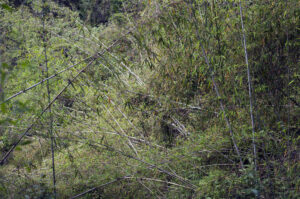
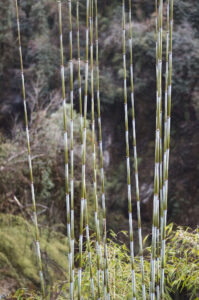

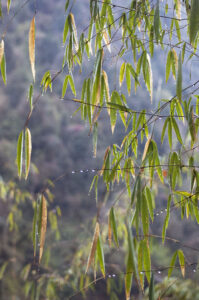
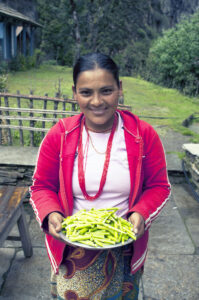
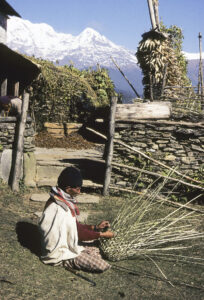
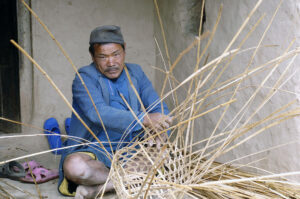

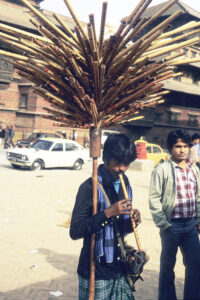
The generic name is derived from Ancient Greek daktylis, a kind of grape with finger-shaped bunches. In a botanical context, the word refers to an inflorescence, which is divided into finger-like sections.
It is widely distributed, from Iceland eastwards to central Siberia, southwards to northern Africa, Sri Lanka, China, and Taiwan, but as it is an important fodder plant, it has been widely introduced to temperate and subtropical regions throughout the world. and has become naturalized in many places. In some areas, it is considered an invasive species. In the northern regions, it grows down to sea level, in the southern parts restricted to mountains. In the Himalaya, it may be found at altitudes between 2,500 and 4,000 m.
The specific name is Latin, meaning ‘up-rolled’, in this case referring to the clustered spikelets.
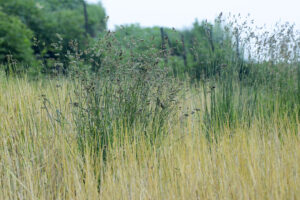
The family name is derived from Ancient Greek poly (‘many’) and gony (‘knee’ or ‘joint’), alluding to the swollen and often bent nodes on the stems of most of these plants. In numerous species, the stipules (scale-like or leaf-like appendages at the base of leaf-stalks) are fused into a stem-clasping sheath. The name is based on the genus Polygonum (below), first used in 1789 by French botanist Antoine Laurent de Jussieu (1748-1836) in his book Genera Plantarum.
The popular name knotweed alludes to several creeping species, which often form a dense tangle, a ‘knot’, whereas the name pinkweed alludes to the flower colour of many of these plants. The name smartweed refers to water pepper (Persicaria hydropiper, below), whose leaves have a peppery taste, which may ‘smart’ your mouth. Smart is an old English word, adapted from German Schmerz, which means ‘pain’.
Formerly, many members were lumped in the genus Polygonum. However, morphological and genetic research have had the effect that most of them have been transferred to various other genera, including Bistorta, Fallopia, Koenigia, Persicaria, and Reynoutria.
Flowers of these plants only have one type of segments. Whether they are called petals or sepals is an open question. Here I call them petals.
The generic name is derived from the Latin bis (‘twice’) and tortus (‘twisted’), like the English name snake-root referring to the twisted root of the common bistort (B. officinalis). This plant is illustrated on the page Plants: Flora of the Alps and the Pyrenees.
It is quite common on open slopes and in rocky areas, from Afghanistan eastwards through southern Tibet and northern Himalaya to Myanmar, growing at elevations between 3,000 and 4,900 m.
In Nepal, the rhizome is used for brewing tea, and also taken for stomach disorders.
The specific name is Latin, meaning ‘related to’, presumably referring to another member of the genus.

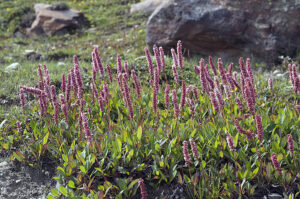
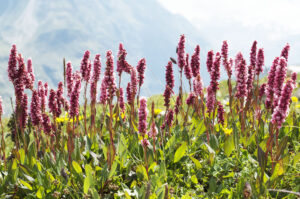
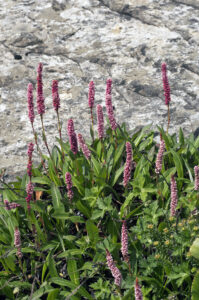
Inflorescences are dense terminal spikes, to 15 cm long and 1.3 cm wide, usually solitary, but sometimes branched, erect in Western Himalaya, but pendulous in variety pendula, found from central Nepal eastwards. Corolla usually deep red, sometimes pink or white, to 6 mm long, petals 5. Flowering takes place June-November.
It has a wide range, found from Afghanistan eastwards along the Himalaya to central China, growing in shrubberies, along forest edges, and on open slopes. In the Himalaya, it occurs at elevations between 2,100 and 4,800 m.
In Nepal, the rhizome is utilized for tea, and a paste of the plant is applied to wounds.
The specific name refers to the upper leaves clasping the stem, from the Latin amplexus (‘clasped’) and caulis (‘stem’).
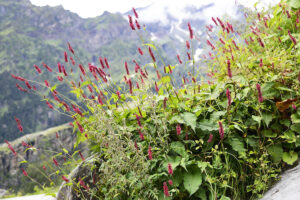
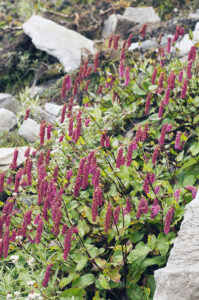
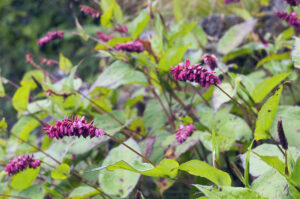
It is distributed from Uttarakhand eastwards to Bhutan, and thence northwards to central China, mainly found in drier areas, growing in grasslands and on open slopes at altitudes between 1,700 and 5,000 m.
In Nepal, juice of the root is used for diarrhoea and dysentery.
The specific name is derived from Ancient Greek, meaning ‘large-leaved’.
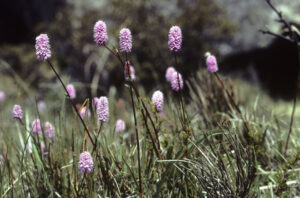
Stem to 50 cm tall, lower leaves oblong or lanceolate, parallel-sided, blade to 15 cm long and 4.5 cm wide, abruptly narrowed to a winged leaf-stalk, upper leaves sessile, sometimes clasping the stem. The inflorescence is a dense terminal head, broadly cylindrical or rounded, to 6 cm long, flowers crimson, to 4 mm long. They appear June-September.
The specific name honours English plant collector Charles Millett (1792-1873), who corresponded with the famous British botanist William Jackson Hooker (1785-1865). Between 1827 and 1834, Millet was based in Macau, Ceylon (today Sri Lanka), the Malabar region of South India, and Java, working for the East India Company. While in Asia, he collected many plants. He returned to London in 1834.
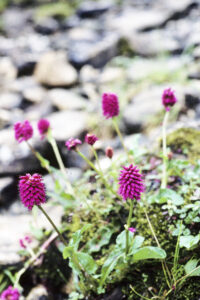
Flowering stems are axillary or terminal, to 10 cm high, spikes slender, cylindrical, to 8 cm long and 8 mm across, corolla pink or purplish-red, to 4.5 mm long. Blooming occurs August-September.
It is found from Kashmir eastwards to Bhutan and south-eastern Tibet, growing on rocks and open slopes, mainly in wetter areas at elevations between 3,000 and 4,500 m. It is common in Nepal.
In Nepal, juice of the root is utilized for fever.
The specific name is Latin, meaning ‘with leaves like Vaccinium‘ (blueberry).
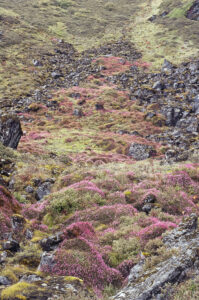
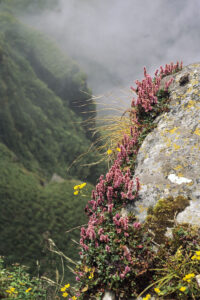
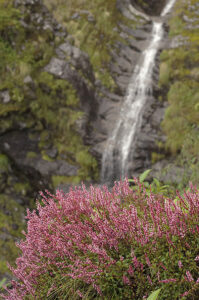
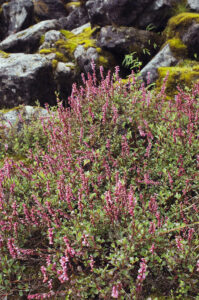
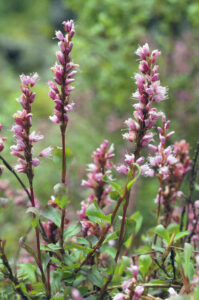
The inflorescence is a slender terminal spike, to 10 cm long, flowers pale pink or white, to 3 mm long, lower ones often replaced by brown or purple bulbils, to 4 mm long. Flowering occurs May-September.
This plant is widely distributed in subarctic and temperate areas of the Northern Hemisphere, southwards to Arizona, Spain, the Caucasus, the Himalaya, and northern Indochina. In the Himalaya, it grows in rocky areas and grasslands, and on open slopes, at altitudes between 3,300 and 5,000 m.
In Nepal, the root is used for fever, seeds for cough and infections. The seeds are roasted and pickled.
The specific name is derived from the Latin vivus (‘alive’) and pario (‘I bear’, i.e. offspring), alluding to the bulbils in the lower part of the spike.
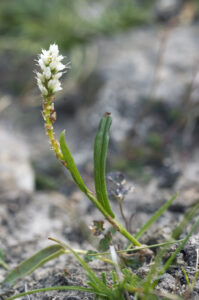
The generic name is derived from the Latin fagus (‘beech’) and Ancient Greek pyros (‘wheat’), alluding to the resemblance of the nutlet to beech nuts. The common name is a corruption of the German name Buchweizen (‘beech-wheat’).
Inflorescences are terminal or axillary, long-stalked clusters, to 12 cm long, flowers white, to 5 mm across. The flowering period is from April to October. Nutlets blackish-brown, triangular, to 8 mm across, sometimes narrowly winged. They ripen between May and November.
It occurs from Pakistan eastwards to central and southern China and northern Indochina, growing in forests and shrubberies, along trails, and in cultivated areas. In the Himalaya, it is found at elevations between 1,500 and 3,400 m.
In Nepal, tender parts are cooked as a vegetable, the leaves cut for fodder, and the seeds used for stomach disorders.
The specific name is Latin, meaning ‘with many shoots’.
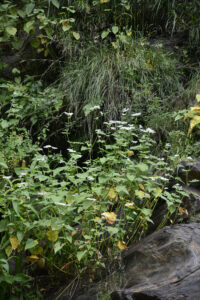
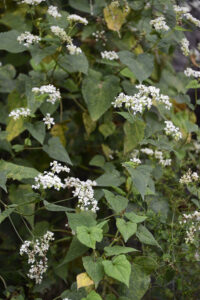
In Nepal, the slightly acid stems of some members are chewed when young.
The generic name commemorates Baltic-German botanist and physician Johann Gerhard König (1728-1785), a pupil of Swedish naturalist Carl Linnaeus (1707-78) in 1757. While living in Denmark 1759-67, he examined the plants of Iceland. Later, he served in the Danish Tranquebar Mission in South India, before serving under the Nawab of Arcot, and later the English East India Company. He collected many plants from the region.
Inflorescences are terminal, much-branched, pyramid-shaped clusters, to 30 cm long, flowers numerous, creamy white, yellowish, or pale pink, petals 5, elliptic, to 3 mm long. It blooms June-August.
It is widely distributed, from southern and eastern Europe eastwards across Central Asia to the Pacific Ocean, southwards to Iran and northern Indochina. In the Himalaya, it occurs from Pakistan eastwards to Himachal Pradesh, growing in shrubberies, on open slopes, and along streams, found at elevations between 1,500 and 3,000 m. It is common in Kashmir and Lahaul.
The stem is edible when cooked.
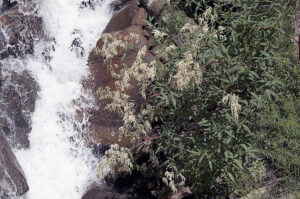
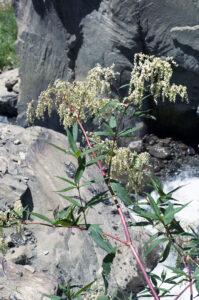
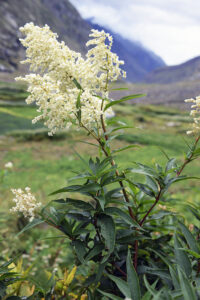
It differs from other members of the genus by its bell-shaped flowers and the leaf nerves being deeply impressed on the upper surface. Stem erect, to 1.2 m tall, leaves leathery, elliptic or lanceolate, long-pointed, to 16 cm long and 5 cm wide, pinkish-brownish hairy beneath, nerves on upper surface deeply impressed. Sheath short, usually below 1 cm long, bristly-hairy.
Inflorescences are axillary or terminal, rather small and compact clusters, erect or nodding, flowers bell-shaped, pinkish or white, to 5 mm long, appearing July-September.
In Nepal, tender parts are cooked as a vegetable.
The specific name was given in allusion to the bell-shaped flowers, from the Latin campanula (’little bell’).
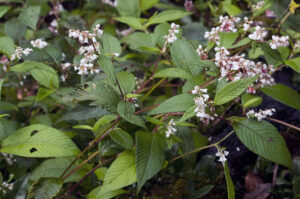
This is a subarctic plant, extending into temperate areas southwards to Arizona, the British Isles, Pakistan, Ladakh, and western China. In Ladakh, it grows in humid grasslands and along streams at elevations between 3,000 and 5,000 m.
The specific name refers to Iceland, where König (see generic name above) first collected this species in 1765.
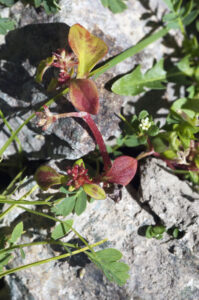
It is gregarious, often forming dense growths. Stem erect, many-branched, rounded, to 2.5 m tall, base woody, stem and branches downy-hairy. Leaves short-stalked, elliptic-lanceolate, to 20 cm long and 7 cm broad, silky-hairy beneath, downy above, nerves not impressed. Sheaths dark-brown, 3-7 cm long.
Inflorescences are terminal, many-branched, hairy, to 40 cm long, flowers to 5 mm across, cream-coloured or white, appearing between May and October. The fruit is black, rounded, to 3 mm across.
In Nepal, tender parts are cooked as a vegetable, and also pickled.
The specific name is Latin, meaning ‘soft’ or ‘delicate’, alluding to the downy-hairy stems and leaves.
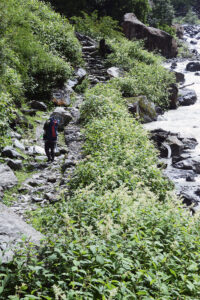
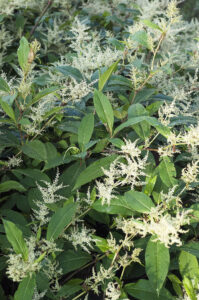
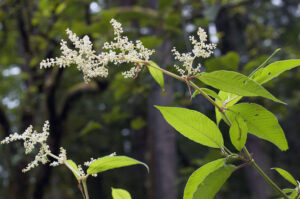
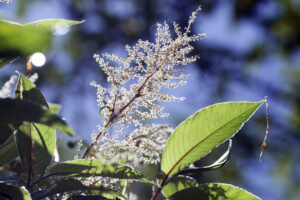
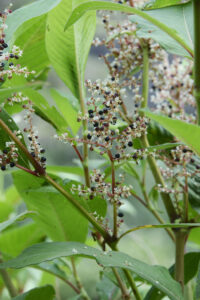
Inflorescences are terminal panicles, much-branched, spreading, to 45 cm long. Flowers pink or whitish, to 6 mm across. Flowering occurs July-October.
It grows at elevations between 2,000 and 4,500 m, from Afghanistan eastwards to northern Myanmar and south-western China. Habitats include forests, open areas, and streamsides.
In Nepal, tender parts are cooked as a vegetable.
The specific name is derived from Ancient Greek polys (‘many’) and stachys, which originally means ‘an ear of grain’, but in a botanical context used for ‘spike’ (an inflorescence with many stalkless seeds along a central axis). Thus, polystachya means ‘with many spikes’, alluding to the abundant number of (false) spikes on this plant.
It was previously known as Persicaria polystachya, Persicaria wallichii, or Polygonum wallichii.
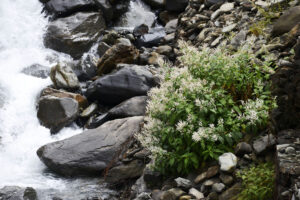
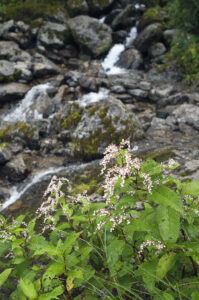
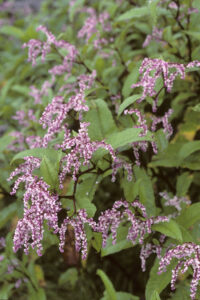
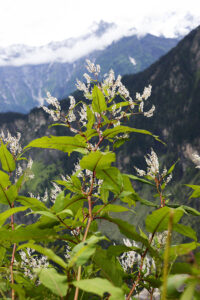
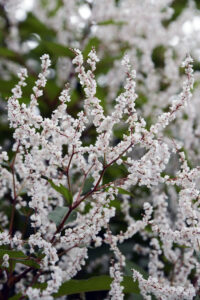
Inflorescences are terminal, cylindrical, dense clusters, to 5 cm long, flowers white or cream-coloured, bell-shaped, petals 5, obovate or elliptic, to 3.5 mm long. Flowering takes place June-August. The foliage becomes a lovely crimson in autumn (see picture below).
It is distributed from Afghanistan eastwards across northern Pakistan, Ladakh, and Tibet to northern Nepal and northern Arunachal Pradesh, found on dry slopes and in stony areas at elevations between 3,300 and 5,600 m. It is common in Ladakh.
It is used medicinally for dysentery.
The specific name is derived from the Latin tortus (‘twisted’) and osus (‘plenty’), referring to the twisted leaves.
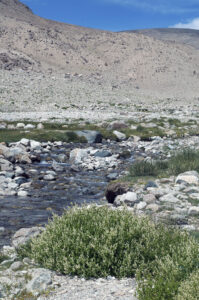
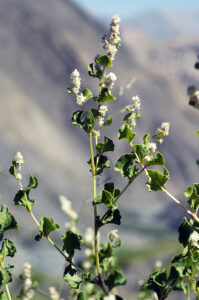

The generic name is derived from Ancient Greek oxys (‘sour’) and aria (‘possessing’), alluding to the acidic leaves.
Stems solitary or several, grooved, to 50 cm high, sometimes more. Leaves mostly basal, stalk to 13 cm long, grooved, blade pale green, rather fleshy, rounded, heart-shaped, or kidney-shaped, hairless, to 5 cm across, margin entire. Stem and leaves often turn reddish. Sheath to 1.5 cm long, brownish, pointed.
The branched inflorescence has long, slender spikes, each with many whorls of greenish or pinkish-white flowers, to 3 mm across. Flowering takes place May-October. The fruit is ovoid, to 3.5 mm across, wings to 3 mm broad, pinkish, later turning red.
The leaves are edible, raw or cooked. In Nepal, root, stem, and leaves are used for dysentery.
The specific name is derived from Ancient Greek dis (‘two’) and gyne (‘woman’), referring to the flower having 2 stigmas.
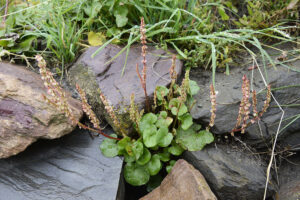

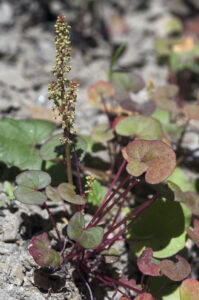
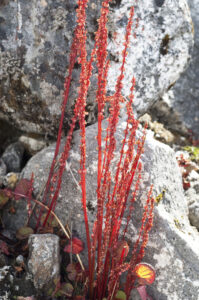
The generic name is derived from the Latin persica (‘peach-like’), alluding to the leaves of some members resembling peach leaves.
Below, two pictures show unidentified Persicaria species, both with glandular hairs beneath the inflorescences.
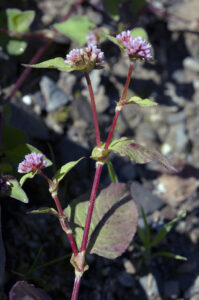
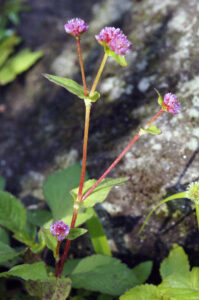
Inflorescences are terminal globular heads, mostly solitary, to 1.3 cm across, flowers to 2 mm long, pink, stalks glandular-hairy. The flowering period is very long, from February to November.
It is distributed from Pakistan eastwards to Taiwan, southwards to Sri Lanka and northern Malaysia, growing on rocks, stone fences, and slopes, and along trails. In the Himalaya, it occurs at elevations between 600 and 3,500 m.
In Nepal, a paste of the plant is applied to boils and wounds, and its juice is taken for stomach problems. The plant is collected for fodder.
The specific name is Latin, meaning ‘forming a head’, alluding to the globular inflorescence.
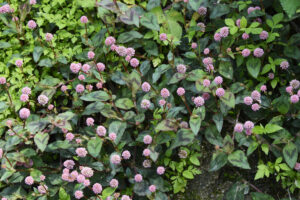
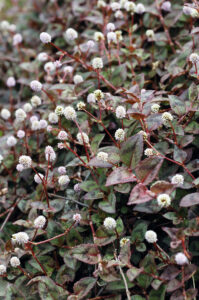
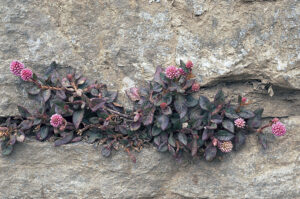
Inflorescences are terminal or axillary, slender, lax spikes, pendulous, to 8 cm long, corolla greenish, white, or pink, to 3.5 mm long. Self-pollinating flowers are present in many lower leaf axils. Flowering occurs May-September.
It is very widely distributed, found from the entire Europe eastwards across Central Asia to the Pacific Ocean, southwards to North Africa, Iran, Sri Lanka, Indonesia, and Australia. In the Himalaya, it may be found up to elevations around 3,500 m, growing in wet meadows, and along rivers and ponds.
In Nepal, the plant is boiled, and the filtered water is taken to expel intestinal parasites. The plant is also strewn in water to stupefy fish.
The specific name is derived from Ancient Greek hydor (‘water’) and peperi (‘pepper’), ultimately from Sanskrit pippali. It refers to the leaves, which have a strong peppery taste, also reflected in the name smartweed, derived from old English smeortan (‘to cause pain’), originally from German Schmerz (‘pain’).
In his delightful book All about Weeds, American botanist Edwin Spencer (1881-1964) writes: “There are a great many species (…) which look somewhat like this weed, but most of them lack the ‘smart’ taste entirely, and none of them possess the fire of hydropiper.”
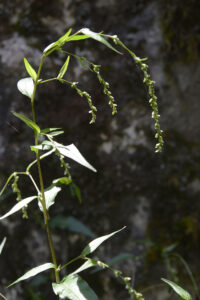
In the Himalaya, it may be found up to elevations around 2,300 m, growing in shrubberies and waste places, along trails and roads, and in other open areas.
Stem reddish, trailing or scrambling, to 2 m long, branched, angulate, armed with back-pointing prickles. Leaves have a prickly stalk, to 8 cm long, blade triangular, to 6 cm long and 8 cm wide, prickly along veins below, smooth above, base shallowly heart-shaped, tip pointed. Sheath tubular, with a leaf-like, rounded ear at the tip, to 3 cm across, clasping the stem.
Inflorescences are terminal or axillary spikes, to 3 cm long, corolla white or pinkish, to 3 mm long. Flowering occurs June-August. The spectacular fruit is metallic blue, shining, fleshy, berry-like, ripening July-October.
Ripe fruits are edible. In Nepal, tender parts are cooked as a vegetable, and juice of the leaves is taken for backache. It is also used for various purposes in traditional Chinese medicine. The foliage provides good fodder, and stems can be used to make ropes.
The specific name is a botanical term, used when the stem seemingly passes through the leaf blade, from the Latin per (‘through’) and foliatus (‘leafy’), in this case alluding to the leaf-like ears at the nodes. Common names include mile-a-minute vine, which alludes to the rapid growth of the plant, and devil’s tail and climbing tearthumb, which both refer to its vicious prickles.
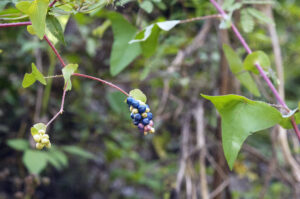
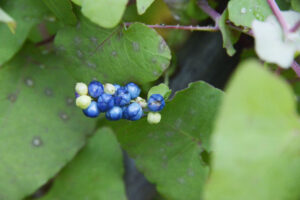
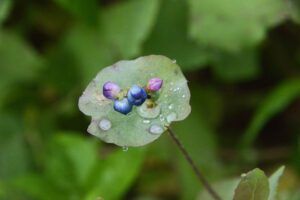
Stem erect, often reddish, to 90 cm tall, branched above, leaves short-stalked, blade ovate-lanceolate or broadly lanceolate, to 10 cm long and 2.5 cm wide, margin hairy, tip pointed. Sheath tubular, to 1.5 cm long, membranous, hairy. Inflorescences are terminal or axillary spikes, slender, lax, pendulous, to 15 cm long, interrupted below. Corolla red, pink, or green, to 4 mm long. It flowers August-September.
In Nepal, it is strewn in streams to stupefy fish.
This species resembles Persicaria hydropiper (above), but may be identified by the stem and the inflorescence, which are both often reddish.
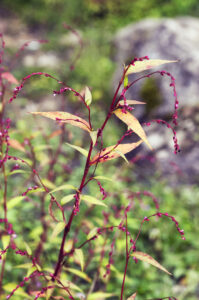
The inflorescence is a dense terminal head, to 1.5 cm in diameter, stalk glandular-hairy, petals pinkish or white, to 3.5 mm long. The flowering period is long, from May to November.
It is found from Uttarakhand eastwards to eastern China and Taiwan, and thence southwards to Java and the Philippines, in the Himalaya growing up to elevations around 3,900 m. Habitats include grasslands, shrubberies, and open humid slopes.
In Nepal, young parts are cooked as a vegetable.
The botanical meaning of the specific name is ‘pointing backwards from the tip’, alluding to the lobes on the leaves.
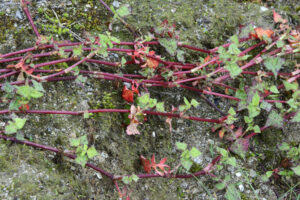
The generic name is explained above under family name.
Flowers are in axillary clusters of 3-6, stalkless, partly concealed by papery, fringed sheaths, petals white, pinkish, or greenish, narrowly elliptic, to 3 mm long, with prominent veins beneath. Flowering takes place most of the year.
This species is found in South and East Asia, Indochina, the Philippines, Australia, most of Africa, and Madagascar. In the Himalaya, it grows in dry rice fields and humid grasslands, and along trails, up to altitudes around 3,800 m.
In Nepal, the plant is boiled, and the juice taken for dysentery, juice of the root for stomach trouble. Tender parts are cooked as a vegetable.
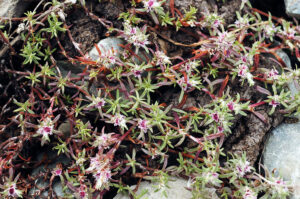
The basal leaves are large, ovate or heart-shaped, the small green flowers are in spike-like panicles, and the fruit is a nut, broadly 3-winged, often red or purple.
The generic name is a Latinized form of Ancient Greek rheon, the classical name of rhubarb, ultimately from the Persian name of these plants, rewand.
Stem erect, purplish-red or dark purple, to 80 cm tall, smooth, nodes inflated. Basal leaves few, stalk purplish-red, to 20 cm long, blade broadly heart-shaped or triangular, to 20 cm long and broad, margin entire, tip pointed, stem leaves similar, but gradually smaller up the stem, quite small in the inflorescence, which is a branched panicle with clusters up to 10 purplish-red flowers, each flower to 4 mm across. They appear June-August. The fruit is oblong-ovoid or broadly ovoid, to about 8 mm long, winged, dark purple when ripe, which is from August to October.
The roots are used medicinally. In Nepal, the leaf stalks are pickled.
The specific name is Latin, meaning ‘pointed’, referring to the leaf shape.
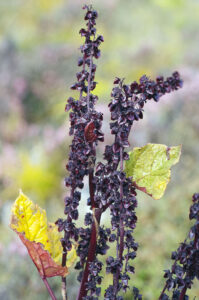
Inflorescences are axillary or terminal spikes, to 20 cm long, branched, flowers purplish-red, to 3.5 mm across. Flowering takes place June-August. The nutlet is ovoid-ellipsoid, to 1.5 cm long, purplish-red, wings to 2.5 mm broad, veined along the margin, base heart-shaped, tip often notched. Ripening period is August-October.
It is found from Pakistan eastwards to Myanmar and south-eastern Tibet, growing on open slopes and in grassy areas at elevations between 3,000 and 4,300 m.
In Nepal, the leaf-stalks are dried and pickled. The rhizome is used as a purgative, astringent, and stomachic, and it also yields a yellow dye. The species is threatened by excessive collecting.
The specific name is Latin, meaning ‘southern’, probably alluding to this species being one of the most southerly of the genus.
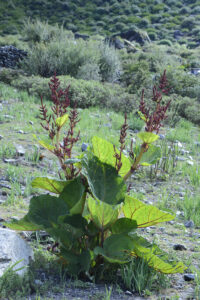
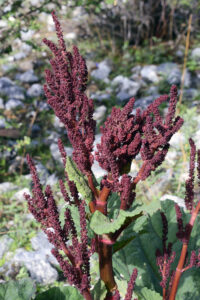

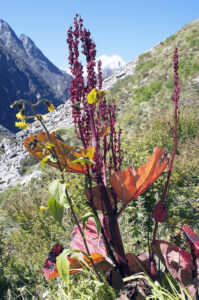
The stem is to 2 m tall, leaves mostly basal, stalked, rounded, leathery, to 30 cm across, often red along margin, gradually getting smaller and changing colour to yellowish up towards the bracts.
It grows in rocky areas at altitudes between 3,600 and 4,800 m, from eastern Nepal eastwards to south-eastern Tibet.
Leaf-stalks can be eaten, raw or pickled. The leaves are used as a substitute for tobacco. The plant is threatened due to excessive collecting.
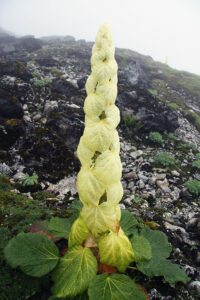
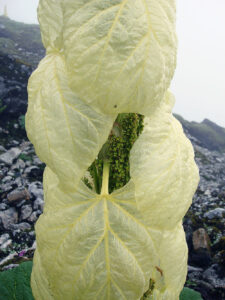
Inflorescences are numerous, to 1 m tall, flowers in panicles, corolla reddish-brown, to 2.5 mm long. Flowering takes place July-August. The fruit is rounded, to 1 cm across, wings broad, brownish-red, notched at both ends. Ripening occurs August-September.
It grows in dry rocky areas at elevations between 2,500 and 4,600 m, from Afghanistan eastwards through northern Pakistan, Ladakh, and northern Himachal Pradesh to Tibet.
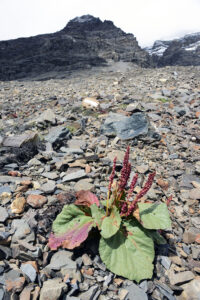
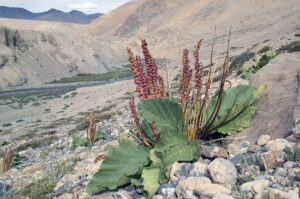
Inflorescences are terminal, many-branched panicles with numerous small flowers, petals yellowish or white, elliptic, to 2 mm across. Flowering occurs June-August. The fruit is broadly ellipsoid or rounded, to 1.2 cm long, bright reddish-brown, notched at both ends, wings to 3.5 mm broad. It ripens August-October.
It is distributed from Pakistan eastwards to south-western Tibet and western Nepal, growing in dry open areas at elevations between 2,000 and 4,500 m.
The stalk is edible. The root is used for stomach and intestinal disorders, root, stem, and leaves as a purgative, and juice of the plant is applied to boils and wounds. A dye is obtained from the root.
The specific name was given in honour of English botanist Philip Barker Webb (1793-1854), who collected plants in Italy, Spain, Portugal, Morocco, the Canary Islands, and Brazil.
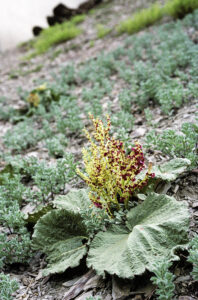
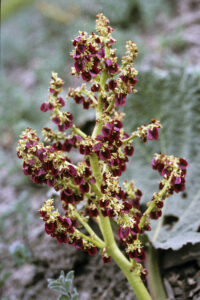
The fruit is a triangular nutlet, mostly winged, in dense clusters, often conspicuously reddish-brown when ripe.
The generic name is the classical Latin word for sorrel.
Inflorescences are interrupted dense whorls up the stem, petals to 1.5 mm long. The flowering period is June-July. The fruit is broadly ovate or circular, brown, shining, to 3 mm across, ripening July-August.
It is found from Afghanistan and northern Pakistan eastwards through Ladakh to western Tibet, growing in stagnant freshwater at elevations between 3,000 and 4,200 m.
The specific name is Latin, meaning ‘angular’, alluding to the zigzag flower stems.

Inflorescences are terminal, slender, branched clusters, flowers tiny, greenish-white, appearing March-October. The fruit is pinkish, almost circular, to 5 mm across, wings papery, net-veined, ripening April-November.
This plant is distributed from Afghanistan across southern Tibet and the Himalaya to northern Myanmar and central China, in the Himalaya growing among rocks, on stone fences, along streams, and in cultivated areas, at elevations between 1,000 and 3,200 m.
In Nepal, juice of the plant is taken for dysentery, and the root is chewed for sore throat. Tender parts are pickled. Dried leaves are collected for fodder,
The specific name is Latin, meaning ‘spear-shaped’, referring to the leaf shape.
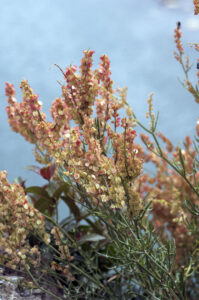
Inflorescences are often very long racemes, axillary or terminal, usually leafless, but leafy in some forms. Flowers are arranged in whorls, petals elliptic, yellowish or greenish, to 1.5 mm long. The flowering period is from March to September. The fruit is dark brown, reddish, or greenish, shining, ovoid, to 4 mm long, wings broad, each margin with 6-8 hooked teeth, to 3 mm long, one wing with an oblong swelling. They ripen June-October.
This plant is distributed from Italy and the Balkans eastwards through the Middle East and southern Central Asia to Japan, southwards to eastern and southern Africa, Madagascar, Sri Lanka, and Java. In the Himalaya, it may be found at elevations between 1,000 and 4,300 m. Habitats include grasslands, ditches, open areas, and along trails.
In Nepal, tender parts are cooked as a vegetable, and also fermented to make gundruk (see Arisaema utile, Himalayan flora 1). Root and leaves are used for various ailments, including eye trouble, cough, colds, headache, boils, swelling of gums, and also to expel intestinal worms.
R. dentatus is quite similar, but there are only 4-5 straight teeth along the margin of the fruit. It has a similar distribution.
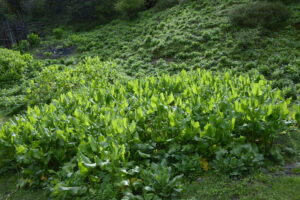
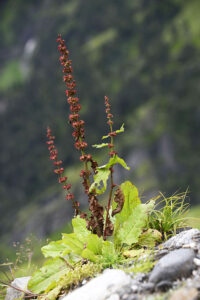
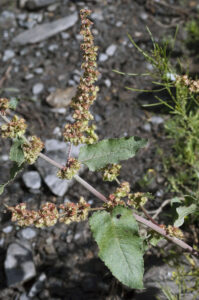
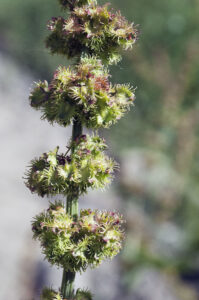

Inflorescences are large, axillary or terminal, leafy, flowers yellowish-green, to 1.5 mm long. Flowering occurs May-July. The fruit is broadly ovate, base heart-shaped, net-veined, greenish or reddish, to 3 mm long, margin with a few weak teeth. It ripens June-August.
It occurs from the Czech Republic and Italy eastwards through the Middle East and Central Asia to northern China and Korea, southwards to Iran, the Himalaya, and northern Indochina. In the Himalaya, it grows in fallow fields and ditches, and along trails, at elevations between 2,100 and 4,100 m. It is common in Ladakh and Lahaul.
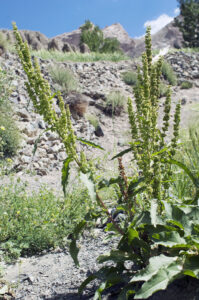
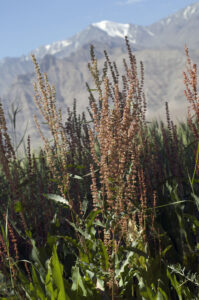
The genus contains about 170 species, the majority distributed across cooler areas of the Northern Hemisphere, and also in montane regions of southern South America, the Philippines, and New Guinea. About 23 species have been observed in the Himalaya, mainly found at high altitudes.
The generic name is derived from Ancient Greek andros (‘male’) and sakos (‘shield’), presumably alluding to the leaf shape of many of the species. In German, this is directly translated to Mannsshild. Originally, the name was probably applied to an alga of the genus Acetabularia (family Polyphysaceae), by Greek physician, pharmacologist, and botanist Pedanius Dioscorides (died 90 A.D.), and also by Roman naturalist Pliny the Elder (23-79 A.D.), presumably due to the shape of the ‘cap’ of these algae. The name was transferred to the rock-jasmines by Italian physician and naturalist Pietro Andrea Gregorio Mattioli (1501-1577).
The common name alludes to the flowers resembling jasmines.
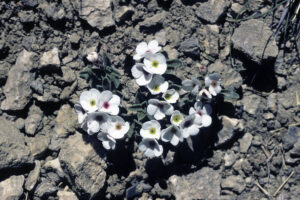
It occurs from Uttarakhand eastwards to northern Myanmar and south-western China, growing on rocks and gravelly slopes, and in dry meadows, at elevations between 4,300 and 5,300 m.
The specific name commemorates French missionary, explorer, and botanist Jean-Marie Delavay (1834-1895), who was sent to China in 1867, serving first in Guangdong, then in the Yunnan Province. He was an avid plant collector, sending over 200,000 herbarium specimens to France, from which numerous new genera and over 1,500 new species were described.
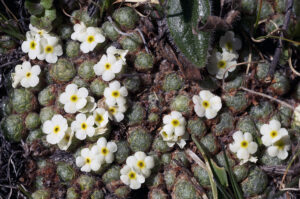
It has runners, to 30 cm long, leaves forming a small rosette, stalk to 15 cm long, hairy, blade rounded, broader than long, to 5 cm wide, base heart-shaped, palmately divided, with 5-7 lobes to the middle, lobes obovate, with 3-5 teeth or tiny lobes.
Umbels with 6-14 flowers arise from the rosettes, stalk usually to 15 cm tall, occasionally to 25 cm, corolla to 1 cm across, white or pink with a small yellow eye, petals obovate-oblong, entire or notched. It blooms April-June.
The specific name is Latin, meaning ‘with leaves like Geranium‘.
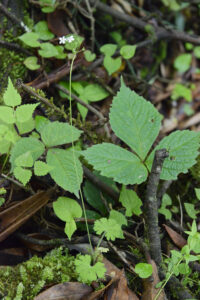
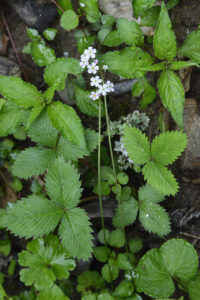
It has a rather restricted distribution, found from eastern Nepal eastwards to Bhutan and south-eastern Tibet, growing at altitudes between 3,500 and 4,100 m. Habitats include forest margins, open slopes, and streamsides.
The specific name honours British botanist Joseph Dalton Hooker (1817-1911), who described numerous new plant species in the eastern Himalaya (see Rhododendron dalhousiae, Himalayan flora 1).
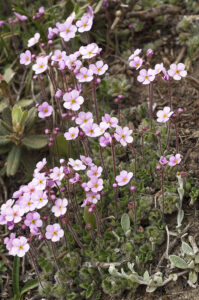
It forms rather dense, cushion-like growths, stems brownish-red, leafy, often creeping, more or less hairy, short stolons sometimes present. Leaves lanceolate to elliptic-ovate, hairy, especially along the margin, to 2.7 cm long and 7 mm wide, pointed, with a tiny spine. Flower-stalk to 10 cm long, hairy, umbels with up to 6 flowers, each to 1 cm across, corolla pink, white, or mauve with a yellow or red eye, often different in the same umbel. Flowers appear May-August.
The specific name is Latin, meaning ‘woolly-haired’.
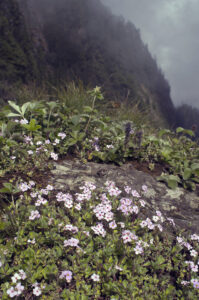
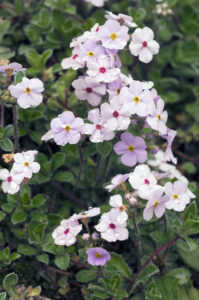
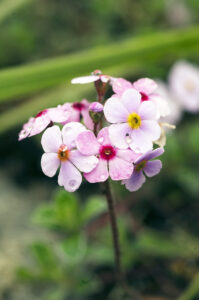
This plant has a rather limited distribution, found from western Nepal eastwards to Sikkim and south-eastern Tibet, growing in grasslands and on open slopes at elevations between 3,500 and 5,500 m. It is fairly common in central Nepal.
The specific name was given in honour of German botanist and physicist Johann Georg Christian Lehmann (1792-1860), who was a member of 26 learned societies and the founder of the Hamburg Botanical Garden.
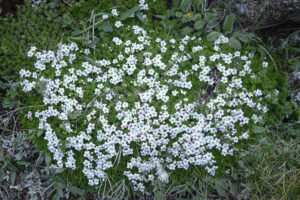
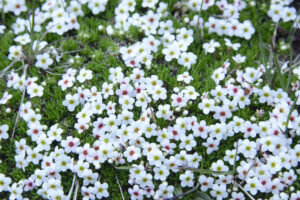
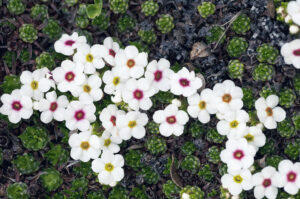
It forms lax cushions with slender runners. Leaf rosettes globular, to 1 cm across, silvery-haired, often borne on top of older rosettes. Leaves broadly lanceolate, to 4 mm long and 1.5 mm wide, inner ones to 4.5 mm long, incurved, with a hairy margin. Umbels with up to 8 flowers, stem absent or up to 6 cm tall, corolla to 1 cm across, mauve, lilac, pink, or white with a yellow or red eye, petals obovate or spatulate, to 2.6 mm long. Blooming occurs June-August.
The specific name is Latin, meaning ‘resembling a fly’. What it refers to is not clear.
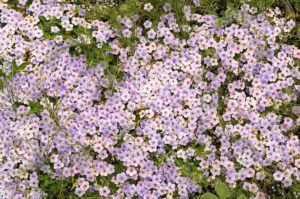
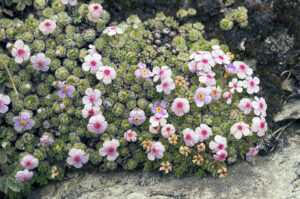
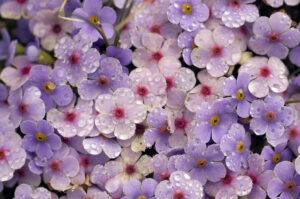
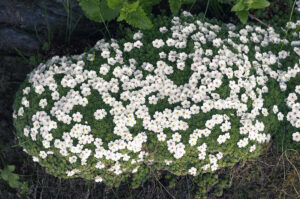
Inflorescences are terminal, 2-12-flowered umbels with erect, purplish, silky-hairy stems, to 9 cm tall, corolla to 1 cm across, mauve or pink with a yellow eye, which later turns red, petals obovate-oblong, tip rounded. Flowering occurs June-July.
It is distributed in drier regions, from Pakistan eastwards across south-western Tibet to central Nepal, growing in grasslands and rocky areas at elevations between 3,100 and 5,600 m.
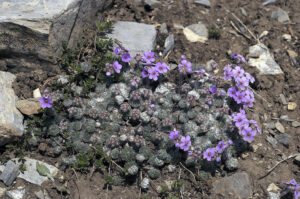
It grows in forests and grasslands, and on open slopes, at elevations between 800 and 4,000 m, distributed from Afghanistan eastwards Kashmir and south-western Tibet to western Nepal.
The specific name is Latin, meaning ‘with round leaves’.
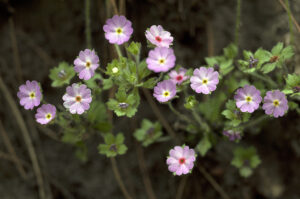
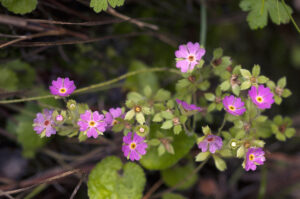
Leaf rosettes form a very lax mat, runners numerous, arising from rosettes, red or brown, to 10 cm long, covered in rust-colored hairs, with rooting rosettes at the tip. Leaves of 2 kinds, outer sessile, oblong or elliptic, to 1 cm long, hairy, pointed, inner ones short-stalked, oblanceolate or oblong, hairy, to 5 cm long and 9 mm wide, tip blunt.
Flower-stalks to 20 cm long, hairy or almost hairless, umbels many-flowered, flowers short-stalked, hairy, corolla purple, violet, or pink, to 8 mm across, petals obovate or rounded, sometimes with a small notch. It flowers from May to July.
The specific name is derived from the Latin sarmentum (‘shoot’) and the suffix osus (‘full of’), thus ‘with many shoots’.
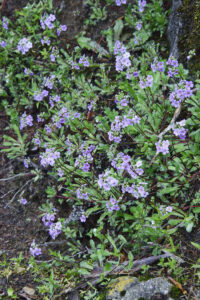
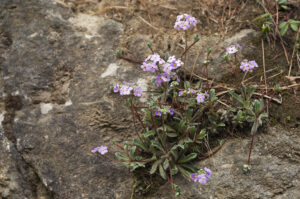
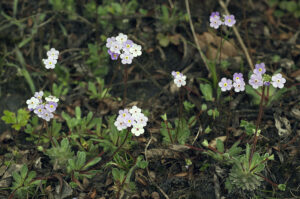
Flowers solitary, the very short stalk hidden among the rosettes, so that only the petals are exserted. Corolla to 3 mm across, white or pink with a large red or yellow eye, petals broadly obovate, margin entire, tip rounded. Flowering takes place between May and July.
It is distributed from Xinjiang and Qinghai southwards through Tibet to northern Nepal, Sikkim, and Bhutan, found at elevations between 3,500 and 5,500 m. Habitats include grasslands, dry stony slopes, and gravelly areas.
The specific name is Latin, meaning ‘cloth’ or ‘carpet’, alluding to the carpet-like growth.
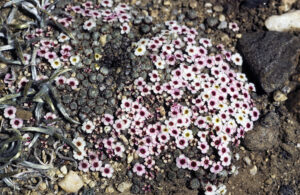
The inflorescences of these plants differ from those of Primula by having the flowers arranged in several umbels up the stem. They occur from Turkey eastwards to the Himalaya, southwards through Arabia to Ethiopia and Somalia. A single species is found in the Himalaya.
The generic name may be derived from Ancient Greek ev (‘splendid’) and trokhos (‘wheel’), in which case it probably refers to the beautiful ‘wheels’, formed by the inflorescences.
It grows on humid rocks and banks, distributed from Afghanistan eastwards to western Nepal, at elevations between 600 and 2,600 m.
The specific name is Latin, meaning ‘with an abundance of flowers’.
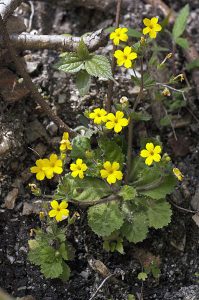
The generic name is derived from Ancient Greek lysimakhos, of lysis (’release from’) and makhe (’strife’), thus meaning ‘to end a strife’, in English corrupted to loosestrife. In Ancient Greece and Rome, a popular belief was that loosestrife was an effective remedy to calm down furious persons. Roman naturalist Pliny the Elder (23-79 A.D.) states that if two bullocks start a fight and don’t want to be under the same yoke, you calm them down by placing loosestrife on the yoke.
This plant occurs from Uttarakhand eastwards to Assam and northern Myanmar, growing in shrubberies and forests, often on mossy rocks, at altitudes between 1,100 and 2,400 m.
The specific name is Latin, meaning ‘with alternating leaves’.
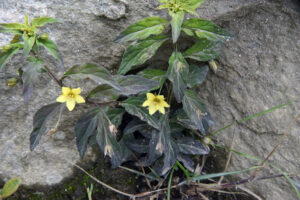
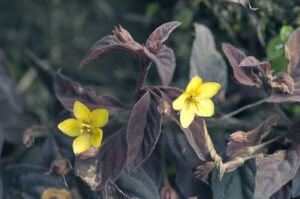
The generic name is derived from Arabic maas, the local name of the type species, M. lanceolata.
Previously, these plants were placed in a separate family, Maesaceae.
Inflorescences are short, many-branched, axillary clusters, to 4 cm long. Flowers white, to 4 mm across, cup-shaped, petals spreading, rounded, veined. Flowering takes place from February to April. The fruit is a globular, fleshy, hairless berry, to 4 mm across, yellowish, pink or brownish, with persistent calyx-lobes. Ripening occurs March-June.
It is distributed from western Nepal eastwards to northern Myanmar, south-eastern Tibet, and the Yunnan Province, growing in shrubberies and on open slopes at altitudes between 900 and 2,600 m.
In Nepal, root, bark, and leaves are strewn in rivers to stupefy fish. They also function as an insecticide, and bark and fruit are used to expel internal and external parasites. The foliage is lopped for fodder.
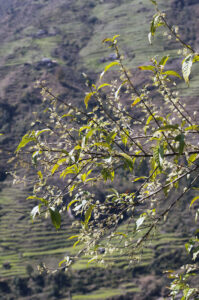
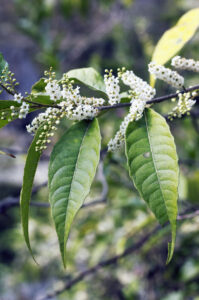
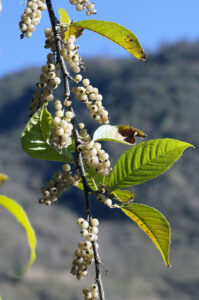
The generic name is derived from Ancient Greek omphalos (‘centre’) and gramma (‘streak’ or ‘letter’). What it refers to is not clear.
A rare plant, distributed from eastern Nepal eastwards to Arunachal Pradesh and south-eastern Tibet, found in humid grasslands and on open slopes at elevations between 3,600 and 4,000 m. It is prominent on the passes between Arun and Barun Valleys, eastern Nepal.
The specific name honours British naturalist and explorer Henry John Elwes (1846-1922), who collected many plants, especially lilies, during trips to the Himalaya and Korea. He was among the first persons to receive the Victoria Medal of the Royal Horticultural Society in 1897.
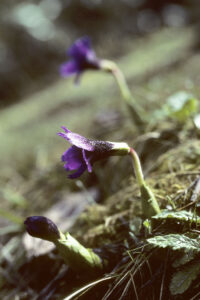
These plants are characterized by having the leaves in a rosette, and the flowers are usually in a terminal umbel on a leafless stalk. The corolla-tube is long, with 5 spreading lobes. The fruit is a capsule.
The generic name is a diminutive of the Latin prima (’first’), referring to the early flowering of several species. The name primrose is from the Latin prima rosa, meaning ‘the first rose’, although primroses are not at all related to roses. According to some authorities, the name cowslip is a corruption of an Old English word, cuslyppe, meaning ‘cow dung’. This probably refers to the favoured habitat of the common cowslip (P. veris), namely dry slopes, grazed by cattle. Others claim that the word is a corruption of cow’s leek, derived from the Anglo-Saxon word leac, meaning ‘plant’.
Primroses from other parts of the world are shown on the page Plants: Primroses.
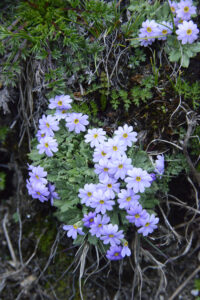

It grows in shrubberies, grasslands, and on open slopes at altitudes between 3,500 and 4,900 m, distributed from Uttarakhand eastwards to south-eastern Tibet.
The specific name is Latin, meaning ‘with black teeth’, alluding to the black-tipped calyx-lobes.
P. denticulata (below) is quite similar, but much larger, and it lacks the dark-tipped calyx-lobes.
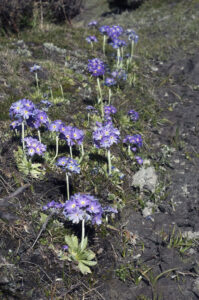
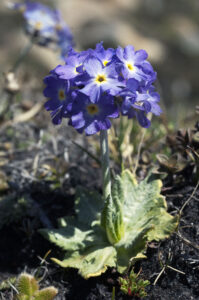
Furthermore, P. buryana is found in drier areas along the Tibetan border, from western to eastern Nepal, and also in Tibet, at elevations between 3,300 and 5,000 m, whereas the blue-flowered plant is restricted to central Nepal, mainly growing on rock-ledges at altitudes between 2,900 and 4,600 m, fully exposed to the monsoon rains.
I am convinced that the latter is a distinct species, as also suggested by Polunin and Stainton in their book Flowers of the Himalaya (1984).
The blue-flowered plant has slender, hairy stems, to 18 cm tall, leaves in a basal rosette, ovate to oblong-ovate, densely hairy on both surfaces, and with long white hairs along the margin, blade tapering into a winged stalk, both to 2.5 cm long. Flowers single or up to 3 together, broadly funnel-shaped, to 2 cm across, very short-stalked, pale blue or pale lilac with white around the throat, calyx with shaggy white hairs. It flowers June-July.
The discovery of P. buryana is related below, see P. wollastonii.
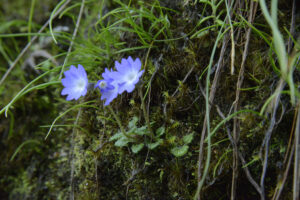
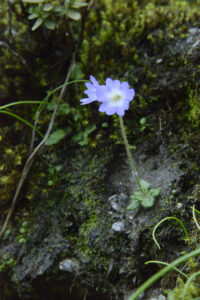
It is distributed from western Nepal eastwards to Bhutan and south-eastern Tibet, growing in humid grasslands and gravelly areas at elevations between 4,000 and 5,200 m.
The specific name is a shortened form of the Latin concinnatus (‘harmonic’).

The leaves, which form a rosette, have a winged stalk, usually short, but occasionally to 15 cm long, blade oblong to oblanceolate, to 20 cm long and 4 cm broad, sometimes with white or yellow farina, margin toothed, tip blunt. The leaves become longer in fruit, to 30 cm.
Inflorescence stalks are of very variable length, to 15 cm, taller in fruit, sometimes with farina on the upper half. The umbel is globular, compact, many-flowered, bracts numerous, to 1 cm long, stalks very short. Corolla to 2 cm across, pale blue, pinkish-blue, or purplish, with a yellow eye, rarely completely white, tube bell-shaped, to 2 cm long, lobes obovate, to 8 mm long, deeply bi-lobed. As a rule, the inflorescences become larger and denser with higher altitude. Flowering takes place April-June.
The specific name is Latin, meaning ‘with small teeth’, alluding to the leaves.
P. glomerata (below) also has globular umbels, but has a much longer inflorescence stalk, and the head is more compact.
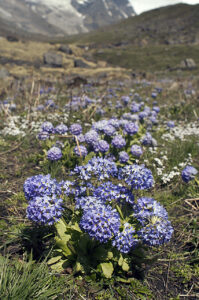
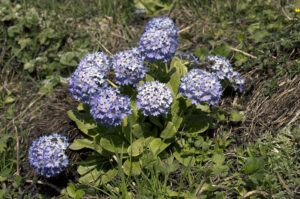
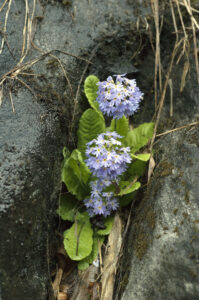
Leaves basal, forming a loose rosette, occasionally producing stolons in leaf axils, stalk to 13 cm long, hairy, blade variable, rounded, to 8 cm across, base heart-shaped, palmately lobed, lobes 7-9, sometimes very shallow (as in pictures below), margin sharply toothed, tip pointed.
Inflorescence stalks to 30 cm tall, densely hairy, umbels with 3-12 flowers, individual flowers short-stalked, calyx bell-shaped, to 1 cm long, parted to the middle, lobes lanceolate, veined, corolla rose-coloured, dark red, or purple, to 2 cm across, tube to 1.3 cm long, lobes obovate, to 8 mm long and 5 mm wide, more or less deeply notched. Blooming occurs May-July.
As its specific name implies, the leaves of this plant resemble those of certain species of crane’s-bill (Geranium).
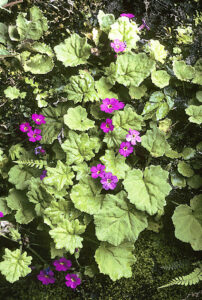
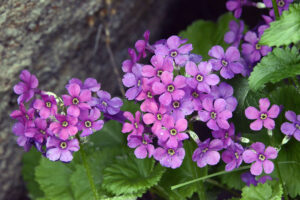
Leaves basal, forming a rosette, stalk winged, to 4 cm long, blade oblong, oblanceolate, or spatulate, to 15 cm long and 3 cm broad including stalk, margin sharply and irregularly toothed, tip rounded. Inflorescence stalk to 30 cm tall, farinose or glandular-hairy above, umbel a globular head, to 5 cm in diameter, corolla sky-blue with a dark throat, to 1 cm across, tube funnel-shaped, to 1.5 cm long, lobes spreading, obovate, deeply notched.
It is distributed from western Nepal eastwards to south-eastern Tibet, growing in shrubberies and on grassy slopes at altitudes between 3,000 and 5,700 m.
The specific name is Latin, meaning ‘having been made into a ball’, ultimately from glomero (‘to gather’).
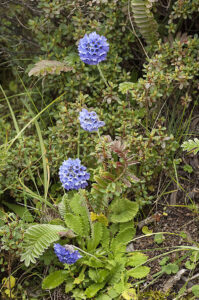
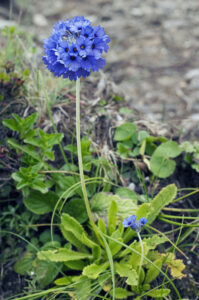
Flowers numerous, stalk to 6 cm long, glandular-hairy, erect or drooping. Calyx bell-shaped, to 9 mm long, yellowish farinose or glandular, cleft to the middle. Corolla to 4 cm across, bright purplish-pink with an orange-yellow, star-shaped eye, surrounded by an irregular white border, tube to 1.3 cm long, lobes broadly obovate, usually with 3 large teeth. Flowering takes place April-June.
It occurs in forests and shrubberies, from central Nepal eastwards to Bhutan and south-eastern Tibet, growing at elevations between 2,700 and 4,100 m.
The specific name is derived from the Latin gracilis (‘slender’) and pes (‘foot’). What it refers to is not clear.
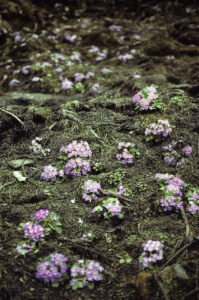
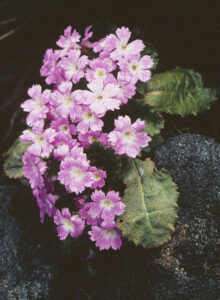
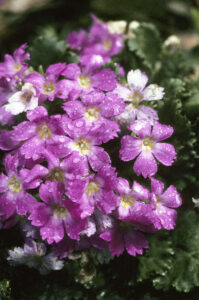
It has no inflorescence stalk, the flowers sprouting individually directly from the leaf rosette. Leaves of 2 kinds, some long-stalked, others almost stalkless, blade oblong or elliptic, toothed, initially with yellow farina, to 12 cm long and 3 cm wide at flowering, enlarging in fruit.
Flowers very short-stalked, to 3.2 cm across, bright pink, rarely pale violet, with an orange-yellow star-shaped eye, surrounded by a broad white border, lobes very ragged-toothed. Calyx and flower-stalks have stalked glands. It flowers from March to May.
The specific name presumably refers to the ragged-toothed corolla lobes.
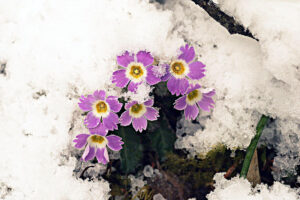
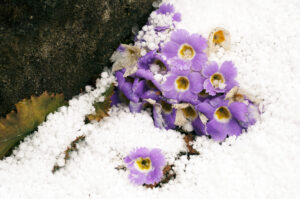
Inflorescence stalks to 30 cm tall, umbels rather lax, with 5-25 flowers, often drooping, bracts lanceolate, to 3.5 cm long, calyx cylindrical, with linear lobes, corolla violet, purple, or lilac, with a darker eye, tube to 3 cm long, lobes elliptic or obovate, to 6 mm long. It blooms June-August.
This species is distributed from Kyrgyzstan and Xinjiang southwards across Tibet to northern Pakistan, and thence eastwards to Bhutan, growing in grasslands, and along streams, at elevations between 3,300 and 5,600 m. It is very common in the Khumbu area, eastern Nepal.
The specific name is derived from Ancient Greek makros (‘long’) and phyllon (‘leaf’).
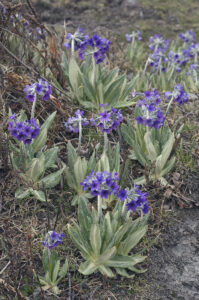

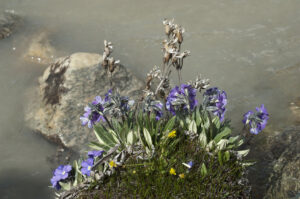
Leaves long-stalked, hairy, blade rounded, to 10 cm long and broad, with 5-7 shallow lobes, strongly toothed, base heart-shaped. Inflorescence stalk to 23 cm long, slender, umbel with 3-12 drooping flowers, calyx bell-shaped, to 5.5 mm long, with 5 triangular lobes, corolla bell-shaped, rosy-purple, to 1.5 cm long and 2.5 cm across, deeply cleft below the middle into 5 oblong lobes with entire margin, sometimes notched. Flowering occurs June-August.
This subspecies is found from Kazakhstan and Mongolia southwards to northern Pakistan, Himachal Pradesh, and Uttarakhand. In the Himalaya, it grows at elevations between 3,000 and 4,200 m, mainly on rocks in forests.
In its widest sense, the species is distributed from northern Siberia southwards to the Himalaya, northern China, Korea, and Japan, and it also occurs in montane areas of central Europe and the Balkans.
The specific name honours Italian physician and naturalist Pietro Andrea Gregorio Mattioli (1501-1577), personal physician of Emperor Maximilian II (1527-1576). He described more than a hundred new plants, and in his work Discorsi, he made famous comments on De Materia Medica, written by Greek physician, pharmacologist, and botanist Pedanius Dioscorides (died 90 A.D.). In 1561, he published a work on medicinal plants, Epistolarum Medicinalium Libri Quinque.
The obsolete generic name Cortusa was applied by Mattioli in honour of Giacomo Antonio Cortusi (1513-1603), who presented the plant to him, found north of Vicenza. From 1590, he was the director of the botanical garden in Padova,

The leaves are bluish- or greyish-green, spatulate, to 5 cm long at flowering, longer in fruit, entire at first, later toothed, farinose on both sides when young.
It is distributed from Himachal Pradesh eastwards to central Nepal, growing in forests at elevations between 2,100 and 4,100 m. It is common in the Annapurna area, central Nepal.
The specific name is derived from Ancient Greek nanos (‘dwarf’), alluding to its growth form. The obsolete specific name honours Irish botanist Michael Pakenham Edgeworth (1812-1881), who spent many years in India, where he collected a large number of plants.
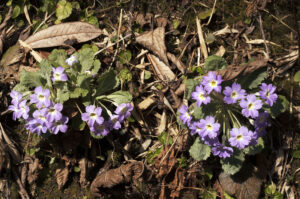
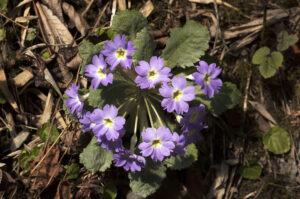
Leaves are in a rosette, with a winged stalk, blade lanceolate, oblanceolate, narrowly obovate, to 20 cm long and 4.5 cm wide, with yellow farina beneath, margin with numerous tiny teeth, tip pointed or blunt.
Inflorescence stalks are to 55 cm long, farinose on upper part, umbel with 4-7 stalked, nodding flowers, calyx tubular, yellowish-brown, to 1 cm long, parted to the middle, lobes oblong, tip blunt, corolla bell-shaped, white or pale yellow, sometimes flushed with pink, to 3 cm across, lobes broadly obovate, deeply indented. Flowering takes place June-July.
The specific name is Latin, meaning ‘slanting’ or ‘awry’. What it refers to is not clear.
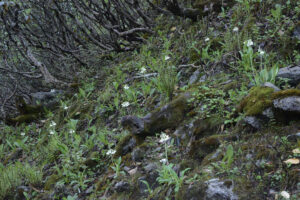
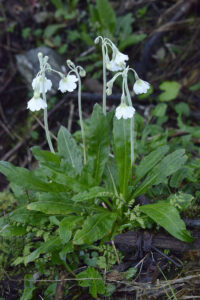
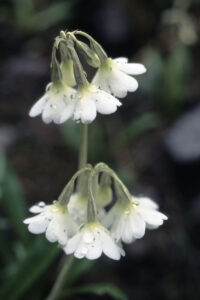
Flowers are almost stalkless, cup-shaped, to 2 cm across, pink with a broad yellow eye, surrounded by a narrow white ring. Flowering takes place March-May.
It occurs from Uttarakhand eastwards to Sikkim, growing on shady banks in forests, at altitudes between 2,100 and 3,800 m.
It closely resembles P. gracilipes (above), but is smaller, with a tight leaf rosette, and it lacks farina.
The specific name is derived from the Latin petiolus (‘little foot’), thus ‘having a small foot’, presumably alluding to leaves and flowers being very short-stalked.
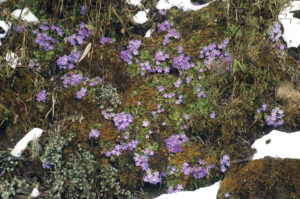
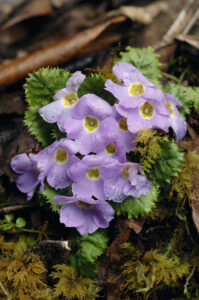
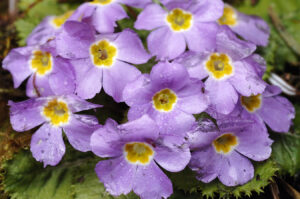
A tiny plant, easily identified by its flowers, which have a tuft of white hairs in the throat. Leaves all basal, numerous, spatulate or oblanceolate, to 3 cm long and 5 mm broad, including the winged stalk, margin deeply rounded-toothed, tip blunt.
Inflorescence stalks slender, to 9 cm high, sparsely glandular-hairy, umbels with 2-4 almost stalkless flowers, corolla to 1.2 cm across, pale blue, purple, or violet, rarely white, with a tuft of white hairs in the throat, tube to 4 mm long, lobes obovate, deeply cleft. Blooming occurs June-September.
The specific name is composed of the genus name Primula and the suffix ina (‘pertaining to’), thus ‘resembling Primula’. This seems odd, as it is a species of Primula. The explanation is that when German botanist and physician Kurt Polycarp Joachim Sprengel (1766-1833) described the plant in 1827, he named it Androsace primulina (‘the rock-jasmine which resembles primroses’).
Incidentally, when Sprengel was only 14 years old, he published a small work titled Anleitung zur Botanik für Frauenzimmer (‘Botanical Guide for Women’).
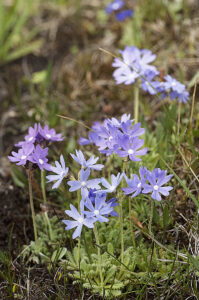
Inflorescence stalk to 30 cm tall, umbel usually solitary, sometimes 2, one above the other, number of flowers vary greatly, between 2 and 16, stalk to 2 cm long, calyx bell-shaped, to 6 mm long, covered in farina, split to near the base, corolla to 2 cm across, pink or pale purplish with a yellow eye, sometimes surrounded by a narrow white ring, lobes rounded or broadly ovate, margin entire or toothed. It flowers from May to July.
This plant is found at elevations between 3,500 and 5,000 m, from western Nepal eastwards to Sikkim and south-eastern Tibet. It usually grows beneath rock walls, or sometimes beneath large trees.
The specific name is Latin, meaning ‘with round leaves’.
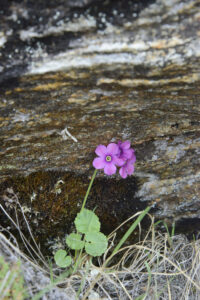
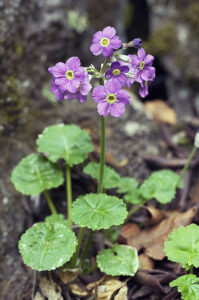
It has no inflorescence stalk, the flowers sprouting individually directly from the leaf rosette. It may easily be identified by its serrated, strongly wrinkled leaves, and by the rounded corolla lobes, ending abruptly in a single small tooth. Leaves short-stalked, blade usually elliptic, sometimes rounded, to 6 cm long and 4 cm broad, sharply and irregularly toothed, nerves deeply imprinted above.
Flowers are short-stalked, stalk glandular-hairy, calyx cylindrical, with narrow, keeled lobes, corolla to 2.5 cm across, pale lilac with a pink flush, and with an orange star-shaped eye, surrounded by an irregular white border, lobes abruptly narrowed to a fine tooth. The flowering period is from March to May.
The specific name is Latin, meaning ‘sitting’, but in botanical context meaning ‘stalkless’, in this case alluding to the flowers.
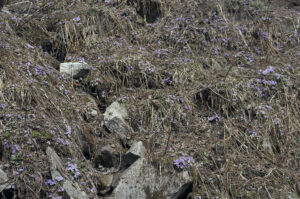
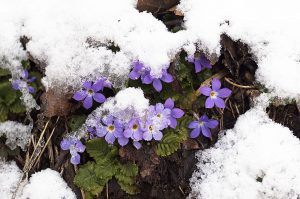
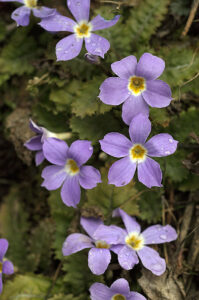
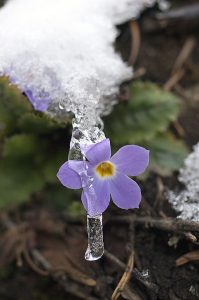
Inflorescence stems are very long, to 90 cm, with yellow farina above, umbels usually solitary, sometimes 2, one above the other, with numerous long-stalked, drooping flowers, bracts awl-shaped, to 2 cm long, calyx bell-shaped, to 1 cm long, split to the middle, prominently 5-veined, densely farinose, corolla bright yellow or pale yellow, rarely creamy-white, to 3 cm across, lobes obovate or oblong, entire or shallowly notched. Flowering occurs May-July.
It is partial to wet meadows, marshes, and streamsides, mostly found in drier inner valleys at elevations between 2,900 and 4,800 m, from western Nepal eastwards to northern Myanmar and south-western China.
The specific name is Latin, meaning ‘found in Sikkim’.
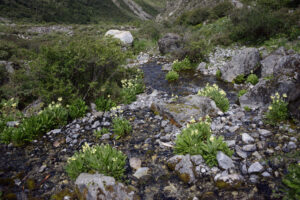
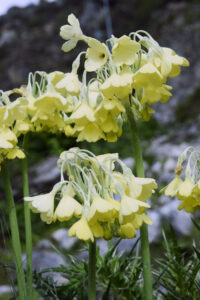
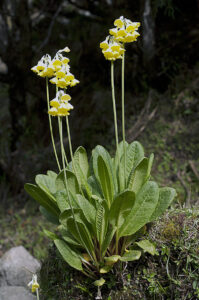
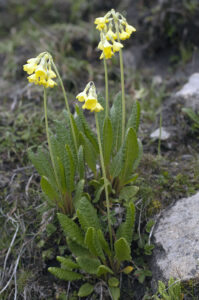
Inflorescence stalks to 20 cm tall, with yellow farina above, umbels many-flowered, calyx bell-shaped, to 7.5 mm long, densely yellow farinose, split to the middle, corolla to 2.5 cm across, bright yellow with an orange-yellow eye, tube to 1.3 cm long, lobes rounded, with tiny teeth. Blooming takes place between May and July.
It grows in forests, shrubberies and grasslands, and on open slopes, at altitudes between 3,500 and 4,300 m, from western Nepal eastwards to Bhutan and south-eastern Tibet. It is common in the Ghunsa Valley, eastern Nepal.
This species hybridizes freely with the purple P. calderiana, sometimes resulting in yellow, white, blue, and purple flowers in a single mixed population.
The specific name is derived from the Latin struma (‘scrofulous tumor’ or ‘swelling’). What it refers to is not clear.
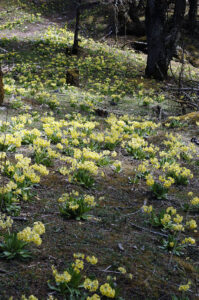
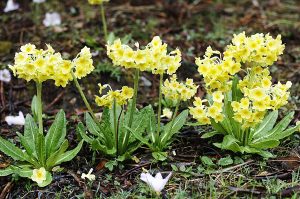
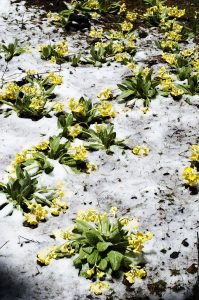
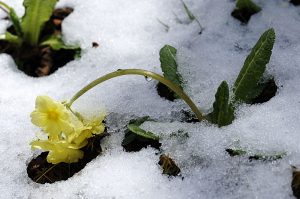
The leaves are all in a rosette, blade lanceolate or spatulate, to 30 cm long and 4 cm wide, tapering to a broadly winged stalk, yellow farinose beneath, margin sharply toothed, tip pointed.
Inflorescence stalk to 40 cm tall, umbel many-flowered, often one-sided, all parts covered in yellow farina, flower stalks to 2.5 cm long, flowers drooping, to 3 cm across, calyx tubular, to 1.5 cm long, more or less split into lanceolate lobes, corolla golden-yellow, paler along the margin, and with an orange-yellow eye, lobes rounded, notched or toothed. It blooms June-July.
The specific name honours John Stuart, 3rd Earl of Bute (1713-1792), who was a patron of botany.
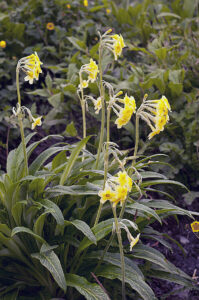
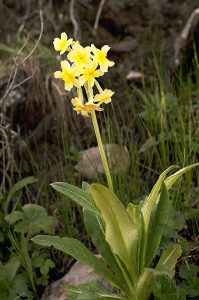
It is distributed from Uttarakhand eastwards across southern Tibet and northern Himalaya to Bhutan, growing in humid grasslands and marshes at elevations between 3,000 and 5,000 m.
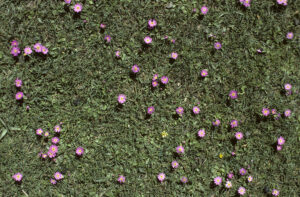
Inflorescence stalks to 20 cm long, with farina and glandular hairs, umbel compact, with 2-6 nodding, bell-shaped flowers, calyx green or dark purple, cup-shaped, to 8.5 mm long, split to the middle, lobes with 2-3 teeth, corolla bell-shaped, dark purple to bright blue, to 2.5 cm long and across, with broadly ovate, very shallow, pointed lobes. Flowering takes place from June to August.
It is restricted to the inner dry valleys of central and eastern Nepal, and adjacent areas of southern Tibet, growing in grasslands and on stony slopes at altitudes between 3,600 and 4,900 m.
The specific name was given in honour of English physician, naturalist, and explorer Alexander Frederick Richmond Wollaston (1875-1930), who participated in a number of expeditions, to the Ruwenzori Mountains of Uganda 1905, to New Guinea 1910-11 and 1912-13, and to Mt. Everest 1921.
During the latter expedition, he collected two primroses in the area around Nyenyam (today called Nyalam) and the Rongshar Valley, southern Tibet, P. buryana, named for another member of the expedition, British soldier, explorer, and botanist Charles Kenneth Howard-Bury (1881-1963), and P. wollastonii.
In Howard-Bury’s book Mount Everest: The reconnaissance, 1921, Wollaston writes of the discovery of the two primroses: “Crossing a pass to the east of Nyenyam, we camped on a level spot covered densely with white primulas [later named P. buryana] six to eight inches high. An inch or two of snow fell during the night, and so white are these flowers that it was difficult to see them against the snow. Near the top of another pass we found at about the same altitude, 15,000 feet, another primula [later named P. wollastonii] with three to six bells on each stem, the size of a small thimble, of a deep blue color, and lined inside with frosted silver.”
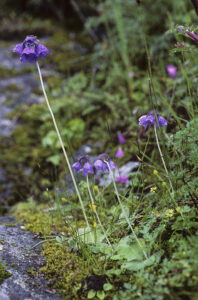
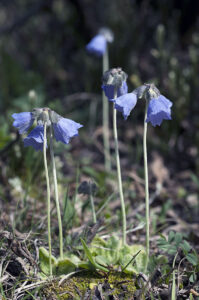
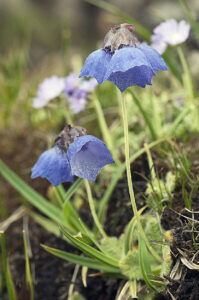
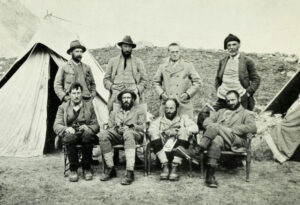
In the picture below, Hindus are placing a flower offering, consisting of yellow Primula stuartii, yellow Geum elatum, and blue and white Anemone obtusiloba, on a stone cairn – a shrine dedicated to a local Hindu goddess, situated atop Rakhundi Peak (3622 m) in Great Himalayan National Park, Himachal Pradesh. The trident on the cairn indicates that this goddess is a form of Devi, the supreme god Shiva’s shakti (female aspect), as the trident is a symbol of Shiva.
Such offerings to stone cairns, sacred trees etc. indicate remnants of pre-Hindu and pre-Buddhist animism. More about this issue is described on the page Religion: Animism.
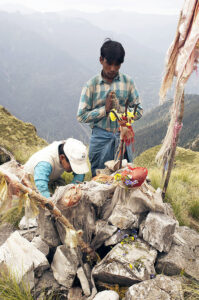
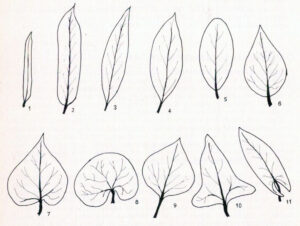
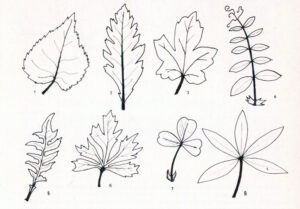
Male organs in a flower are called stamens, divided into a long, thread-like filament and a terminal anther, from which the pollen, tiny grains containing the male cells, is spread.
The female organ is called a carpel, comprising the egg-producing ovary, an often long, columnar style, on the end of which sits the stigma, which receives the pollen during fertilization.
